12.1: The Relationship Between Risk and Capital Budgeting
12.1.1: Risks Involved in Capital Budgeting
The process of capital budgeting must take into account the different risks faced by corporations and their managers.
Learning Objective
Identify the different risks that must be accounted for in the capital budgeting process
Key Points
- Capital budgeting (or investment appraisal) is the planning process used to determine whether an organization’s long-term investments are worth pursuing. The risk that can arise here involves the potential that a chosen action or activity (including the choice of inaction) will lead to a loss.
- There are numerous kinds of risks to be taken into account when considering capital budgeting. Each of these risks addresses an area in which some sort of volatility could forcibly alter the plan of firm managers.
- There are different ways to measure and prepare to deal and plan for these risks, including sensitivity analysis, scenario analysis, and break-even analysis among others.
Key Terms
- capital budgeting
-
The planning process used to determine whether an organization’s long term investments, such as new machinery, replacement machinery, new plants, new products, and research development projects are worth pursuing.
- risk
-
The potential that a chosen action or activity (including the choice of inaction) will lead to a loss (an undesirable outcome).
Capital Budgeting
Capital budgeting (or investment appraisal) is the planning process used to determine whether an organization’s long term investments, such as new machinery, replacement machinery, new plants, new products, and research development projects are worth pursuing. When taking on this planning process, managers must take into account the potential risks of the investment not panning out the way they plan for it to, for any number of reasons. In order to discuss this further, we should look into defining the concept or risk.
Risk
Risk is the potential that a chosen action or activity (including the choice of inaction) will lead to a loss (an undesirable outcome). The notion implies that a choice having an influence on the outcome exists (or existed). Potential losses themselves may also be called “risks. “
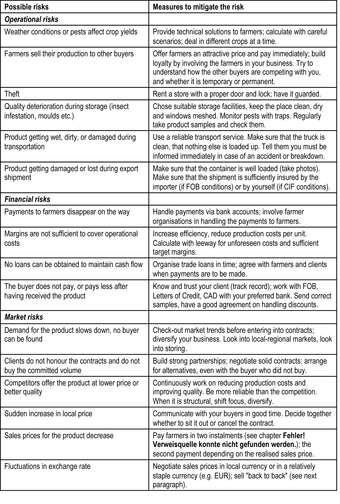
Possible Business Risks
This chart represents a list of the possible risks involved in running an organic business. Risks such as these affect sales, which in turn affect the amount of operating leverage a company should utilize.
There are numerous kinds of risks to be taken into account when considering capital budgeting including:
- corporate risk
- international risk (including currency risk)
- industry-specific risk
- market risk
- stand-alone risk
- project-specific risk
Each of these risks addresses an area in which some sort of volatility could forcibly alter the plan of firm managers. For example, market risk involves the risk of losses in position due to movement in market positions.
There are different ways to measure and prepare to deal with risks as well. One such way is to conduct a sensitivity analysis. Sensitivity analysis is the study of how the uncertainty in the output of a model (numerical or otherwise) can be apportioned to different sources of uncertainty in the model input.
A related practice is uncertainty analysis which focuses rather on quantifying uncertainty in model output. Ideally, uncertainty and sensitivity analysis should be run in tandem. Another method is scenario analysis, which involves the process of analyzing possible future events by considering alternative possible outcomes.
For example, a financial institution might attempt to forecast several possible scenarios for the economy (e.g., rapid growth, moderate growth, slow growth), and it might also attempt to forecast financial market returns (for bonds, stocks, and cash) in each of those scenarios. It might consider sub-sets of each of the possibilities. It might further seek to determine correlations and assign probabilities to the scenarios. Then it will be in a position to consider how to distribute assets between asset types (i.e., asset allocation). The institution can also calculate the scenario-weighted expected return (which figure will indicate the overall attractiveness of the financial environment). It may also perform stress testing, using adverse scenarios.
12.1.2: Risk Aversion
Risk aversion describes how people react to conditions of uncertainty and has implications for investment decisions.
Learning Objective
Evaluate a person’s risk aversion
Key Points
- Risk aversion is the reluctance of a person to accept a bargain with an uncertain payoff rather than another bargain with a more certain, but possibly lower, expected payoff.
- People can be risk averse, risk neutral, or risk loving. A risk averse person will generally take a guaranteed outcome even if it has a lower expected payout than a gamble, while a risk lover will take on the gamble unless the guaranteed payoff is greater than the expected payoff of the gamble.
- Firm management can adopt different stances based on how risk averse they feel they should be, given different market qualities and firm conditions. They will make capital investments that they feel will have the best payoffs, given the risks involved.
Key Term
- Risk Aversion
-
Risk Aversion is a concept that addresses how people will react to a situation with uncertain outcomes. It attempts to measure the tolerance for risk and uncertainty. Risk aversion is the reluctance of a person to accept a bargain with an uncertain payoff rather than another bargain with a more certain, but possibly lower, expected payoff.
In the realm of finance and economics, Risk Aversion is a concept that addresses how people will react to a situation with uncertain outcomes.

High dividend gambles
Risk aversion can be applied to many different situations including investments, lotteries, and any other situations with uncertain outcomes.
It attempts to measure the tolerance for risk and uncertainty. Risk aversion is the reluctance of a person to accept a bargain with an uncertain payoff rather than another bargain with a more certain, but possibly lower, expected payoff. For example, a risk-averse investor might choose to put his or her money into a bank account with a low but guaranteed interest rate instead of investing in a stock that may have high expected returns, but also involves a chance of losing value. Risk aversion can be applied to many different situations, including investments, lotteries, and other situations with uncertain outcomes. Because organizations are composed of individuals, risk aversion at the individual level plays a role in organizational decision making.
People fall under different categories of risk aversion. If we look at an example where a person could receive 50 dollars without risk, or take a gamble where they receive 100 dollars or 0 dollars depending on the outcome of a coin flip, we can explain the differences. We see when we use the expected payoffs of each scenario we see that each has an expected payoff of 50 dollars. Situation one has a 100% chance of getting 50 dollars so it’s expected payoff is (1)(50)=50. For the second situation, the expected payoff deals with a 50-50 chance of getting 100 or 0 dollars so, (.5)(100)+(.5)(0)=50. This is important to know for this example. A risk-averse, or risk avoiding person would take the guaranteed payment of 50, or even less than that (40 or 30) depending on how risk averse they are. A risk neutral person would be indifferent between taking the gamble or the guaranteed money. Finally a risk loving person would take the non-guaranteed chance of possibly winning 100 dollars, rather than settling for the guaranteed option. If the guaranteed option was greater than 50 dollars, then the risk lover might consider the possibility of taking it.
This can be extended to capital budgeting. A firm’s management can adopt different stances based on how risk averse they feel they should be, given different market qualities and firm conditions. They will make capital investments that they feel will have the best payoffs, given the risks involved, and if they take a more risk averse stance they will make capital investment decisions that have a more guaranteed payoff. On the other hand, if they be more risk loving, they will be attracted to the more risky investments for capital that they believe have a chance for higher payoff.
12.1.3: Approaches to Assessing Risk
Some of the quantitative definitions of risk are grounded in statistical theory and lead naturally to statistical estimates, but some are more subjective.
Learning Objective
Define different types of risk
Key Points
- As risk carries so many different meanings, there are many formal methods used to assess or to “measure” risk. Planned actions are subject to large cost and benefit risks, so proper risk assessment and management is crucial to making them successful.
- The assessment of risk is an integral part of risk management in general, and includes probability studies, impact of events, taking into account the affect of every known risk on the project, and the actions needed to resolve these issues, should they occur.
- Behavioral finance focuses on risk-aversion, and other ways that financial behavior varies from what analysts call rational. Here, risk is uncertainty associated with return on assets. In enterprise risk management, risk is an event that can have negative influences on the enterprise in question.
Key Terms
- risk
-
The potential that a chosen action or activity (including the choice of inaction) will lead to a loss (an undesirable outcome).
- Behavioral Finance
-
Field that focuses on human risk-aversion, asymmetric regret, and other ways that human financial behavior varies from what analysts call “rational”.
There are numerous important and applicable approaches to assessing risk in capital budgeting.
Since planned actions are subject to large cost and benefit risks, proper risk assessment and risk management for such actions are crucial to making them successful. As risk carries so many different meanings, there are many formal methods used to assess or to “measure” risk. Some of the quantitative definitions of risk are well-grounded in statistics theory and lead naturally to statistical estimates, but some are more subjective. For example, in many cases a critical factor is human decision making. One can say that in the realm of capital budgeting and corporate finance, both types of risk assessment are crucial.

Inspecting Equipment
Risk can be assessed in a number of ways, and is a critical step in capital budgeting and planning, as well as project management.
The field of behavioral finance focuses on human risk-aversion, asymmetric regret, and other ways that human financial behavior varies from what analysts call “rational”. Risk, in that case, is the degree of uncertainty associated with a return on an asset. In enterprise risk management, a risk is defined as a possible event or circumstance that can have negative influences on the enterprise in question. Its impact can be on the very existence, the resources (human and capital), the products and services, or the customers of the enterprise, as well as external impacts on society, markets, or the environment. In a financial institution, enterprise risk management is normally thought of as the combination of credit risk, interest rate risk or asset liability management, market risk, and operational risk.
In project management, risk management can include: planning how risk will be managed, assigning a risk officer, maintaining a database of live risks, and preparing risk mitigation plans. The assessment of risk is an integral part of risk management in general, and includes probability studies, impact of events, and takes into account the affect of every known risk on the project, and the actions needed to resolve these issues, should they occur.
In the more general case, every probable risk can have a pre-formulated plan to deal with its possible consequences. From the average cost per employee over time, or cost accrual ratio, a project manager can estimate: the cost associated with the risk, if it arises, estimated by multiplying employee costs per unit time by the estimated time lost (cost impact, C where C = cost accrual ratio * S), the probable increase in time associated with a risk (schedule variance due to risk, Rs where Rs = Probability * S). Sorting on this value puts the highest risks to the schedule first. This is intended to cause the greatest risks to the project to be attempted first so that risk is minimized as quickly as possible.This can be slightly misleading as schedule variances with a large P (probability) and small S (estimated time lost) and vice versa are not equivalent. (The risk of the RMS Titanic sinking vs. the passengers’ meals being served at slightly the wrong time).
The probable increase in cost associated with a risk (cost variance due to risk, Rc where Rc = P*C = P*Cost Accrual Ratio*S = P*S*CAR): sorting on this value puts the highest risks to the budget first, which can raise concerns about schedule variance.
12.2: Assessing Stand-Alone Risk
12.2.1: Overview of How to Assess Stand-Alone Risk
Total Beta is a measure used to determine risk of a stand-alone asset, as opposed to one that is a part of a well-diversified portfolio.
Learning Objective
Describe different ways to assess stand-alone risks
Key Points
- Appraisers frequently value assets or investments, such as closely held corporations, as stand-alone assets.
- In terms of finance, the coefficient of variation allows investors to determine how much volatility (risk) they are assuming in relation to the amount of expected return from an investment.
- A lower coefficient of variation indicates a higher expected return with less risk.
Key Terms
- probability distribution
-
A function of a discrete random variable yielding the probability that the variable will have a given value
- correlation coefficient
-
Any of the several measures indicating the strength and direction of a linear relationship between two random variables.
Stand-Alone Risk
Recall that Beta is a number describing the correlated volatility of an asset or investment in relation to the volatility of the market as a whole. However, appraisers frequently value assets or investments, such as closely held corporations, as stand-alone assets. Total Beta is a measure used to determine the risk of a stand-alone asset, as opposed to one that is a part of a well-diversified portfolio. It is able to accomplish this because the correlation coefficient, R, has been removed from Beta. Total Beta can be found using the following formula:
Total Beta =
Another statistical measure that can be used to assess stand-alone risk is the coefficient of variation. In probability theory and statistics, the coefficient of variation is a normalized measure of dispersion of a probability distribution. It is also known as unitized risk or the variation coefficient. In terms of finance, the coefficient of variation allows investors to determine how much volatility (risk) they are assuming in relation to the amount of expected return from an investment. Volatility is measured in the form of the investment’s standard deviation from the mean return, thus the coefficient of variation is this standard deviation divided by expected return. A lower coefficient of variation indicates a higher expected return with less risk.
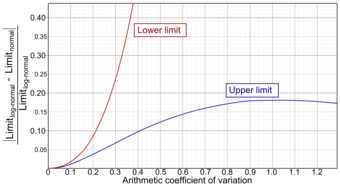
Coefficient of Variation
The coefficient of variation, an example of which is plotted in this graph, can be used to measure the ratio of volatility to expected return.
The coefficient of variation is a dimensionless number, meaning it is independent of the unit in which the measurement has been taken. For this reason, it becomes useful to us in finance to measure the risk of an investment in a way that it is not dependent upon other types of risk, such as that of the overall market.
12.3: Risk and Return
12.3.1: Risk and Return Considerations
The higher the risk undertaken, the more ample the expected return – and conversely, the lower the risk, the more modest the expected return.
Learning Objective
Evaluate a party’s risk aversion when proposing investment opportunities
Key Points
- The general progression in the risk-return spectrum is: short-term debt, long-term debt, property, high-yield debt, and equity.
- When a firm makes a capital budgeting decision, they will wish, as a bare minimum, to recover enough to pay the increased cost of goods due to inflation.
- Risk aversion is a concept based on the behavior of firms and investors while exposed to uncertainty to attempt to reduce that uncertainty.
- Beta is a measure firms can use in order to determine an investment’s return sensitivity in relation to overall market risk.
Key Terms
- political risk
-
the potential loss for a company due to nonmarket factors as macroeconomic and social policies
- inflation
-
An increase in the general level of prices or in the cost of living.
- systematic risk
-
The risk associated with an asset that is correlated with the risk of asset markets generally, often measured as its beta.
Risk and Return Considerations
Risk refers to the variability of possible returns associated with a given investment. Risk, along with the return, is a major consideration in capital budgeting decisions. The firm must compare the expected return from a given investment with the risk associated with it. Higher levels of return are required to compensate for increased levels of risk. In other words, the higher the risk undertaken, the more ample the return – and conversely, the lower the risk, the more modest the return.
This risk and return tradeoff is also known as the risk-return spectrum. There are various classes of possible investments, each with their own positions on the overall risk-return spectrum. The general progression is: short-term debt, long-term debt, property, high-yield debt, and equity. The existence of risk causes the need to incur a number of expenses. For example, the more risky the investment the more time and effort is usually required to obtain information about it and monitor its progress. Moreover, the importance of a loss of X amount of value can be greater than the importance of a gain of X amount of value, so a riskier investment will attract a higher risk premium even if the forecast return is the same as upon a less risky investment. Risk is therefore something that must be compensated for, and the more risk the more compensation is required.
When a firm makes a capital budgeting decision, they will wish, as a bare minimum, to recover enough to pay the increased cost of investment due to inflation. Thus, inflation is a pivotal input in a firm’s cost of capital. However, since interest rates are set by the market, it happens frequently that they are insufficient to compensate for inflation.
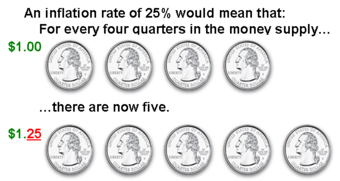
Inflation
Inflation is a rise in the general level of prices of goods and services in an economy over a period of time.
Risk aversion also plays an important role in determining a firm’s required return on an investment. Risk aversion is a concept based on the behavior of firms and investors while exposed to uncertainty to attempt to reduce that uncertainty. Risk aversion is the reluctance to accept a bargain with an uncertain payoff rather than another bargain with a more certain, but possibly lower, expected payoff. For example, a risk-averse investor might choose to put his or her money into a bank account with a low but guaranteed interest rate, rather than into a stock that may have high expected returns, but also involves a chance of losing value. Risk aversion can be thought of as having three levels:
- Risk-averse or risk-avoiding
- Risk-neutral
- Risk-loving or risk-seeking
Beta is a measure firms can use in order to determine an investment’s return sensitivity in relation to overall market risk. Beta describes the correlated volatility of an asset in relation to the volatility of the benchmark that said asset is being compared to. This benchmark is generally the overall financial market and is often estimated via the use of representative indices, such as the S&P 500. Beta is also referred to as financial elasticity or correlated relative volatility, and can be referred to as a measure of the sensitivity of the asset’s returns to market returns, its non-diversifiable risk, its systematic risk, or market risk. Higher-beta investments tend to be more volatile and therefore riskier, but provide the potential for higher returns. Lower-beta investments pose less risk, but generally offer lower returns.
12.4: Scenario and Simulation Assessments
12.4.1: Sensitivity Analysis
Sensitivity analysis determines how much a change in an input will affect the output.
Learning Objective
Describe how sensitivity analysis is used to make investment decisions
Key Points
- Since variations from the base assumptions are expected, businessmen and women want to know how much their output (eg., revenue) will be affected by the variations.
- Sensitivity analysis helps find the optimal levels for inputs (eg., raw material prices, number of employees, sales price) .
- Sensitivity analysis is a statistical tool based on seeing how inputs and parameters affect outputs. Generally, each input is changed one at a time to see how it affects output. However, this does not account for interconnectedness between inputs; they may not be independent variables.
Key Terms
- sensitivity analysis
-
the study of how the uncertainty in the output of a mathematical model or system can be apportioned to different sources of uncertainty in its inputs
- parameter
-
A variable kept constant during an experiment, calculation, or similar.
Capital budgeting is, by definition, forward looking. When dealing with expected resources and demands, uncertainty is a major factor. Sensitivity analysis is a statistical tool that determines how consequential deviations from the expected value occur. Sensitivity Analysis deals with finding out the amount by which we can change the input data for the output of our linear programming model to remain comparatively unchanged. This helps us in determining the sensitivity of the data we supply for the problem. It also helps to determine the optimal levels of each input.
Sensitivity analysis can be useful for a number of reasons, including:
- Support decision making or the development of recommendations for decision makers (e.g., testing the robustness of a result).
- Enhance communication from modelers to decision makers (e.g., by making recommendations more credible, understandable, compelling or persuasive).
- Increase understanding or quantification of the system (e.g., understanding relationships between input and output variables).
- Model development (e.g., searching for errors in the model).
In order to conduct a sensitivity analysis, all of the inputs and parameters are connected via an algorithm to produce the output. For example, a model of the inputs and parameters for a company interest in creating a new product may include information about expected availability of raw material, inflation rates, and number of employees working in R&D. The output would be the profit generated by the new product. The sensitivity analysis entails changing each variable and seeing how that changes the output . Generally, only one variable is changed at once, with all of the others fixed at their base value. This makes it easy to see how much a variable affects the output. However, not all of the inputs may be independent so changing inputs one at a time does not account for interaction between the inputs.
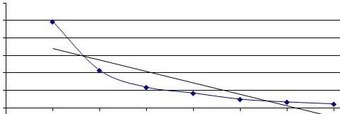
Sensitivity of a Variable
Sensitivity analysis determines how much an output is expected to change due to changes in a variable or parameter. In this case, the output (y-axis) decreases exponentially with an increase in the input (x-axis). This is mapped out for each input.
12.4.2: Scenario Analysis
Scenario analysis is a process of analyzing decisions by considering alternative possible outcomes.
Learning Objective
Explain scenario analysis is used by investors
Key Points
- Scenario analysis is designed to see the consequences of an action under different sets of factors. For example, it shows how an investment’s NPV would differ under high and low inflation.
- Scenarios should be feasible enough to provide an accurate picture of the outcomes. A “good” scenario for an investor should not include winning the lottery because, though good, it is neither probable nor realistic for analyzing possible results.
- Many scenario analyses use 3 scenarios: base case, worst case and best case. However, the number and conditions of the scenarios in each analysis can vary.
Key Terms
- scenario analysis
-
a process of analyzing possible future events by considering alternative possible outcomes
- analysis
-
A process of dismantling or separating into constituent elements in order to study the nature, function, or meaning.
- scenario
-
A set of factors that can affect the consequences of an action. The environment.
Scenario Analysis
Scenario analysis is a strategic process of analyzing decisions by considering alternative possible outcomes (sometimes called “alternative worlds”). It is not a predictive mechanism, but rather an analytic tool to manage uncertainty today. .
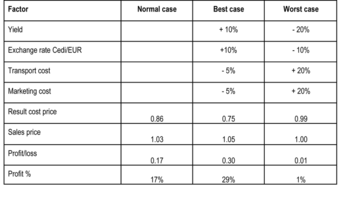
Scenario Analysis
This scenario analysis shows how changes in factors like yield and transport cost can affect profits.
For example, a firm might use scenario analysis to determine the net present value (NPV) of a potential investment under high and low inflation scenarios.
In another example, a bank might attempt to forecast several possible scenarios for the economy (e.g. rapid vs. moderate vs. slow growth) or it might try to forecast financial market returns (for bonds, stocks and cash) in each of those scenarios. Perhaps, it might also consider sub-sets of each of the possibilities. It might further seek to determine correlations and assign probabilities to the scenarios (and sub-sets if any). By analyzing these various scenarios, the bank will be in a better position to consider how best to allocate its assets.
Many scenario analyses use three different scenarios: base case, worst case and best case. The base case is the expected scenario: if all things proceed normally, this is what the expected outcome will be. The worst and best cases are obviously scenarios with less and more favorable conditions, but they are still confined by a sense of feasibility. For example, an investor creating the worst case scenario would not be well served to have it include a meteor strike that destroys the company. While clearly a bad scenario, it is not realistic enough to be helpful.
The purpose of scenario analysis is not to identify the exact conditions of each scenario; it just needs to approximate them to provide a plausible idea of what might happen.
12.4.3: Monte Carlo Simulation
Monte Carlo simulation uses statistical data to figure out the average outcome of a scenario based on multiple, complex factors.
Learning Objective
Describe how Monte Carlo simulations are used
Key Points
- The statistical distribution is estimated for each input (eg. inflation rate, market risk). Then, simulations are run to see how constantly changing inputs (based on their distribution) affect the output. The outputs are averaged to find the estimated output.
- Monte Carlo simulations are great for when there are multiple inputs that can all change and may be unrelated.
- Monte Carlo simulations can be applied in many areas of business, such as bond pricing, but are especially useful when estimating the “base case” is difficult to do by hand.
Key Term
- distribution
-
A probability distribution; the set of relative likelihoods that a variable will have a value in a given interval.
In order to account of complex, interconnected factors, all of which may affect financial outcomes, companies turn to statistical methods. The Monte Carlo method solves a problem by directly simulating the underlying process and then calculating the average result of the process. It simulates the various sources of uncertainty (eg. inflation, default risk, market changes, etc.) that affect the value of the instrument, portfolio, or investment in question, and calculates a representative value given these possible values of the underlying inputs. In essence, the Monte Carlo method is designed to find out what happens to the outcome on average when there are changes in the inputs.
Each potential factor is assigned a probability or statistical distribution. For example, the investor may estimate the probability of default on a bond as 20%. That means that 20% of the time, he will not earn back his principal. The investor may also estimate that the inflation rate is normally distributed around a mean of 3% and standard deviation of 0.5%.
The investor estimates the probability or distribution of every factor that could change the result of the investment. Then, he essentially uses the distributions to run many many simulations of all the inputs to see how they affect the output and then finds the average output .
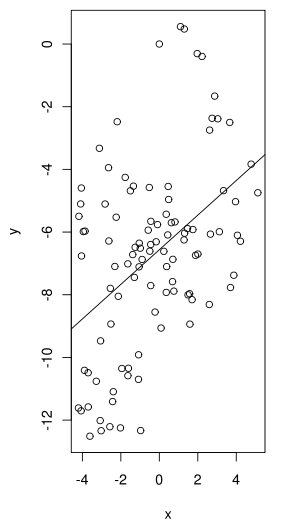
Monte Carlo Simulation
By running many simulations based on the probability or distribution of an input (x), the analyst can see the average output (y). This is done for multiple inputs at once to find out how they affect the output.
For example, for bonds and bond options, under each possible evolution of interest rates the investor observes a different yield curve and a different resultant bond price. To determine the bond value, these bond prices are then averaged. To value the bond option, as for equity options, the corresponding exercise values are averaged and present valued. By determining the average, the investor can figure out what the expected value is.
The advantage of the Monte Carlo method is that it is able to handle multiple moving, and possible related, inputs. As the number of factors increases, it becomes harder to figure out the “base case. ” Statistical analysis through Monte Carlo simulations is great at handling problems with multiple, inter-related, and uncertain factors.
12.4.4: Decision Trees
A decision tree is a decision support tool that uses a tree-like graph or model of decisions and their possible consequences.
Learning Objective
Describe how to set up a decision tree
Key Points
- Decision trees look similar to flow charts, except they are designed to pick the most optimal strategy.
- There are three types of nodes on a decision tree: decision nodes, chance nodes, and end nodes.
- Decision trees are solved from top to bottom in order to determine the most optimal strategy. Sometimes, there may not be an obvious optimal strategy, but the tree is still useful for mapping out the options faced and their costs/benefits.
Key Term
- node
-
A vertex point on a decision tree. Other branches may extend from it; if none do, it is an end node.
A decision tree is a decision support tool that uses a tree-like graph or model of decisions and their possible consequences, including chance event outcomes, resource costs, and utility. They help to identify the strategy that is most likely to reach the declared goal. For an investor, this may be used to help determine which bond to buy in order to get the highest expected return with only a certain amount of risk. Decision trees are set up much like an organizational flow chart.
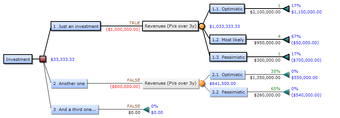
Decision Tree
This decision tree highlights the outcomes of different investing strategies. Next to the terminal nodes is blue text with the yield and gain.
Unlike a flow chart, a decision tree consists of three types of nodes:
- Decision nodes – commonly represented by squares – the user gets to decide which branch to take.
- Chance nodes – represented by circles – the branch taken is determined by probabilities.
- End nodes – represented by triangles – there are no more branches extending from the node, and the final value of the strategy is listed.
In order to set up and use a decision tree, the user must first list each decision point. For example, in , the investor first listed the number of investments that could be made (1, 2, or 3) and then the options for the likely payoffs (optimistic, most likely, etc.). Each end node was given a value. Working from left to right (or top to bottom), the investor determined that making one investment has the highest expected value ($641,500 vs. $0). Therefore, the investor will definitely choose to make one investment. Then, to determine the payoff, the probabilities and yields are listed. This is a chance node, so the investor doesn’t know how much he will earn from the investment, but does know his options.
Decision trees can become very complex, so determining the correct strategy becomes more difficult. Decision trees are always solved from the top to the bottom (or left to right) and is just a process of picking the most optimal path or seeing the likely payoffs.
There may not be an idea strategy shown on the decision tree. In that case, the decision tree is still useful as a way to map out all of the possible strategies with their costs and benefits.
12.5: Factors Impacting Capital Budgeting
12.5.1: Risk Adjusting the Discount Rate
Discount rates are adjusted on an investment to investment basis, as different investments encounter different degrees of risk that must be considered when determining equitable returns.
Learning Objective
Realize the reasoning behind adjusting discount rates for risk, and the way this impacts the cost of capital
Key Points
- In central banking, the established discount rate will act as the benchmark for future interest rates issued. This cost will be adjusted on an investment to investment basis depending upon the degree of risk.
- Discount rates are utilized in net present value calculations (NPV) in order to determine the rate of risk and return a new venture or new project should provide.
- Calculating NPV is an extremely useful tool. An NPV analysis will take future expectations of cost and revenue and ground them in present day dollars (to take into account the time value of money). This shows if/when a project will be profitable.
- When adjusting the NPV calculation for additional risks, and thus risk-adjusting the discount rate, a variety of factors can be taken into consideration. A rNPV (risk-adjusting NPV) will assign a probability to each incoming cash flow to adjust expectations of risk in the calculation.
Key Term
- discounted cash flow
-
An estimated future cash flow discounted by the probability of receiving that cash flow.
What is the Discount Rate?
The discount rate has a few definitions, depending on the context. For the sake of this discussion, the discount rate is the percentage used in an net present value calculation to understand the overall cost of capital (or, from the perspective of some investors, the required return) on a given project. What this means is that there is a rate, calculated by the assumption of risk, which is used to normalize the interest rate on borrowed capital (for the borrower) and/or invested capital (for the lender.
In U.S. central banking, the interest rate that banks pay the federal reserve when using securities as collateral is also referred to as the discount rate, and in this case it will act as the benchmark for future interest rates issued.
Why Adjust for Risk?
The primary purpose of a discount rate, or an interest rate in general, is fairly simple. Capital today is worth more than capital tomorrow, due to the time value of money (i.e. the opportunity cost of foregone investments). As a result of this concept, the idea of interest rates is justified. All this means is that a borrower of capital will have to take into account the cost of that capital over a given time period, which will be calculated as an additional percentage of the overall principal borrowed being added to the principal itself on a period to period basis.
In this context, the interest rate is subjected to risk. A riskier investment will require a higher return (due to the basic premise of risk and return). After all, why invest in a riskier investment when safer investments exist unless that riskier investment offers a higher percentage of return? It is at this point that the logic behind adjusting discount rates becomes practical. All discount rates must take into account the overall risk being assumed in the investment, and adjust the rate of expected return to meet the implications of the overall risk over time. For banks, for example, the overall interest rate they would offer a risky entrepreneurial project isn’t the same as the rate they would offer an established big business.
Risk-adjusted Net Present Value
A net present value calculation is a common and useful tool that takes the overall future projected costs and returns of a new venture or business project and grounds it in today’s dollars. What this means is it calculates out the time value of money during the projected time period of the financing of the project in order to see if the returns over a given time period will exceed the costs in beginning the project. As an entrepreneur, this will tell you if/when you will reach profitability (using a variety of assumptions). It is calculated as follows:
Adjusting this for the risk-adjusted discount rate is a simple modification, where each future cash flow is multiplied by the estimated likelihood of its occurrence. In this situation, a higher degree of uncertainty (and thus risk) is built into each expected cash flow (called a discounted cash flow, or DCF). Through discounting each cash flow by the estimated probability of receiving that return, the overall riskiness of the NPV calculation is increased. With this increase in risk, the discount rate can now be risk-adjusted accordingly.
Common Risk-adjusted Discount Rates
It is important to note at this point that every calculation is different, and some start-ups will see low discount rates because investors believe strongly in what the start up is trying to accomplish. However, the discount rates typically applied to different types of companies show significant differences:
- Early start-ups: 40–60%
- More established start-ups: 30–50%
- Mature companies: 10–25%
All and all, investors must carefully consider the risk in a given investment, and adjust the discount rates accordingly. This ensures a proper assessment of the risk and return ratio for various differentiated investment projects.
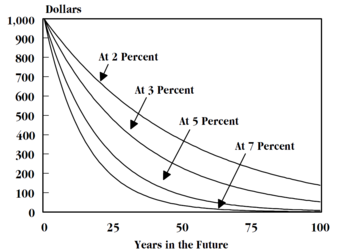
Discounting Curves
This chart illustrates the devaluation of capital over time as a result of various discount rates.
12.5.2: Risk Adjusting for the Time Horizon
A longer time horizon usually requires a higher return, due to increased price volatility and uncertainty relating to possible outcomes.
Learning Objective
Explain how an investement’s duration can influence its inherent risk
Key Points
- In terms of debt investments, default risk increases as the time horizon lengthens.
- Since stock investments have more time to overcome potential downturns in value, having a longer time horizon can justify more aggressive investing.
- When there are multiple possible outcomes, management of a firm may choose to undertake real options analysis in order to factor in the various possibilities.
Key Terms
- salvage value
-
The estimated value of an asset at the end of its useful life.
- time horizon
-
The period of time the asset is expected to be held or a project is expected to last.
Risk Adjusting for the Time Horizon
When evaluating the riskiness of an investment, not only will investors or companies need to evaluate their preferences and risk tolerance, but it is also necessary to take into account the time horizon of the investment. A longer time horizon will generally require a higher return, due to an increased risk in price volatility and increased uncertainty relating to possible outcomes. In terms of long term debt investments, such as long term corporate or government bonds, a longer time horizon gives rise to uncertainties in the potential operations of the debtor entity as well as unforeseen movements in the market as a whole. In other words, default risk increases as the time horizon lengthens. However, when considering stock investments, having a longer time horizon can be considered safer in some respects. Since stock investments have more time to overcome potential downturns in value, having a longer time horizon can justify more aggressive investing. For example, an individual investor with a time horizon of less than five years should not be invested in stocks. However, those with time horizons over five years should consider stocks because of their growth potential. Put simply, as time horizon lengthens a higher percentages of stocks should be added to a portfolio.
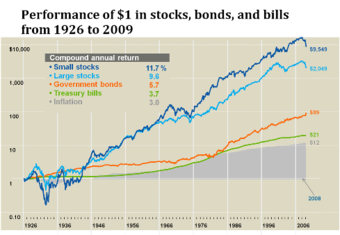
Performance of Stocks, Bonds and Bills
This graph gives an illustration of investing a dollar in different asset classes in the market from 1926 to the end of 2007.
For an individual, diversifying investments in different time horizons is also important. By staying in the market through different market cycles, individuals can reduce the risk of receiving a lower return than expected–especially with investments that fluctuate significantly over the short term.
Real Options Consideration
When there are multiple possible outcomes, management of a firm may choose to undertake real options analysis in order to factor in the various possibilities. A real option itself is the right, but not the obligation, to undertake certain business initiatives, such as deferring, abandoning, expanding, staging, or contracting a capital investment project. When uncertainty exists as to when and how business or other conditions will eventuate, flexibility as to the timing of the relevant project is valuable and constitutes optionality. Some examples include Inflation or deferment options, where management has flexibility as to when to start a project. For example, in natural resource exploration a firm can delay mining a deposit until market conditions are favorable. Also, an option to abandon, where management may have the option to cease a project during its life, and, possibly, to realize its salvage value. Here, when the present value of the remaining cash flows falls below this salvage value, the asset may be sold. Finally, sequencing options, where management can observe outcomes from a part of a project and resolve some of the uncertainty relating to the venture overall. Once resolved, management has the option to proceed or not with the development of the other projects.
12.6: Other Considerations in Capital Budgeting
12.6.1: Other Considerations in Capital Budgeting
The real option creates economic value by generating future decision rights for management.
Learning Objective
Describe how options influence capital budgeting and investment decisions
Key Points
- Traditional NPV analysis fails to consider that management can adapt and revise its strategies in response to unexpected market and technological developments that cause cash flows to deviate from their original expectations.
- The notion of real options was developed from the idea that one can view firms’ discretionary investment opportunities as a call option on real assets, in much the same way as a financial call option provides decision rights on financial assets.
- The option to defer an investment creates value because exogenous uncertainty can be reduced with the passage of time.
- Growth options are investments made not only for immediate cash flows from the project, but also for the economic value derived from subsequent investment opportunities.
Key Terms
- propensity
-
A tendency, preference, or attraction.
- net present value
-
the present value of a project or an investment decision determined by summing the discounted incoming and outgoing future cash flows resulting from the decision
Real Options and Capital Budgeting
Traditional capital budgeting theory holds that investments should be made when the simple net present value (NPV) of an investment opportunity equals or exceeds zero. It also assumes that the investment must be made either now or never. However, such an investment approach fails to consider that management can adapt and revise its strategies in response to unexpected market and technological developments that cause cash flows to deviate from their original expectations. In other words, it fails to capture managers’ flexibility in adapting their decisions to evolving market and technological uncertainty. The notion of real options was developed from the idea that one can view firms’ discretionary investment opportunities as a call option on real assets, in much the same way as a financial call option provides decision rights on financial assets.
A simple financial option gives its holder the right, but not the obligation, to buy or sell a specified quantity of an underlying asset at a specified price at or before a specified date. By analogy, a real option confers on the firm the right, but not the obligation, to take some action in the future. The option is “real” because the underlying assets are usually physical and human assets rather than financial securities. The commonality in applying option-pricing models for real assets and for financial securities is that the future is uncertain. In an uncertain environment, having the flexibility to decide what to do after some of that uncertainty is resolved has value. A key feature is that the real option creates economic value by generating future decision rights – specifically, by offering management the flexibility to act upon new information such that the upside economic potential is retained while the downside losses are contained .
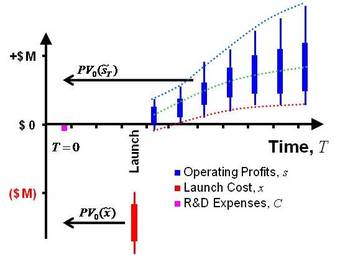
Project Cash Flow With Uncertainty
Projects with real options can be evaluated using a range of possible profits.
Real Options and Investment Decisions
A strategic implication of real options theory is that investment will be discouraged by exogenous uncertainty. For this reason, the timing of an investment can be crucial in determining its profitability. In other words, the option to defer an investment creates value because exogenous uncertainty can be reduced with the passage of time.
Another value-creating aspect of real options can be found in abandonment. The abandonment options comes into play when a firm purchases an asset that it may later resell or put to an alternative use, should future conditions be sufficiently adverse. Availability and recognition of this option will increase a firm’s propensity to invest relative to what would be suggested by a simple NPV rule, which assumes that the investment project continues for its physical lifetime and omits the possibility of future divestment.
Growth Options
Real investments are often made not only for immediate cash flows from the project, but also for the economic value derived from subsequent investment opportunities. Such future discretionary investment opportunities are known as growth options. For example, firms usually undertake research and development investments to strategically position themselves for the economic value from commercialization when market conditions turn favorable. Similarly, firms usually make foothold investments in a new foreign market for the possibility of expansion in the future. Such growth-oriented investment may appear uneconomical when viewed in isolation but may enable firms to capture future growth opportunities.
Chapter 11: Capital Budgeting
11.1: Introduction to Capital Budgeting
11.1.1: Defining Capital Budgeting
Capital budgeting is the planning process used to determine which of an organization’s long term investments are worth pursuing.
Learning Objective
Differentiate between the different capital budget methods
Key Points
- Capital budgeting, which is also called investment appraisal, is the planning process used to determine whether an organization’s long term investments, major capital, or expenditures are worth pursuing.
- Major methods for capital budgeting include Net present value, Internal rate of return, Payback period, Profitability index, Equivalent annuity and Real options analysis.
- The IRR method will result in the same decision as the NPV method for non-mutually exclusive projects in an unconstrained environment; Nevertheless, for mutually exclusive projects, the decision rule of taking the project with the highest IRR may select a project with a lower NPV.
Key Terms
- Modified Internal Rate of Return
-
The modified internal rate of return (MIRR) is a financial measure of an investment’s attractiveness. It is used in capital budgeting to rank alternative investments of equal size. As the name implies, MIRR is a modification of the internal rate of return (IRR) and, as such, aims to resolve some problems with the IRR.
- APT
-
In finance, arbitrage pricing theory (APT) is a general theory of asset pricing that holds, which holds that the expected return of a financial asset can be modeled as a linear function of various macro-economic factors or theoretical market indices, where sensitivity to changes in each factor is represented by a factor-specific beta coefficient.
Example
- Payback period: For example, a $1000 investment which returned $500 per year would have a two year payback period. The time value of money is not taken into account.
Capital Budgeting
Capital budgeting, which is also called “investment appraisal,” is the planning process used to determine which of an organization’s long term investments such as new machinery, replacement machinery, new plants, new products, and research development projects are worth pursuing. It is to budget for major capital investments or expenditures.
Major Methods
Many formal methods are used in capital budgeting, including the techniques as followed:
- Net present value
- Internal rate of return
- Payback period
- Profitability index
- Equivalent annuity
- Real options analysis
Net Present Value
Net present value (NPV) is used to estimate each potential project’s value by using a discounted cash flow (DCF) valuation. This valuation requires estimating the size and timing of all the incremental cash flows from the project. The NPV is greatly affected by the discount rate, so selecting the proper rate–sometimes called the hurdle rate–is critical to making the right decision.
This should reflect the riskiness of the investment, typically measured by the volatility of cash flows, and must take into account the financing mix. Managers may use models, such as the CAPM or the APT, to estimate a discount rate appropriate for each particular project, and use the weighted average cost of capital(WACC) to reflect the financing mix selected. A common practice in choosing a discount rate for a project is to apply a WACC that applies to the entire firm, but a higher discount rate may be more appropriate when a project’s risk is higher than the risk of the firm as a whole.
Internal Rate of Return
The internal rate of return (IRR) is defined as the discount rate that gives a net present value (NPV) of zero. It is a commonly used measure of investment efficiency.
The IRR method will result in the same decision as the NPV method for non-mutually exclusive projects in an unconstrained environment, in the usual cases where a negative cash flow occurs at the start of the project, followed by all positive cash flows. Nevertheless, for mutually exclusive projects, the decision rule of taking the project with the highest IRR, which is often used, may select a project with a lower NPV.
One shortcoming of the IRR method is that it is commonly misunderstood to convey the actual annual profitability of an investment. Accordingly, a measure called “Modified Internal Rate of Return (MIRR)” is often used.
Payback Period
Payback period in capital budgeting refers to the period of time required for the return on an investment to “repay” the sum of the original investment. Payback period intuitively measures how long something takes to “pay for itself. ” All else being equal, shorter payback periods are preferable to longer payback periods.
The payback period is considered a method of analysis with serious limitations and qualifications for its use, because it does not account for the time value of money, risk, financing, or other important considerations, such as the opportunity cost.
Profitability Index
Profitability index (PI), also known as profit investment ratio (PIR) and value investment ratio (VIR), is the ratio of payoff to investment of a proposed project. It is a useful tool for ranking projects, because it allows you to quantify the amount of value created per unit of investment.
Equivalent Annuity
The equivalent annuity method expresses the NPV as an annualized cash flow by dividing it by the present value of the annuity factor. It is often used when comparing investment projects of unequal lifespans. For example, if project A has an expected lifetime of seven years, and project B has an expected lifetime of 11 years, it would be improper to simply compare the net present values (NPVs) of the two projects, unless the projects could not be repeated.
Real Options Analysis
The discounted cash flow methods essentially value projects as if they were risky bonds, with the promised cash flows known. But managers will have many choices of how to increase future cash inflows or to decrease future cash outflows. In other words, managers get to manage the projects, not simply accept or reject them. Real options analysis try to value the choices–the option value–that the managers will have in the future and adds these values to the NPV.
These methods use the incremental cash flows from each potential investment or project. Techniques based on accounting earnings and accounting rules are sometimes used. Simplified and hybrid methods are used as well, such as payback period and discounted payback period.
11.1.2: The Goals of Capital Budgeting
The main goals of capital budgeting are not only to control resources and provide visibility, but also to rank projects and raise funds.
Learning Objective
Describe the goals of the capital budgeting process
Key Points
- Basically, the purpose of budgeting is to provide a forecast of revenues and expenditures and construct a model of how business might perform financially.
- Capital Budgeting is most involved in ranking projects and raising funds when long-term investment is taken into account.
- Capital budgeting is an important task as large sums of money are involved and a long-term investment, once made, can not be reversed without significant loss of invested capital.
Key Terms
- Preferred Stock
-
Preferred stock (also called preferred shares, preference shares or simply preferreds) is an equity security with properties of both an equity and a debt instrument, and is generally considered a hybrid instrument.
- Common stock
-
Common stock is a form of corporate equity ownership, a type of security.
The purpose of budgeting is to provide a forecast of revenues and expenditures. That is, to construct a model of how a business might perform financially if certain strategies, events, and plans are carried out. It enables the actual financial operation of the business to be measured against the forecast, and it establishes the cost constraint for a project, program, or operation.
Budgeting helps to aid the planning of actual operations by forcing managers to consider how the conditions might change, and what steps should be taken in such an event. It encourages managers to consider problems before they arise. It also helps co-ordinate the activities of the organization by compelling managers to examine relationships between their own operation and those of other departments.
Other essential functions of a budget include:
- To control resources
- To communicate plans to various responsibility center managers
- To motivate managers to strive to achieve budget goals
- To evaluate the performance of managers
- To provide visibility into the company’s performance
Capital Budgeting, as a part of budgeting, more specifically focuses on long-term investment, major capital and capital expenditures. The main goals of capital budgeting involve:
Ranking Projects
The real value of capital budgeting is to rank projects. Most organizations have many projects that could potentially be financially rewarding. Once it has been determined that a particular project has exceeded its hurdle, then it should be ranked against peer projects (e.g. – highest Profitability index to lowest Profitability index). The highest ranking projects should be implemented until the budgeted capital has been expended.

Private Equity
Private equity firms, such as NBGI, provide funds for companies unable or uninterested in obtaining funds publicly.
Raising funds
When a corporation determines its capital budget, it must acquire funds. Three methods are generally available to publicly-traded corporations: corporate bonds, preferred stock, and common stock. The ideal mix of those funding sources is determined by the financial managers of the firm and is related to the amount of financial risk that the corporation is willing to undertake.
Corporate bonds entail the lowest financial risk and, therefore, generally have the lowest interest rate. Preferred stock have no financial risk but dividends, including all in arrears, must be paid to the preferred stockholders before any cash disbursements can be made to common stockholders; they generally have interest rates higher than those of corporate bonds. Finally, common stocks entail no financial risk but are the most expensive way to finance capital projects.The Internal Rate of Return is very important.
Capital budgeting is an important task as large sums of money are involved, which influences the profitability of the firm. Plus, a long-term investment, once made, cannot be reversed without significant loss of invested capital. The implication of long-term investment decisions are more extensive than those of short-run decisions because of the time factor involved; capital budgeting decisions are subject to a higher degree of risk and uncertainty than are short-run decisions.

Goals of capital budgeting
The main goal of capital budgeting is to rank projects.
11.1.3: Accounting Flows and Cash Flows
Capital budgeting requires a thorough understanding of cash flow and accounting principles, particularly as they pertain to valuing processes and investments.
Learning Objective
Identify the various sources of cash flow within an organization
Key Points
- Accounting revolves around tracking the inflows and outflows of assets, capital, and resources for an organization to adhere to legal and investor expectations.
- When measuring the impact of assets, liabilities, and equity, it is useful to know in which situations to debit or credit the line item based upon the flow of capital.
- Cash flows analyses, such as the internal rate of return (IRR) or the net present value (NPV) of a given process, are core tools in capital budgeting for understanding and estimating cash flows.
- Cash flow analyses can include investing, operating and financing activities.
Key Terms
- internal rate of return (IRR)
-
A calculation that makes the net present value of all cash flows (positive and negative) from a particular investment equal to zero. It can also be described as the rate which will make an investment break even.
- net present value (NPV)
-
This calculation takes all future cash flows from a given operational initiative, and discounts them to their present value based on the weighted average cost of capital.
Accounting Flows
Accounting is the processes used to identify and transpose business transactions into permanent legal records of a business’s operations and capital flows. The International Accounting Standards (IAS) and the Generally Accepted Accounting Principles (GAAP) are legislative descriptions of expectations and norms within the accounting field.
When it comes to the capital flows in accounting, it is easiest to visualize it based on each type of item:

Accounting Flows
This chart is a useful way to see the trajectory of accounting flows as they apply to different types of line items.
Understanding how to report each type of asset, and the impacts these asset changes have on income statements, balance sheets, and cash flow statements, is important in accurately depicting accounting flows.
Cash Flows
A cash flow is one element of accounting flows, and particularly important to understanding capital budgeting. A cash flow describes the transmission of payments and returns internally and/or externally as a byproduct of operations over time. Conducting cash flow analyses on current or potential projects and investments is a critical aspect of capital budgeting, and determines the profitability, cost of capital, and/or expected rate of return on a given project, organizational operation or investment.
Cash flow analyses can reveal the rate of return, or value of suggested project, through deriving the internal rate of return (IRR) and the net present value (NPV). They also indicate overall liquidity, or a business’s capacity to capture existing opportunities through freeing of capital for future investments. Cash flows will also underline overall profitability including, but not limited to, net income.
Cash flows consolidate inputs from the following activities:
- Investing activities – Payments related to mergers or acquisitions, loans made to suppliers or received from customers, as well as the purchase or sale of assets are all considered investing activities and tracked as incoming or outgoing cash flows.
- Operating activities – Operating activities can be quite broad, incorporating anything related to the production, sale, or delivery of a given product or service. This includes raw materials, advertising, shipping, inventory, payments to suppliers and employee, interest payments, depreciation, deferred tax, and amortization.
- Financing activities – Financing activities primarily revolve around cash inflows from banks and shareholders, as well as outflows via dividends to investors. This includes, payment for repurchase of company shares, dividends, net borrowing and net repayment of debt.
11.1.4: Ranking Investment Proposals
Several methods are commonly used to rank investment proposals, including NPV, IRR, PI, payback period, and ARR.
Learning Objective
Analyze investment proposals by ranking them using different methods
Key Points
- The higher the NPV, the more attractive the investment proposal.
- The higher a project’s IRR, the more desirable it is to undertake the project.
- As the value of the profitability index increases, so does the financial attractiveness of the proposed project.
- Shorter payback periods are preferable to longer payback periods.
- The higher the ARR, the more attractive the investment.
Key Terms
- time value of money
-
The time value of money is the value of money, figuring in a given amount of interest earned over a given amount of time.
- discounted cash flow
-
In finance, discounted cash flow (DCF) analysis is a method of valuing a project, company, or asset using the concepts of the time value of money.
The most valuable aim of capital budgeting is to rank investment proposals. To choose the most valuable investment option, several methods are commonly used:

Investment Proposal
Choosing the best investment proposal for business
Net Present Value (NPV):
NPV can be described as the “difference amount” between the sums of discounted: cash inflows and cash outflows. In the case when all future cash flows are incoming, and the only outflow of cash is the purchase price, the NPV is simply the PV of future cash flows minus the purchase price (which is its own PV). The higher the NPV, the more attractive the investment proposal. NPV is a central tool in discounted cash flow (DCF) analysis and is a standard method for using the time value of money to appraise long-term projects. Used for capital budgeting and widely used throughout economics, finance, and accounting, it measures the excess or shortfall of cash flows, in present value terms, once financing charges are met.

NPV formula
Each cash inflow/outflow is discounted back to its present value (PV). Then they are summed. Therefore, NPV is the sum of all terms.
In financial theory, if there is a choice between two mutually exclusive alternatives, the one yielding the higher NPV should be selected. The rules of decision making are:
- When NPV > 0, the investment would add value to the firm so the project may be accepted
- When NPV < 0, the investment would subtract value from the firm so the project should be rejected
- When NPV = 0, the investment would neither gain nor lose value for the firm. We should be indifferent in the decision whether to accept or reject the project. This project adds no monetary value. Decision should be based on other criteria (e.g., strategic positioning or other factors not explicitly included in the calculation).
An NPV calculated using variable discount rates (if they are known for the duration of the investment) better reflects the situation than one calculated from a constant discount rate for the entire investment duration.
Internal Rate of Return (IRR)
The internal rate of return on an investment or project is the “annualized effective compounded return rate” or “rate of return” that makes the net present value (NPV as NET*1/(1+IRR)^year) of all cash flows (both positive and negative) from a particular investment equal to zero.
IRR calculations are commonly used to evaluate the desirability of investments or projects. The higher a project’s IRR, the more desirable it is to undertake the project. Assuming all projects require the same amount of up-front investment, the project with the highest IRR would be considered the best and undertaken first.
Profitability Index (PI)
It is a useful tool for ranking projects, because it allows you to quantify the amount of value created per unit of investment. The ratio is calculated as follows:
Profitability index = PV of future cash flows / Initial investment
As the value of the profitability index increases, so does the financial attractiveness of the proposed project. Rules for selection or rejection of a project:
- If PI > 1 then accept the project
- If PI < 1 then reject the project
Payback Period
Payback period intuitively measures how long something takes to “pay for itself. ” All else being equal, shorter payback periods are preferable to longer payback periods. Payback period is widely used because of its ease of use despite the recognized limitations: The time value of money is not taken into account.
Accounting Rate of Return (ARR)
The ratio does not take into account the concept of time value of money. ARR calculates the return, generated from net income of the proposed capital investment. The ARR is a percentage return. Say, if ARR = 7%, then it means that the project is expected to earn seven cents out of each dollar invested. If the ARR is equal to or greater than the required rate of return, the project is acceptable. If it is less than the desired rate, it should be rejected. When comparing investments, the higher the ARR, the more attractive the investment. Basic formulae:
ARR = Average profit / Average investment
Where: Average investment = (Book value at beginning of year 1 + Book value at end of user life) / 2
11.1.5: Reinvestment Assumptions
NPV and PI assume reinvestment at the discount rate, while IRR assumes reinvestment at the internal rate of return.
Learning Objective
Identify the reinvestment assumptions of different capital budgeting methods
Key Points
- If trying to decide between alternative investments in order to maximize the value of the firm, the reinvestment rate would be a better choice.
- NPV and PI assume reinvestment at the discount rate.
- IRR assumes reinvestment at the internal rate of return.
Key Term
- Weighted average cost of capital
-
The weighted average cost of capital (WACC) is the rate that a company is expected to pay on average to all its security holders to finance its assets.
Example
- At the end of the first quarter, the investor had capital of $1,010.00, which then earned $10.10 during the second quarter. The extra dime was interest on his additional $10 investment.
Reinvestment Rate
To some extent, the selection of the discount rate is dependent on the use to which it will be put. If the intent is simply to determine whether a project will add value to the company, using the firm’s weighted average cost of capital may be appropriate. If trying to decide between alternative investments in order to maximize the value of the firm, the corporate reinvestment rate would probably be a better choice.

Reinvestment
Reinvestment to expand business

Reinvestment Factor
Describe how the reinvestment factors related to total return.
NPV Reinvestment Assumption
The rate used to discount future cash flows to the present value is a key variable of this process. A firm’s weighted average cost of capital (after tax) is often used, but many people believe that it is appropriate to use higher discount rates to adjust for risk or other factors. A variable discount rate with higher rates applied to cash flows occurring further along the time span might be used to reflect the yield curve premium for long-term debt.
Another approach to choosing the discount rate factor is to decide the rate that the capital needed for the project could return if invested in an alternative venture. Related to this concept is to use the firm’s reinvestment rate. Reinvestment rate can be defined as the rate of return for the firm’s investments on average. When analyzing projects in a capital constrained environment, it may be appropriate to use the reinvestment rate, rather than the firm’s weighted average cost of capital as the discount factor. It reflects opportunity cost of investment, rather than the possibly lower cost of capital.
PI Reinvestment Assumption
Profitability index assumes that the cash flow calculated does not include the investment made in the project, which means PI reinvestment at the discount rate as NPV method. A profitability index of 1 indicates break even. Any value lower than one would indicate that the project’s PV is less than the initial investment. As the value of the profitability index increases, so does the financial attractiveness of the proposed project.
IRR Reinvestment Assumption
As an investment decision tool, the calculated IRR should not be used to rate mutually exclusive projects but only to decide whether a single project is worth the investment. In cases where one project has a higher initial investment than a second mutually exclusive project, the first project may have a lower IRR (expected return) but a higher NPV (increase in shareholders’ wealth) and, thus, should be accepted over the second project (assuming no capital constraints).
IRR assumes reinvestment of interim cash flows in projects with equal rates of return (the reinvestment can be the same project or a different project). Therefore, IRR overstates the annual equivalent rate of return for a project that has interim cash flows which are reinvested at a rate lower than the calculated IRR. This presents a problem, especially for high IRR projects, since there is frequently not another project available in the interim that can earn the same rate of return as the first project.
When the calculated IRR is higher than the true reinvestment rate for interim cash flows, the measure will overestimate–sometimes very significantly–the annual equivalent return from the project. This makes IRR a suitable (and popular) choice for analyzing venture capital and other private equity investments, as these strategies usually require several cash investments throughout the project, but only see one cash outflow at the end of the project (e.g., via IPO or M&A).
When a project has multiple IRRs, it may be more convenient to compute the IRR of the project with the benefits reinvested. Accordingly, MIRR is used, which has an assumed reinvestment rate, usually equal to the project’s cost of capital.

Calculation of the MIRR
MIRR is calculated as follows:
11.1.6: Long-Term vs. Short-Term Financing
Long-term financing is generally for assets and projects and short term financing is typically for continuing operations.
Learning Objective
Classify the different financing methods between short-term and long-term
Key Points
- Management must match long-term financing or short-term financing mix to the assets being financed in terms of both timing and cash flow.
- Long-term financing includes equity issued, Corporate bond, Capital notes and so on.
- Short-term financing includes Commercial papers, Promissory notes, Asset-based loans, Repurchase agreements, letters of credit and so on.
Key Terms
- Swap
-
In finance, a swap is a derivative in which counterparties exchange cash flows of one party’s financial instrument for those of the other party’s financial instrument.
- Call option
-
A call option, often simply labeled a “call”, is a financial contract between two parties, the buyer and the seller of this type of option. [1] The buyer of the call option has the right, but not the obligation to buy an agreed quantity of a particular commodity or financial instrument (the underlying) from the seller of the option at a certain time (the expiration date) for a certain price (the strike price)
- accounts receivable
-
Accounts receivable also known as Debtors, is money owed to a business by its clients (customers) and shown on its balance sheet as an asset.
Achieving the goals of corporate finance requires appropriate financing of any corporate investment. The sources of financing are, generically, capital that is self-generated by the firm and capital from external funders, obtained by issuing new debt and equity.
Management must attempt to match the long-term or short-term financing mix to the assets being financed as closely as possible, in terms of both timing and cash flows.

Financing
To manage business often requires long-term and short-term financing.
Long-Term Financing
Businesses need long-term financing for acquiring new equipment, R&D, cash flow enhancement and company expansion. Major methods for long-term financing are as follows:
Equity Financing
This includes preferred stocks and common stocks and is less risky with respect to cash flow commitments. However, it does result in a dilution of share ownership, control and earnings. The cost of equity is also typically higher than the cost of debt – which is, additionally, a deductible expense – and so equity financing may result in an increased hurdle rate which may offset any reduction in cash flow risk.
Corporate Bond
A corporate bond is a bond issued by a corporation to raise money effectively so as to expand its business. The term is usually applied to longer-term debt instruments, generally with a maturity date falling at least a year after their issue date.
Some corporate bonds have an embedded call option that allows the issuer to redeem the debt before its maturity date. Other bonds, known as convertible bonds, allow investors to convert the bond into equity.
Capital Notes
Capital notes are a form of convertible security exercisable into shares. They are equity vehicles. Capital notes are similar to warrants, except that they often do not have an expiration date or an exercise price (hence, the entire consideration the company expects to receive, for its future issue of shares, is paid when the capital note is issued). Many times, capital notes are issued in connection with a debt-for-equity swap restructuring: instead of issuing the shares (that replace debt) in the present, the company gives creditors convertible securities – capital notes – so the dilution will occur later.
Short-Term Financing
Short-term financing can be used over a period of up to a year to help corporations increase inventory orders, payrolls and daily supplies. Short-term financing includes the following financial instruments:
Commercial Paper
This is an unsecured promissory note with a fixed maturity of 1 to 364 days in the global money market. It is issued by large corporations to get financing to meet short-term debt obligations. It is only backed by an issuing bank or corporation’s promise to pay the face amount on the maturity date specified on the note. Since it is not backed by collateral, only firms with excellent credit ratings from a recognized rating agency will be able to sell their commercial paper at a reasonable price.
Asset-backed commercial paper (ABCP) is a form of commercial paper that is collateralized by other financial assets. ABCP is typically a short-term instrument that matures between 1 and 180 days from issuance and is typically issued by a bank or other financial institution.
Promissory Note
This is a negotiable instrument, wherein one party (the maker or issuer) makes an unconditional promise in writing to pay a determinate sum of money to the other (the payee), either at a fixed or determinable future time or on demand of the payee, under specific terms.
Asset-based Loan
This type of loan, often short term, is secured by a company’s assets. Real estate, accounts receivable (A/R), inventory and equipment are typical assets used to back the loan. The loan may be backed by a single category of assets or a combination of assets (for instance, a combination of A/R and equipment).
Repurchase Agreements
These are short-term loans (normally for less than two weeks and frequently for just one day) arranged by selling securities to an investor with an agreement to repurchase them at a fixed price on a fixed date.
Letter of Credit
This is a document that a financial institution or similar party issues to a seller of goods or services which provides that the issuer will pay the seller for goods or services the seller delivers to a third-party buyer. The issuer then seeks reimbursement from the buyer or from the buyer’s bank. The document serves essentially as a guarantee to the seller that it will be paid by the issuer of the letter of credit, regardless of whether the buyer ultimately fails to pay.
11.2: The Payback Method
11.2.1: Defining the Payback Method
The payback method is a method of evaluating a project by measuring the time it will take to recover the initial investment.
Learning Objective
Define the payback method
Key Points
- The payback period is the number of months or years it takes to return the initial investment.
- To calculate a more exact payback period: payback period = amount to be invested / estimated annual net cash flow.
- The payback method also ignores the cash flows beyond the payback period; thus, it ignores the long-term profitability of a project.
Key Terms
- Opportunity cost
-
The cost of an opportunity forgone (and the loss of the benefits that could be received from that opportunity); the most valuable forgone alternative.
- cost of capital
-
the rate of return that capital could be expected to earn in an alternative investment of equivalent risk
- time value of money
-
The value of money, figuring in a given amount of interest, earned over a given amount of time.
Example
- A $1000 investment which returned $500 per year would have a two year payback period.
Defining the Payback Method
In capital budgeting, the payback period refers to the period of time required for the return on an investment to “repay” the sum of the original investment.
As a tool of analysis, the payback method is often used because it is easy to apply and understand for most individuals, regardless of academic training or field of endeavor. When used carefully to compare similar investments, it can be quite useful. As a stand-alone tool to compare an investment, the payback method has no explicit criteria for decision-making except, perhaps, that the payback period should be less than infinity.
The payback method is considered a method of analysis with serious limitations and qualifications for its use, because it does not account for the time value of money, risk, financing or other important considerations, such as opportunity cost. While the time value of money can be rectified by applying a weighted average cost of capital discount, it is generally agreed that this tool for investment decisions should not be used in isolation. Alternative measures of “return” preferred by economists are net present value and internal rate of return. An implicit assumption in the use of the payback method is that returns to the investment continue after the payback period. The payback method does not specify any required comparison to other investments or even to not making an investment .

Capital Investment in Plant and Property
The payback method is a simple way to evaluate the number of years or months it takes to return the initial investment.
The payback period is usually expressed in years. Start by calculating net cash flow for each year: net cash flow year one = cash inflow year one – cash outflow year one. Then cumulative cash flow = (net cash flow year one + net cash flow year two + net cash flow year three). Accumulate by year until cumulative cash flow is a positive number, which will be the payback year.
11.2.2: Calculating the Payback Period
To calculate a more exact payback period: Payback Period = Amount to be initially invested / Estimated Annual Net Cash Inflow.
Learning Objective
Calculate an investment’s payback period
Key Points
- Payback period is usually expressed in years. Start by calculating Net Cash Flow for each year, then accumulate by year until Cumulative Cash Flow is a positive number: that year is the payback year.
- Some businesses modified this method by adding the time value of money to get the discounted payback period. They discount the cash inflows of the project by the cost of capital, and then follow usual steps of calculating the payback period.
- Additional complexity arises when the cash flow changes sign several times (i.e., it contains outflows in the midst or at the end of the project lifetime). The modified payback period algorithm may be applied.
Key Terms
- discounted payback period
-
The discounted payback period is the amount of time that it takes to cover the cost of a project, by adding positive discounted cash flow coming from the profits of the project.
- payback period
-
the amount of time required for the return on an investment to return the sum of the original investment
- cumulative
-
having priority rights to receive a dividend that accrue until paid
Payback period in capital budgeting refers to the period of time required for the return on an investment to “repay” the sum of the original investment.
Payback period is usually expressed in years. Start by calculating Net Cash Flow for each year: Net Cash Flow Year 1 = Cash Inflow Year 1 – Cash Outflow Year 1. Then Cumulative Cash Flow = (Net Cash Flow Year 1 + Net Cash Flow Year 2 + Net Cash Flow Year 3 … etc.) Accumulate by year until Cumulative Cash Flow is a positive number: that year is the payback year.
To calculate a more exact payback period:
Payback Period = Amount to be initially invested / Estimated Annual Net Cash Inflow.
Payback period method does not take into account the time value of money. Some businesses modified this method by adding the time value of money to get the discounted payback period. They discount the cash inflows of the project by a chosen discount rate (cost of capital), and then follow usual steps of calculating the payback period.
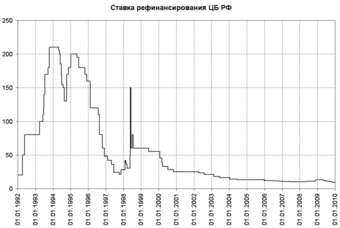
Discount rate
Discount rate set by Central Bank of Russia in 1992-2009.
Additional complexity arises when the cash flow changes sign several times (i.e., it contains outflows in the midst or at the end of the project lifetime). The modified payback period algorithm may be applied then. First, the sum of all of the cash outflows is calculated. Then the cumulative positive cash flows are determined for each period. The modified payback period is calculated as the moment in which the cumulative positive cash flow exceeds the total cash outflow.
Let’s take a look at one example. Year 0: -1000, year 1: 4000, year 2: -5000, year 3: 6000, year 4: -6000, year 5: 7000. The sum of all cash outflows = 1000 + 5000 + 6000 = 12000.
The modified payback period is in year 5, since the cumulative positive cash flows (17000) exceeds the total cash outflows (12000) in year 5. To be more detailed, the payback period would be: 4 + 2/7 = 4.29 year.
11.2.3: Discounted Payback
The payback method is more effective at accurately projecting payback periods when it is discounted to incorporate the time value of money.
Learning Objective
Apply the concept of time value of money to the payback method
Key Points
- The payback method simply projects incoming cash flows from a given project and identifies the break even point between profit and paying back invested money for a given process.
- However, the payback method does not take into account the time value of money. To do so, you simply need to discount the payback based upon a cost of capital or interest rate.
- Using the discounted cash flow analysis equation, it’s relatively simple to account for the time value of money when applied to payback periods.
Key Term
- payback method
-
A simple calculation that allows an assessment of the cost of a project via the time it will take to be repaid.
The Payback Method
The payback method is quite a simple concept. The majority of business projects (or even entire business plans for an organization) will require capital. When investing capital into a project, it will take a certain amount of time before the profits from the endeavor offset the capital requirements. Of course, if the project will never make enough profit to cover the start up costs, it is not an investment to pursue. In the simplest sense, the project with the shortest payback period is most likely the best of possible investments (lowest risk at any rate).
Time Value
Time is a commodity with cost from a financial point of view. For example, a project that costs $100,000 and pays back within 6 years is not as valuable as a project that costs $100,000 which pays back in 5years. Having the money sooner means more potential investment (and thus less opportunity cost). The shorter time scale project also would appear to have a higher profit rate in this situation, making it better for that reason as well.
If a payback method does not take into account the time value of money, the real net present value (NPV) of a given project is not being calculated. This is a significant strategic omission, particularly relevant in longer term initiatives. As a result, all corporate financial assessments should discount payback to weigh in the opportunity costs of capital being locked up in the project.
Discounted Payback
One way to do this is to discount projected cash flows into present dollars based upon the cost of capital. So a simple example of a payback period without time value of money (without discounted payback) would be as follows:
A project costs $10,000. It will return $2,000 each year in profit (after all expenses and taxes). This means that it’ll take a total of 5 years without a time value of money discount being applied. However, applying time value of money is a fairly simple process, and can be accomplished utilizing the discounted cash flow analysis equation:
For the sake of simplicity, let’s assume the cost of capital is 10% (as your one and only investor can turn 10% on this money elsewhere and it is their required rate of return). If this is the case, each cash flow would have to be $2,638 to break even within 5 years. At your expected $2,000 each year, it will take over 7 years for full pay back.
As you can see, discounting the payback period can have enormous impacts on profitability. Understanding and accounting for the time value of money is an important aspect of strategic thinking.
11.2.4: Advantages of the Payback Method
Payback period as a tool of analysis is easy to apply and easy to understand, yet effective in measuring investment risk.
Learning Objective
Describe the advantages of using the payback method
Key Points
- Payback period, as a tool of analysis, is often used because it is easy to apply and easy to understand for most individuals, regardless of academic training or field of endeavor.
- The payback period is an effective measure of investment risk. It is widely used when liquidity is an important criteria to choose a project.
- Payback period method is suitable for projects of small investments. It not worth spending much time and effort in sophisticated economic analysis in such projects.
Key Terms
- Opportunity cost
-
The cost of an opportunity forgone (and the loss of the benefits that could be received from that opportunity); the most valuable forgone alternative.
- cost of capital
-
the rate of return that capital could be expected to earn in an alternative investment of equivalent risk
- time value of money
-
The value of money, figuring in a given amount of interest, earned over a given amount of time.
Payback period in capital budgeting refers to the period of time required for the return on an investment to “repay” the sum of the original investment.
Payback period, as a tool of analysis, is often used because it is easy to apply and easy to understand for most individuals, regardless of academic training or field of endeavor. When used carefully or to compare similar investments, it can be quite useful. All else being equal, shorter payback periods are preferable to longer payback periods. As a stand-alone tool to compare an investment to “doing nothing,” payback period has no explicit criteria for decision-making (except, perhaps, that the payback period should be less than infinity).
The term is also widely used in other types of investment areas, often with respect to energy efficiency technologies, maintenance, upgrades, or other changes. For example, a compact fluorescent light bulb may be described as having a payback period of a certain number of years or operating hours, assuming certain costs. Here, the return to the investment consists of reduced operating costs. Although primarily a financial term, the concept of a payback period is occasionally extended to other uses, such as energy payback period (the period of time over which the energy savings of a project equal the amount of energy expended since project inception). These other terms may not be standardized or widely used.
The payback period is an effective measure of investment risk. The project with a shortest payback period has less risk than with the project with longer payback period. The payback period is often used when liquidity is an important criteria to choose a project .
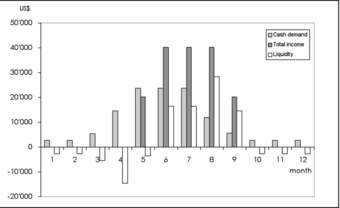
Monthly liquidity of an organic vegetable business
Cash demand is high from April to August. The business is more likely to use payback period to choose a project.
Payback period method is suitable for projects of small investments. It not worth spending much time and effort on sophisticated economic analysis in such projects.

Capital Investment in Plant and Property
The payback method is a simple way to evaluate the number of years or months it takes to return the initial investment.
11.2.5: Disadvantages of the Payback Method
Payback period analysis ignores the time value of money and the value of cash flows in future periods.
Learning Objective
Explain the disadvantages of the Payback Method
Key Points
- Payback ignores the time value of money.
- Payback ignores cash flows beyond the payback period, thereby ignoring the “profitability” of a project.
- To calculate a more exact payback period: Payback Period = Amount to be Invested/Estimated Annual Net Cash Flow.
Key Terms
- cost of capital
-
the rate of return that capital could be expected to earn in an alternative investment of equivalent risk
- return
-
Gain or loss from an investment.
- Opportunity cost
-
The cost of an opportunity forgone (and the loss of the benefits that could be received from that opportunity); the most valuable forgone alternative.
Disadvantages of the Payback Method
The payback period is considered a method of analysis with serious limitations and qualifications for its use, because it does not account for the time value of money, risk, financing, or other important considerations, such as the opportunity cost. While the time value of money can be rectified by applying a weighted average cost of capital discount, it is generally agreed that this tool for investment decisions should not be used in isolation. Alternative measures of “return” preferred by economists are net present value and internal rate of return. An implicit assumption in the use of payback period is that returns to the investment continue after the payback period. Payback period does not specify any required comparison to other investments or even to not making an investment.

Zhuhai sea front development
Payback is the amount of time it takes to return an initial investment; however, it does not account for the time value of money, risk, financing, or other important considerations, such as the opportunity cost.
Payback ignores the time value of money. For example, two projects are viewed as equally attractive if they have the same payback regardless of when the payback occurs. If both project require an initial investment of $300,000, but Project 1 has a payback of one year and Project two of three years, the projects are viewed equally, although Project 1 is more valuable because additional interest could be earned on the funds in year two and three.
Payback also ignores the cash flows beyond the payback period, thereby ignoring the profitability of the project. Thus, one project may be more valuable than another based on future cash flows, but the payback method does not capture this.
Additional complexity arises when the cash flow changes sign several times (i.e., it contains outflows in the midst or at the end of the project lifetime). The modified payback period algorithm may be applied then. First, the sum of all of the cash outflows is calculated. Then the cumulative positive cash flows are determined for each period. The modified payback period is calculated as the moment in which the cumulative positive cash flow exceeds the total cash outflow.
11.3: Internal Rate of Return
11.3.1: Defining the IRR
IRR is a rate of return used in capital budgeting to measure and compare the profitability of investments; the higher IRR, the more desirable the project.
Learning Objective
Explain how Internal Rate of Return is used in capital budgeting
Key Points
- The IRR of an investment is the discount rate at which the net present value of costs (negative cash flows) of the investment equals the net present value of the benefits (positive cash flows) of the investment.
- The higher a project’s IRR, the more desirable it is to undertake the project.
- A firm (or individual) should, in theory, undertake all projects or investments available with IRRs that exceed the cost of capital. Investment may be limited by availability of funds to the firm and/or by the firm’s capacity or ability to manage numerous projects.
Key Term
- effective interest rate
-
The effective interest rate, effective annual interest rate, annual equivalent rate (AER), or simply effective rate is the interest rate on a loan or financial product restated from the nominal interest rate as an interest rate with annual compound interest payable in arrears.
The internal rate of return (IRR) or economic rate of return (ERR) is a rate of return used in capital budgeting to measure and compare the profitability of investments. It is also called the “discounted cash flow rate of return” (DCFROR) or the rate of return (ROR). In the context of savings and loans the IRR is also called the “effective interest rate. ” The term “internal” refers to the fact that its calculation does not incorporate environmental factors (e.g., the interest rate or inflation).
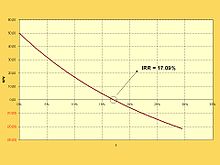
IRR
Showing the position of the IRR on the graph of NPV(r) (r is labelled ‘i’ in the graph).
The internal rate of return on an investment or project is the “annualized effective compounded return rate” or “rate of return” that makes the net present value (NPV as NET*1/(1+IRR)^year) of all cash flows (both positive and negative) from a particular investment equal to zero. In more specific terms, the IRR of an investment is the discount rate at which the net present value of costs (negative cash flows) of the investment equals the net present value of the benefits (positive cash flows) of the investment.
IRR calculations are commonly used to evaluate the desirability of investments or projects. The higher a project’s IRR, the more desirable it is to undertake the project. Assuming all projects require the same amount of up-front investment, the project with the highest IRR would be considered the best and undertaken first. A firm (or individual) should, in theory, undertake all projects or investments available with IRRs that exceed the cost of capital. Investment may be limited by availability of funds to the firm and/or by the firm’s capacity or ability to manage numerous projects.
11.3.2: Calculating the IRR
Given a collection of pairs (time, cash flow), a rate of return for which the net present value is zero is an internal rate of return.
Learning Objective
Calculate a project’s internal rate of return
Key Points
- Given the (period, cash flow) pairs (n, Cn) where n is a positive integer, the total number of periods N, and the net present value NPV, the internal rate of return is given by the function in which NPV = 0.
- Any fixed time can be used in place of the present (e.g., the end of one interval of an annuity); the value obtained is zero if and only if the NPV is zero.
- If the IRR is greater than the cost of capital, accept the project. If the IRR is less than the cost of capital, reject the project.
Key Terms
- cost of capital
-
the rate of return that capital could be expected to earn in an alternative investment of equivalent risk
- net present value profile
-
a graph of the sum of all cash inflows and outflows adjusted for the time value of money at different discount rates
Given a collection of pairs (time, cash flow) involved in a project, the internal rate of return follows from the net present value as a function of the rate of return. A rate of return for which this function is zero is an internal rate of return.
Given the (period, cash flow) pairs (n, Cn) where n is a positive integer, the total number of periods N, and the net present value NPV, the internal rate of return is given by r in:

Calculating IRR
NPV formula with r as IRR
The period is usually given in years, but the calculation may be made simpler if r is calculated using the period in which the majority of the problem is defined (e.g., using months if most of the cash flows occur at monthly intervals) and converted to a yearly period thereafter. Any fixed time can be used in place of the present (e.g., the end of one interval of an annuity); the value obtained is zero if and only if the NPV is zero.
For example, if an investment may be given by the sequence of cash flows:
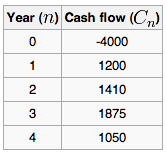
Calculating IRR
Cash flows and time
Because the internal rate of return on an investment or project is the “annualized effective compounded return rate” or “rate of return” that makes the net present value of all cash flows (both positive and negative) from a particular investment equal to zero, then the IRR r is given by the formula:

Calculating IRR
IRR is the rate at which NPV = 0.
In this case, the answer is 14.3%. If the IRR is greater than the cost of capital, accept the project. If the IRR is less than the cost of capital, reject the project.
11.3.3: Advantages of the IRR Method
The IRR method is easily understood, it recognizes the time value of money, and compared to the NPV method is an indicator of efficiency.
Learning Objective
Describe the advantages of using the internal rate of return over other types of capital budgeting methods
Key Points
- The IRR method is very clear and easy to understand. An investment is considered acceptable if its internal rate of return is greater than an established minimum acceptable rate of return or cost of capital.
- The IRR method also uses cash flows and recognizes the time value of money.
- The internal rate of return is a rate quantity, an indicator of the efficiency, quality, or yield of an investment.
Key Terms
- capital budgeting
-
The budgeting process in which a company plans its capital expenditure (the spending on assets of long-term value).
- cost of capital
-
the rate of return that capital could be expected to earn in an alternative investment of equivalent risk
The internal rate of return (IRR) or economic rate of return (ERR) is a rate of return used in capital budgeting to measure and compare the profitability of investment. IRR calculations are commonly used to evaluate the desirability of investments or projects. The higher a project’s IRR, the more desirable it is to undertake the project.
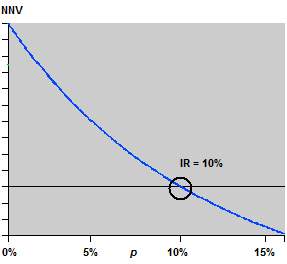
Internal rate of return
Internal rate of return is the rate at which the NPV of an investment equals 0.
One advantage of the IRR method is that it is very clear and easy to understand. Assuming all projects require the same amount of up-front investment, the project with the highest IRR would be considered the best and undertaken first. A firm (or individual) should, in theory, undertake all projects or investments available with IRRs that exceed the cost of capital. In other words, an investment is considered acceptable if its internal rate of return is greater than an established minimum acceptable rate of return or cost of capital. Most analysts and financial managers can understand the opportunity costs of a company. If the IRR exceeds this rate, then the project provides financial accretion. However, if the rate of an investment is projected to be below the IRR, then the investment would destroy company value. IRR is used in many company financial profiles due its clarity for all parties.
The IRR method also uses cash flows and recognizes the time value of money. Compared to payback period method, IRR takes into account the time value of money. This is because the IRR method expects high interest rate from investments.
In addition, the internal rate of return is a rate quantity, it is an indicator of the efficiency, quality, or yield of an investment. This is in contrast with the net present value, which is an indicator of the value or magnitude of an investment.
11.3.4: Disadvantages of the IRR Method
IRR can’t be used for exclusive projects or those of different durations; IRR may overstate the rate of return.
Learning Objective
Describe the disadvantages of using IRR for capital budging purposes
Key Points
- The first disadvantage of IRR method is that IRR, as an investment decision tool, should not be used to rate mutually exclusive projects, but only to decide whether a single project is worth investing in.
- IRR overstates the annual equivalent rate of return for a project whose interim cash flows are reinvested at a rate lower than the calculated IRR.
- IRR does not consider cost of capital; it should not be used to compare projects of different duration.
- In the case of positive cash flows followed by negative ones and then by positive ones, the IRR may have multiple values.
Key Terms
- mutually exclusive
-
Describing multiple events or states of being such that the occurrence of any one implies the non-occurrence of all the others.
- duration
-
A measure of the sensitivity of the price of a financial asset to changes in interest rates, computed for a simple bond as a weighted average of the maturities of the interest and principal payments associated with it
The first disadvantage of the IRR method is that IRR, as an investment decision tool, should not be used to rate mutually exclusive projects but only to decide whether a single project is worth investing in. In cases where one project has a higher initial investment than a second mutually exclusive project, the first project may have a lower IRR (expected return), but a higher NPV (increase in shareholders’ wealth) and should thus be accepted over the second project (assuming no capital constraints).
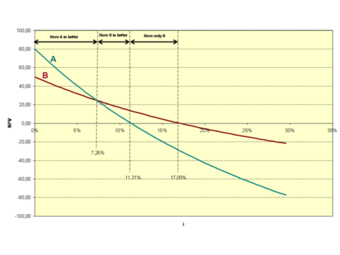
Disadvantage of IRR
NPV vs discount rate comparison for two mutually exclusive projects. Project A has a higher NPV (for certain discount rates), even though its IRR (= x-axis intercept) is lower than for project B
In addition, IRR assumes reinvestment of interim cash flows in projects with equal rates of return (the reinvestment can be the same project or a different project). Therefore, IRR overstates the annual equivalent rate of return for a project whose interim cash flows are reinvested at a rate lower than the calculated IRR. This presents a problem, especially for high IRR projects, since there is frequently not another project available in the interim that can earn the same rate of return as the first project. When the calculated IRR is higher than the true reinvestment rate for interim cash flows, the measure will overestimate–sometimes very significantly–the annual equivalent return from the project. The formula assumes that the company has additional projects, with equally attractive prospects, in which to invest the interim cash flows.
Moreover, since IRR does not consider cost of capital, it should not be used to compare projects of different duration. Modified Internal Rate of Return (MIRR) does consider cost of capital and provides a better indication of a project’s efficiency in contributing to the firm’s discounted cash flow.
Last but not least, in the case of positive cash flows followed by negative ones and then by positive ones, the IRR may have multiple values.
11.3.5: Multiple IRRs
When cash flows of a project change sign more than once, there will be multiple IRRs; in these cases NPV is the preferred measure.
Learning Objective
Explain the best way to evaluate a project that has multiple internal rates of return
Key Points
- In the case of positive cash flows followed by negative ones and then by positive ones, the IRR may have multiple values.
- It has been shown that with multiple internal rates of return, the IRR approach can still be interpreted in a way that is consistent with the present value approach provided that the underlying investment stream is correctly identified as net investment or net borrowing.
- NPV remains the “more accurate” reflection of value to the business. IRR, as a measure of investment efficiency may give better insights in capital constrained situations. However, when comparing mutually exclusive projects, NPV is the appropriate measure.
Key Terms
- Modified Internal Rate of Return
-
The modified internal rate of return (MIRR) is a financial measure of an investment’s attractiveness. It is used in capital budgeting to rank alternative investments of equal size. As the name implies, MIRR is a modification of the internal rate of return (IRR) and, as such, aims to resolve some problems with the IRR.
- mutually exclusive
-
Describing multiple events or states of being such that the occurrence of any one implies the non-occurrence of all the others.
In the case of positive cash flows followed by negative ones and then by positive ones, the IRR may have multiple values. In this case a discount rate may be used for the borrowing cash flow and the IRR calculated for the investment cash flow. This applies for example when a customer makes a deposit before a specific machine is built.
In a series of cash flows like (−10, 21, −11), one initially invests money, so a high rate of return is best, but then receives more than one possesses, so then one owes money, so now a low rate of return is best. In this case it is not even clear whether a high or a low IRR is better. There may even be multiple IRRs for a single project, like in the above example 0% as well as 10%. Examples of this type of project are strip mines and nuclear power plants, where there is usually a large cash outflow at the end of the project.
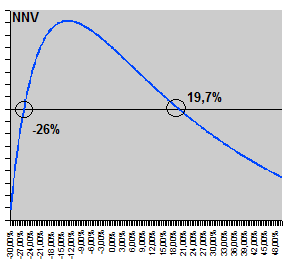
Multiple internal rates of return
As cash flows of a project change sign more than once, there will be multiple IRRs. NPV is a preferable metric in these cases.
When a project has multiple IRRs, it may be more convenient to compute the IRR of the project with the benefits reinvested. Accordingly, Modified Internal Rate of Return (MIRR) is used, which has an assumed reinvestment rate, usually equal to the project’s cost of capital.
It has been shown that with multiple internal rates of return, the IRR approach can still be interpreted in a way that is consistent with the present value approach provided that the underlying investment stream is correctly identified as net investment or net borrowing.
Despite a strong academic preference for NPV, surveys indicate that executives prefer IRR over NPV. Apparently, managers find it easier to compare investments of different sizes in terms of percentage rates of return than by dollars of NPV. However, NPV remains the “more accurate” reflection of value to the business. IRR, as a measure of investment efficiency may give better insights in capital constrained situations. However, when comparing mutually exclusive projects, NPV is the appropriate measure.
11.3.6: Modified IRR
The MIRR is a financial measure of an investment’s attractiveness; it is used to rank alternative investments of equal size.
Learning Objective
Calculate a project’s modified internal rate of return
Key Points
- MIRR is a modification of the internal rate of return (IRR) and as such aims to resolve some problems with the IRR.
- More than one IRR can be found for projects with alternating positive and negative cash flows, which leads to confusion and ambiguity. MIRR finds only one value.
- MIRR = {[FV(positive cash flows, reinvestment rate)/-PV(negative cash flows, finance rate)]^(1/n)}-1.
Key Terms
- cost of capital
-
the rate of return that capital could be expected to earn in an alternative investment of equivalent risk
- reinvestment rate
-
The annual yield at which cash flows from an investment can be reinvested.
The modified internal rate of return (MIRR) is a financial measure of an investment’s attractiveness. It is used in capital budgeting to rank alternative investments of equal size. As the name implies, MIRR is a modification of the internal rate of return (IRR) and as such aims to resolve some problems with the IRR.
While there are several problems with the IRR, MIRR resolves two of them. Firstly, IRR assumes that interim positive cash flows are reinvested at the same rate of return as that of the project that generated them. This is usually an unrealistic scenario and a more likely situation is that the funds will be reinvested at a rate closer to the firm’s cost of capital. The IRR therefore often gives an unduly optimistic picture of the projects under study. Generally, for comparing projects more fairly, the weighted average cost of capital should be used for reinvesting the interim cash flows. Secondly, more than one IRR can be found for projects with alternating positive and negative cash flows, which leads to confusion and ambiguity. MIRR finds only one value.
MIRR is calculated as follows:

MIRR
The formula for calculating MIRR.
Where n is the number of equal periods at the end of which the cash flows occur (not the number of cash flows), PV is present value (at the beginning of the first period), and FV is future value (at the end of the last period).
The formula adds up the negative cash flows after discounting them to time zero using the external cost of capital, adds up the positive cash flows including the proceeds of reinvestment at the external reinvestment rate to the final period, and then works out what rate of return would cause the magnitude of the discounted negative cash flows at time zero to be equivalent to the future value of the positive cash flows at the final time period.
Let take a look at one example. If an investment project is described by the sequence of cash flows: Year 0: -1000, year 1: -4000, year 2: 5000, year 3: 2000. Then the IRR is given by: NPV = -1000 – 4000 * (1+r)-1 + 5000*(1+r)-2 + 2000*(1+r)-3 = 0. IRR can be 25.48%, -593.16% or -132.32%.
To calculate the MIRR, we will assume a finance rate of 10% and a reinvestment rate of 12%. First, we calculate the present value of the negative cash flows (discounted at the finance rate): PV(negative cash flows, finance rate) = -1000 – 4000 *(1+10%)-1 = -4636.36.
Second, we calculate the future value of the positive cash flows (reinvested at the reinvestment rate): FV (positive cash flows, reinvestment rate) = 5000*(1+12%) +2000 = 7600.
Third, we find the MIRR: MIRR = (7600/4636.36)(1/3) – 1 = 17.91%.
11.4: Net Present Value
11.4.1: Defining NPV
Net Present Value (NPV) is the sum of the present values of the cash inflows and outflows.
Learning Objective
Define Net Present Value
Key Points
- Because of the time value of money, cash inflows and outflows only can be compared at the same point in time.
- NPV discounts each inflow and outflow to the present, and then sums them to see how the value of the inflows compares to the other.
- A positive NPV means the investment is worthwhile, an NPV of 0 means the inflows equal the outflows, and a negative NPV means the investment is not good for the investor.
Key Terms
- cash outflow
-
Any cash that is spent or invested by the investor.
- cash inflow
-
Cash that is received by the investor. For example, dividends paid on a stock owned by the investor is a cash inflow.
Every investment includes cash outflows and cash inflows. There is the cash that is required to make the investment and (hopefully) the return.
In order to see whether the cash outflows are less than the cash inflows (i.e., the investment earns a positive return), the investor aggregates the cash flows. Since cash flows occur over a period of time, the investor knows that due to the time value of money, each cash flow has a certain value today . Thus, in order to sum the cash inflows and outflows, each cash flow must be discounted to a common point in time.

Airplane
Before purchasing a new airplane, airlines evaluate the NPV of the plan by calculating the PV of the revenue it can earn from it and the PV of its cost (e.g., purchase cost, maintenance, fuel, etc. ).
The net present value (NPV) is simply the sum of the present values (PVs) and all the outflows and inflows:
NPV = PVInflows+ PVOutflows
Don’t forget that inflows and outflows have opposite signs; outflows are negative.
Also recall that PV is found by the formula
where FV is the future value (size of each cash flow), i is the discount rate, and t is the number of periods between the present and future. The PV of multiple cash flows is simply the sum of the PVs for each cash flow.
The sign of NPV can explain a lot about whether the investment is good or not:
- NPV > 0: The PV of the inflows is greater than the PV of the outflows. The money earned on the investment is worth more today than the costs, therefore, it is a good investment.
- NPV = 0: The PV of the inflows is equal to the PV of the outflows. There is no difference in value between the value of the money earned and the money invested.
- NPV < 0: The PV of the inflows is less than the PV of the outflows. The money earned on the investment is worth less today than the costs, therefore, it is a bad investment.
11.4.2: Calculating the NPV
The NPV is found by summing the present values of each individual cash flow.
Learning Objective
Calculate a project’s Net Present Value.
Key Points
- Cash inflows have a positive sign, while cash outflows are negative.
- To find the NPV accurately, the investor must know the exact size and time of occurrence of each cash flow. This is easy to find for some investments (like bonds), but more difficult for others (like industrial machinery).
- Investors use different rates for their discount rate such as using the weighted average cost of capital, variable rates, and reinvestment rate.
Key Terms
- cash flow
-
The sum of cash revenues and expenditures over a period of time.
- variable
-
something whose value may be dictated or discovered.
- discount rate
-
The interest rate used to discount future cash flows of a financial instrument; the annual interest rate used to decrease the amounts of future cash flow to yield their present value.
Calculating the NPV
The NPV of an investment is calculated by adding the PVs (present values) of all of the cash inflows and outflows . Cash inflows (such as coupon payments or the repayment of principal on a bond) have a positive sign while cash outflows (such as the money used to purchase the investment) have a negative sign.

Net Present Value (NPV) Formula
NPV is the sum of of the present values of all cash flows associated with a project. The business will receive regular payments, represented by variable R, for a period of time. This period of time is expressed in variable t. The payments are discounted using a selected interest rate, signified by the i variable.
The accurate calculation of NPV relies on knowing the amount of each cash flow and when each will occur. For securities like bonds, this is an easy requirement to meet. The bond clearly states when each coupon payment will occur, the size of each payment, when the principal will be repaid, and the cost of the bond. For other investments, this is not so simple to determine. When a new piece of machinery is purchased, for example, the investor (the purchasing company) has to estimate the size and occurrence of maintenance costs as well as the size and occurrence of the revenues generated by the machine.
The other integral input variable for calculating NPV is the discount rate. There are many methods for calculating the appropriate discount rate. A firm’s weighted average cost of capital after tax (WACC) is often used. Since many people believe that it is appropriate to use higher discount rates to adjust for risk or other factors, they may choose to use a variable discount rate.
Another approach to selecting the discount rate factor is to decide the rate that the capital needed for the project could return if invested in an alternative venture. If, for example, the capital required for Project A can earn 5% elsewhere, use this discount rate in the NPV calculation to allow a direct comparison to be made between Project A and the alternative. Related to this concept is to use the firm’s reinvestment rate. Reinvestment rate can be defined as the rate of return for the firm’s investments on average, which can also be used as the discount rate.
11.4.3: Interpreting the NPV
A positive NPV means the investment makes sense financially, while the opposite is true for a negative NPV.
Learning Objective
Interpret a series of net present value calculations
Key Points
- When inflows exceed outflows and they are discounted to the present, the NPV is positive. The investment adds value for the investor. The opposite is true when NPV is negative.
- A NPV of 0 means there is no change in value from the investment.
- In theory, investors should invest when the NPV is positive and it has the highest NPV of all available investment options.
- In practice, determining NPV depends on being able to accurately determine the inputs, which is difficult.
Key Term
- cash flow
-
The sum of cash revenues and expenditures over a period of time.
The NPV is a metric that is able to determine whether or not an investment opportunity is a smart financial decision. NPV is the present value (PV) of all the cash flows (with inflows being positive cash flows and outflows being negative), which means that the NPV can be considered a formula for revenues minus costs. If NPV is positive, that means that the value of the revenues (cash inflows) is greater than the costs (cash outflows). When revenues are greater than costs, the investor makes a profit. The opposite is true when the NPV is negative. When the NPV is 0, there is no gain or loss.
In theory, an investor should make any investment with a positive NPV, which means the investment is making money. Similarly, an investor should refuse any option that has a negative NPV because it only subtracts from the value. When faced with multiple investment choices, the investor should always choose the option with the highest NPV. This is only true if the option with the highest NPV is not negative. If all the investment options have negative NPVs, none should be undertaken.
The decision is rarely that cut and dry, however. The NPV is only as good as the inputs. The NPV depends on knowing the discount rate, when each cash flow will occur, and the size of each flow. Cash flows may not be guaranteed in size or when they occur, and the discount rate may be hard to determine. Any inaccuracies and the NPV will be affected, too .

Machinery
Being able to accurately find the NPV of a piece of machinery means having a good idea when all costs are going to occur (when it will need fixing) and when it will generate revenue (when it will be used on a job).
11.4.4: Advantages of the NPV method
NPV is easy to use, easily comparable, and customizable.
Learning Objective
Describe the advantages of using net present value to evaluate potential investments
Key Points
- When NPV is positive, it adds value to the firm. When it is negative, it subtracts value. An investor should never undertake a negative NPV project.
- As long as all options are discounted to the same point in time, NPV allows for easy comparison between investment options. The investor should undertake the investment with the highest NPV, provided it is possible.
- An advantage of NPV is that the discount rate can be customized to reflect a number of factors, such as risk in the market.
Key Term
- gain (or loss)
-
If an investment earns more value than it costs, the difference is the gain. If it costs more than it earns, the difference is a loss.
Calculating the NPV is a way investors determine how attractive a potential investment is. Since it essentially determines the present value of the gain or loss of an investment, it is easy to understand and is a great decision making tool.
When NPV is positive, the investment is worthwhile; On the other hand, when it is negative, it should not be undertaken; and when it is 0, there is no difference in the present values of the cash outflows and inflows. In theory, an investor should undertake positive NPV investments, and never undertake negative NPV investments . Thus, NPV makes the decision making process relatively straight forward.

NPV Decision Table
NPV simply and clearly shows whether a project adds value to the firm or not. It’s easy of use in decision making is one of its advantages.
Another advantage of the NPV method is that it allows for easy comparisons of potential investments. As long as the NPV of all options are taken at the same point in time, the investor can compare the magnitude of each option. When presented with the NPVs of multiple options, the investor will simply choose the option with the highest NPV because it will provide the most additional value for the firm. However, if none of the options has a positive NPV, the investor will not choose any of them; none of the investments will add value to the firm, so the firm is better off not investing.
Furthermore, NPV is customizable so that it accurately reflects the financial concerns and demands of the firm. For example, the discount rate can be adjusted to reflect things such as risk, opportunity cost, and changing yield curve premiums on long-term debt.
11.4.5: Disadvantages of the NPV method
NPV is hard to estimate accurately, does not fully account for opportunity cost, and does not give a complete picture of an investment’s gain or loss.
Learning Objective
Discuss the disadvantages of using the NPV method
Key Points
- NPV is based on future cash flows and the discount rate, both of which are hard to estimate with 100% accuracy.
- There is an opportunity cost to making an investment which is not built into the NPV calculation.
- Other metrics, such as internal rate of return, are needed to fully determine the gain or loss of an investment.
Key Term
- Opportunity cost
-
The cost of an opportunity forgone (and the loss of the benefits that could be received from that opportunity); the most valuable forgone alternative.
There are a number of disadvantages to NPV. NPV is still commonly used, but firms will also use other metrics before making investment decisions.
The first disadvantage is that NPV is only as accurate as the inputted information. It requires that the investor know the exact discount rate, the size of each cash flow, and when each cash flow will occur. Often, this is impossible to determine. For example, when developing a new product, such as a new medicine, the NPV is based on estimates of costs and revenues . The cost of developing the drug is unknown and the revenues from the sale of the drug can be hard to estimate, especially many years in the future.

Medicine
Drug developers must try to calculate the future revenues of a drug in order to find the NPV to determine if it is worth the cost of development.
Furthermore, the NPV is only useful for comparing projects at the same time; it does not fully build in opportunity cost. For example, the day after the company makes a decision about which investment to undertake based on NPV, it may discover there is a new option that offers a superior NPV. Thus, investors don’t simply pick the option with the highest NPV; they may pass on all options because they think another, better, option may come along in the future. NPV does not build in the opportunity cost of not having the capital to spend on future investment options.
Another issue with relying on NPV is that it does not provide an overall picture of the gain or loss of executing a certain project. To see a percentage gain relative to the investments for the project, internal rate of return (IRR) or other efficiency measures are used as a complement to NPV.
11.4.6: NPV Profiles
The NPV Profile graphs the relationship between NPV and discount rates.
Learning Objective
Describe the relationship between a project’s discount rate and its Net Present Value
Key Points
- The NPV Profile is a graph with the discount rate on the x-axis and the NPV of the investment on the y-axis.
- Higher discount rates mean cash flows that occur sooner are more influential to NPV. Since the earlier payments tend to be the outflows, the NPV profile generally shows an inverse relationship between the discount rate and NPV.
- The discount rate at which the NPV equals 0 is called the internal rate of return (IRR).
Key Terms
- discount rate
-
The interest rate used to discount future cash flows of a financial instrument; the annual interest rate used to decrease the amounts of future cash flow to yield their present value.
- internal rate of return
-
IRR. The rate of return on an investment which causes the net present value of all future cash flows to be zero.
NPV Profiles
The NPV calculation involves discounting all cash flows to the present based on an assumed discount rate. When the discount rate is large, there are larger differences between PV and FV (present and future value) for each cash flow than when the discount rate is small. Thus, when discount rates are large, cash flows further in the future affect NPV less than when the rates are small. Conversely, a low discount rate means that NPV is affected more by the cash flows that occur further in the future.
The relationship between NPV and the discount rate used is calculated in a chart called an NPV Profile . The independent variable is the discount rate and the dependent is the NPV. The NPV Profile assumes that all cash flows are discounted at the same rate.
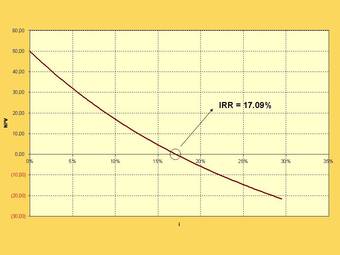
NPV Profile
The NPV Profile graphs how NPV changes as the discount rate used changes.
The NPV profile usually shows an inverse relationship between the discount rate and the NPV. While this is not necessarily true for all investments, it can happen because outflows generally occur before the inflows. A higher discount rate places more emphasis on earlier cash flows, which are generally the outflows. When the value of the outflows is greater than the inflows, the NPV is negative.
A special discount rate is highlighted in the IRR, which stands for Internal Rate of Return. It is the discount rate at which the NPV is equal to zero. And it is the discount rate at which the value of the cash inflows equals the value of the cash outflows.
11.5: Cash Flow Analysis and Other Factors
11.5.1: Cash Flow Factors
Cash flow factors are the operational, financial, or investment activities which cause cash to enter or leave the organization.
Learning Objective
Describe how cash flow factors can be used to improve or evaluate a business
Key Points
- Cash flow factors can be used to calculate parameters to measure organizational performance.
- Operational cash flows are those originating from the organization’s internal business.
- Financing cash flows are those originating from the issuance of debt or equity.
- Investment cash flows are those originating from assets and capital expenditures.
Key Terms
- liquidity
-
Availability of cash over short term: ability to service short-term debt.
- parameter
-
A variable kept constant during an experiment, calculation, or similar.
Definition
Cash flow is the movement of money into or out of a business, project, or financial product . It is usually measured during a specified, finite period of time. Measurement of cash flow can be used for calculating other parameters that give information on a company’s value and situation.

Cash
Cash flows reflect cash entering or leaving the organization.
Statement of Cash Flow in a Business’s Financial Statements
A business’s Statement of Cash Flows illustrates its calculated net cash flow. The net cash flow of a company over a period (typically a quarter or a full year) is equal to the change in cash balance over this period: It’s positive if the cash balance increases (more cash becomes available); it’s negative if the cash balance decreases. The total net cash flow is composed of several factors:
- Operational cash flows: Cash received or expended as a result of the company’s internal business activities. This includes cash earnings plus changes to working capital. Over the medium term, this must be net positive if the company is to remain solvent.
- Investment cash flows: Cash received from the sale of long-life assets or spent on capital expenditure, such as, investments, acquisitions, and long-life assets.
- Financing cash flows: Cash received from the issue of debt and equity, or paid out as dividends, share repurchases or debt repayments.
Uses
Cash flow factors can be used for calculating parameters, such as:
- to determine a project’s rate of return or value. The cash flows into and out of projects are used as inputs in financial models, such as internal rate of return and net present value.
- to determine problems with a business’s liquidity. Being profitable does not necessarily mean being liquid. A company can fail because of a shortage of cash even while profitable.
- as an alternative measure of a business’s profits when it is believed that accrual accounting concepts do not represent economic realities. For example, a company may be notionally profitable but generating little operational cash (as may be the case for a company that barters its products rather than selling for cash). In such a case, the company may be deriving additional operating cash by issuing shares or raising additional debt finance.
- can be used to evaluate the “quality” of income generated by accrual accounting. When net income is composed of large non-cash items, it is considered low quality.
- to evaluate the risks within a financial product (e.g., matching cash requirements, evaluating default risk, re-investment requirements, etc)
Cash flow is a generic term used differently depending on the context. It may be defined by users for their own purposes. It can refer to actual past flows or projected future flows. It can refer to the total of all flows involved or a subset of those flows.
11.5.2: Replacement Projects
A replacement project is an undertaking in which the company eliminates a project at the end of its life and substitutes another investment.
Learning Objective
Analyze a possible replacement projects to determine if it should be implemented
Key Points
- The cash flow analysis must take all cash flow components into account, such as opportunity costs and depreciation and maintenance expense.
- The replacement project’s cash flows are the additional inflows and outflows to be provided by the prospective replacement project.
- The comparison between the replacement and the current project informs the decision whether to undertake the replacement and, if applicable, at what point replacement should occur.
Key Terms
- capital budgeting
-
The budgeting process in which a company plans its capital expenditure (the spending on assets of long-term value).
- sunk cost
-
A cost that has already been incurred and which cannot be recovered to any significant degree.
- Opportunity cost
-
The cost of an opportunity forgone (and the loss of the benefits that could be received from that opportunity); the most valuable forgone alternative.
Definition
The possibility of replacement projects must be taken into account during the process of capital budgeting and subsequent project management. A replacement project is an undertaking in which the company eliminates a project at the end of its life and substitutes another investment. This replacement project can serve the purpose of replacing an expiring investment with a new, identical one, or replacing an existing investment that is producing unfavorable results with one that management believes will perform better.
When analyzing a project, and ultimately deciding whether it is a good investment decision or not, one focuses on the expected cash flows associated with the project. These cash flows form the basis for the project’s value, usually after implementing a method of discounted cash flow analysis. Most projects have a finite useful life. Analysis can be undertaken in order to determine when the optimum point of replacement will be, as well as if replacement is a viable option in the first place. To accomplish this, one analyzes the cash flows of the current project in relation to the expected cash flows from the replacement project .

Replacing a window sill vs. keeping the old one
Replacement project analysis tells a company whether the costs of a replacement project provide a suitable return on investment.
Analysis
The net cash flows for a project take into account revenues and costs generated by the project, along with more indirect implications, such as sunk costs, opportunity costs and depreciation costs related to the project. All of these considerations taken together allow management to consider the project’s incremental cash flows, which are inflows and outflows the project produces over predictable periods of time. Discounted cash flow analysis should be undertaken for both the existing project and the potential replacement project. These analyses can then be used to compare the expected profitability of both projects; which will, in theory, lead management to make the right decision regarding the investments.
In general, there will be some sort of cash inflow from ending the old project — for example, from the terminal value realized upon the sale of existing equipment — and a subsequent cash outflow to begin the new project. The loss of expected future cash flows from the previous project, or opportunity cost, must also be taken into account. A general form that can be used to analyze these cash flows is:
Increase in Net Income + (Depreciation on New Investment – Depreciation on Old Investment)
11.5.3: Sunk Costs
Sunk costs are retrospective costs that cannot be recovered, and are therefore irrelevant to future investment decisions in the project which incurs them.
Learning Objective
Identify sunk costs when making an investment decision
Key Points
- Only prospective costs should impact an investment decision. Therefore, sunk costs are not to be considered when deciding whether to undertake a project.
- A sunk cost is distinct from an economic loss. A loss may be caused by a sunk cost, however.
- Sunk costs are irrecoverable.
Key Term
- retrospective
-
Affecting or influencing past things; retroactive.
Definition
Sunk costs are retrospective costs that have already been incurred and cannot be recovered. Sunk costs are sometimes contrasted with prospective costs, which are future costs that may be incurred or changed if an action is taken .

Sunk
Sunk costs are irrecoverable.
Impact on Investment Decision
The idea of sunk costs is often employed when analyzing business decisions. In traditional microeconomic theory, only prospective (future) costs are relevant to an investment decision. For example the research and development of a pharmaceutical are retrospective once it is time to market the product. Once spent, such costs are sunk and should have no effect on future pricing decisions. The company will charge market prices whether R&D had cost one dollar or one million dollars. Therefore, the costs of R&D are considered sunk once they are retrospective and irrecoverable. At that point, they have no rational bearing on further investment decisions.
Difference from Economic Loss
The sunk cost is distinct from economic loss. For example, when a car is purchased, it can subsequently be resold; however, it will probably not be resold for the original purchase price. The economic loss is the difference between these values (including transaction costs). The sum originally paid should not affect any rational future decision-making about the car, regardless of the resale value. If the owner can derive more value from selling the car than not selling it, then it should be sold, regardless of the price paid. In this sense, the sunk cost is not a precise quantity, but an economic term for a sum paid in the past, which is no longer relevant to decisions about the future. The sunk cost may be used to refer to the original cost or the expected economic loss. It may also be used as shorthand for an error in analysis due to the sunk cost fallacy, irrational decision-making or, most simply, as irrelevant data.
11.5.4: Opportunity Costs
Opportunity cost refers to the value lost when a choice is made between two mutually exclusive options.
Learning Objective
Identify opportunity costs when making an economic choice
Key Points
- Opportunity cost can be seen as the second-best choice available to an economic actor.
- Opportunity cost can be measured monetarily, or more subjectively in terms of pleasure or utility.
- Opportunity cost shows not only that resources are scarce, but also that economic choices are limited.
Key Terms
- implicit costs
-
The opportunity cost equal to what a firm must give up in order to use factors which it neither purchases nor hires.
- explicit costs
-
a direct payment made to others in the course of running a business, such as wage, rent and materials
Definition
Opportunity cost is the cost of any activity measured in terms of the value of the next best alternative forgone (that is not chosen). In other words, it is the sacrifice of the second best choice available to someone, or group, who has picked among several mutually exclusive choices. .

Alternative choices
Choosing one alternative means another is foregone.
Economic Concept
Opportunity cost is a key concept in economics; it relates the scarcity of resources to the mutually exclusive nature of choice. The notion of opportunity cost plays a crucial role in ensuring that scarce resources are allocated efficiently. Thus, opportunity costs are not restricted to monetary or financial costs: the real cost of output forgone, lost time, pleasure or any other benefit that provides utility are also considered implicit. or opportunity, costs. In the context of cash flow analysis, opportunity cost can be thought of as a cash flow that could be generated from assets the organization already owns, if they are not used for the project in question. There is always a trade-off between making decisions on the allocation of assets.
Assessing Opportunity Cost
Opportunity cost is assessed not only in monetary or material terms, but also in terms of anything which is of value to the decision maker. For example, a person who desires to watch each of two television programs being broadcast simultaneously, and cannot record one, can only watch one of the desired programs. Therefore, the opportunity cost of watching an NFL football game could be not enjoying the college football game, or vice versa.
Examples
In a restaurant situation, the opportunity cost of eating steak could be trying the salmon. The opportunity cost of ordering both meals could be twofold: the extra $20 to buy the second meal, and reputation with peers, as the diner may be thought of as greedy or extravagant for ordering two meals. A family might decide to use a short period of vacation time to visit Disneyland rather than doing household improvement work. The opportunity cost of having happier children could therefore be a remodeled bathroom.
In a job situation, a person could either choose to run their own bakery, or work as an employee for a restaurant. There are explicit costs on the line, such as the capital necessary to start a business, purchase of all the inputs, and so forth. However, there are possible implicit benefits, such as autonomy and freedom to be “your own boss”, and implicit costs, such as the stress of running your own business. If the individual chooses to run their own bakery, their opportunity costs are the salary that the restaurant would have paid, and the smaller burden of responsibility as an employee instead of an owner.
11.5.5: Externalities
An externality is an effect of an economic action, the cost or benefit of which is shouldered by someone outside the transaction.
Learning Objective
Explain how externalities can affect different parties to a transaction
Key Points
- An externality that is a cost is a negative externality, while one that is a benefit is a positive externality.
- Prices do not reflect externalities because they affect people outside the economic transaction.
- Negative externalities can lead to over-production, while positive externalities can lead to under-production. The former case occurs because the producer does not pay the external cost, while the latter occurs because the benefit is generated without profit.
Key Term
- benefit
-
An advantage, help, or aid from something.
Definition
In economics, an externality is a cost or benefit that is not transmitted through prices and is incurred by a party who was not involved as either a buyer or seller of the goods or services. The cost of an externality is a negative externality , or external cost, while the benefit of an externality is a positive externality, or external benefit.

Pollution
Pollution is an example of a negative externality.
Relation to Prices
In the case of both negative and positive externalities, prices in a competitive market do not reflect the full costs or benefits of producing or consuming a product or service. Producers and consumers may neither bear all of the costs nor reap all of the benefits of the economic activity.
Over- and Under-Production
Standard economic theory states that any voluntary exchange is mutually beneficial to both parties involved in the trade. This is because buyers or sellers would not trade if either thought it was not beneficial.
However, an exchange can cause additional effects on third parties. Those who suffer from external costs do so involuntarily, while those who enjoy external benefits do so at no cost. A voluntary exchange may reduce total economic benefit if external costs exist. The person who is affected by the negative externalities in the case of air pollution will see it as lowered utility: either subjective displeasure or potentially explicit costs, such as higher medical expenses.
On the other hand, a positive externality would increase the utility of third parties at no cost to them. Since collective societal welfare is improved, but the providers have no way of monetizing the benefit, less of the good will be produced than would be optimal for society as a whole.
For example, manufacturing that causes air pollution imposes costs on the whole society, while public education is a benefit to the whole society. If there exist external costs such as pollution, the good will be overproduced by a competitive market, as the producer does not take into account the external costs when producing the good.
If there are external benefits, such as in areas of education, too little of the good would be produced by private markets as producers and buyers do not take into account the external benefits to others. Here, overall cost and benefit to society is defined as the sum of the economic benefits and costs for all parties involved.
“Free Rider” Problem
Positive externalities are often associated with the free rider problem. For example, individuals who are vaccinated reduce the risk of contracting the relevant disease for all others around them, and at high levels of vaccination, society may receive large health and welfare benefits. Conversely, any one individual can refuse vaccination, still avoiding the disease by “free riding” on the costs borne by others.
Market Correction
The market-driven approach to correcting externalities is to “internalize” third-party costs and benefits, for example, by requiring a polluter to repair any damage that they cause. But in many cases internalizing costs or benefits is not feasible, especially if the true monetary values cannot be determined.
11.5.6: Tax Rate
The tax rate is the amount of tax expressed as a percentage.
Learning Objective
Differentiate the different types of tax rates
Key Points
- The methods used to present a tax rate include: statutory, average, marginal, and effective rates.
- Statutory tax rates are those imposed by law.
- Average tax rate is the total tax liability divided by taxable income.
- Marginal tax rate is the rate at a specific level of spending or income. It is also known as tax “on the last dollar,” earned or spent.
- Effective tax rate describes when varying measures of tax are divided by varying measures of the tax base. It is inconsistently defined in practice.
Key Term
- margin
-
Collateral that the holder of a financial instrument has to deposit to cover some or all of the credit risk of their counterparty.
Definition
In a tax system, the tax rate describes the ratio at which a business or person is taxed .

Tax Rate
The tax rate is a percentage of the taxable base.
Methods
There are several methods used to present a tax rate:
- statutory
- average
- marginal
- effective
Statutory
A statutory tax rate is the legally imposed rate. An income tax could have multiple statutory rates for different income levels, whereas a sales tax may have a flat statutory rate.
Average
An average tax rate is the ratio of the amount of taxes paid to the tax base (taxable income or spending). To calculate the average tax rate on an income tax, divide the total tax liability by the taxable income.
Marginal
A marginal tax rate is the tax rate that applies to the last dollar of the tax base (taxable income or spending) and is often applied to the change in one’s tax obligation as income rises.
For an individual, this rate can be determined by increasing or decreasing the income earned or spent and calculating the change in taxes payable. An individual’s tax bracket is the range of income for which a given marginal tax rate applies.
The marginal tax rate may increase or decrease as income or consumption increases, although in most countries the tax rate is progressive in principle. In such cases, the average tax rate will be lower than the marginal tax rate. For instance, an individual may have a marginal tax rate of 45%, but pay an average tax of half this amount.
In a jurisdiction with a flat tax on earnings, every taxpayer pays the same percentage of income, regardless of income or consumption. Some proponents of this system propose to exempt a fixed amount of earnings (such as the first $10,000) from the flat tax.
Marginal tax rates may be published explicitly, together with the corresponding tax brackets, but they can also be derived from published tax tables showing the tax for each income. It may be calculated by noting how tax changes with changes in pre-tax income, rather than with taxable income.
Effective
The term effective tax rate has significantly different meanings when used in different contexts or by different sources. Generally it means that some amount of tax is divided by some amount of income or other tax base. In U.S. income tax law, the term is used in relation to determining whether a foreign income tax on specific types of income exceeds a certain percentage of U.S. tax that might apply on such income.
The popular press, Congressional Budget Office, and various think tanks have used the term to refer to varying measures of tax divided by varying measures of income, with little consistency in definition. An effective tax rate may incorporate econometric, estimated, or assumed adjustments to actual data, or may be based entirely on assumptions or simulations. It also incorporates tax breaks or exemptions.
11.5.7: Depreciation
Depreciation is the process by which an asset is used up, and its cost is allocated over a period of time.
Learning Objective
Describe the relationship between allocation of cost and the matching principle when calculating depreciation
Key Points
- Fair value depreciation is an estimate of the market value of an asset.
- The cost of an asset that is to be allocated by depreciation is the amount paid for it minus any salvage value it will have at the end of its useful life.
- Methods used for apportioning the cost over a period of time include fixed percentage, straight-line, and declining balance.
Key Term
- allocate
-
To distribute according to a plan.
Definition
Depreciation refers to two very different but related concepts: the decrease in value of assets (fair value depreciation), and the allocation of the cost of assets to periods in which the assets are used (depreciation with the matching principle).
Fair Value Depreciation
Fair value depreciation affects the values of businesses and entities. It is a concept used in accounting and economics, defined as a rational and unbiased estimate of the potential market price of a good, service, or asset, taking into account the amount at which the asset could be bought or sold in a current transaction between willing parties.
Allocation of Cost with Matching Principle

Depreciated value
Depreciation measures how much of an asset is used up in a certain amount of time.
The allocation of the cost of an asset to periods in which it is used up affects net income. Any business or income producing activity using tangible assets incurs costs related to those assets. In determining the net income from an activity, the receipts from the activity must be reduced by appropriate costs.
One such cost is the cost of assets used but not currently consumed in the activity. Such costs must be allocated to the period of use. Where the assets produce benefit in future periods, the matching principle of accrual accounting dictates that those costs must be deferred rather than treated as a current expense.
The business records depreciation expense as an allocation of such costs for financial reporting. The costs are allocated in a rational and systematic manner as a depreciation expense to each period in which the asset is used, beginning when the asset is placed in service.
Generally this involves four criteria:
- the cost of the asset
- the expected salvage value, also known as residual value of the asset
- the estimated useful life of the asset
- a method of apportioning the cost over such life.
The cost of an asset so allocated is the difference between the amount paid for the asset and the salvage value.
Methods
Depreciation is any method of allocating net cost to those periods expected to benefit from use of the asset. Generally the cost is allocated as a depreciation expense, among the periods in which the asset is expected to be used. Such expense is recognized by businesses for financial reporting and tax purposes. Methods of computing depreciation may vary by asset for the same business. Methods may be specified in the accounting or tax rules of a country. Several standard methods of computing depreciation expense may be used, including:
- fixed percentage
- straight line
- declining balance method
Depreciation expense generally begins when the asset is placed in service. For instance, a depreciation expense of 100 dollars per year for 5 years may be recognized for an asset costing 500 dollars.
11.5.8: Elective Expensing
Section 179 of the IRS code allows some pieces of property to be expensed entirely when they are purchased, rather than depreciated.
Learning Objective
Summarize section 179 of the tax code and how it applies to businesses
Key Points
- Usually this provision applies to small businesses because there are limitations on what and how much property can be expensed.
- Though buildings were not originally eligible, a 2010 law included them.
- The total deduction for a year cannot exceed the person’s income for that year.
Key Term
- deduction
-
A sum that can be removed from tax calculations; something that is written off.
Definition
Section 179 of the United States Internal Revenue Code (26 U.S.C. § 179) allows a taxpayer to elect to deduct the cost of certain types of property on their income taxes as an expense, rather than requiring the cost of the property to be capitalized and depreciated. This property is generally limited to tangible, depreciable, personal property which is acquired by purchase for use in the active conduct of a trade or business . This can afford considerable tax savings in some circumstances.
Property
Buildings were not eligible for section 179 deductions prior to the passage of the Small Business Jobs Act of 2010; however, qualified real property may now be deducted. Depreciable property that is not eligible for a section 179 deduction is still deductible over a number of years through MACRS depreciation according to sections 167 and 168. The 179 election is optional, and the eligible property may be depreciated according to sections 167 and 168 if preferable for tax reasons. Furthermore, the 179 election may be made only for the year the equipment is placed in use and is waived if not taken for that year. However, if the election is made, it is irrevocable unless special permission is given.
Limitations
The § 179 election is subject to three important limitations:
- There is a dollar limitation. Under section 179(b)(1), the maximum deduction a taxpayer may elect to take in a year is 500,000 dollars in 2010 and 2011, 125,000 dollars in 2012, and 25,000 dollars for years beginning after 2012.
- If a taxpayer places more than 2 million dollars worth of section 179 property into service during a single taxable year, the 179 deduction is reduced, dollar for dollar, by the amount exceeding the 2 million threshold. This threshold is further reduced to 500,000 dollars beginning in 2012, and then 200,000 dollars afterward.
- Lastly, the section provides that a taxpayer’s 179 deduction for any taxable year may not exceed the taxpayer’s aggregate income from the active conduct of trade or business by the taxpayer for that year. If, for example, the taxpayer’s net trade or business income from active conduct of trade or business was 72,500 dollars in 2006, then the deduction cannot exceed 72,500 dollars that year. However, any deduction not allowed in a given year under this limitation can be carried over to the next year.

Truck
Expensing is applied to property used in a business, such as trucks.
Chapter 10: Introduction to the Cost of Capital
10.1: The Basics of the Cost of Capital
10.1.1: Defining the Cost of Capital
Risk, return, and the time value of money are central inputs in distilling the cost of capital as an investor or borrower.
Learning Objective
Understand the broader concepts in the cost of capital
Key Points
- Defining the cost of capital takes into account two general perspectives: the required rate of return of the lender and the weighted average cost of capital for the borrower.
- Understanding the time value of money and understanding how to discount cash flows and returns into present value are important in assessing the cost of capital.
- As an investor, understanding the opportunity cost of foregone investments as a result of risk and expected return is critical to intelligent investing.
- By calculating and understanding the cost of debt and the cost of equity, organizations can calculate a weighted average cost of capital (WACC) consolidating all funding sources.
- Ultimately the cost of capital accounts for opportunity cost, risk, return, and the time value of money.
Key Term
- risk-free rate
-
The default rate of return attached to a ‘risk free’ asset, such as a treasury bond. While nothing is completely risk free, these assets are as close to minimal risk as possible and represent the lowest practical rate of return.
When defining the cost of capital, it’s useful to frame it from either the borrower’s point of view (i.e. the organization) or the lender’s point of view (the investor). For the organization borrowing the capital, the cost of capital is the cumulative rate of interest (usually derived as an average rate, combining all capital inputs) applied to the borrowed capital to fund a project. From the investor’s point of view, the cost of capital is the relative required return rate considering the risk of the investment being made.
If this all sounds a bit confusing, don’t worry. Here’s an overview of the most important concepts:
Net Present Value (NPV)
The reason that capital incurs interest revolves around the simple fact that time has an impact on the valuation of capital, presenting opportunity costs and risk. To take into account the present value of future cash flows is therefore an important aspect of anticipating the rate of return on an investment. An NPV calculation will look at the forecasts for future cash flows, and discount those into present day dollars based on a given interest rate. This allows investors and organizations to determine if the cost of capital will be offset by the profits of a given investment.
Required Rate of Return
From the investor’s point of view, every investment has a required rate of return for (generally) two reasons: the opportunity cost of foregone investments and the risk of the borrower defaulting on payments. For example, if an investor can get 10% return on an investment with exactly the same risk as an option with 12% return, the investor would incur an opportunity cost of 2% by investing in the 10% return option. Similarly, if two investments both yield a 10% return but present different levels of risk, an investor would make the decision based on the lowest risk option.
Cost of Debt
As an organization, one of the options for sourcing capital is to pursue debt. This can either be through taking out a loan or putting selling corporate bonds. These options tend to have lower interest rates, and long payback periods. Debt is paid back first in the case of bankruptcy, lowering it’s risk as an investment (and subsequently, lowering it’s return). The cost of this capital is calculated as:
Rf is the risk-free rate and T is the corporate rate. Tax is included in debt as debt is discounted as a deductible expense.
Cost of Equity
Equity, usually represented as shares of stock, is another option for borrowing (and investing) at the organizational level. Equity’s cost is calculated via the capital asset pricing model (CAPM), as follows:
The variables above are:
- Es is the expected return for a security
- Rf is the expected risk-free rate
- βs is the sensitivity to market risk
- Rm is the historical return of the market
- (Rm – Rf) is the risk premium compared to the risk-free rate
Weighted Average Cost of Capital
With the above options in mind, the weighted average cost of capital (WACC) normalizes the cost of capital by combining the interest rates being incurred from both debt and equity. It can be written as:
While each of these concepts is quite a bit more complex in implementation, this overview gives some scope as to the general definition and considerations involved in the cost of capital. Capital incurs costs due to risk, return, and the intrinsic time value of money.
10.1.2: Differences Between Required Return and the Cost of Capital
The average cost of capital is calculated via combining the overall average required rate on debt stakeholders and equity stakeholders
Learning Objective
Calculate the weighted average cost of capital by understanding the required rate of various investors
Key Points
- Investors need to know the overall required return based on the risk of the investment in order to compare this to other investment opportunities.
- The overall cost of capital will be the combination of various required rates of returns on behalf of investors, some of which will likely be debt while others will be equity.
- The cost of capital should be weighted in order for the overall weight average cost of capital (WACC) for a given project or venture to be calculated. This WACC determines the overall required return on the project to become profitable (or at least break even).
- As a result, the difference between required return and cost of capital is twofold: the perspective (i.e. the borrower or the lender) and the potential for averaging these costs of capital from the borrowers perspective (i.e. multiple required returns).
Key Term
- weighted average cost of capital
-
Or WACC, this is a calculation of the various required returns on a project, which ultimately determines the profitability required to break even.
Why Require Return Rates
When making investments on the business level, it is critical to create a required amount of return on the project. A required return is exactly what it sounds like— the amount of profit as a percentage of the investment that will be created over a given time period.
As an investor, this required rate is a practical concept. Investors have options, and each of those options will offer a rate of return. The risk attached to those rates will fluctuate, as higher risk projects require a higher rate of return. Through establishing this required rate, the investor is stipulating their expectations on repayment of this invested capital, which the borrower will confirm and agree to repay over a set time period (usually via timed installments).
So What’s Cost of Capital?
This required amount of return will ultimately equal the cost of capital, as the required rate from the investor is now a cost being put on the borrower. Now, cost of capital for a given investor will always equate to the required return. However, things get a bit more complicated when organizations fund new projects via a wide variety of stakeholders.
Weighted Average Cost of Capital (WACC)
This is where the concept of weighted average cost of capital (WACC) enters the equation, as there may be more than one investor with varying rates of return. Intuitively, the WACC will then be a calculation which takes into account the percentage of the overall borrowed capital that each form of investment contributed, and the respective required rates. To make this a bit clearer, let’s look at the equation of WACC that takes into account one rate for equity and another rate for debt:
In the above equation, you have D as total debt, E as total equity, Kd as the required return on debt, and Ke as the required return on equity. If various investors require different rates of return, the equation can be altered accordingly (i.e. Kd and Ke will each be averaged based on their respective inputs). For the sake of simplicity, this WACC equation will suffice for the majority of calculations.
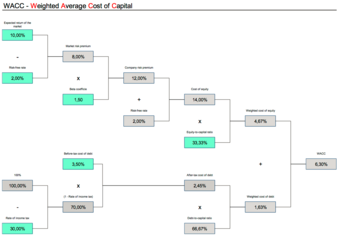
WACC
While this image goes into a bit more detail on the derivation of the cost of equity and the cost of debt, the final three boxes on the right ultimately demonstrate the way in which required rates balance out into a WACC (one for debt, one for equity). Debt tends to be a lower rate because it is paid out first if a company goes bankrupt (i.e. lower risk). Equity is a bit higher risk (only paid out if there is capital remaining after debts are paid), and thus equity has a higher rate (and higher risk).
The Difference
Ultimately, the difference between the cost of capital and the required return is both one of perspective (borrower looks at cost of capital for a project; investors look at required return) as well as the potential for a WACC, which integrates various required returns for a single investment project.
10.1.3: Relationship Between Financial Policy and the Cost of Capital
Financial policy, not cost of capital, must be utilized to determine which investments to pursue, given that resources are limited.
Learning Objective
Explain the relationship between a company’s financial policy and its cost of capital
Key Points
- As opposed to strictly using cost of capital, decisions must be made using opportunity cost of capital.
- Opportunity cost of capital is the amount of money foregone by investing in one asset compared to another.
- Facets of financial policy include valuation, portfolio theory, hedging, and capital structure.
Key Term
- leverage
-
The use of borrowed funds with a contractually determined return to increase the ability of a business to invest and earn an expected higher return (usually at high risk).
Financial Policy and the Cost of Capital
Financial policy is used by companies or investors in order to determine the best way to allocate their resources. In regard to cost of capital, financial policy must be utilized in order to decide which investments have the highest return, given that resources are limited. To analyze various options, managers use valuation techniques, such as the capital asset pricing model or discounted cash flow analysis. As opposed to strictly using cost of capital, decisions must be made using opportunity cost of capital.
Opportunity cost of capital is the amount of money foregone by investing in one asset compared to another. As an investor, this can simply be a choice of one asset over another. As a company, this choice can also involve the use of current assets in new investments. For example, an idle piece of land could be used for a new factory; however, the opportunity cost of what else it could have been used for must be taken into consideration during analysis.
Other Roles of Financial Policy
The use of financial policy in decision making does not only involve valuation. Other facets include portfolio theory, hedging, and capital structure.
Portfolio Theory
Portfolio theory is a mathematical formulation of the concept of diversification in investing. It attempts to maximize the expected return of a portfolio, or a collection of investments, for a given amount of risk by carefully choosing the proportions of various assets. In other terms, portfolio theory attempts to minimize risk for a given level of expected return. For example, to the extent prices in the stock market move differently from prices in the bond market, a collection of both types of assets can, in theory, face lower overall risk than either could individually.
Hedging
Along the same lines, companies use hedging techniques to offset potential gains and losses. Hedging is the practice of taking a position in one market to offset and balance against the risk adopted by assuming a position in a contrary or opposing market or investment. Simply put, a hedge is used to reduce any substantial gains or losses suffered by an individual or an organization. Companies often use hedging techniques to offset the risk of price fluctuation for commodities, such as oil or agricultural products.
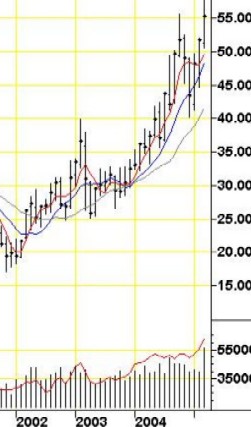
Oil Prices
Companies often use hedging techniques to offset price fluctuations for commodities. The fluctuation of oil prices can be seen in the above graph.
Capital Structure
The capital structure of a company refers to the way it finances its assets through some combination of equity, debt, or hybrid securities. Capital structure may be highly complex and include dozens of sources. A simple example, though, would be a company that sold $20 million in equity and $80 million in debt. This company would be 20% equity financed and 80% debt financed. A company’s ratio of debt to total financing is referred to as its leverage.
10.2: Valuing Different Costs
10.2.1: The Cost of Debt
The cost of debt is a calculation taking into account the risk premium, the risk-free rate, and taxes.
Learning Objective
Calculate the cost of debt and understand how debt differs from equity
Key Points
- The weighted average cost of capital takes into account the cost of debt and the cost of equity. Measuring the cost of each of these is therefore critical to effective capital structuring.
- The cost of debt tends to be lower than the cost of equity, as debts are paid before equity in a bankruptcy situation.
- The risk-free rate and the tax rate are both firmly set. The risk-free rate is determined as the rate of return on an idealized risk-free asset.
- The risk premium is negotiated between the lender and the borrower, mostly depending on collateral and scale of the loan.
When financing a new project, business, or operation, organizations can utilize both equity and debt to create a balanced weighted average cost of capital. One of the primary differences between equity and debt pertains to risk, and the impact that risk has on the cost of capital. To understand the role of debt, and how the cost of debt impacts overall cost of capital, the weighted average cost of capital equation is a useful data point:
Calculating the Cost of Debt (Rd)
When an organization borrows capital from outside lenders, the interest on these loans is called debt. The variables involved in a debt transaction are fairly simple:
- Kd – The cost of debt (referred to as Rd above)
- Rf – The risk free rate
- T – Tax
- Credit risk rate – Or the risk premium
When these variables are plugged into a formula, it looks like this:
The risk -free rate (or Rf) is externally determined from the general market, and is described as the overall cost incurred due to the time value of money with no risk whatsoever involved. This is usually derived from a government treasury bond, as it is the most the investment asset in most markets with the lowest possible rate of risk. Tax rates are set externally as well, and are concrete.
The credit risk rate is therefore the point of negotiation, and where a risk premium is attached to the debt instrument to compensate the investor in regards to a return (for the risk taken). As a general rule, the larger the debt is the higher the risk rate will be (as all other things being equal, a higher debt is harder to pay back). Debtors will also take into consideration the collateral available to the organization (i.e. a valuation of their assets).
Debt Compared to Equity
Determining the cost of debt is quite a bit easier than determining the cost of equity. The inputs to a debt assessment are tangibly determined, and consistent across the life of the agreement. It is worth noting that debt is generally less risky from the investor’s point of view, as debt obligations are paid out before equity obligations if a business goes bankrupt.
10.2.2: The Cost of Preferred Stock
The cost of preferred stock is equal to the preferred dividend divided by the preferred stock price, plus the expected growth rate.
Learning Objective
Calculate the cost of a company preferred stock
Key Points
- Preferred stock is an equity security with properties of both an equity and a debt instrument.
- Because preferred stock carries a differing amount of risk than other types of securities, we must calculate its asset specific cost of capital to work into our overall weighted average cost of capital.
- The dividend is usually specified as a percentage of the par value or as a fixed amount.
Key Term
- hybrid instrument
-
A broad group of securities that pay a predictable (fixed or floating) rate of return or dividend until a certain date, at which point the holder has a number of options including converting the securities into the underlying share.
Example
- The price of a preferred stock is $100. It will pay a fixed dividend of $10 each year. The growth rate is expected to be 3%.. The cost of preferred stock is 13%.
The Cost of Preferred Stock
Preferred stock is an equity security with properties of both an equity and a debt instrument. It is generally considered a hybrid instrument. Preferred stock represents some degree of ownership in a company, but usually doesn’t come with the same voting rights. In the event of liquidation, preferred shareholders are paid off before the common shareholder, but after debt holders. Preferred stock may also be callable or convertible, meaning that the company has the option to purchase the shares from shareholders at anytime for any reason – usually for a premium – or convert the shares to common stock. Similar to bonds, preferred stocks are rated by the major credit rating companies. Some people consider preferred stock to be more like debt than equity.
Contribution To Cost of Capital
Because preferred stock carries a differing amount of risk than other types of securities, we must calculate its asset specific cost of capital to work into our overall weighted average cost of capital. Similar to debt, this can be a relatively simple process since we can observe values needed as inputs in the market. With preferred shares, investors are usually guaranteed a fixed dividend forever. This is different than common stock, which has variable dividends that are never guaranteed. If preferred dividend is known and fixed, we can use the following equation to calculate the cost of capital for preferred stock .

Cost of Preferred Stock
The cost of preferred stock is equal to the preferred dividend divided by the preferred stock price, plus the growth rate.
This tells us that the cost of preferred stock is equal to the preferred dividend divided by the preferred stock price, plus the expected growth rate. The dividend is usually specified as a percentage of the par value or as a fixed amount. Sometimes, dividends on preferred shares may be negotiated as floating – they may change according to a benchmark interest rate index.

Example Equation
$10 divided by $100, plus 3%.
10.2.3: The Cost of Common Equity
The cost of common equity is an imperfect calculation, an estimation based upon valuing the firms risk relative to the market.
Learning Objective
Utilize various formulas to calculate the cost of common equity from different perspectives
Key Points
- Debt is a firm calculation of the cost of capital, where the lender applies an premium (interest rate) to the risk-free rate based upon the organization’s existing assets (collateral) and the size of the loan.
- The cost of common equity is quite a bit less clear, as it is an estimation of the organization’s susceptibility to risk.
- The capital asset pricing model (CAPM) is the traditional way to approach estimating an organization’s required return rate for an investor, requiring a risk estimation.
- An expansion on the CAPM approach is the Fama-French three-factor model, which adds company size and book-to-market ratio to this calculation.
- The dividend discount model is another method, where each expected future dividend payment is discounted to present day dollars to provide a valuation of the security.
Key Term
- price-to-book ratio
-
Or market-to-book ratio, this ratio compares the market valuation of an organization to the book value of the organization.
As a funding source, debt and equity are priced quite differently. While debt relies heavily on default premiums being applied to a risk-free bond rate of interest (the premium usually dependent on the size of the debt compared to the size of the firm), equity isn’t quite as well-defined. As a result, the cost of common equity is often inferred through assessing and comparing it to similar risk profiles, and trying to decipher the firm’s relative sensitivity to systematic (market) risk.
The Capital Asset Pricing Model
One common tool used in assessing the cost of common equity is the capital asset pricing model (CAPM), which can be described via the following formula:
What this formula is saying is essentially that the cost of equity is equal to the risk free rate of return plus a premium for the expected risk of investing in the organization’s equity. The variable are defined as follows:
- Es – expected return for a security
- Rf – expected risk-free return rate
- βs – sensitivity to market risk
- Rm – historical return of the stock market
- (Rm – Rf) – risk premium of market assets over risk free assets
Other Tools to Value Equity
The cost of common equity is essentially the same thing as estimating the expected (or required) return to investors in the stock market. The idea is simply that the higher risk an organization is, the higher the corresponding return should be. As a result, there are countless stock price evaluation strategies and tactics one could use to estimate the cost of common equity from various perspectives. Two of these include the dividend discount model and the Fama-French three-factor model.
Dividend Discount Model
In short, this theory states that a given stock is worth the sum of its future dividend payments, discounted to their present value. This is therefore a model of deriving the present value of future dividend payments, calculated as follows (assuming no end date):
In this calculation, P is the stock price while D is the dividend, g is the (constant) growth rate, and r is the constant cost of equity and t is time.
There are a few problems with this method, most notably that a steady and perpetual growth rate that is less than the cost of capital may not be reasonable. Similarly, this model is quite vulnerable to the growth rate. Also, not all stocks pay dividends.
Fama-French Three-Factor Model
Another valuation model was derived by Eugene Fama and Kenneth French with the intention to include company size and price-to-book ratio with overall market risk. You’ll recognize the first half of this equation as the simple CAPM calculation, while the second half includes SMB (small minus big market capitalization) and HML (high minus low book-to-market ratio) multiplied by coefficients (from linear regression). While this all sounds a bit complicated, the basic premise is to offset the risk calculation with a stronger valuation for a firm’s assets and scale:
Conclusion
All and all, the valuation of common equity is always an estimation. As understanding the risk of a given organization within the stock market is intrinsically speculative, equity tends to be quite a bit more costly than debt. After all, when an organization goes bankrupt it is the debtors who are reimbursed first, preferred stock next, and common stock last. This is the riskiest position of an investment.
10.2.4: The Cost of Retained Earnings
Due to the relationship between retained earnings and dividends, the cost of retained earnings as a source of capital is relative to the overall cost of equity.
Learning Objective
Recognize the relationship between dividends, net income, and retained earnings
Key Points
- Retained earnings represent the capital remaining after net income is paid out to investors and shareholders via dividends. Retained earnings are reinvested back into the organization.
- Reinvesting capital into the organization is therefore considered equity, and calculated relative to that equity within the weighted average cost of capital (WACC).
- Retained earnings represents the capital left after paying out dividends. The opportunity cost of retaining earnings is dividends, and is therefore equivalent in cost to the equity that expects those dividends.
- As a result, understanding the retention ratio is dependent on deriving the dividend payout ratio.
Key Term
- dividend payout ratio
-
The fraction of net income an organization pays out to investors.
Retained Earnings Defined
Retained earnings indicate the amount of capital remaining after profits or losses from net income are paid out to investors and shareholders via dividends. Retained earnings are reinvested back into the organization. When organizations create profits, these profits are not always entirely distributed to investors at the end of a reporting period. As a result, these retained earnings can essentially be viewed as a potential funding source for the organization.
No capital comes without costs, however, and the cost of this capital must be taken into account when calculating the weighted average cost of capital (WACC). Retained earnings are included in the WACC equation as equity, as dividends are a component of the return on capital to equity stakeholders, and thus will have a correspondingly weighted influence on the cost of equity.
Understanding the equation to determine the retention ratio adds some clarification for this point:
The dividend payout ratio is a useful addition to the above equation, and is written as:
The relationship between dividends and retained earnings is quite clear when it comes to recognizing the opportunity cost and thus the overall cost of this capital source.
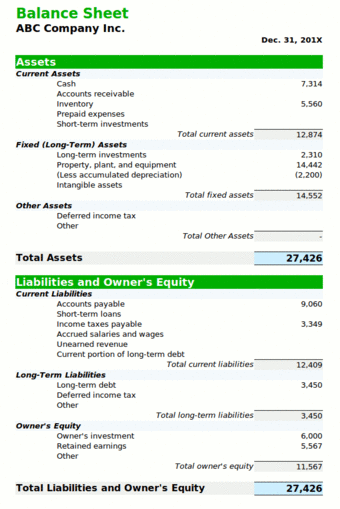
Balance Sheet Example
Retained earnings is listed under equity, and is thus relative to the cost of equity.
10.2.5: The Cost of New Common Stock
Issuing new common stock is a time intensive process that gives access to capital with various direct and indirect costs.
Learning Objective
Weigh the direct and indirect costs of issuing new common stock as a form of capital
Key Points
- One of the options for raising organizational capital is issuing new common stocks, which falls under new equity (as opposed to debt).
- Issuance of new common stock incurs a variety of direct costs, including those related to legal, accounting, marketing, management, and taxation.
- Issuing new common stock also incurs a variety of indirect costs revolving around loss of ownership, legal requirements of financial statement releases, and unreliability of demand for shares.
Key Term
- weighted average cost of capital
-
Common stock is one of a variety of inputs in the weighted average cost of capital, which calculates the overall cost of borrowing.
Cost of Capital
When it comes to the cost of capital, common stock is one of a few options on the table for raising funding. From various debt instruments to preferred stock to common stock, larger organizations tend to diversify funding input to optimize their potential financial leverage. In order to understand the weighted average cost of capital (WACC) of all of these inputs, the cost of each source of debt and/or equity must be determined.
The Cost of Common Stock
When it comes to issuing common stock, there are both direct and indirect costs to consider.
Direct Costs
In terms of literal capital spent, the issuance of new common stock incurs a variety of capital costs both at the initial offering and throughout the process of managing this funding source over time:
- Legal fees for the distribution of business shares to the general public
- Increased accounting costs (if initial IPO) for management of a publicly traded firm
- Marketing costs for recruiting investors
- The time and effort of management
- Taxation (which differ region to region) pertaining the the distribution of equity
From a general perspective, the process of offering shares is skill intensive, from management to legal to accounting, firms must hire and maintain a wide pool of talent to maintain this form of equity.
Indirect Costs
In addition to the tangible capital costs involved, there are also a variety of indirect trade-offs that organizations must understand prior to pursuing this source of funding. Indirect costs include:
- Requirement to release financial information, including information that competitors may find valuable
- Compared to debt, it is less reliable as there may not be buyers interested at the desired price point
- Some loss of control, as the sale of shares is essentially the sale of organizational ownership
- Depending on the scale of shares available, the organization must consider takeover risks
As the issuance of publicly traded common stock is essentially the sale of the public auction of organizational equity, any and all considerations pertaining to control, ownership and legal implications should be considered as opportunity costs compared to other forms of funding.
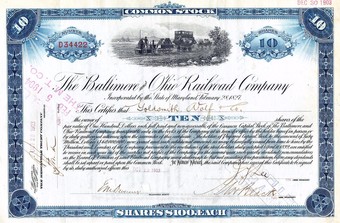
Common Stock
Stock image of common stock.
10.3: Approaches to Calculating the Cost of Capital
10.3.1: The Capital Asset Pricing Model
The capital asset pricing model helps investors assess the required rate of return on a given asset by measuring sensitivity to risk.
Learning Objective
Calculate sensitivity to risk on a theoretical asset using the CAPM equation
Key Points
- Investors use various tools to determine the overall expected return and relative risk of a security in the broader financial markets.
- One such tool is the capital asset pricing model (CAPM), which essentially distills the required rate of return applied to the risks (both of which are relative to the risk-free rate).
- By utilizing the variables involved in a CAPM calculation, an investor can also determine the risk to return ratio alongside the security market line (a graphical representation of the asset’s risk and return).
- By utilizing the CAPM equation, investors can determine when an asset is undervalued, and balance a portfolio for the best prospective return on the lowest possible risk.
Key Term
- capital asset pricing model
-
An equation that assesses the required rate of return on a given investment based upon its risk relative to a theoretical risk-free asset.
When considering assets for the diversification of an investment portfolio, investors and financiers use a variety of tools to project the required rate of return and risk of a given investment. All this really means is that investors are on the look out for ways to minimize risk, maximize returns, and invest intelligently in assets that are well-priced. The key assumption here is that the market will self-correct to adjust each investment option’s expected return to the relative risk of investing.
The Capital Asset Pricing Model
When measuring the ratio between risk and return on a given investment, the capital asset pricing model (CAPM) can be a useful tool. This model focuses on measuring a given asset’s sensitivity to systematic risk (also referred to as market risk) in relation to the expected return compared to that of a theoretical risk-free asset.
How CAPM Works
This sounds complicated, but it’s simpler than it seems. All this really means is that the CAPM tries to measure the risk the market will offer the asset compared to the risk-free rate, and make sure the expected return will offset that risk. To understand this concept, there are a few variables that are useful to identify up front:
- E(Ri) is an expected return on security
- E(RM) is an expected return on market portfolio M
- β is a non-diversifiable or systematic risk
- RM is a market rate of return
- Rf is a risk-free rate
There are quite a few ways to rearrange the relationship between these variables to derive meaningful information. Like all equations, depending on what you know you can solve for what you don’t know as well. For a basic CAPM calculations, you would want to solve for the expected return on a security, which looks like this:
Security Market Line
Through rearranging these variables, you can also take a look at the concept of the security market line (SML), which underlines a security’s relationship with systematic risk and respected return in a graphical format. This is written as:
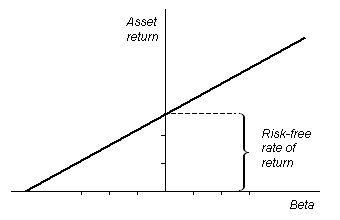
Security Market Line
The security market line is illustrated in this graph, where an assets expected return can be visualized.
Risk and Return
A final application of the CAPM variables in relation to one another is in deriving a ratio that illustrates the relationship between risk and return. On the left side of the equation below, you have an assessment of the overall risk relative to a risk-free asset. On the right side, you have the overall return (similarly relative to a risk-free asset). This can be written as follows:
Investors can utilize the CAPM equation and its various implications to assess a variety of market investment opportunities to diversify a portfolio and identify undervalued assets.
10.3.2: The SML Approach
The SML is the graphical representation of CAPM used to determine if an asset is priced to offer a reasonable expected return for the risk.
Learning Objective
Analyze assets using the Security Market Line Approach
Key Points
- The SML graphs the relationship between risk β (beta) and expected return.
- All correctly priced assets lie on the SML.
- If a security is priced above the SML, it is undervalued. If it is priced below the SML, it is overvalued.
Key Term
- slope
-
The ratio of the vertical and horizontal distances between two points on a line; zero if the line is horizontal, undefined if it is vertical.
Example
- The current risk-free rate is 5%. The market is expected to return 12% next year. The beta of the security is 1.9. Expected return = 5% + 1.9*(12% – 5%) Expected return = 18.3% We expect the asset to return 18.3% and be plotted on the SML. However, the current real rate of return for the asset is 19%. The asset would be plotted above the SML. Therefore, it is undervalued and should be bought.
The SML Approach
The Security Market Line (SML) is the graphical representation of the capital asset pricing model (CAPM), with the x-axis representing the risk (beta), and the y-axis representing the expected return. It graphs the relationship between beta (β) and expected return, i.e. it shows expected return as a function of β. The y-intercept of the SML is equal to the risk-free interest rate, while the slope is equal to the market risk premium (the market’s rate of return minus the risk-free rate). The slope also represents the risk-return tradeoff at a given time. The SML is applicable to any asset.

SML Equation
The SML is the graphical representation of CAPM, and thus is found using the same equation.
Applications of the SML
Individual assets that are correctly priced are plotted on the SML. In the ideal world of CAPM, all assets are correctly priced and thus lie on the SML. In real market scenarios, we are able to use the SML graph to determine if an asset being considered for a portfolio offers a reasonable expected return for the risk. If an asset is priced at a point above the SML, it is undervalued, since for a given amount of risk, it yields a higher return. Conversely, an asset priced below the SML is overvalued, since for a given amount of risk, it yields a lower return.

CAPM-SML
The Security Market Line for the Dow Jones Industrial Average over a 3 year period, with the x-axis representing beta and the y-axis representing expected return.
Another way to think about real market applications of the SML would be in terms of buying and selling securities. If an asset is priced above the SML, and thus undervalued, it should be bought. If an asset is priced below the SML, and thus overvalued, it should be sold.
10.3.3: Discounted Cash Flow Approach
A discounted cash flow analysis is a highly useful tool for calculating the net present value of a given product, process, asset, or organization.
Learning Objective
Translate future projected cash flows into present day dollars, incorporating risk and the time value of money
Key Points
- A discounted cash flow analysis is a highly useful tool for determining the net present value (NPV) of a given organization, process, product, or asset.
- An NPV takes into account risk, forecasts for cash flows, and the time value of money to determine what future capital returns are worth in present-day dollars.
- When calculating discounted cash flows over a given time period, investors and strategists must estimate the required rate of return based on assumed risk and the opportunity cost of risk-free investments (i.e. risk-free rate).
- The most important thing for strategists and investors to remember about a discounted cash flow analysis is uncertainty, as these are future cash flows that may (or may not) occur.
Key Terms
- discount rate
-
The interest rate used to discount future cash flows into present values.
- nominal value
-
Prior to adjustment (in this context, prior to time value of money adjustments).
The discounted cash flow approach is a valuation method investors and organizations can use to assess the net present value (NPV) of an asset, process, product, or the overall organization. NPV analyses using the discounted cash flow approach are widely used across various industries to decide which projects to invest in. They are also used as valuation devices for investors when looking at company performance, using past performance to project future performance.
The Discounted Cash Flow Formula
The discounted cash flow formula focuses on determining the relative time value of money of each projected cash flow (i.e. monthly, quarterly, annually, etc.), bringing each forecast of future value into present value terms. Just as in an NPV analysis, the ultimate end product will be the value of future profits (or losses) in today’s terms. It’s calculated as follows:
In situations of multiple cash flows over multiple periods of time, it is necessary to create a summation that can incorporate variance in both variables:
Sometimes cash flows are considered continuous. In such scenarios, the appropriate adjustment to the equation is:
Inputs
When considering these formulas, you’ll need to understand your inputs. The inputs for a discounted cash flow analysis are:
- DPV – The discounted present value of the future cash flow (FV), or FV adjusted to compensate for the units of time in the future it will be received.
- FV – The nominal value of a cash flow amount in a future period (i.e. the amount of the cash flow prior to taking time value of money into account).
- r – The interest rate or discount rate, which reflects two important pieces of information: the opportunity cost of foregoing other investments as well as the intrinsic risk of not receiving the projected cash flow.
- n – The time (in a given unit of time) before the future cash flow occurs. This is usually done annually, but can be done monthly or quarterly. Keep in mind that r must be adjusted according to the time period!
Strategic Use
Like any projection, the most important thing to keep in mind as either investor or strategist is uncertainty. The primary purpose of a future cash flow analysis is to balance expectations to consider existing and future resources to make the optimal decision (from a profit perspective). As a result, determining ‘r’ (required rate of return due to opportunity cost and risk) is absolutely critical to the success of these calculations.
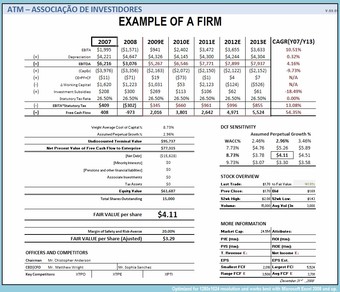
A Discounted Cash Flow Example
This is a good example of a what a discounted cash flow analysis would look like on paper, particularly as a prospective investor. There’s actually quite a bit more information here than you may strictly need to understand the calculation, but it’s a great way to see how each piece of information fits together.
10.3.4: The “Bond Yield Plus Risk Premium” Approach
We can estimate the value of a company’s equity by adding its risk premium to the yield to maturity on the company’s long-term debt.
Learning Objective
Describe the process for the bond yield plus risk premium approach
Key Points
- The BYPRP approach applies to a company’s publicly traded equity.
- The yield to maturity is the discount rate at which the sum of all future cash flows from a bond are equal to its price.
- The equity risk premium is the return that stocks are expected to receive in excess of the risk-free interest rate.
- The BYPRP approach does not produce as accurate an estimate as the capital asset pricing model or discounted cash flow analysis.
Key Terms
- dividend yield
-
A company’s total annual dividend payment per share, divided by its price per share.
- principal payment
-
The payment made upon maturity of a bond
- coupon payment
-
A periodic interest payment that the bondholder receives during the time between when the bond is issued and when it matures.
Example
- A company’s long-term debt has a yield to maturity of 6%. The risk premium on its equity is 4%. Thus, the required return on the company’s equity is 10%.
Bond Yield Plus Risk Premium Approach
The bond yield plus risk premium (BYPRP) approach is another method we can use to determine the value of an asset, specifically, a company’s publicly traded equity. BYPRP allows us to estimate the required return on an equity by adding the equity’s risk premium to the yield to maturity on company’s long-term debt.

Bond Yield Plus Risk Premium Equation
States that the required return on an equity equals the yield of the company’s long-term debt plus the equity’s risk premium.
Bond Yield vs. Risk Premium
Simply put, the yield on a bond is the rate of return received from the investment. In the BYPRP approach, we use a bond’s yield to maturity, which is the discount rate at which the sum of all future cash flows from the bond (coupon payments and principal payments) are equal to the price of the bond. This is also referred to as the internal rate of return (IRR).
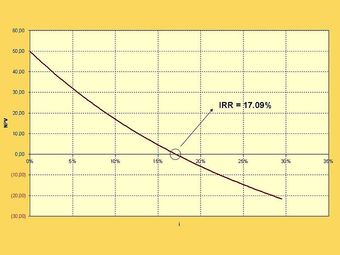
Yield To Maturity Graph
A hypothetical graph showing yield to maturities (or internal rates of return) for corresponding present values.
The equity risk premium is essentially the return that stocks are expected to receive in excess of the risk-free interest rate. The normal historical equity risk premium for all equities has been just over 6%. In general, an equity’s risk premium will be between 5% and 7%. Common methods for estimating the equity risk premium include:
- The Fed Model (forward operating earnings yield [earnings per share divided by share price] minus the 10-year U.S. Treasury Bond yield)
- The dividend yield plus projected earnings growth, minus the 10-year Treasury yield
- The historical stock returns minus the 10-year Treasury yield
Estimating the value of an equity using the bond yield plus risk premium approach has its drawbacks. We can only utilize the BYPRP approach if the entity has publicly traded debt, and it does not produce as accurate an estimate as the capital asset pricing model or discounted cash flow analysis.
Moreover, equity risk premium estimates can be highly inaccurate, while also varying wildly depending on which model is used. It can be very difficult to get an accurate estimate of the risk premium on an equity, having a duration of roughly 50 years, using a risk-free rate of such short duration as a 10-year Treasury bond.

Example Equation
Required return = 6% + 4%
10.4: The WACC
10.4.1: Weighted Average Cost of Capital
The weighted average cost of capital (WACC) is a calculation that reflects how much an organization pays in interest when acquiring financing options.
Learning Objective
Derive the weighted average cost of capital
Key Points
- The weighted average cost of capital (WACC) is a calculation that allows firms to understand the overall costs of acquiring financing.
- Capital inputs generally come in the form of debt and equity. Debt is usually quite simple to calculate as it is set in the terms of bonds and loans explicitly.
- Equity is a bit more complex, as it is subjected to market (systematic) risk. The capital asset pricing model is a useful tool in estimating the cost of equity.
- Applying the WACC to the estimated rate of return for new projects and ventures is a simple way to determine if a project is sufficiently profitable to offset the cost (risk) of financing.
Key Term
- weighted average cost of capital
-
A calculation of the overall cost of capital used by an enterprise, made by totaling the cost of each source of capital used multiplied by its proportional share of the total capital used.
Weighted Average Cost of Capital Defined
Organizations have a few options available when it comes to finding funding for their operations. From debt options such as taking out loans or offering long-term corporate bonds to equity such as preferred and common stock, larger organizations tend to find a balance between these options that is optimized for the best possible weighted average cost of capital (WACC) to operate at the scale that creates the best revenue opportunity.
In short, the WACC is a measure of what all of these capital inputs will cost the organization in terms of an average interest rate.
Why Calculate WACC?
WACC is a useful calculation, as it shows management what the cost of borrowing capital is overall. This overall cost of capital can then be a minimum required return on any new operation. For example, if it will cost 8% in capital costs to fund a project that creates 10% in profit, the organization can confidently borrow capital to fund this project. If the project would only turn 8% profit, the firm would have a difficult decision. If the project would turn 6% profit, it is quite easy to strategically argue against the new project.
How to Calculate WACC
Calculating the cost of capital is actually quite a simple equation. Most firms are only receiving from either debt or equity (though there can be quite few inputs to each of these subheadings). What this means is that the overall percentage of the business that is funded by debt (MVd/MVd + MVe) must be multiplied by the cost of debt (Rd), while similarly the percent funding of equity (MVe/MVd + MVe) must be multiplied by the cost of equity (Re) and added together. This can also be applied to the corporate tax rate in a given country of operation. This is written out as follows:
The cost of debt is usually fixed, based on the terms of a given bond or loan contract. As a result, the cost of debt is usually both certain and predictable. The cost of equity is a little bit more complex, as it is speculative and often determined (to some degree) by investor behavior. The capital asset pricing model (CAPM) is a traditional approach to determining the cost of equity:
Each of the variables here are defined as:
- Es – expected return
- Rf – expected risk-free return
- βs – sensitivity to market risk
- Rm -historical return
- (Rm – Rf) – risk premium of market assets over risk free assets.
By calculating the estimated cost of equity, and applying that to the WACC equation with the cost of debt and capital structure, organizations can determine the cost of capital (and thus the required return on projects/assets).
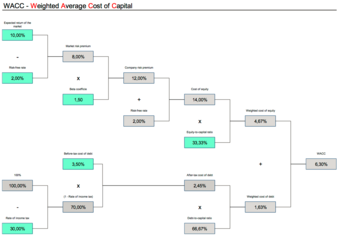
Weighted Average Cost of Capital Tree
This diagram is an excellent illustration of how various forms of debt and equity consolidate into broader calculation of debt and equity overall, and how those can combine as a total weighted average cost of capital.
10.4.2: The Weightings
The weightings used in the WACC are ratios of the market values of various forms of debt and equity used in a company’s financing.
Learning Objective
Define how a company’s weighted average cost of capital is weighted
Key Points
- The WACC must take into account the weight of each component of a company’s capital structure.
- The calculation of the WACC usually uses the market values of the various components rather than their book values.
- Market value is the price at which an asset would trade in a competitive auction setting.
- Book value refers to the value of an asset according to the account balance present on the balance sheet of a company.
- If the value of a company’s debt exceeds the value of its equity, the cost of its debt will have more “weight” in calculating its total cost of capital than the cost of equity. If the value of the company’s equity exceeds its debt, the cost of its equity will have more weight.
Key Term
- Synergy
-
Benefits resulting from combining two different groups, people, objects, or processes.
The Weightings
To calculate the weighted average cost of capital (WACC) we must take into account the weight of each component of a company’s capital structure. To review, the equation for WACC is:
MVe stands for the market value of equity; MVd stands for the Market Value of Debt; Re stands for cost of equity; Rd stands for cost of debt; and t is the company’s tax rate. If the person analyzing a company chooses or if the market value of a company’s debt and equity is not available, the book value can be used.
The “weighting” varies based on how the company finances its activities. If the value of a company’s debt exceeds the value of its equity, the cost of its debt will have more “weight” in calculating its total cost of capital than the cost of equity. If the value of the company’s equity exceeds its debt, the cost of its equity will have more weight.
Market Value vs. Book Value
Since we are measuring expected cost of new capital, the calculation of weighted average cost of capital usually uses the market values of the various components rather than their book values. These may differ significantly.
Market value is the price at which an asset would trade in a competitive auction setting. It is the true underlying value of an asset according to theoretical standards. It is a distinct concept from market price, which is the price at which one can transact. For market price to equal market value, the market must be efficient and rational. Market value also requires the element of “special value” to be disregarded. Special value refers to a synergy that may exist between two parties that makes the fair price of a transaction higher.
Book value refers to the value of an asset according to the account balance present on the balance sheet of a company. The balance sheet is a summary of the financial balances of a company and is often described as a “snapshot of a company’s financial condition. “
An asset’s initial book value is its actual cash value or its acquisition cost. Cash assets are recorded or “booked” at actual cash value. Assets such as buildings, land, and equipment are valued based on their acquisition cost, which includes the actual cash cost of the asset, plus certain costs tied to the purchase of the asset, such as broker fees.
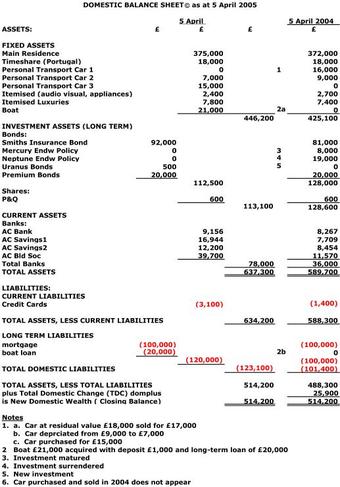
Domestic Balance Sheet
If the person analyzing a company chooses or if the market value of a company’s debt and equity is not available, the book value can be used. The book value of debt and equity can be found on the company’s balance sheet.
10.4.3: Factors Controlled by the Firm
Decisions about capital structure (ratio of debt and equity) alongside projecting rates of return can give firms some internal control over capital costs.
Learning Objective
Recognize the strategic considerations of capital structure by understanding weighted average cost of capital and the internal rate of return
Key Points
- By understanding the weighted average cost of capital (WACC) and potential internal rates of return (IRR) of various projects, firms can have some strategic control of capital costs and investment returns.
- Each funding source will come with a different cost of capital. Averaging these funding sources into the WACC is a central tool for financial management.
- Once the costs of capital are optimized, a business can apply this cost of capital to various asset and project assessments. The IRR must exceed the WACC.
Key Term
- capital structure
-
The way that a corporation finances its assets through some combination of equity, debt, and hybrid securities.
When pursuing financing, organizations encounter a variety of factors that impact the weighted average cost of capital. Some of these factors are within the firm’s strategic control, while others are external forces outside the firm’s control. As a financial professional or upper level strategist, understanding what capital structure options are available to a firm plays a critical role in financial management.
Capital Structure
Capital structure refers to the way in which an organization finances operations. This is generally illustrated via a balance sheet, where the overall assets are offset by the capital structure of liabilities and equity. It is through the decisions to acquire various forms of debt and equity that an organization can derive a weighted average cost of capital (WACC) that is sustainable within the context of organizational profitability. If the cost of capital is higher than the returns from those investments, the organization lacks the profitability required to justify itself. WACC is calculated as follows:
In the above equation, the first segment is measuring the cost of equity coupled with the percentage of the capital structure that is funded by equity. The second segment is making the same calculation, but this time with the cost of debt and the relative percentage of capital structure which is funded via this source. The final segment (1 – t) is the application of a corporate tax rate (depending on the country of operation.
Understanding the cost of each input of the capital structure, firms can control (to some degree) how they fund their operations and acquisitions of assets.
Internal Rate of Return
Another important decision made by financial professionals in relation to the cost of capital revolves around the required rates of return of various projects. Investing capital into an operation always incurs the opportunity cost of investing in something else. As a result, organizations can control their operations by measuring and projecting the rate of return on each project, and investing strategically in the most profitable projects.
An internal rate of return (IRR) calculation can be useful when doing this. The IRR is going to look at the net present value (NPV) of a given project, and calculate it for a break even point (i.e. set the equation to zero, when taking cost into account). By doing so, the organization can identify the anticipated rate of return on the project. take a look at the equation below:
In this equation, n is the number of periods in a project (i.e. number of anticipated cash flows over the life of the project), C is the cash flow amount (which can vary for each period, hence the summation), r is the rate of return being solved for, and N is total number of periods (n). When solving for zero, the organization will identify what the rate of return is for each project. Deciding upon projects that provide returns greater than the WACC derived from the capital structure will set the organization down a profitable path (assuming forecasts are reliable!).
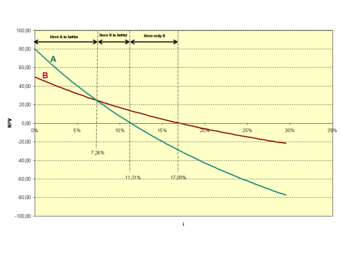
Exclusive_investments.png
When weighed different projects over time, the IRR calculation can be useful in determining which investment of capital is best over the lifetime of each project. When taking the WACC into account (derived from capital structure decisions), the organization can measure operational options against the required rate of return.
10.4.4: Factors External to the Firm
The weighted average cost of capital is vulnerable to market risks, interest rate changes, inflation, economic factors, and tax rates.
Learning Objective
Recognize the various external factors that may impact the weighted average cost of capital
Key Points
- While organizations have some control over capital structure decisions, there are many factors at play in the external environment that are outside the control of the firm.
- Interest rates, inflation, and other economic forces can play a substantial role in the overall cost of capital.
- Fluctuations in the marketplace (i.e. market risk, or systematic risk) can be both unpredictable and influential on overall risk and return for investors, impacting capital costs.
- Corporate and investor tax legislation impacts the cost of capital, as both organizations and investors must factor tax into their investment decisions.
Key Term
- systematic risk
-
Risk that is intrinsic to the marketplace.
When organizations begin weighing the weighted average cost of capital (WACC) and determining overall capital structure, there are some factors that are within the control of the organization, and some external factors that are not. When it comes to projecting the cost of capital, it’s useful to assess some of the external factors that may influence the overall cost.
Interest Rates
Interest rates fluctuate for a wide variety of reasons, and are a primary tool of monetary policy. Governments and central banks often make alterations to interest rates as a result of investment, unemployment, inflation, and other broader economic factors. Altering interest rates can impact the spending, borrowing, and investing habits within an economy, and therefore tend to fluctuate for economic purposes.
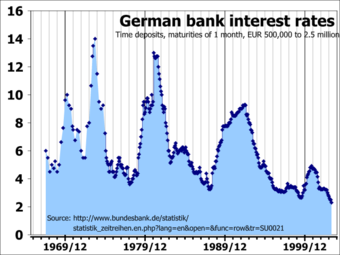
German Bank Interest Rates
This chart illustrates changes in interest rates in Germany over time.
Inflation
Related to interest rates (and a direct impact upon interest rate change) is the natural inflation or deflation of the currency being borrowed or lent. Organizations must take into account the time value of money as it pertains to that capital’s actual alterations in value, which is firmly outside the control of the organization.
Market Fluctuations
2008 is a prime example of how market forces can drastically impact equity. As markets rise and fall, the cost of capital as well as the perceived market risk (systematic risk) will naturally and relatively unpredictably fluctuate. When utilizing markets as a source of funding, the intrinsic risk of the market itself is outside of the control of the organization.
Corporate Tax
Depending upon the region of operation, tax implications may have a significant impact on the cost of capital. In many jurisdictions, debt and interest on equity may receive certain tax breaks. Investors may also encounter taxes on returns on their investments and tax on dividends, impacting the perceived risk and return ratio of a prospective investor. Profit beyond the cost of expenses and capital will be taxed as well, which impacts the overall weighted average cost of capital.
Other Factors
The cost of capital is largely a simple trade off between the time value of money, risk, return, and opportunity cost. Any external factors in the form of opportunity costs or unexpected risks can impact the overall cost of capital.
10.4.5: Making Risk Adjustments
New projects sometimes require taking on risks outside of a company’s current scope, resulting in the need to adjust risk in the WACC.
Learning Objective
Describe how individual projects can alter a company’s WACC of capital
Key Points
- It is possible to adjust risk by figuring the differing risk into the company’s beta.
- The beta coefficient is the risk of a new project in relation to the risk of the market as a whole.
- Therefore, if a new project of differing risk is undertaken, the beta for that project will be weighted into the company’s overall cost of capital.
Key Term
- covariance
-
A measure of how much two random variables change together.
Making Risk Adjustments
The weighted average cost of capital is the minimum return that a company must earn on an existing asset base. This means that, when calculated, WACC will produce a rate equivalent with the current level of risk present in a company’s activities. However, some new ventures will require taking on risks outside of the company’s current scope.
In this case, adjustments will need to be made to the WACC in order to account for the differing level of risk. If the risk is very different, the company’s current WACC may be sidestepped altogether in favor of a WACC typical for companies with similar investments. It is possible to make such adjustments by figuring the differing risk into the company’s beta .

Beta Equation
The beta of an investment is equal to the covariance between the rate of return of the investment, r(a), and that of the portfolio, r(p).
The beta coefficient, expressed as a covariance, is the risk of a new project in relation to the risk of the market as a whole. A company itself will be considered, for investment purposes, as a “portfolio of assets,” and its beta coefficient will represent the weighted average of each “asset’s” beta. Therefore, if a new project of differing risk is undertaken, the beta for that project will be weighted into the company’s overall cost of capital. For example, if the project is twice as sensitive to fluctuations in the market as the company as a whole, then the project’s beta should be twice that of the company during the valuation process. This will increase the risk premium on the project and its cost of equity and subsequently the weighted average cost of capital. This increase in cost of capital will devalue the company’s stock, unless this increase was offset by a higher expected rate of return.
10.4.6: Problems with WACC
While a WACC analysis is highly useful in understanding the cost of funding a project, it relies on assumptions.
Learning Objective
Recognize the risk of using a WACC analysis to predict the overall cost of capital
Key Points
- A weighted average cost of capital (WACC) calculation is a great tool for businesses (particularly financial professionals) in understanding how much it will cost to finance a project.
- However, despite this usefulness, a WACC calculation relies on assumptions that may or may not prove true. This uncertainty should be taken into account when making projections.
- Some of these assumptions include the profitability of the project (which should exceed the cost of capital), the opportunity cost of foregone investments, and the total amount of capital required for the project.
- Whenever a firm uses forecasts such as a WACC, the most important thing to keep in mind is that future planning is based on assumptions. Identify each assumption, and mitigate the risk through understanding worst-case scenarios.
Key Term
- capital requirements
-
The amount of money a project needs in order to be successfully funded.
WACC
The weighted average cost of capital (WACC) is a common and highly useful approach to determining how much it will cost (as a percentage) to borrow money in order to fund a given operation or project. This overall cost of borrowing capital is a great tool for financial professionals, who would like to understand how much a project will cost, and how much it will provide in return. The overall goal is to maintain a certain level of profitability when it comes to making investments in organizational projects.
As a reminder, the formula for WACC is:
Advantages
As a model, the WACC has quite a few advantages. Generally speaking, this process will take into account the differences between the cost of debt and the cost of equity in a given calculation. This allows the firm to understand how much a project funded fully by debt would differ in terms of capital costs than a project that requires a great deal of equity as well (hint: debt is almost always cheaper). It also takes into account the time value of money, normalizing cash flows for present value. Another advantage of this calculation is the simplicity of it. Upper management can quickly look at the WACC for a given project, and compare that to the forecast of the profitability.
Problems
No forecast is perfect, however. All financial professionals and upper management executives must understand the drawbacks of WACC (along with those of virtually every attempt to project future costs and profits with present and past data).
The simplest problem with the calculation are the assumptions it relies on. These can include:
- Profitability – When determining the cost of capital, this number isn’t particularly useful without an understanding of the return on that capital. After all, the profitability must exceed the cost of borrowing the money. Profitability in a future market is never certain, as the demands, needs, competition, and price of inputs could change any day.
- Opportunity Costs – Another important consideration are the opportunity costs, both for investors in the business and the business itself. The cost of capital, particularly on the equity side, are made through identifying the risk of this particular project compared to other projects that could be invested in. These opportunity costs will change over time, which may also change the cost of funding (depending on the contract which secures that funding).
- Amount Required – Projects often encounter unforeseen hurdles, and jumping over these hurdles may required capital that hasn’t been considered in the forecast. As the amount of capital required increases, the financial risk from investors also increases. Higher risk means higher returns, and more capital requirements during the project may increase the overall average cost of capital.
Conclusion
While the WACC calculation does rely on quite a few assumptions, this is something of a necessary risk when it comes to financial projections. Forecasts are not sure things, they are intrinsically uncertain. It is exactly due to this uncertainty that capital investments are risk, and require returns in the first place. When using this model to predict how much capital can be borrowed and at what rate, keep in mind that the situation can change any day.
Chapter 9: Security Market Efficiency and Returns
9.1: The Security Markets
9.1.1: Types of Stock Market Transactions
Types of stock market transactions include IPO, secondary market offerings, secondary markets, private placement, and stock repurchase.
Learning Objective
Differentiate between the different types of stock market transactions
Key Points
- An initial public offering (IPO), or stock market launch, is a type of public offering where shares of stock in a company are sold to the general public, on a securities exchange, for the first time.
- A secondary market offering is a registered offering of a large block of a security that has been previously issued to the public.
- In the secondary market, securities are sold by and transferred from one investor or speculator to another. It is therefore important that the secondary market remain highly liquid.
- Private placement (or non-public offering) is a funding round of securities which are sold not through a public offering, but rather through a private offering, mostly to a small number of chosen investors.
- Stock repurchase (or share buyback) is the reacquisition by a company of its own stock.
Key Terms
- underwriter
-
An entity which markets newly issued securities
- FINRA
-
In the United States, the Financial Industry Regulatory Authority, Inc., or FINRA, is a private corporation that acts as a self-regulatory organization (SRO). FINRA is the successor to the National Association of Securities Dealers, Inc. (NASD). Though sometimes mistaken for a government agency, it is a non-governmental organization that performs financial regulation of member brokerage firms and exchange markets. The government organization which acts as the ultimate regulator of the securities industry, including FINRA, is the Securities and Exchange Commission.
Types of Stock Market Transactions
IPO
An initial public offering (IPO), or stock market launch, is a type of public offering where shares of stock in a company are sold to the general public, on a securities exchange, for the first time. Through this process, a private company transforms into a public company. Initial public offerings are used by companies to raise expansion capital, monetize the investments of early private investors, and become publicly traded enterprises.
A company selling shares is never required to repay the capital to its public investors. After the IPO, when shares are traded freely in the open market, money passes between public investors.
When a company lists its securities on a public exchange, the money paid by the investing public for the newly issued shares goes directly to the company (primary offering) as well as to any early private investors who opt to sell all or a portion of their holdings (secondary offering) as part of the larger IPO. An IPO, therefore, allows a company to tap into a wide pool of potential investors to provide itself with capital for future growth, repayment of debt, or working capital.
Although an IPO offers many advantages, there are also significant disadvantages. Chief among these are the costs associated with the process, and the requirement to disclose certain information that could prove helpful to competitors, or create difficulties with vendors. Details of the proposed offering are disclosed to potential purchasers in the form of a lengthy document known as a prospectus.
Most companies undertaking an IPO do so with the assistance of an investment banking firm acting in the capacity of an underwriter. Underwriters provide a valuable service, which includes help with correctly assessing the value of shares (share price), and establishing a public market for shares (initial sale).
Secondary market offering
A secondary market offering, according to the U.S. Financial Industry Regulatory Authority (FINRA), is a registered offering of a large block of a security that has been previously issued to the public. The blocks being offered may have been held by large investors or institutions, and proceeds of the sale go to those holders, not the issuing company. This is also sometimes called secondary distribution.
A secondary offering is not dilutive to existing shareholders, since no new shares are created. The proceeds from the sale of the securities do not benefit the issuing company in any way. The offered shares are privately held by shareholders of the issuing company, which may be directors or other insiders (such as venture capitalists) who may be looking to diversify their holdings. Usually, however, the increase in available shares allows more institutions to take non-trivial positions in the issuing company which may benefit the trading liquidity of the issuing company’s shares.
Transactions on Secondary Market
After the initial issuance, investors can purchase from other investors in the secondary market. In the secondary market, securities are sold by and transferred from one investor or speculator to another. It is therefore important that the secondary market be highly liquid. As a general rule, the greater the number of investors that participate in a given marketplace, and the greater the centralization of that marketplace, the more liquid the market.

The Philippine Stock Market Board
Private placement
Private placement (or non-public offering) is a funding round of securities which are sold not through a public offering, but rather through a private offering, mostly to a small number of chosen investors. “Private placement” usually refers to the non-public offering of shares in a public company (since, of course, any offering of shares in a private company is and can only be a private offering).
Stock repurchase
Stock repurchase (or share buyback) is the reacquisition by a company of its own stock. In some countries, including the U.S. and the UK, a corporation can repurchase its own stock by distributing cash to existing shareholders in exchange for a fraction of the company’s outstanding equity; that is, cash is exchanged for a reduction in the number of shares outstanding. The company either retires the repurchased shares or keeps them as treasury stock, available for re-issuance.
Companies making profits typically have two uses for those profits. Firstly, some part of profits can be distributed to shareholders in the form of dividends or stock repurchases. The remainder, termed stockholder’s equity, are kept inside the company and used for investing in the future of the company. If companies can reinvest most of their retained earnings profitably, then they may do so. However, sometimes companies may find that some or all of their retained earnings cannot be reinvested to produce acceptable returns.
9.1.2: Types of Market Organizations
There are three main types of market organization that facilitate trading of securities: auction market, brokered market, and dealer market.
Learning Objective
Differentiate between the different types of market organizations
Key Points
- The primary market is that part of the capital markets that deals with the issue of new securities.
- Over-the-counter (OTC) or off-exchange trading is to trade financial instruments such as stocks, bonds, commodities, or derivatives directly between two parties.
- The secondary market, also called aftermarket, is the financial market in which previously issued financial instruments such as stock, bonds, options, and futures are bought and sold.
- One type of market structure is the auction market, where buyers and sellers are brought together directly, announcing the prices at which they are willing to buy or sell securities.
- Broker markets are usually only used for securities that have no public market, necessitating the middleman in the form of a broker. The broker works for a client to find a suitable trading partner.
- Dealer markets, also called quote-driven markets, centers on market-makers (or dealers) who provide the service of continuously bidding for securities that investors want to sell and offering securities that investors want to buy.
Key Terms
- dealer market
-
an exchange where institutions are assigned to a particular security and trade out of their own account
- auction market
-
an exchange where goods and services are offered up for bid, bids are taken, and then sold to the highest bidder
- securities
-
Synonymous with “financial instrument. ” A tradable asset of any kind; either cash, evidence of an ownership interest in an entity, or a contractual right to receive or deliver cash or another financial instrument.
- swaps
-
A swap is a derivative in which counterparties exchange cash flows of one party’s financial instrument for those of the other party’s financial instrument.
- forwards
-
A non-standardized contract between two parties to buy or sell an asset at a specified future time at a price agreed upon today.
Security Markets
The securities market is an economic institute where sale and purchase transactions of securities between subjects of economy take place according to demand and supply. These can be broken down into different types based on what is being traded. They are also differentiated by structure. The primary market is the part of the capital markets that deals with the issue of new securities. The secondary market, also known as the aftermarket, is the financial market where previously issued securities and financial instruments such as stock, bonds, options, and futures are bought and sold. After the initial issuance, investors can purchase from other investors in the secondary market.
The major stock exchanges are the most visible example of liquid secondary markets – in this case, for stocks of publicly traded companies. Exchanges such as the New York Stock Exchange, Nasdaq, and the American Stock Exchange provide a centralized, liquid secondary market for the investors who own stocks that trade on those exchanges. Most bonds and structured products trade “over the counter,” or by phoning the bond desk of one’s broker-dealer. Over-the-counter (OTC) or off-exchange trading is to trade financial instruments such as stocks, bonds, commodities, or derivatives directly between two parties. It is contrasted with exchange trading, which occurs via facilities constructed for the purpose of trading (i.e., exchanges), such as futures exchanges or stock exchanges.
In the U.S., over-the-counter trading in stock is carried out by market makers that make markets in OTCBB and Pink Sheets securities using inter-dealer quotation services such as Pink Quote (operated by Pink OTC Markets) and the OTC Bulletin Board (OTCBB). OTC stocks are not usually listed nor traded on any stock exchanges, although exchange listed stocks can be traded OTC on the third market. An over-the-counter contract is a bilateral contract in which two parties agree on how a particular trade or agreement is to be settled in the future. It is usually from an investment bank to its clients directly. Forwards and swaps are prime examples of such contracts.
Types of Market Organization
There are three main types of market organization that facilitate the trading of securities: an auction market, a brokered market, and a dealer market. Hybrids of these types may also exist.
In the auction market format, buyers and sellers are brought together directly, announcing the prices at which they are willing to buy or sell securities. “Orders” are centralized by the market, so highest bidders and lowest sellers are exposed to each other. The New York Stock Exchange is a notable secondary market that is structured as an auction market. The NYSE trades in a continuous auction format, where traders can execute stock transactions on behalf of investors. They will gather around the appropriate post where a “specialist” acts as an auctioneer in an open outcry auction market environment to bring buyers and sellers together and to manage the actual auction.
Broker markets are usually only used for securities that have no public market, necessitating the middleman in the form of a broker. When a client asks their broker to fill an order, it is the broker’s job to track down trading partners. The broker provides information about potential buyers and sellers and earns a commission in return. Municipal bonds are often traded in this way.
Dealer markets, also called quote-driven markets, centers on market-makers (or dealers) who provide the service of continuously bidding for securities that investors want to sell and offering securities that investors want to buy. This person or company quotes both a buy and a sell price in a financial instrument or commodity held in inventory. Dealers earn a profit on the bid-offer spread. Most foreign exchange trading firms are market makers and so are many banks. The market maker sells to and buys from its clients and is compensated by means of price differentials for the service of providing liquidity, reducing transaction costs and facilitating trade. The NASDAQ, many OTC markets, and the Forex are structured this way .

NASDAQ
NASDAQ is a major example of a secondary quote-driven market.
9.2: Understanding Returns
9.2.1: Reporting
When accounting for capital gains and losses in the securities market, understanding reporting responsibilities and potential reductions is critical.
Learning Objective
Recognize the broader points of capital gains reporting, alongside the potential reductions available
Key Points
- Capital gains and losses must be reported to their respective countries for investments in debt, equity, and derivatives.
- When an investment is sold in the market for a loss or gain in a given reporting period, that investment must be reported as income on the income statement.
- When an investment is held over the reporting period, it is an asset on the balance sheet and reported accordingly.
- There are a wide variety of tax reductions on certain investment types, and understanding the existing legislation for reductions or deferments can be a significant value add for organizations.
Key Terms
- Securities
-
Assets purchased in the securities market, such as equity, debt and derivatives.
- capital gains
-
Values captured from the trade of assets on the securities market.
Securities to Report
Both organizations and individual investors trade a wide variety of financial securities with the intention of gaining returns upon these investments. Securities include exchanges involving:
- Debt securities bonds, banknotes, debentures, etc.)
- Equity (mutual funds, stock, commodities, etc.)
- Derivatives (options, forwards, futures, swaps, etc.)
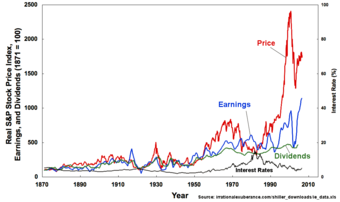
Stock Price Index Over Time
The securities trading markets have appreciated substantially in recent times, making the scale of investments (and subsequent reporting) more important than ever.
When considering the returns derived from these various investments, organizations and individuals must be aware of the reporting obligations in the country in which those securities are traded. Organizations like the IRS have a wide variety of taxation requisites depending upon different investment situations, and understanding these regulations is critical to ethical trading and adherence to legalities.
Reporting Obligations
Capital Gains
Most commonly, reporting of investments will fall under the reporting of capital gains. Both organizations and individuals must report any and all capital gains within a given time period. These capital gains are profits derived from the sale of investments, which is to say that existing investments where capital is still tied in the underlying asset it not taxable (though it must be reported on the balance sheet for organizations as assets).
When profits from short term investments are derived in a taxation period for an organization, this profit is reported on the income statement and taxed accordingly. Capital gains taxes can differ based on the duration and type of investment made, but for the sake of this discussion it is enough to understand that an existing investment is an asset on the balance sheet and profit from the trade of an investment should be reported as profit (or loss) on the income statement.
Potential Reductions and Deferrals
As with most regulatory environments, it is not a one size fits all model. There are various situations where capital gains taxes can be reduced through understanding the legislation and reporting accurately and strategically. A few examples of potential reductions or deferrals in capital gains reporting include:
- In some countries, specific industry investments receive tax breaks to stimulate economic growth. For example, an investment in new green technologies is often a source of potential tax break, as it is beneficial to the broader economy and world at large.
- Retirement investments are often tax free (until withdrawn) to stimulate responsible saving and retirement planning. This allows companies to accumulate interest on what would’ve been taxable income until the capital is removed from the account.
- The sale of an asset at a loss is often a tax deductible, as are other capital losses.
- Donations of assets or capital to charity are tax deductible in most situations.
- Occasionally, the acquisition of certain assets will have the value reevaluated. In such situations, the difference between the original price and the new price may be a source of tax deduction.
While there are countless other small legislative items which may indicate tax implications on capital gains, this gives a reasonable overview of the types of considerations accountants make when considering capital gains.
9.2.2: Dollar Returns
The dollar return is the difference between the final value and the initial value in nominal terms.
Learning Objective
Calculate an investment’s dollar return
Key Points
- Dollar returns do not take into account things like the time value of money or the time frame of the investment.
- In security markets, the dollar return of the security is the difference in the final market price and the market price at which it was purchased.
- Dollar returns are useful for determining the nominal amount that the firm’s assets will change.
Key Term
- return
-
Gain or loss from an investment.
The dollar return of a security is the difference between the initial and ending value.
Finding the dollar return for securities that trade in open markets is a matter of finding the difference in price from year to year. For example, consider in which a $100 security earns a stated return of 5% per year. At the end of year 1, it is worth $105, which is $5 more than $100 (its value at the beginning of year 1), so the dollar return is $5. The capital value at the end of year 2 is $110.25, which is $5.25 more than at the end of year 1, and $10.25 more than at the beginning of year 1. Therefore, the dollar gain is $10.25. This continues for each successive year.
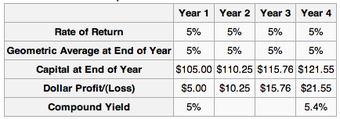
Dollar Profit/(Loss)
The dollar return is the difference in value from year to year, plus the previous dollar return.
The dollar return does not take into account things like the time value of money or how the amount of return earned per year; it is simply the difference in nominal values. This means that dollar returns can provide an incomplete picture if used incorrectly. For example, suppose an investor has two investment options, both of which promise a dollar return of $1,000,000. S/he cannot tell which option is better without knowing additional details such as the risk or how long it will take to realize the returns. If the first option has a $1,000,000 return over two years and the other has a $1,000,000 return over 10 years, the first option is clearly more attractive.
Dollar returns are valuable for comparing the nominal differences in investments. If two investments have similar profiles (risk, duration, etc.), than dollar returns is a useful way to compare them. The investor will always choose the option with the higher dollar return. Furthermore, the dollar return is useful because it provides an idea about how the assets of a firm will change. If a firm is looking for an additional $50,000 from investment, they will only accept investments with a $50,000 dollar return, regardless of the percent return.
9.2.3: Percentage Returns
Percentage returns show how much the value of the investment has changed in proportion to the size of the initial investment.
Learning Objective
Calculate an investment’s percentage return using CAGR
Key Points
- Total percentage returns divide the dollar returns by the initial value of the investment. This is also the return on investment (ROI).
- Annual returns show the percentage by which the value of the asset changes in each individual year.
- Average annual percentage returns can be calculated by dividing ROI by the number of years, or by other methods such as the compound annual growth rate (CAGR) or internal rate of return (IRR).
Key Terms
- compound annual growth rate
-
CAGR. A method for finding the average annual return of an investment.
- internal rate of return
-
IRR. The rate of return on an investment which causes the net present value of all future cash flows to be zero.
- return on investment
-
ROI. The dollar return of the investment divided by the initial value.
The conventional way to express the return on a security (and investments in general) is in percentage terms. This is because it does not only matter how much money was earned on the investment, it matters how much was earned in proportion to the cost.
There are two types of percentage returns: total and annual. Total returns calculate how much the value of the investment has changed since it was first purchased, while annual returns calculate how much the value changed each year. When the length of time of the investment is one year, the total and annual returns are equivalent.
Total Returns
The total percentage return is based off of the final value (Vf), the initial value (Vi), and all dividend payments or additional incomes (D). If the investment is a security such as a stock, the final value is the sales price, the initial value is the purchase price, and D is the sum of all dividends received.
This type of return is also called the return on investment (ROI), where the numerator is the dollar return.
Annual Returns
In , the ROI is calculated for each individual year by dividing the dollar return by the initial value of $1,000. To find the return for the security overall, simply sum the dollar returns and divide by the initial value. The ROI can be annualized by dividing by the number of years between the purchase and sale of the security. This is the arithmetic mean of the return.

Cash Flow Return
The ROI is the percentage return, and is calculated by dividing the dollar return by the initial value of the investment ($1,000).
However, this does not fully take into consideration compounding. To do so, analysts use other formulas, like the compound annual growth rate (CAGR):
In this case, the only variable that differs from the previous formula is t, which is the number of years between the beginning and end of the investment. CAGR is a way of measuring the return per year. It is widely used because it allows for the easy comparison of the growth rates of multiple investments.
Another common method for finding the annual return is to calculate the internal rate of return (IRR). Recall that the IRR is the discount rate at which the net present value (NPV) equals 0.
9.2.4: Historical Returns: Market Variability and Volatility
Markets and securities may follow general trends, but exogenous factors (such as macroeconomic changes) cause variability and volatility.
Learning Objective
Describe how historical returns can be used to predict future performance
Key Points
- Historical returns do not guarantee future returns.
- All markets have a degree of systemic risk which means that they have a risk of collapsing due to external factors. Companies are also interconnected, so the failure of one company can have far-reaching effects.
- “Animal spirits” describes general investor sentiment which can affect markets, even without changes in the underlying financials.
Key Terms
- systemic risk
-
The risk of collapse of an entire financial system or entire market.
- volatility
-
A quantification of the degree of uncertainty about the future price of a commodity, share, or other financial product.
- animal spirits
-
After Keynes (citation 1936, above), the emotional and intuitive factors that drive business decisions whether to make investment gambles.
Historical analysis of markets and of specific securities is a useful tool for investors, but it does not predict the future of the market. There are general trends and expectations of future behavior, but they are just generalizations. For example, the Dow Jones Industrial Average (DJIA) has generally followed an upward trend from 1900-2009 . However, an investor who looked at this graph in early 1929 and made the decision to invest because s/he would be guaranteed to make money was in for a shock when the market crashed in October 29, 1929. Past performance is not a guarantee of future performance.

DJIA 1900-2009
The Dow Jones Industrial Average has generally increased overall since 1900, but its past performance is not a guarantee of future performance.
Inherent in all markets is something called “systemic risk. ” Systemic risk is the risk of collapse of an entire financial system or entire market, as opposed to risk associated with any one individual entity, group, or component of a system. Macroeconomic forces, such as the Great Depression, affect the entire stock market and can’t be predicted from past market performance. The failure of one company affects all the companies who purchase from it or sell to it, which in turn affects all the companies that rely on them. These types of interlinkages are a cause of the overall market variability and volatility.
Furthermore, market variability and volatility can be the cause of what John Maynard Keynes called animal spirits. Animal spirits are the emotions felt by investors who affect markets. Expectations of investors affect how they act, which in turn affects the markets. If investors are feeling optimistic, for example, the market may go up, even without an improvement in the financials of the underlying companies.
Markets and stocks are affected by many factors beyond the information in their financial statements and past performance. Historical returns may provide an idea of the overall trend, but certainly are not enough to accurately predict future performance.
9.2.5: Calculating and Understanding Average Returns
Average returns are commonly found using average ROI, CAGR, or IRR.
Learning Objective
Differentiate between the different methods for calculating the average return of an investment
Key Points
- Average return on investment (ROI) is the arithmetic average of the total cash returns divided by the initial investment. It is useful for quick calculations and specific securities (such as bonds purchased at par), but does not account for compounding returns.
- Compound annual growth rate (CAGR) is derived from the future value formula with compounding interest. It accounts for compounding returns.
- Internal rate of return (IRR) is the discount rate at which the NPV equals 0. It is used because it allows for easy comparison between investment options and is easy to understand.
- For all three methods, the higher the average rate of return, the more attractive the investment is.
Key Term
- compounding returns
-
Returns earned on previous returns. Akin to compounding interest.
The average return of an investment can be calculated a number of ways. The three main methods are
- Return on investment (ROI)
- Compound annual growth rate (CAGR)
- Internal rate of return (IRR).
For all three methods, the higher the rate, the more desirable the investment.
ROI
To calculate the total ROI of an investment, simply divide the total dollar returns of the investment by the initial value. The average ROI is the arithmetic average: divide the total ROI by the number of periods. If the purchase of a stock led to an ROI of 15% over 5 years, the average ROI is 3% per year. This is a simple way to calculate the average return. It is useful for certain securities such as bonds. If the only source of return on a bond is the coupon payments, then this is an accurate method. A bond purchased at par that pays a 5% coupon per year, will have a return of 25% over 5 years. However, this is a very special case. Average ROI generally does not calculate the actual average rate of return, because it does not incorporate compounding returns. A stock that appreciates by 3% per year would not actually be worth 15% more over 5 years, because the gains compound.
CAGR
CAGR stands for compound annual growth rate. It is calculated by the following formula where Vf is the future value, Vi is the initial value, and t is the number of years:
CAGR, unlike average ROI, does consider compounding returns. CAGR is derived from the compounding interest formula, FV=PV(1+i)t, where PV is the initial value, FV is the future value, i is the interest rate, and t is the number of periods. The CAGR formula is what results when solving for i: the interest rate becomes CAGR, FV becomes Vf, PV becomes Vi, and the number of periods is generally assumed to be in years.
CAGR is very useful for finding the rate of return that the investment would have to earn every year for the life of the investment to turn the initial value into the future value over the given time frame.
IRR
The internal rate of return (IRR) is another commonly used method for calculating the average return . IRR is the discount rate at which the net present value (NPV) is equal to 0. Using IRR allows for easy comparison between investment options. It is also known as the effective interest rate.

Internal Rate of Return
The IRR is calculated by finding the discount rate at which the NPV of the investment equals 0.
9.3: Market Efficiency
9.3.1: Behavior of an Efficient Market
Efficient-market hypothesis (EMH) asserts that financial markets are informationally efficient and should therefore move unpredictably.
Learning Objective
Describe what an efficient market looks like
Key Points
- The efficient-market hypothesis (EMH) asserts that financial markets are “informationally efficient. ” As a result, one cannot consistently achieve returns in excess of average market returns on a risk-adjusted basis, given the information available at the time the investment is made.
- Historically, there was a very close link between EMH and the random-walk model and then the Martingale model. The random character of stock market prices was first modelled by Jules Regnault, a French broker, in 1863.
- The definitions for three forms of financial market efficiency: weak, semi-strong, and strong.
Key Term
- Martingale model
-
In probability theory, a martingale is a model of a fair game where knowledge of past events will never help to predict future winnings.
In finance, the efficient-market hypothesis (EMH) asserts that financial markets are “informationally efficient. ” As a result, one cannot consistently achieve returns in excess of average market returns on a risk-adjusted basis, given the information available at the time the investment is made.
There are three major versions of the hypothesis: “weak,” “semi-strong,” and “strong. ” The weak-form EMH claims that prices on traded assets (e.g., stocks, bonds, or property) already reflect all past publicly available information. The semi-strong-form EMH claims both that prices reflect all publicly available information and that prices instantly change to reflect new public information. The strong-form EMH also claims that prices instantly reflect even hidden or “insider” information. Critics have blamed the belief in rational markets for much of the late-2000’s financial crisis. In response, proponents of the hypothesis have stated that market efficiency does not mean having no uncertainty about the future. Market efficiency is a simplification of the world which may not always hold true. The market is practically efficient for investment purposes for most individuals.
Random-Walk Model
Historically, there was a very close link between EMH and the random-walk model and then the Martingale model. The random character of stock market prices was first modelled by Jules Regnault, a French broker, in 1863 and then by Louis Bachelier, a French mathematician, in his 1900 PhD thesis, “The Theory of Speculation. ” His work was largely ignored until the 1950’s; however, beginning in the 1930’s scattered, independent work corroborated his thesis. A small number of studies indicated that U.S. stock prices and related financial series followed a random walk model. Research by Alfred Cowles in the ’30s and ’40s suggested that professional investors were in general unable to outperform the market .
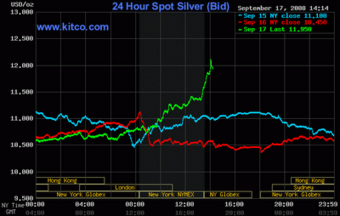
Random Walk
Stock market cannot be predicted.
Weak, Semi-strong, and Strong
The efficient-market hypothesis emerged as a prominent theory in the mid-1960’s. Paul Samuelson had begun to circulate Bachelier’s work among economists. In 1964 Bachelier’s dissertation along with the empirical studies mentioned above were published in an anthology edited by Paul Cootner. In 1965 Eugene Fama published his dissertation arguing for the random walk hypothesis, and Samuelson published a proof for a version of the efficient-market hypothesis. In 1970 Fama published a review of both the theory and the evidence for the hypothesis. The paper extended and refined the theory, included the definitions for three forms of financial market efficiency: weak, semi-strong, and strong.
It has been argued that the stock market is “micro efficient,” but not “macro inefficient. ” The main proponent of this view was Samuelson, who asserted that the EMH is much better suited for individual stocks than it is for the aggregate stock market. Research based on regression and scatter diagrams has strongly supported Samuelson’s dictum.
9.3.2: The Efficient Market Hypothesis
The EMH asserts that financial markets are informationally efficient with different implications in weak, semi-strong, and strong form.
Learning Objective
Differentiate between the different versions of the Efficient Market Hypothesis
Key Points
- In weak-form efficiency, future prices cannot be predicted by analyzing prices from the past.
- In semi-strong-form efficiency, it is implied that share prices adjust to publicly available new information very rapidly and in an unbiased fashion, such that no excess returns can be earned by trading on that information.
- In strong-form efficiency, share prices reflect all information, public and private, and no one can earn excess returns.
Key Terms
- technical analysis
-
A stock or commodity market analysis technique which examines only market action, such as prices, trading volume, and open interest.
- fundamental analysis
-
An analysis of a business with the goal of financial projections in terms of income statement, financial statements and health, management and competitive advantages, and competitors and markets.
- insider trading
-
Buying or selling securities of a publicly held company by a person who has privileged access to information concerning the company’s financial condition or plans.
The efficient-market hypothesis (EMH) asserts that financial markets are “informationally efficient. ” In consequence of this, one cannot consistently achieve returns in excess of average market returns on a risk-adjusted basis, given the information available at the time the investment is made.
There are three major versions of the hypothesis: weak, semi-strong, and strong.
- The weak-form EMH claims that prices on traded assets (e.g., stocks, bonds, or property) already reflect all past publicly available information.
- The semi-strong-form EMH claims both that prices reflect all publicly available information and that prices instantly change to reflect new public information.
- The strong-form EMH additionally claims that prices instantly reflect even hidden or “insider” information.
Weak-form efficiency
In weak-form efficiency, future prices cannot be predicted by analyzing prices from the past. Excess returns cannot be earned in the long run by using investment strategies based on historical share prices or other historical data. Technical analysis techniques will not be able to consistently produce excess returns, though some forms of fundamental analysis may still provide excess returns. Share prices exhibit no serial dependencies, meaning that there are no “patterns” to asset prices. This implies that future price movements are determined entirely by information not contained in the price series. Hence, prices must follow a random walk. This “soft” EMH does not require that prices remain at or near equilibrium, but only that market participants not be able to systematically profit from market “inefficiencies. ” However, while EMH predicts that all price movement (in the absence of change in fundamental information) is random (i.e., non-trending), many studies have shown a marked tendency for the stock markets to trend over time periods of weeks or longer and that, moreover, there is a positive correlation between degree of trending and length of time period studied (but note that over long time periods, the trending is sinusoidal in appearance). Various explanations for such large and apparently non-random price movements have been promulgated.
Semi-strong-form efficiency
In semi-strong-form efficiency, it is implied that share prices adjust to publicly available new information very rapidly and in an unbiased fashion, such that no excess returns can be earned by trading on that information. Semi-strong-form efficiency implies that neither fundamental analysis nor technical analysis techniques will be able to reliably produce excess returns. To test for semi-strong-form efficiency, the adjustments to previously unknown news must be of a reasonable size and must be instantaneous. To test for this, consistent upward or downward adjustments after the initial change must be looked for. If there are any such adjustments it would suggest that investors had interpreted the information in a biased fashion and, hence, in an inefficient manner.
Strong-form efficiency
In strong-form efficiency, share prices reflect all information, public and private, and no one can earn excess returns. If there are legal barriers to private information becoming public, as with insider trading laws, strong-form efficiency is impossible, except in the case where the laws are universally ignored. To test for strong-form efficiency, a market needs to exist where investors cannot consistently earn excess returns over a long period of time. Even if some money managers are consistently observed to beat the market, no refutation even of strong-form efficiency follows–with hundreds of thousands of fund managers worldwide, even a normal distribution of returns (as efficiency predicts) should be expected to produce a few dozen “star” performers.
9.3.3: Implications and Limitations of the Efficient Market Hypothesis
The limitations of EMH include overconfidence, overreaction, representative bias, and information bias.
Learning Objective
Discuss the limitations of the Efficient Market Hypothesis
Key Points
- Empirical evidence has been mixed, but has generally not supported strong forms of the Efficient Market Hypothesis.
- Speculative economic bubbles are an obvious anomaly in that the market often appears to be driven by buyers operating on irrational exuberance, who take little notice of underlying value.
- Any anomalies pertaining to market inefficiencies are the result of a cost benefit analysis made by those willing to incur the cost of acquiring the valuable information in order to trade on it.
- The financial crisis of 2007–2012 has led to renewed scrutiny and criticism of the hypothesis, claiming that belief in the hypothesis caused financial leaders to adopt a “chronic underestimation of the dangers of asset bubbles breaking”.
Key Terms
- information bias
-
Information bias is a type of cognitive bias, and involves distorted evaluation of information. Information bias occurs due to people’s curiosity and confusion of goals when trying to choose a course of action.
- efficient markets hypothesis
-
a set of theories about what information is reflected in securities trading prices
Investors and researchers have disputed the Efficient Market Hypothesis both empirically and theoretically. Behavioral economists attribute the imperfections in financial markets to a combination of cognitive biases such as overconfidence, overreaction, representative bias, information bias, and various other predictable human errors in reasoning and information processing. These have been researched by psychologists such as Daniel Kahneman, Amos Tversky, Richard Thaler, and Paul Slovic. These errors in reasoning lead most investors to avoid value stocks and buy growth stocks at expensive prices, which allow those who reason correctly to profit from bargains in neglected value stocks and the excessive selling of growth stocks.
Empirical evidence has been mixed, but has generally not supported strong forms of the Efficient Market Hypothesis. According to a publication by Dreman and Berry from 1995, low P/E stocks have greater returns. In an earlier paper Dreman also refuted the assertion by Ray Ball that these higher returns could be attributed to higher beta. Ball’s research had been accepted by Efficient Market theorists as explaining the anomaly in neat accordance with modern portfolio theory.
Speculative economic bubbles
Speculative economic bubbles are an obvious anomaly, in that the market often appears to be driven by buyers operating on irrational exuberance, who take little notice of underlying value. These bubbles are typically followed by an overreaction of frantic selling, allowing shrewd investors to buy stocks at bargain prices. Rational investors have difficulty profiting by shorting irrational bubbles because, as John Maynard Keynes commented, “markets can remain irrational far longer than you or I can remain solvent. ” Sudden market crashes, like the one that occurred on Black Monday in 1987, are mysterious from the perspective of efficient markets, but allowed as a rare statistical event under the Weak-form of EMH. One could also argue that if the hypothesis is so weak, it should not be used in statistical models due to its lack of predictive behavior.
Transaction costs
Further empirical work has highlighted the impact transaction costs have on the concept of market efficiency, with much evidence suggesting that any anomalies pertaining to market inefficiencies are the result of a cost benefit analysis made by those willing to incur the cost of acquiring the valuable information in order to trade on it. Additionally the concept of liquidity is a critical component to capturing “inefficiencies” in tests for abnormal returns. Any test of this proposition faces the joint hypothesis problem, where it is impossible to ever test for market efficiency, since to do so requires the use of a measuring stick against which abnormal returns are compared– in other words, one cannot know if the market is efficient if one does not know if a model correctly stipulates the required rate of return. Consequently, a situation arises where either the asset pricing model is incorrect or the market is inefficient, but one has no way of knowing which is the case.
Late 2000s financial crisis
The financial crisis of 2007–2012 has led to renewed scrutiny and criticism of the hypothesis. Market strategist Jeremy Grantham has stated flatly that the EMH is responsible for the current financial crisis, claiming that belief in the hypothesis caused financial leaders to have a “chronic underestimation of the dangers of asset bubbles breaking. ” Noted financial journalist Roger Lowenstein blasted the theory, declaring “the upside of the current Great Recession is that it could drive a stake through the heart of the academic nostrum known as the Efficient-Market Hypothesis. ” Former Federal Reserve chairman Paul Volcker chimed in, saying, “[it is] clear that among the causes of the recent financial crisis was an unjustified faith in rational expectations and market efficiencies. “
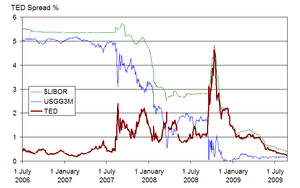
2008 Financial Crisis
The strong form of EMH is diminished by the 2008 crisis
The financial crisis has led Richard Posner, a prominent judge, University of Chicago law professor, and innovator in the field of Law and Economics, to back away from the hypothesis and express some degree of belief in Keynesian economics. Posner accused some of his Chicago School colleagues of being “asleep at the switch,” claiming that “the movement to deregulate the financial industry went too far by exaggerating the resilience– the self healing powers– of laissez-faire capitalism. ” Others, such as Fama himself, said that the hypothesis held up well during the crisis and that the markets were a casualty of the recession, not the cause of it. Despite this, Fama has conceded that “poorly informed investors could theoretically lead the market astray” and that stock prices could become “somewhat irrational” as a result.
Critics have suggested that financial institutions and corporations have been able to decrease the efficiency of financial markets by creating private information and reducing the accuracy of conventional disclosures, and by developing new and complex products which are challenging for most market participants to evaluate and correctly price.
9.4: Market Regulation
9.4.1: Securities Act of 1933
The Securities Act of 1933 ensures investors receive complete and accurate information before they invest.
Learning Objective
Describe how the Securities Act of 1933 regulates stock markets
Key Points
- The Act’s objectives are to provide investors with material financial and other corporate information about issuers of public securities.
- The primary purpose of the 1933 Act is to ensure that buyers of securities receive complete and accurate information before they invest.
- Among other things, registration forms call for: a description of the securities to be offered for sale; information about the management of the issuer; information about the securities (if other than common stock); and financial statements certified by independent accountants.
- Rule 144, promulgated by the SEC under the 1933 Act, permits, under limited circumstances, the sale of restricted and controlled securities without registration.
- Regulation S is a “safe harbor” that defines when an offering of securities is deemed to be executed in another country and therefore not be subject to the registration requirement under section 5 of the 1933 Act.
Key Terms
- private placements
-
Private placement (or non-public offering) is a funding round of securities which are sold not through a public offering, but rather through a private offering, mostly to a small number of chosen investors.
- SEC
-
The U.S. Securities and Exchange Commission (frequently abbreviated SEC) is a federal agency[2] which holds primary responsibility for enforcing the federal securities laws and regulating the securities industry, the nation’s stock and options exchanges, and other electronic securities markets in the United States.
The Securities Act of 1933 (also known as the ’33 Act) is essentially a consumer protection law for “retail” investors (i.e. not money managers, foundations, pensions, etc.)
Purpose
The Act’s objectives are to provide investors with material, financial, and other corporate information about issuers of public securities (i.e. stocks and bonds), and to prevent fraud in the offering of such securities. The primary purpose of the ’33 Act is to ensure that buyers of securities receive complete and accurate information before they invest.
Registration Process
Unless they qualify for an exemption, securities offered or sold to the public in the U.S. must be registered by filing a registration statement with the SEC. Although the law is written to require registration of securities, it is more useful as a practical matter to consider the requirement to be that of registering offers and sales. If person A registers a sale of securities to person B, and then person B seeks to resell those securities, person B must still either file a registration statement or find an available exemption.

US SEC
The U.S. Securities and Exchange Commission (frequently abbreviated SEC) is a federal agency, which holds primary responsibility for enforcing the federal securities laws and regulating the securities industry
Many transactions are exempt from regulation under the Securities Act. Section 4 of the Act limits its application to public offerings (according to SEC guidelines, more than 25 offerees) by issuers and their underwriters (i.e. investment banks). This means that the Act primarily applies to companies offering securities to the public, and not to transactions between investors or to sales of stock to small groups of investors (i.e. private placements. )
The prospectus, which is the document through which an issuer’s securities are marketed to a potential investor, is included as part of the registration statement. The SEC prescribes the relevant forms on which an issuer’s securities must be registered. Among other things, registration forms call for:
- a description of the securities to be offered for sale;
- information about the management of the issuer;
- information about the securities (if other than common stock); and
- financial statements certified by independent accountants.
For public offerings, the main requirement of the Securities Act is registration. An issuer must prepare an extensive statement describing the securities to be offered and detailing the nature of the issuer’s business. Once this statement is registered with and approved by the SEC, its data and forecasts are placed in a prospectus for potential investors. Any offering of the securities by the issuer or underwriter must thereafter be accompanied by the prospectus.
Rule 144
Rule 144, promulgated by the SEC under the 1933 Act, permits, under limited circumstances, the sale of restricted and controlled securities without registration. In addition to restrictions on the minimum length of time for which such securities must be held and the maximum volume permitted to be sold, the issuer must agree to the sale. If certain requirements are met, Form 144 must be filed with the SEC. Often, the issuer requires that a legal opinion be given indicating that the resale complies with the rule. The amount of securities sold during any subsequent three-month period generally does not exceed any of the following limitations:
- 1% of the stock outstanding
- the average weekly reported volume of trading in the securities on all national securities exchanges for the preceding four weeks
- the average weekly volume of trading of the securities reported through the consolidated transactions reporting system (NASDAQ)
- Notice of resale is provided to the SEC if the amount of securities sold in reliance on Rule 144 in any three-month period exceeds 5,000 shares or if they have an aggregate sales price in excess of $50,000. After one year, Rule 144(k) allows for the permanent removal of the restriction except as to ‘insiders’.
- In cases of mergers, buyouts or takeovers, owners of securities who had previously filed Form 144 and still wish to sell restricted and controlled securities must refile Form 144 once the merger, buyout, or takeover has been completed.
Regulation S
Regulation S is a “safe harbor” that defines when an offering of securities is deemed to be executed in another country and therefore not be subject to the registration requirement under section 5 of the 1933 Act. The regulation includes two safe harbor provisions: an issuer safe harbor and a resale safe harbor. In each case, the regulation demands that offers and sales of the securities be made outside the United States and that no offering participant (which includes the issuer, the banks assisting with the offer, and their respective affiliates) engage in “directed selling efforts. ” In the case of issuers for whose securities there is substantial U.S. market interest, the regulation also requires that no offers and sales be made to U.S. persons (including U.S. persons physically located outside the United States).
9.4.2: Securities Exchange Act of 1934
The Securities Exchange Act of 1934 is a law governing the secondary trading of securities, financial markets and their participants.
Learning Objective
Define how the Securities Exchange Act of 1934 regulates the US securities markets
Key Points
- The Securities Exchange Act of 1934 is a law governing the secondary trading of securities in the United States of America. The Act and related statutes form the basis for the regulation of the financial markets and their participants in the United States.
- One area subject to 34 Act regulation is the actual securities exchange: New York Stock Exchange, the American Stock Exchange, and regional exchanges like the Cincinnati Stock Exchange, Philadelphia Stock Exchange and Pacific Stock Exchange.
- The ’34 Act also regulates broker-dealers without a status for trading securities. A telecommunications infrastructure was developed to provide for trading without a physical location.
- In 1938 the Exchange Act was amended by the Maloney Act, which authorized the formation and registration of national securities associations to supervise the conduct of their members subject to the oversight of the SEC.
- In the last 30 years, brokers have created two additional systems for trading securities. The alternative trading system, or ATS, is a quasi exchange where stocks are commonly purchased and sold through a smaller, private network of brokers, dealers, and other market participants.
Key Term
- NASDAQ
-
The National Association of Securities Dealers Automated Quotations; this is an electronic stock market.
The Securities Exchange Act of 1934 (also called the Exchange Act, ’34 Act, or Act of ’34) is a law governing the secondary trading of securities, including stocks, bonds, and debentures, in the United States of America. It was a sweeping piece of legislation. The Act and related statutes form the basis for the regulation of the financial markets and their participants in the United States. The 1934 Act also established the Securities and Exchange Commission (SEC), the agency primarily responsible for enforcement of United States federal securities law.

Securities Exchange Act of 1934
Act of 1934 governs the secondary trading of securities.
While the Securities Act is very limited in scope, the Securities Exchange Act (also known as the Exchange Act or 1934 Act) is much broader. It regulates stock exchanges, brokers, dealers, and even private traders.
Companies raise billions of dollars by issuing securities in what is known as the primary market. In contrast with the Securities Act of 1933, which regulates these original issues, the Securities Exchange Act of 1934 regulates the secondary trading of those securities between persons often unrelated to the issuer, in most cases through brokers or dealers. Trillions of dollars are made and lost each year through trading in the secondary market.
Securities exchanges
One area subject to 34 Act regulation is the actual securities exchange — the physical place where people purchase and sell securities (stocks, bonds, notes of debenture). Some of the well known exchanges include the New York Stock Exchange, the American Stock Exchange, and regional exchanges like the Cincinnati Stock Exchange, Philadelphia Stock Exchange and Pacific Stock Exchange. At those places, agents of the exchange or specialists, act as middlemen for the competing interests to buy and sell securities. An important function of the specialist is to inject liquidity and price continuity into the market. Given that people come to the exchange to easily acquire securities or to easily dispose of a portfolio of securities, the specialist’s role is important to the exchange.
Securities associations
The ’34 Act also regulates broker-dealers without a status for trading securities. A telecommunications infrastructure was developed and allows for for trading without a physical location. Previously these brokers would find stock prices through newspaper printings and conduct trades verbally by telephone. Today, a digital information network connects these brokers. This system is called NASDAQ, standing for the National Association of Securities Dealers Automated Quotation System.
Self-regulatory organizations (SRO)
In 1938, the Exchange Act was amended by the Maloney Act, which authorized the formation and registration of national securities associations to supervise the conduct of their members subject to the oversight of the SEC. That amendment led to the creation of the National Association of Securities Dealers, Inc. – the NASD, which is a Self-Regulatory Organization (or SRO). The NASD had primary responsibility for the oversight of brokers and brokerage firms, and later, the NASDAQ stock market.
Other trading platforms
In the last 30 years, brokers have created two additional systems for trading securities. The alternative trading system, or ATS, is a quasi exchange where stocks are commonly purchased and sold through a smaller, private network of brokers, dealers, and other market participants. The ATS is different from exchanges and associations in that the volumes for ATS trades are comparatively low, and the trades tend to be controlled by a small number of brokers or dealers. ATS acts as a niche market, a private pool of liquidity. Reg ATS, an SEC regulation issued in the late 1990s, requires these small markets to 1) register as a broker with the NASD, 2) register as an exchange, or 3) operate as an unregulated ATS, staying under low trading caps.
Issuers
While the ’33 Act recognizes that timely information about the issuer is vital to effective pricing of securities, the Act’s disclosure requirement (the registration statement and prospectus) is a one-time affair. The ’34 Act extends this requirement to securities traded in the secondary market. Provided that the company has more than a certain number of shareholders and has a certain amount of assets (500 shareholders, above $10 million in assets, per sections 12, 13, and 15 of the Act), the ’34 Act requires that issuers regularly file company information with the SEC on certain forms (the annual 10-K filing and the quarterly 10-Q filing).
Antifraud provisions
While the ’33 Act contains an antifraud provision (Section 17), when the ’34 Act was enacted, questions remained about the reach of that antifraud provision and whether a private right of action—that is, the right of an individual citizen to sue an issuer of stock or related market actor, as opposed to government suits—existed for purchasers.
9.4.3: Securities Acts Amendments of 1975
The 1975 amendments are to establish a national market system for the nationwide clearance and settlement of securities transactions.
Learning Objective
Define how the Securities Act Amendments of 1975 regulate U.S. stock markets
Key Points
- The 1975 amendments, also called the National Exchange Market System Act, directed the securities and exchange commission to work with the industry toward establishing a national market system together with a system for the nationwide clearance and settlement of securities transactions.
- The National Market System (NMS) is the national system for trading equities in the United States.
- A national market system plan (or NMS plan) is a structured method of transmitting securities transactions in real-time.
- In 2005, the rules promoting the national market system were consolidated into REG NMS.
- The order protection rule has generated controversies since it requires traders to transact on a trading venue at the lowest price rather than on a venue that offers the quickest execution or the most reliability.
Key Terms
- settlement
-
Settlement of securities is a business process whereby securities or interests in securities are delivered, usually against (in simultaneous exchange for) payment of money, to fulfill contractual obligations, such as those arising under securities trades.
- clearance
-
In banking and finance, clearing denotes all activities from the time a commitment is made for a transaction until it is settled. Clearing is necessary because the speed of trades is much faster than the cycle time for completing the underlying transaction.
Example
- For example, if the best two quotes in one market are superior to the best quote in another market, a portion of an incoming market order may still trade at the inferior market at the inferior price even though the second best quote on the superior market is still available. If more than just the top of the book (the best quote) were protected by the order rule, the market order would have transacted at a superior price and the limit order offering the superior price would have transacted more quickly.
The 1975 amendments, also called the National Exchange Market System Act, directed the securities and exchange commission to work with the industry toward establishing a national market system together with a system for the nationwide clearance and settlement of securities transactions.

SEC
The amendments are direct SEC to enable the establishment of a National Market System.
National market system plan
A national market system plan (or NMS plan) is a structured method of transmitting securities transactions in real-time. In the United States, national market systems are governed by section 11A of the Securities Exchange Act of 1934.
In addition to processing the transactions themselves, these plans also show the price and volume data for these transactions. Information on each securities trade is sent to a central network at the Securities Industry Automation Corporation (SIAC) where it is then distributed and consolidated with other trades on the same “tape”.
Securities Industry Automation Corporation (SIAC)
The Securities Industry Automation Corporation (SIAC) is a subsidiary of the NYSE Euronext. Its purpose is to provide technical services for the exchanges themselves, members and other financial institutions. In this role, SIAC provides the computers and other systems required to run the exchanges. It also owns communication lines and hardware that provide real-time quotes and transaction information to all market participants from the Consolidated Tape/Ticker System (CTS), Consolidated Quotation System (CQS), and Options Price Reporting Authority (OPRA).
National Market System (NMS)
The National Market System (NMS) is the national system for trading equities in the United States.
Regulation NMS (or Reg NMS — Regulation National Market System) is a regulation promulgated and defined by the United States Securities and Exchange Commission (SEC) as “a series of initiatives designed to modernize and strengthen the national market system for equity securities. ” It was established in 2007 and seeks to foster both “competition among individual markets and competition among individual orders” in order to promote efficient and fair price formation across securities markets. In 1972, before the SEC began its pursuit of a national market system, the market for securities was quite fragmented. The same stock sometimes traded at different prices at different trading venues, and the NYSE ticker tape did not report transactions of NYSE-listed stocks that took place on regional exchanges or on other over-the-counter securities markets. This fragmentation made it difficult for traders to compare prices of stocks. In 1975, Congress authorized the SEC to facilitate a national market system.
Formation of Reg NMS
In 2005, the rules promoting the national market system were consolidated into REG NMS. Some of the more notable rules include:
- Order Protection (or Trade Through) Rule – provides intermarket price priority for quotations that are immediately and automatically accessible (Rule 611)
- Access Rule – addresses access to market data such as quotations (Rule 610)
- Sub-Penny Rule – establishes minimum pricing increments (Rule 612)
- Market Data Rules: a) Allocation amendment – institutes a new Market Data Revenue Allocation Formula, b) Governance amendment – creates advisory committees, c) Distribution and Display Rules – governing market data (Rule 600, 601 & 603).
The order protection rule has generated controversies since it requires traders to transact on a trading venue at the lowest price rather than on a venue that offers the quickest execution or the most reliability. Thus, some have described it as an improper government intervention into private business affairs. Defenders of the rule argue that it really just requires what brokers should be doing if they are acting in their customer’s best interests. Still, others have argued that the rule is too lax because it only protects the quotes at the top of the book.
9.4.4: Sarbanes–Oxley Act of 2002
The Sarbanes–Oxley Act is to set new or enhanced standards for all U.S. public company boards, management, and public accounting firms.
Learning Objective
Identify the responsibilities imposed on companies by the Sarbanes-Oxley Act of 2002
Key Points
- As a result of SOX, top management must now individually certify the accuracy of financial information. In addition, penalties for fraudulent financial activity are much more severe.
- SOX increased the independence of the outside auditors who review the accuracy of corporate financial statements, and increased the oversight role of boards of directors.
- The bill was enacted as a reaction to a number of major corporate and accounting scandals including those affecting Enron, Tyco International, Adelphia, Peregrine Systems, and WorldCom.
- Opponents claim it has reduced America’s international competitive edge against foreign financial service providers; Proponents say that SOX has been a “godsend” for improving the confidence of fund managers and other investors with regard to the veracity of corporate financial statements.
Key Terms
- conflicts of interest
-
A conflict of interest (COI) occurs when an individual or organization is involved in multiple interests, one of which could possibly corrupt the motivation for an act in the other.
- off-balance-sheet
-
Off-balance sheet (OBS), or Incognito Leverage, usually means an asset or debt or financing activity not on the company’s balance sheet.
- boards of directors
-
A board of directors is a body of elected or appointed members who jointly oversee the activities of a company or organization.
Example
- For example, Section 302 requires that the company’s “principal officers” (typically the Chief Executive Officer and Chief Financial Officer) certify and approve the integrity of their company financial reports quarterly.
The Sarbanes–Oxley Act of 2002
The Sarbanes–Oxley Act of 2002 is a federal law that set new or enhanced standards for all public company boards, management, and public accounting firms in the United States. It is also known as the Public Company Accounting Reform and Investor Protection Act (in the Senate) and Corporate and Auditing Accountability and Responsibility Act (in the House) and more commonly called Sarbanes–Oxley, Sarbox or SOX. It It is named after sponsors U.S. Senator Paul Sarbanes (D-MD) and U.S. Representative Michael G. Oxley (R-OH). As a result of SOX, top management must now individually certify the accuracy of financial information. In addition, penalties for fraudulent financial activity are much more severe. SOX also increased the independence of the outside auditors who review the accuracy of corporate financial statements, and increased the oversight role of boards of directors.

Senator Sarbanes and Representative Oxley
Senator Sarbanes and Representative Oxley sponsored the 2002 Act.
The bill was enacted as a reaction to a number of major corporate and accounting scandals including those affecting Enron, Tyco International, Adelphia, Peregrine Systems, and WorldCom. These scandals, which cost investors billions of dollars when the share prices of affected companies collapsed, shook public confidence in the nation’s securities markets.
In response to the perception that stricter financial governance laws are needed, SOX-type laws have been subsequently enacted in Japan, Germany, France, Italy, Australia, India, South Africa, and Turkey.
Public Company Accounting Oversight Board (PCAOB)
Title I provides independent oversight of public accounting firms providing audit services (auditors). It also creates a central oversight board tasked with registering auditors, defining the specific processes and procedures for compliance audits, inspecting and policing conduct and quality control, and enforcing compliance with the specific mandates of SOX.
Auditor Independence
Title II consists of nine sections and establishes standards for external auditor independence, to limit conflicts of interest. It also addresses new auditor approval requirements, audit partner rotation, and auditor reporting requirements. It restricts auditing companies from providing non-audit services (e.g., consulting) for the same clients.
Corporate Responsibility
Title III consists of eight sections and mandates that senior executives take individual responsibility for the accuracy and completeness of corporate financial reports. It enumerates specific limits on the behaviors of corporate officers and describes specific forfeitures of benefits and civil penalties for non-compliance.
Enhanced Financial Disclosures
Title IV describes enhanced reporting requirements for financial transactions, including off-balance-sheet transactions, pro-forma figures and stock transactions of corporate officers. It requires internal controls for assuring the accuracy of financial reports and disclosures, and mandates both audits and reports on those controls.
Analyst Conflicts of Interest
Title V consists of only one section, which includes measures designed to help restore investor confidence in the reporting of securities analysts. It defines the codes of conduct for securities analysts and requires disclosure of knowable conflicts of interest.
Commission Resources and Authority
Title VI defines practices to restore investor confidence in securities analysts. It also defines the SEC’s authority to censure or bar securities professionals from practice and defines conditions under which a person can be barred from practicing as a broker, advisor, or dealer.
Studies and Reports
Title VII consists of five sections and requires the Comptroller General and the SEC to perform various studies and report their findings.
Corporate and Criminal Fraud Accountability
Title VIII describes specific criminal penalties for manipulation, destruction or alteration of financial records or other interference with investigations, while providing certain protections for whistle-blowers.
White Collar Crime Penalty Enhancement
Title IX increases the criminal penalties associated with white-collar crimes and conspiracies. It recommends stronger sentencing guidelines and specifically adds failure to certify corporate financial reports as a criminal offense.
Corporate Tax Returns
Title X consists of one section. Section 1001 states that the Chief Executive Officer should sign the company tax return.
Corporate Fraud Accountability
Title XI consists of seven sections. Section 1101 recommends a name for this title as “Corporate Fraud Accountability Act of 2002”. It identifies corporate fraud and records tampering as criminal offenses and joins those offenses to specific penalties. It also revises sentencing guidelines and strengthens their penalties. This enables the SEC to resort to temporarily freezing transactions or payments that have been deemed “large” or “unusual”.
Debate continues over the perceived benefits and costs of SOX. Opponents of the bill claim it has reduced America’s international competitive edge against foreign financial service providers, saying SOX has introduced an overly complex regulatory environment into U.S. financial markets. Proponents of the measure say that SOX has been a “godsend” for improving the confidence of fund managers and other investors with regard to the veracity of corporate financial statements.
9.4.5: Global Research Settlement
The Global Settlement was an enforcement agreement to address issues of conflict of interest within the SEC and other big investment companies.
Learning Objective
Describe how the Global Research Settlement addressed conflicts of interest in the market
Key Points
- The Global Settlement was an enforcement agreement reached on April 28, 2003 between the SEC, NASD, NYSE, and ten of the United States’s largest investment firms to address issues of conflict of interest within their businesses.
- The central issue at hand that had been previously decided in court was the conflict of interest between the investment banking and analysis departments of ten of the largest investment firms in the United States.
- As part of the settlement decision published on December 20, 2002, several regulations designed to prevent abuse stemming from pressure by investment bankers on analysts to provide “favorable” appraisals were instantiated.
- Other than these regulatory actions, the firms involved in the settlement were also to pay fines to their investors, to fund investor education, and to pay for independent third-party market research.
Key Terms
- IPOs
-
An initial public offering (IPO) or stock market launch is a type of public offering where shares of stock in a company are sold to the general public, on a securities exchange, for the first time.
- conflict of interest
-
A conflict of interest (COI) occurs when an individual or organization is involved in multiple interests, one of which could possibly corrupt the motivation for an act in the other.
The Global Settlement was an enforcement agreement reached on April 28, 2003 between the Securities and Exchange Commission (SEC), National Association of Securities Dealers (NASD), New York Stock Exchange (NYSE), and ten of the United States’s largest investment firms. The agreement was meant to address issues of conflict of interest within their businesses.
The central issue at hand that had previously been decided in court was the conflict of interest between the investment banking and analysis departments of ten of the largest investment firms in the United States. The investment firms involved in the settlement had all engaged in actions and practices that had aided and abetted the inappropriate influence of their research analysts by their investment bankers seeking lucrative fees. A typical violation addressed by the settlement was the case of CSFB and Salomon Smith Barney, which were alleged to have engaged in inappropriate spinning of “hot” IPOs and issued fraudulent research reports in violation of various sections within the Securities Exchange Act of 1934. Similarly, UBS Warburg and Piper Jaffray were alleged to have received payments for investment research without disclosing such payments in violation of the Securities Act of 1933.
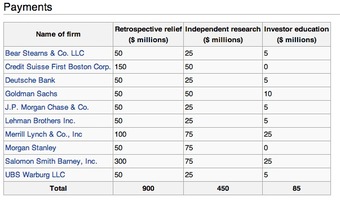
Payments
The table shows the payments of each company
Enforcement actions
As part of the settlement decision published on December 20, 2002, several regulations designed to prevent abuse stemming from pressure by investment bankers on analysts to provide “favorable” appraisals were put in place. Most importantly, these firms would have to literally insulate their banking and analysis departments from each other physically and with Chinese walls. In addition, budget allocation to management in research departments will be independent of investment departments. Research analysts will also be prohibited from going on pitches and roadshows with bankers during advertising and promotion of IPOs. Similarly, the Global Settlement also increased the IPO “quiet period” from 25 days to 40 days. Finally, research analysts’ historical ratings must be disclosed and made available.
Other than these regulatory actions, the firms involved in the settlement were required to pay fines to their investors, to fund investor education, and to pay for independent third-party market research. A total fine of $1.435 billion was assessed and is described in the table below.
Chapter 8: Introduction to Risk and Return
8.1: Understanding Return
8.1.1: Expected Return
In probability theory, the expected value of a random variable is the weighted average of all possible values.
Learning Objective
Calculate the expected return of an investment portfolio
Key Points
- In order to make investment decisions, investors often estimate the expected return of a potential investment.
- Expected value is a concept that the helps investors assess the value of a potential investment based on different future outcomes and a probability for each outcome.
- Once you have categories for different scenario’s, along with probabilities and returns in each scenario, you then calculate your expected return by multiplying each probability by it’s respective outcome and adding these all together.
Key Terms
- expected value
-
The expected value of a random variable is the weighted average of all possible values that this random variable can take on.
- expected return
-
The expected return of a potential investment can be computed by computing the product of the probability of a given event and the return in that case and adding together the products in each discrete scenario.
Imagine that your friend offered you a chance to play his game of dice. You have to pay $1 to play and he keeps your money if you roll anything other than a 6. Would you play it? If you answered “it depends”, you are ready to learn about expected value.
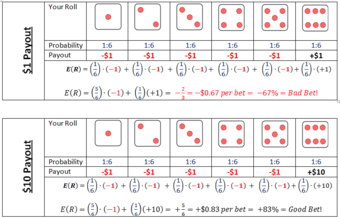
Care to roll the dice?
Is a bet that doesn’t always pay out, but pays out big when it does a good bet? Is playing the lottery a good bet? Would it be a good bet if tickets were only $0.10 instead of $1.00?
If your friend told you he would pay you $1 every time you roll a 6, you would be crazy to play. If your friend told you he would pay you $10 every time you roll a 6, you would be crazy not to play.
Expected value is calculated by multiplying the probability that something will happen by the resulting outcome if it happens. In the two cases described above, there are 5 ways to lose and only 1 to win. But in scenario 1, you can expect to lose $0.67 or 67% every time you bet, and in scenario two, you can expect to win $0.83 or 83% with each bet. This is a confusing topic in statistics and finance because on any given roll, there are only two outcomes — win or lose — and neither outcome involves $0.67 or $0.83 increments.
But to understand expected value, you have to imagine playing a particular game hundreds of times. If you were to sit at your friend’s apartment and play the dice game 100 times, imagine what your bottom line would be. Even though you lose most of the time you roll in the 2nd scenario, when you win, you win big. After 100 games, you could expect to be up ($0.83 per roll) x (100 rolls) = $83. If you were foolish enough to play the game in the first scenario 100 times you would expect to be down $67 to your friend.
In finance, evaluating your expected return is important, but never as simple as evaluating a game of dice. Imagine that you are going to buy a house a year from today and you have $20,000 saved for that investment. Because you are smart enough to be using a free online text book, you are probably savvy enough to know that you can invest the money for a year and get some return on it. You are considering investing that money into stock of a Ski/Snowboard Mountain in Colorado, so you go talk to your snowboarding friend who lives on your floor of the dorm. He tells you that any given winter could be hella gnarly, totally chillax or wicked bogus, depending on how much it snows. You start doing some research, and you realize that how the stock has performed has everything to do with how much it snows. You create three different categories based on snowfall and label them hella gnarly (HG), totally chillax (TC) and wicked bogus (WB). In recent HG winters, those with over 20 feet of annual snowfall, the stock has averaged a 25% annual return. In recent TC winters, those with between 10 feet and 20 feet of snowdrop throughout the season, the stock has averaged 10%. In WB winters, those with less than 10 feet of total snowdrop, the stock has averaged -20%. Ok, so now what? Should you buy the stock?
If you said “it depends,” that’s a good answer. Being as smart as you are, you investigate recent weather patterns and you decide that there is a 25% chance of an HG year, a 60% chance of a TC year and only a 15% chance of a WB winter. You understand that past performance is never a guarantee of future results, but still you are happy with your research and you project an expected rate of return for your $20,000. How will it do?
Based on your research, you realize that the stock has an expected return that is calculated thus:
E[R]= (ProbabilityHG)x(ReturnHG)+(ProbabilityTC)x(ReturnTC)+(ProbabilityWB)x(ReturnWB) = (0.25)(25%) + (0.60)(10%)+(0.15)(-20%) = 6.25% + 6% + -3% = 9.25%
If you were to invest the stock in the ski mountain, year after year, and your research proves accurate, you could expect to receive an average of 9.25% return each year. That is your expected return.
8.1.2: Variance
Variance is a statistical concept describing the range around expected return within which an investment return can be reasonably expected to fall.
Learning Objective
Explain the importance of a stock’s variance and standard deviation
Key Points
- Any investment should be made taking time considerations and risk tolerance into account. If there is a specific deadline for when the investment needs to be matured (i.e. to generate retirement income, pay for a down payment on a house, college tuition) then caution is required.
- Three different asset classes — stocks, bonds, money markets — range from aggressive, to moderate, to conservative. An investment that is aggressive typically features a higher expected return, but also a higher variance.
- Variance is calculated by calculating an expected return and summing a weighted average of the squared deviations from the mean return.
Key Terms
- standard deviation
-
The standard deviation of an investment is obtained by taking the square root of the variance. It has a more straightforward meaning than variance. It tells you that in a given year, you can expect an investment’s return to be one standard deviation above or below the average rate of return.
- variance
-
In finance, variance is a term used to measure the degree of risk in an investment. It is calculated by finding the average of the squared deviations from the mean rate of return.
Introducing Variance
In probability theory and statistics, the variance is a measure of how far a set of numbers is spread out. It is one of several descriptors of a probability distribution, describing how far the numbers lie from the mean (expected value).
Understanding the concept of variance along with three typical asset classes — money market, bonds, stocks — can help you build a portfolio for any investor. Money market investments are very safe, they almost never go in the red, but they also don’t pay high returns. Stocks are on the opposite end of the spectrum, going back and forth between red and black from year to year frequently, but over longer periods of time they usually pay higher premiums. Bonds are somewhere in the middle. They are safer than a stock, but riskier than a money market and their average returns reflect that.
This table shows how to calculate the variance of an investment outcome .

How much do investors want to pay to have to take the good with the bad?
Calculating variance is a 3 step process once expected return has been calculated. Calculate deviations from mean (blue), square the deviations (yellow), multiply the squared deviation by its original probability (orange). Get brownie points by taking the square root of that number and interpret its meaning in the form of a sentence.
You may not need to calculate variance yourself, but you should still notice how we got it. In the figure, we started with three scenarios and a probability (P) and return (R) associated with each. We did some math and ended up using the two blue columns to get the yellow one. Then we multiplied the two yellow columns to get the orange one. We get the variance from adding up the numbers in the orange column. Of the three numbers, we add (62, 0.34, and 128). Two are very big and one is very small. The small number comes from the TC scenario where the stock returns 10%, which is very close to our expectation of 9.25%. The bigger numbers come from winters that are extreme — when the stock performs way above 9.25% (HG) or way below it (WB). The standard deviation can be read as a percentage. It means that, even though we can expect an average of 9.25% return on our stock over the course of 50 years, if we take any given year out and look at its performance, it is likely be somewhere within 13.81% above or below that figure.
Variance in Relation to Expected Return
In the discussion of expected return, we concluded that, based on your research, you can expect the Ski/Snowboard Resort in Colorado to have an expected return of 9.25% based on three distinct weather outcomes. However, if you invest your $20,000 in that company and expect to have $21,850 after a year, you must remember that this isn’t a dice game that you can play over and over again. There will only be one result in this case and at the end of it, you have to make a down payment on a house. Is this a good investment idea?
What if your bid for a house won’t be accepted unless you can put at least $20,000 down? There is an 85% chance that the winter is either hella gnarly (HG) or totally chillax (TC), and in either of those cases you will still have over $20,000 to make a down payment. There is also a 15% chance that the year ends up being wicked bogus (WB), and if that is the case you will lose 20% or $4,000 of your initial investment. Now you have $16,000 and all of a sudden you are thinking tree fort. Let’s compare that investment to a CD at a bank that pays 3.25% no matter how much snow falls this winter. You can have an investment that is federally insured to pay you $20,650 one year from today and you can be assured to have enough to make a down payment on your house.
If you can let that $20,000 investment sit for 10 years before you need it, there is a much better chance that you will end up in the black (experiencing a profit) than in the red (experiencing a loss). A 30 year old with a 401K can be much more aggressive in his portfolio than a 65 year old who will be retiring in one year can. Every portfolio should be modeled with time-frame and risk tolerance considerations. It would be just as foolish for the 65 year old to be investing in aggressive stocks as it would for the 30 year old to buy conservative CD’s in his retirement account.
8.2: Portfolio Considerations
8.2.1: Portfolio Diversification and Weighting
Weighting is the percent allocation a particular investment type receives within a portfolio.
Learning Objective
Describe how weighting a portfolio is important for diversification
Key Points
- Diversification is the idea of spreading a portfolio across different classes of investments with a target weight attached to each class.
- Modern portfolio theory is the idea that for any investment objective, there is an optimal mix of investments that can maximize expected return subject to a specific risk threshold.
- Systemic risk is the risk that applies to a particular market or industry. It cannot be diversified away. Specific risk is the risk that applies to one particular investment within a market and it can be diversified away.
Key Term
- systemic risk
-
Refers to the risk common to all securities which cannot be diversified away.
In finance, there are two types of risk – systemic risk and specific risk. Systemic risk is essentially the risk that the markets will experience in a downturn and all investments within that market will be negatively affected. It is difficult to reduce with diversification. Specific risk is the risk associated with one individual security. It can be diversified away. Let’s go back to our Ski/Snowboard example.
Let’s say that you pick one resort to invest in, and cross your fingers hoping for a huge snowdrop this winter. It turns out that the winter sets records for snowdrop across the state of Colorado and as an industry, the resorts turn record profits. Unfortunately, your snowboard friend didn’t tell you that the resort you picked still hasn’t upgraded to the high-speed chairlifts, and they also don’t plow their roads very often. It turns out that while all the other mountains were turning huge profits, your investment actually lost 10%. The risk associated with the one mountain is called “specific risk. ” The risk of bad weather, in this example, is systemic risk. If you had taken your money and divided it up across all of the ski resorts in Colorado, you would be up 15%, but because you happened to pick the one bad egg, you lost money.
This example explains why investors are often choosing mutual funds and exchange traded funds (ETFs) over individual stocks and bonds. Mutual funds and ETF’s invest in underlying pools of investments specific to a particular investment objective. These objectives can range from specific to one particular industry to something that achieves a balanced portfolio of blended assets.
The idea of eliminating risk by spreading investments across pools of underlying stocks and bonds is called “diversification. ” A diversified portfolio spreads investments across all asset classes with a weighting system that takes time frame and risk tolerance into account. The “weight” is the proportion of that portfolio assigned to one category. In our example. we talked about diversifying away the risks of slow chair lifts but in reality, there are many more aspects to diversification. Look at the pie chart below. How many pairs of antonyms can you find?
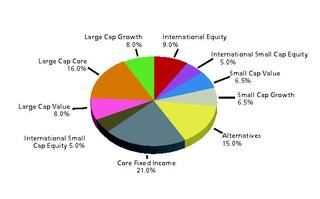
Diversified Portfolio
Asset classes and their weightings for a particular portfolio
8.2.2: Implications for Expected Returns
The expected return of a diversified portfolio is the expected return of each of its underlying investments times the weight the investment receives.
Learning Objective
Calculate the expected returns of an investment portfolio
Key Points
- Asset allocation is a theory of designing a portfolio that achieves a weighting scheme with a target mix of different asset classes that is suitable to the time frame and risk tolerance of the investor.
- The principals that support the theory of asset allocation are the cyclical nature of investments within a particular class of assets and weaker or even negative correlations that often exist across asset classes.
- When you re-balance your portfolio after it has deviated from the original target mix, you are selling classes that have relatively appreciated in order to buy those which have relatively depreciated.
- If you believe that markets go in cycles, you should believe in selling assets that have relatively appreciated and buying those which have relatively depreciated.
Key Term
- Strategic Asset Allocation
-
The primary goal of a strategic asset allocation is to create an asset mix that will provide the optimal balance between expected risk and return for a long-term investment horizon.
Asset allocation is the theory that any portfolio should have a set of target weights for different asset classes based on time frame and risk tolerance. There are two key principals at work in this theory. The first is that everything goes in cycles and the second is that often when one things is ebbing, the other is flowing. Let’s make this very simple and say that bonds return 4% in a bad year, 6% in an average year, and 8% in a good year, and stocks return -5% in a bad year, 10% in an average year, and 15% in a good year.
Stock have cycles and when stocks do well, bonds are more likely to do poorly and vice versa. Let’s say we have a portfolio of $100,000 that has a target mix of 60% stocks and 40% fixed income and, therefore, has $60,000 in stocks and $40,000 bonds. Stocks have a good year and bonds have a bad one, and now we have $69,000 invested in stocks and $41,600 in bonds. At this point, we have a total portfolio of $110,600 and an asset mix of roughly 62% stocks and 38% bonds. We began with a target mix of 60-40 but since the equity market fared better than fixed-income market, we are a little off-balance. So how do we fix that? We could sit and wait and watch what happens, or we could shift $2,640 from our equity position to a fixed-income position. Remember, things go in cycles, so we expect that if stocks do well relatively to bonds that sometime in the future, bonds will do well relative to stocks. By shifting $2,640 from our equity position to our fixed-income position, we are essentially selling stocks after they have appreciated (at a high) and buying bonds after they have failed to appreciate (at a low). Look at how the different asset mixes fare, based on a 10-year period that is consistent with historical averages.
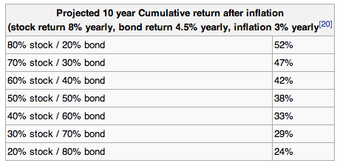
Average Returns for Different Weighting Schemes
Different returns are expected for different asset allocations given historical averages
Assuming rebalancing, the
expected return
of a diversified portfolio is simply the expected return of each of its underlying investments times the allocation weight the investment receives.
The theory can feature different strategies, including strategic asset allocation, tactical asset allocation, and others, but the ideas are the same as the implications for return. A portfolio should consist of a variety of classes of assets to take advantage of zero and negative correlations between those classes, and it should be designed to achieve a target mix of assets that are rebalanced when one grows in relation to another.
8.2.3: Implications for Variance
A diversified portfolio containing investments with small or negative correlation coefficients will have a lower variance than a single asset portfolio.
Learning Objective
Describe how a portfolio is diversified to minimize variance
Key Points
- Portfolio managers often target a mix of assets across different categories that maximize potential return and limit specific risk.
- Portfolio managers choose from many more classes of assets than the two that have been used primarily for this chapter.
- With historical data, powerful software and a proficient financial analyst, a correlation matrix can be produced that helps portfolio managers make investment decisions that will limit the portfolio’s overall risk and exposure to market downturns.
Key Term
- Correlation Matrix
-
A matrix that shows a set of correlations between two random variables over a number of observations.
A primary reason for a diversified asset allocation is the fact that markets often sway away from each other, and it can be beneficial to have a portion of your holdings invested in bonds in years when stocks do badly. As you can see from the graphic below, there is still considerable risk to an investor who is heavily invested in stocks, even with a blended portfolio.
Remember that in 2000, the Nasdaq lost 39.28% of its value (4,069.31 to 2,470.52) and in 2001, the Nasdaq lost 21.05% of its value (2,470.52 to 1,950.40). Had your portfolio consisted of a set of stocks that approximated the Nasdaq index, you would have lost roughly 52% of your portfolio’s value (from 4069.31 to 1950.40).
In actuality, as mentioned before, there are more than two basic asset classes. Here are some examples of the the types of assets that may be included in a diversified strategy:
- cash and cash equivalents (e.g., deposit account , money market fund )
- fixed interest securities, such as bonds : investment-grade or junk (high yield); government or corporate; short-term, intermediate, long-term; domestic, foreign, or emerging markets ; or convertible security
- stocks : value, dividend, growth, sector specific, or preferred (or a “blend” of any two or more of the preceding); large-cap versus mid-cap, small-cap or micro-cap; public equities versus private equities , domestic, foreign (developed), emerging or frontier markets
- commodities : precious metals, broad basket, agriculture, energy, etc.
- commercial or residential real estate (also REITs )
- collectibles, such as art, coins, or stamps
- insurance products (an annuity , a life settlement , a catastrophe bond , personal life insurance products, etc.)
- derivatives , such as long-short or market neutral strategies, options , collateralized debt, and futures
- foreign currency
- venture capital, leveraged buyout, merger arbitrage, or distressed security funds
A fundamental justification for asset allocation (or Modern Portfolio Theory) is the notion that different asset classes offer returns that are not perfectly correlated, hence diversification reduces the overall risk in terms of the variability of returns for a given level of expected return. Asset diversification has been described as “the only free lunch you will find in the investment game”. Academic research has painstakingly explained the importance of asset allocation and the problems of active management (see academic studies section below). Although risk is reduced as long as correlations are not perfect, it is typically forecast (wholly or in part) based on statistical relationships (like correlation and variance) that existed over some past period. Expectations for return are often derived in the same way.
A diversified portfolio containing investments with small or negative correlation coefficients will have a lower variance than a similar portfolio of one asset type. This is why it’s possible to reduce variance without compromising expected return by diversifying.
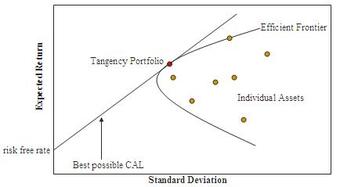
Illustration of Modern Portfolio Theory
Diversifying asset classes can reduce portfolio variance without diminishing expected return
8.3: The Impact of News of Expected Returns
8.3.1: Surprises and Returns
Surprise announcements can trigger a chain of events that affect the stock price of a particular company by changing investor expectations.
Learning Objective
Describe how a surprise announcement can influence a stock’s price
Key Points
- Surprise announcements that come from a company, its competition, or a supplier or customer can affect the long run value of a stocks and bonds related to that company.
- These announcements will often concern earnings, stages in a product development cycle (FDA approval of a drug) or corporate structure changes (the acquisition of a competitor) and can move a company’s outlook positively or negatively.
- When the news is generally seen as positive, a company’s equity and debt become more valuable on the secondary market, and its stock price will rise and the effective yield on its debt instruments will fall.
Key Term
- mergers and acquisitions
-
Mergers and acquisitions (M&A) is an aspect of corporate strategy, corporate finance, and management dealing with the buying, selling, dividing, and combining of different companies and similar entities that can help an enterprise grow rapidly in its sector or location of origin, or a new field or new location, without creating a subsidiary, other child entity, or using a joint venture.
Surprise announcements can trigger a chain of events that affect the stock price of a particular company, competitors and other companies that might be suppliers to or customers of the primary company.
Announcements of Mergers and acquisitions (M&A) are a frequent type of surprise announcements. Mergers and acquisition is a category of announcement that deals with corporate structure. When the announcement is publicly made, analysts use that information to factor into the company’s long run market outlook. A merger or an acquisition could signal to an analyst that one particular company is financially weak, and it could downgrade its long run outlook for that company. Alternatively, an M&A announcement could also signal to analysts that a company has a chance to increase its market share and henceforth its profits. These announcements typically make the biggest splash in a top-heavy industry, such as automobiles, pharmaceuticals, or healthcare, with a few strong players dominating a market that is researching, developing, and innovating new products.
Other announcements that can have a variety of impacts on asset valuation can come in the form of a major court decision, news of development of new research, and innovation, FDA approval of a new drug or a new cheap source of raw materials. Any of this news has the potential to impact a particular company and, in some cases, competition, suppliers, and customers of that company. In many cases, there will be signals that analysts pick up on ahead of time. Investors who are actively making investment decisions based on a particular company or within a particular industry need to be aware of how a surprise announcement might affect their investment.
Fixed-income market participants also make forecasts on the long-run health of a company to project the likelihood an issuer of debt might default. A company’s instruments are subject to move in the event of an aforementioned announcement or if a private rating agency (Standard and Poors or Moody’s) changes its outlook on their debt. If a news announcement is seen as positive for a company, its fixed-income instruments might seem more creditworthy, its bonds will rise in price, and its yield will decline. The inverse is also true.
Take a look at the creditworthiness ratings of different countries by Standard and Poors.

World countries Standard & Poor’s ratings
An example of the credit ratings prescribed by Standard & Poor’s as a result of their respective long-term liability analysis for debt issued at the national government level. Countries issue debt to build national infrastructure. Look how expensive it is to raise capital for such projects based on geographic region.
8.3.2: Announcements, News, and Returns
The Value of a Company.
Learning Objective
Describe how analysts use announcements, news, and returns to evaluate stock
Key Points
- A company that is publicly traded must announce its earnings reports quarterly. When the report matches analysts’ expectations, the stock’s price will not be greatly affected. When it announces a report that is unexpected, it can affect the stock price of a competitor or supplier as well.
- Beta is a metric used to signal the risk in a particular stock. Stocks with high beta values fluctuate more on a day-to-day basis than those with lower beta values.
- Analysts constantly assess the health of public companies to assess the value of its equity and debt instruments, and their outlook affects stock and bond prices in secondary markets.
Key Term
- beta
-
In finance, the Beta (β) of a stock or portfolio is a number describing the correlated volatility of an asset in relation to the volatility of the benchmark that said asset is being compared to.
The words stock and equity are used interchangeably, because a stock is reflective of a piece of ownership in a company. In general, investors buy stocks for two reasons: because they expect the company to grow its product and market share over time (growth) or because they feel that the company is undervalued based on its current stock price. Analysts may research a stock from a fundamental or a technical lens.
Fundamental analysis involves analyzing a company’s financial statements and health, its management and competitive advantages, and its competitors and markets . Technical analysts study the patterns and price fluctuations and attempt to forecast the direction of prices through the study of past market data, primarily price, and volume. A stock’s price is essentially determined by the buying and selling decisions of fundamental and technical analysts, who often manage large sums of money and have access to broad pools of data. Some stocks tend to fluctuate more than others on a day-to-day basis, and the metric called Beta describe’s the variance of a stocks day to day price. Stocks that tend to experience larger swings have higher beta values and expose owners to more specific risk.
In order for a company to be publicly traded on an exchange, it must comply with the regulations of that exchange board (NYSE or NASDAQ). Public investors are entitled to complete, accurate, and timely financial information about their investments. Companies generally announce updated financial figures on a quarterly basis. These figures include their current revenues, expenses and profits, and investors use this information to assess the company’s financial health. For most established companies, these reports are consistent and predictable and barely affect a stock’s price. Macy’s may announce higher profits in quarter 4 than quarter 3, but its price might not move, because analysts expected that Christmas would bring additional sales based on past data.
When a company announces its earnings as higher or lower than expected, the stock may experience a sudden shift in value. A higher than expected profit may come from increased revenues or decreased expenses. If a growing company announces higher than expected profits because of decreased expenses, it signals to investors that the company has found a cheaper way to produce its good. That could in turn affect the expected returns of a competitor’s stock, either positively or negatively, depending on how analysts forecast the effect. The announcement of higher than expected sales from Ford could affect its stock price significantly, and it could set into motion a chain of events. If analysts believe that the trend is based on a shift away from public transportation, it could raise the price of GM, Toyota, and maybe even Chevron. If Nvidia, a company who produces micro-processors for smart phones, announces higher than expected profits on reduced production costs, it might not only cause their stock to spike, but it could lead to a decrease in the price of the stock of their primary competition, Intel.
In general, fluctuations in one stock will often lead to fluctuations in another stock. There are times when the markets are relatively stable and those when it is relatively volatile. Consider the image below. The correlation of 0.769 suggests that the volatility of the stock market in one month is very highly correlated to that in the previous month.
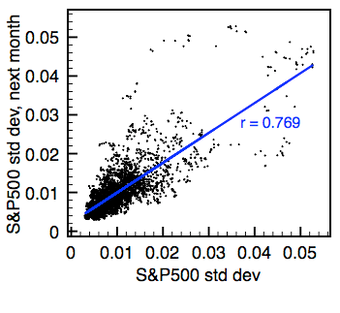
Volatility begets volatility
Data shown is from the period of Jan. 1990-Sep. 2009. Volatility is measured as the standard deviation of S&P 500 one-day returns over a month’s period.
8.4: Risk
8.4.1: Types of Risk
There are many types of financial risk, including asset-backed, prepayment, interest rate, credit, liquidity, market, operational, foreign, and model risk.
Learning Objective
Classify different securities by the types of financial risk associated with the investment opportunity
Key Points
- Financial risk is associated to the chances that an investor might lose value in an investment. It is separated into different sources of decline.
- Often the risks interact with each other and ultimately shock causes panic. Many of the worst market crashes have been a result of widespread speculation and not the devaluation of that asset itself.
- In the market crash of 2008, investors feared that some home owners would default. It triggered a chain of events that shocked the whole world and left many people in bad financial situations.
Key Term
- Variable Rate Mortgage
-
A variable-rate mortgage, adjustable-rate mortgage (ARM), or tracker mortgage is a mortgage loan with the interest rate on the note periodically adjusted based on an index which reflects the cost to the lender of borrowing on the credit markets.
The term “financial risk” is broad, but can be broken different categories to understand it better.
Types of Financial Risk
Asset-backed risk affects investments in asset-backed securities such as home loans. In order to finance home sales, banks issue bonds that serve as a debt obligation to its buyer. The buyer of the debt is essentially receiving the interest from the bank that the home-buyer is paying to it.
Prepayment risk is the risk that the buyer goes ahead and pays off the mortgage. Therefore, the buyer of the bond loses the right to the buyer’s interest payments over time.
Interest rate risk refers an asset whose terms can change over time, such as a Variable Rate Mortgage payment.
Credit risk or default risk, is the risk that a borrower will default (or stop making payments).
Liquidity risk is the risk that an asset or security cannot be converted into cash in a timely manner. Some investments (i.e. stocks) can be sold immediately at the current market rate and others (i.e. houses) are subject to a much higher degree of liquidity risk.
Market risk is the term associated with the risk of losing value in an investment will lose value because of a decline in the market.
Operational risk is another type of risk that deals with the operations of a particular business. If you are invested in the Boston Red Sox, your operational risk might include the chance that starting pitchers and recent acquisitions won’t perform, that your manager will turn the clubhouse into a mess, or that ownership will not be able to execute a long term strategy. Any of these risks might result in decreased revenues from ticket sales.
Foreign investment risk involves the risk associated with investments in foreign markets.
Model risk involves the chances that past models, which have been used to diversify away risk, will not accurately predict future models.
Example
A recent phenomenon that applies the concepts of these risks and how they interact with each other happened in 2008 when the housing market crashed. Can you find an example of each form of risk here?
Leading up to the crisis, many people received loans to buy houses which they really couldn’t afford. The mortgages often featured variable rate annuities, meaning that the interest rate terms of the mortgage started low and increased over time. Over the past 20 year period, house prices had risen constantly and investors assumed the trend would continue. Buyers worried about an adjustment to their interest rate, and all of a sudden a 1500 monthly payment became 2000. When interest rates climbed 2 percentage points and the mortgage climbed to $2000, some owners had to default (stop making payments) . They were promised that their investment would appreciate in value and they would be able to refinance it. The home loans were packaged and shipped off to investors all over the world in the form of complex investment vehicles. They seemed rewarding and highly safe at first, but then a few started breaking down. By now, these vehicles had made their way all the way around the world. When some investors defaulted, the world realized there were no mechanics around to fix these vehicles. After a few vehicles broke down, no one wanted to buy them, leading to the worst crash across world markets since 1929.
8.4.2: Measuring Risk
The higher the risk undertaken, the more ample the expected return and the lower the risk, the more modest the expected return.
Learning Objective
Calculate the risk of a portfolio using computational methods
Key Points
- The general progression in the risk-return spectrum is: short-term debt, long-term debt, property, high-yield debt, and equity.
- When a firm makes a capital budgeting decision, they will wish, as a bare minimum, to recover enough to pay the increased cost of goods due to inflation.
- Risk aversion is a concept based on the behavior of firms and investors while exposed to uncertainty to attempt to reduce that uncertainty.
- Beta is a measure firms can use in order to determine an investment’s return sensitivity in relation to overall market risk.
Key Terms
- systematic risk
-
The risk associated with an asset that is correlated with the risk of asset markets generally, often measured as its beta.
- inflation
-
An increase in the general level of prices or in the cost of living.
Risk and Return Considerations
Risk refers to the variability of possible returns associated with a given investment. Risk, along with the return, is a major consideration in capital budgeting decisions. The firm must compare the expected return from a given investment with the risk associated with it. Higher levels of return are required to compensate for increased levels of risk. In other words, the higher the risk undertaken, the more ample the return – and conversely, the lower the risk, the more modest the return.
This risk and return tradeoff is also known as the risk-return spectrum. There are various classes of possible investments, each with their own positions on the overall risk-return spectrum. The general progression is: short-term debt, long-term debt, property, high-yield debt, and equity. The existence of risk causes the need to incur a number of expenses. For example, the more risky the investment the more time and effort is usually required to obtain information about it and monitor its progress. Moreover, the importance of a loss of X amount of value can be greater than the importance of a gain of X amount of value, so a riskier investment will attract a higher risk premium even if the forecast return is the same as upon a less risky investment. Risk is therefore something that must be compensated for, and the more risk the more compensation is required.
When a firm makes a capital budgeting decision, they will wish, as a bare minimum, to recover enough to pay the increased cost of investment due to inflation. Thus, inflation is a pivotal input in a firm’s cost of capital. However, since interest rates are set by the market, it happens frequently that they are insufficient to compensate for inflation.
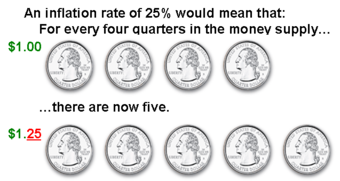
Inflation
Inflation is a rise in the general level of prices of goods and services in an economy over a period of time.
Risk aversion also plays an important role in determining a firm’s required return on an investment. Risk aversion is a concept based on the behavior of firms and investors while exposed to uncertainty to attempt to reduce that uncertainty. Risk aversion is the reluctance to accept a bargain with an uncertain payoff rather than another bargain with a more certain, but possibly lower, expected payoff. For example, a risk-averse investor might choose to put his or her money into a bank account with a low but guaranteed interest rate, rather than into a stock that may have high expected returns, but also involves a chance of losing value. Risk aversion can be thought of as having three levels:
- Risk-averse or risk-avoiding
- Risk-neutral
- Risk-loving or risk-seeking
Beta is a measure firms can use in order to determine an investment’s return sensitivity in relation to overall market risk. Beta describes the correlated volatility of an asset in relation to the volatility of the benchmark that said asset is being compared to. This benchmark is generally the overall financial market and is often estimated via the use of representative indices, such as the S&P 500. Beta is also referred to as financial elasticity or correlated relative volatility, and can be referred to as a measure of the sensitivity of the asset’s returns to market returns, its non-diversifiable risk, its systematic risk, or market risk. Higher-beta investments tend to be more volatile and therefore riskier, but provide the potential for higher returns. Lower-beta investments pose less risk, but generally offer lower returns.
8.5: Implications Across Portfolios
8.5.1: Calculating Expected Portfolio Returns
A portfolio’s expected return is the sum of the weighted average of each asset’s expected return.
Learning Objective
Calculate a portfolio’s expected return
Key Points
- To calculate the expected return of a portfolio, you need to know the expected return and weight of each asset in a portfolio.
- The figure is found by multiplying each asset’s weight with its expected return, and then adding up all those figures at the end.
- These estimates are based on the assumption that what we have seen in the past is what we can expect in the future, and ignores a structural view on the market.
Key Term
- weighted average
-
In statistics, a weighted average is an average that takes each object and calculates the product of its weight and its figure and sums all of these products to produce one average. It is implied that all the individual weights add to 1.
Let’s say that we have a portfolio that consists of three assets, and we’ll call them Apples, Bananas, and Cherries. We decided to invest in all three, because the previous chapters on diversification had a profound impact on our investment strategy, and we now understand that diversifiable risk doesn’t pay a risk premium, so we try to eliminate it.

A Fruitful Portfolio
How would you calculate the expected return on this portfolio?
The return of our fruit portfolio could be modeled as a sum of the weighted average of each fruit’s expected return. In math, that means:
Where A stands for apple, B is banana, C is cherry and FMP is farmer’s market portfolio. W is weight and E(RX) is the expected return of X. A good exercise would be to calculate this figure on your own, then look below to see if you completed it accurately.
Here’s what you should get:
In reality, a portfolio is not a fruit basket, and neither is the formula. A math-heavy formula for calculating the expected return on a portfolio, Q, of n assets would be:
What does this equal?
Remember that we are making the assumption that we can accurately measure these outcomes based on what we have seen in the past. If you were playing roulette at a casino, you may not know if red or black (or green) is coming on the next spin, but you could reasonably expect that if you bet on black 4000 times in a row, you’re likely to get paid on about 1900 of those spins. If you go to Wikipedia, you can review a wide variety of challenges to this model that have very valid points. Remember, the market is random: it is not a roulette wheel, but that might be the best thing we have to compare it to.
8.5.2: Portfolio Risk
The risk in a portfolio is measured as the amount of variance that investors can expect based on historical data.
Learning Objective
Calculate a portfolio’s variance
Key Points
- Portfolios that are efficient investments are those that effectively diversify the underlying risk away and price their investment efficiently.
- Portfolio risk takes into account the risk and weight of each individual position and also the co-variances across different positions.
- To calculate the risk of a portfolio, you need each asset’s variance along with a matrix of cross-asset correlations.
Key Terms
- portfolio
-
The group of investments and other assets held by an investor.
- Co-Variance
-
In probability theory and statistics, co-variance is a measure of how much two random variables change together.
- risk
-
The potential (conventionally negative) impact of an event, determined by combining the likelihood of the event occurring with the impact, should it occur.
Portfolio Risk
An investor can reduce portfolio risk by holding combinations of instruments which are not perfectly positively correlated (correlation coefficient). In other words, investors can reduce their exposure to individual asset risk by holding a diversified portfolio of assets. Diversification may allow for the same portfolio expected return with reduced risk.
Three assets (apples, bananas, and cherries) can be thought of as a bowl of fruit. The index is a a fruit basket. A full fruit basket probably has 10 or 15 different fruits, but my bowl will be efficient as much as its statistical parameters (risk and return) mimic those of the whole basket. In this unit, we are talking about calculating the risk of a portfolio. In addition, we can extend the implications made by the security market line theory from individual assets to portfolios. How does my bowl of fruit compare to the whole basket and how does that compare to other bowls out there?
Calculating Portfolio Risk
To calculate the risk in my bowl, we need a little more background information on fruit markets. First, we are going to need the variance for each fruit. Remember that the standard deviation answers the question of how far do I expect one individual outcome to deviate from the overall mean. And variance is that number squared. Mathematically, the formula is:
It is the expected value of the difference between the individual return in a given day (R) and the average outcome average return over a year (E(R)).
In order to calculate the variance of a portfolio of three assets, we need to know that figure for apples, bananas, and cherries, and we also need to know the co-variance of each. Co-variances can be thought of as correlations. If every time bananas have a bad day, so do apples, their co-variance will be large. If bananas do great half of the time when cherries do bad and bananas do terrible the other half, their co-variance is zero. If there is zero correlation among all three fruits, we have cut our risk in thirds by owning all three, but if they are perfectly correlated, we haven’t diversified away any of our risk.
In reality, they are probably positively correlated, since they are all fruits, but not at all perfectly. Apples and bananas grow in different climates so their performance may be a result of weather patterns in either region. Apples may be a substitute for cherries when cherries are expensive. The overall risk of the portfolio would take into account three individual variances and three co-variances (apples-bananas, apples-cherries, and bananas-cherries) and it would reduce the overall portfolio to the degree that they are uncorrelated.
The formula to compute the co-variance between returns on X and Y:
This means what do I expect to see, in a given time period, when I multiply how much X returned off its average performance from how much Y returned off its average. But notice how it could be positive or negative. And if X tends to be up when Y is down, that would make them two good hedges. And it can be shown that:
From co-variance, we get correlation coefficients:
In finance and statistics, the greek letter rho squared represents variance.
So now that we have figures to help us measure the risk and reward of our individual fruit bowl, we can go look at historical figures to determine the expected returns and the risk of the index that comprises the entire fruit basket industry. If our portfolio of investments has diversified away as much risk as is possible given the costs of diversifying, our portfolio will be attractive to investors. If our bowl does not diversify away enough risk, it will not lie on the Security Market Line for those who we are trying to recruit into buying our portfolio.
The same principles that were applied to individual investments in the Understanding the SML section can be applied to the market for portfolio investments. If an institutional investor, such as a city pension fund, looked at two portfolios with identical returns and different risks, they would choose the portfolio that minimized its risk. Thus the only portfolios that are efficient investments are those that effectively diversify the underlying risk away and price their investment efficiently .

Variance of any portfolio
The formula shows that the overall variance in a portfolio is the sum of each individual variance along with the cross-asset correlations.
8.5.3: Beta Coefficient for Portfolios
A portfolio’s Beta is the volatility correlated to an underlying index.
Learning Objective
Calculate a portfolio’s beta
Key Points
- In individual stocks, a beta coefficient compares how much a particular stock fluctuates in value on a day-to-day basis.
- A beta coefficient for a portfolio of assets measures how that portfolio value changes compared to a benchmark, like the S&P 500. A value of 1 suggests that it fluctuates as much as the index and in the same direction.
- A beta coefficient of less than 1 suggests a portfolio that fluctuates less than the benchmark. A negative beta is an indication that a portfolio moves in the opposite direction of its benchmark.
Key Term
- Normalized variable
-
In statistics, a normalized variable is one that is calculated using a ratio of itself and some benchmark figure. Normalized figures tend to be smaller than the original values.
In this section, we will discuss the idea of calculating a Beta coefficient to help investors measure the risk-reward trade-off for a blended pool of investments.
In this case, it is important to remember that a portfolio may represent the seller side of the market and the buyer can be thought of an institutional investor or a mutual fund. A portfolio’s Beta is the volatility correlated to an underlying index. If we think of the S&P 500 as the index, a portfolio that fluctuates identically to the market has a Beta of 1. What would the following portfolios have for Beta values?

Calculating Beta
Two hypothetical portfolios; what do you think each Beta value is?
Do you have an answer? Beta is a normalized variable, which means that it is a ratio of two variances, so you have to compare the volatility of returns to the benchmark volatility. Portfolio A has a direct relationship with the S&P 500 – it is scaled by three times each day. When the market is up 2%, it is up 6%. Thus, the portfolio would have a Beta value of 3. Portfolio B is a different situation; it is also directly proportional, but in the negative direction. Every time the market is up 1%, the portfolio is down half a percent. The Beta for this portfolio, when compared with the S&P 500 benchmark, would be -0.5. A Beta of zero in this situation doesn’t necessarily mean a risk free asset, it simply means that it is not correlated with the benchmark.
In reality, the numbers would rarely work out this cleanly, but this is a good model to demonstrate some key concepts. A pension fund that seeks to maximize its reward and limit its risk might be interested in each of these portfolios. If you invested equal amounts in each portfolio, it would leave you over-exposed to the market because it would have a Beta of 1.5. But let’s say you have $300,000 to invest; you could put that in a fund that is indexed to the S&P 500 and is perfectly correlated with it.
Every time the S&P gains 1%, your fund nets you 100,000 in fund A and S Misplaced &3,000 and your position in fund B pays you 2,000, which is less damage than you would have suffered on your position in the S&P index fund. On days when the S 3,000 and your fund A position loses 2,000 and your upside is limited by the same amount, your downside is reduced.
A pension fund is a good example of an institutional client that could extend the principles of diversification to a pool of blended portfolios. A city with an aging workforce needs to be protected from downside risk. It is the same principle as an employee approaching retirement; it can afford to have a heavier position in the S&P 500 if it has a position in portfolio B.
8.6: Diversification
8.6.1: Impact of Diversification on Risk and Return: Unsystematic Risk
In general, diversification can reduce risk without negatively impacting expected return.
Learning Objective
Describe unsystemic risk
Key Points
- Diversification is not putting all your eggs in one basket.
- Diversification relies on the lack of a tight positive relationship among the assets’ returns, and works even when correlations are near zero or somewhat positive.
- The debate over active vs passive management is one that takes on the limits to diversification.
Key Term
- Unsystematic risk
-
Unsystematic or diversifiable risk is a term given to the portion of risk in a portfolio that can be diversified away by holding a pool of individual assets.
Did your grandmother ever warn you not to put all your eggs in one basket? Did you know what she was talking about? The implication is obvious. If you put all your eggs in one basket, and that basket breaks, you are stuck with nothing to fry up into an omelet.
Grandma wasn’t telling you to grow up and be an omelet chef, she was actually giving you some sage advice that applies to your future as a portfolio manager. We have talked about diversification previously, and this section will follow from that. Remember, we talked about every particular investment having an expected return and a variance. If you are managing a pool of assets, you want to get positive returns without being in danger of “losing your shirt. ” The probability that one stock goes belly up is much higher than that the whole stock market does. In finance, systematic risk is the term associated with risk that can be diversified away by investing in a broader pool of assets.
Diversification relies on the lack of a tight positive relationship among the assets’ returns, and works even when correlations are near zero or somewhat positive. On the flip-side, hedging is the tactic that relies on negative correlations among assets. Diversification comes with a cost associated with it, and some might point out that it is possible to over-diversify. The idea is that you can only diversify away so much risk, that the marginal returns on each new asset are decreasing, and each transaction has a cost in terms of a transaction fee and also research costs. At some point, it just isn’t worth it anymore. The risk that can be diversified away is called “unsystematic risk” or “diversifiable risk. “
Some investors like to call themselves fans of active or passive management. In fact, two of the biggest mutual fund managers–Fidelity and Vanguard–take opposite stances on this issue and use it as a selling point to customers. Proponents of passive management say the market knows best, and they seek a portfolio that has an underlying pool that mimics a benchmark index (think S&P 500). The other guys–active managers–believe that their fundamental analysis yields them a competitive advantage. They might decide Microsoft’s stock is underpriced based on changing demographics to the labor supply in Seattle, or they might decide that political stability has improved emerging markets in Sub-Saharan Africa but the yield on their bonds hasn’t taken that into account. This debate is all held on the margins. Research has shown that there is a clear advantage in any portfolio to hold at least 30 different positions.
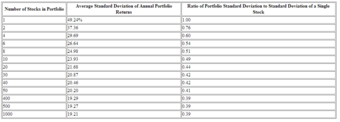
An empirical example relating diversification to risk reduction
In 1977 Elton and Gruber worked out an empirical example of the gains from diversification. Their approach was to consider a population of 3,290 securities available for possible inclusion in a portfolio, and to consider the average risk over all possible randomly chosen n-asset portfolios with equal amounts held in each included asset, for various values of n. Their results are summarized in the following table. It can be seen that most of the gains from diversification come for n≤30.
8.6.2: Impact of Diversification on Risk and Return: Systematic Risk
Systematic risk is intrinsic to the market, and thusly diversification has no effect on its presence in investments.
Learning Objective
Describe how systemic risk influences the stock market
Key Points
- Diversification is a technique for reducing risk that relies on the lack of a tight positive relationship among the returns of various types of assets.
- The role of diversification is to narrow the range of possible outcomes.
- Unsystematic risk does not factor into an investment’s risk premium, since this type of risk can be diversified away.
Key Term
- systematic risk
-
systematic or non-diversifiable risk is a term given to the portion of risk in a portfolio that cannot be diversified away by holding a pool of individual assets and therefore commands a return in excess of the risk-free-rate.
Recall that previously we talked about the security market line and the implication that investors require more compensation for extra risk. One might pay the same amount for a safe investment as for an investment carrying more risk; however, the riskier investment will, in theory, provide a higher return. This is the principle behind the security market line . Diversification is a technique for reducing risk that relies on the lack of a tight positive relationship among the returns of various types of assets. By diversifying a portfolio of assets, an investor loses the chance to experience a return associated with having invested solely in a single asset with the highest return. On the other hand, the investor also avoids experiencing a return associated with having invested solely in the asset with the lowest return — sometimes even becoming a negative return. Thus, the role of diversification is to narrow the range of possible outcomes.
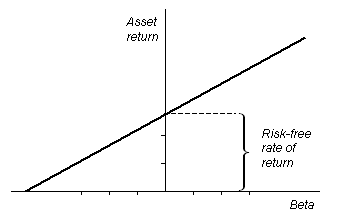
The Security Market Line
Diversification theory says that the only risk that earns a risk premium is that which can’t be diversified away.
As a result, the portion of risk that is unsystematic — or risk that can be diversified away — does not require additional compensation in terms of expected return. For example, consider the case of an individual who buys 50 corporate bonds from a single company. The individual receives a certain yield based on the purchase price. However, if unexpected business risks lead to liquidity problems, the company might go bankrupt and default on its loans. In such a case, the investor will lose the entirety of the investment. Conversely, if the investor buys a single bond from 50 different corporations who have similar credit ratings, then one instance of insolvency will have a far less drastic effect on the investor’s portfolio.
Now, imagine that these 50 corporations are all given a lesser credit rating because of the risk of their overall market segment. In this case, the individual is still at risk to lose some or all of the initial investment. This type of risk cannot be diversified away, and is referred to as systematic risk. This is the portion of risk that pays the risk premium, because the risk associated with this particular segment of the market is more tightly linked to the risk of the market as a whole. This risk is present regardless of the amount of diversification undertaken by an investor.
8.7: Understanding the Security Market Line
8.7.1: Expected Risk and Risk Premium
Overall riskiness of an asset is composed of its own individual risk (beta) along with its risk in relation to the market as a whole.
Learning Objective
Use a stock’s beta to estimate a stock’s daily growth or decline.
Key Points
- In return for undertaking risk, investors expect to be compensated in such as a way as to reasonably reward them.
- Systemic risk is the risk associated with an entire financial system or entire market. It cannot be diversified away.
- Unsystematic risk is risk to which only specific classes of securities or industries are vulnerable, and with proper grouping of assets it can be reduced or even eliminated.
- Beta is a number describing the correlated volatility of an asset in relation to the volatility of the benchmark that said asset is being compared to — usually the market as expressed in an index.
- The term risk premium refers to the amount by which an asset’s expected rate of return exceeds the risk-free interest rate.
Key Terms
- Risk free rate
-
Risk-free interest rate is the theoretical rate of return of an investment with no risk of financial loss.
- treasury bill
-
Treasury bills (or T-Bills) mature in one year or less. They do not pay interest prior to maturity; instead they are sold at a discount of the par value to create a positive yield to maturity.
A certain amount of risk is inherent in any investment. Risk can be defined, generally, as the potential that a chosen action or activity (including the choice of inaction) will lead to a loss or an undesirable outcome. The notion of risk implies that a choice having an influence on the outcome exists. More specifically to finance, risk can be seen as relating to the probability of uncertain future events. In return for undertaking risk, investors expect to be compensated in such as a way as to reasonably reward them. This is a central them in the subject of finance. In the financial realm, two types of risk exist: systematic and unsystematic.
Systemic risk is the risk associated with an entire financial system or entire market. This type of risk is inherent in all marketable securities and cannot be diversified away. On the other hand, unsystematic risk is risk to which only specific classes of securities or industries are vulnerable. This type of risk is uncorrelated with broad market returns, and with proper grouping of assets can be reduced or even eliminated. Because of this characteristic, investors are not rewarded for taking on unsystematic risk.
Systematic risk can be understood further using the measure of Beta. This is a number describing the correlated volatility of an asset in relation to the volatility of the benchmark that said asset is being compared to — usually the market as expressed in an index.

Beta
Beta is a measure that relates the rate of return of an asset, ra, with the rate of return of a benchmark, rb.
Values of Beta can be interpreted using the following information:
- Betas less than 0: Asset generally moves in the opposite direction as compared to the index.
- Betas equal to 0: Movement of the asset is uncorrelated with the movement of the benchmark.
- Beta between 0 and 1: Movement of the asset is generally in the same direction as, but less than the movement of the benchmark.
- Beta equal to 1: Movement of the asset is generally in the same direction as, and about the same amount as, the movement of the benchmark.
- Beta greater than 1: Movement of the asset is generally in the same direction as, but more than, the movement of the benchmark.
Risk Premium
The term risk premium refers to the amount by which an asset’s expected rate of return exceeds the risk free rate. The difference between the return of an asset in question and that of a risk-free asset — for instance, a US Treasury bill — can be interpreted as a measure of the excess return required by an investor on the risky asset. The risk premium, along with the risk-free rate and the asset’s Beta, is used as an input in popular asset valuation techniques, such as the Capital Asset Pricing Model.
8.7.2: Defining the Security Market Line
The security market line displays the expected rate of return of a security as a function of systematic, non-diversifiable risk.
Learning Objective
Describe the Security Market Line
Key Points
- The security market line is the theoretical line on which all capital investments lie. Investors want higher expected returns for more risk.
- On a graph, the line has risk on its horizontal axis (independent variable) and expected return on the vertical axis (dependent variable).
- Assuming a linear relationship between risk and return, the assumption is that the y-intercept is the return on a risk-free investment (the risk free rate), and the slope is the premium on risk in terms of expected returns.
- Given two investments with the same expected return, investors would always choose less risk. Someone with opposite preferences might better be called a gambler.
Key Terms
- market risk premium
-
the amount by which expected rate of return of the exchange system exceeds the risk-free interest rate
- market risk
-
the potential for loss due to movements in prices in a system of exchange
- line of credit
-
source of debt extended to a government, business or individual by a bank or other financial institution
- diversifiable risk
-
the potential for loss which can be removed by investing in a variety of assets
- security market line
-
Security market line (SML) is the representation of the capital asset pricing model. It displays the expected rate of return of an individual security as a function of systematic, non-diversifiable risk (its beta).
- beta
-
Average sensitivity of a security’s price to overall securities market prices.
The security market line, also known as the “characteristic line”, is the graphical representation of the capital asset pricing model. It is a hypothetical construct based on a world of perfect information. In the absence of perfect information, we can more or less assume historical data will give us an accurate expectation of what kind of returns and risk to expect with a particular investment of capital. The security market line graphs the systematic, non-diversifiable risk (stated in terms of beta) versus the return of the whole market at a particular time, and shows all risky marketable securities. The security market line is defined by the equation:

The equation that defines the security market line.
Look at the equation and remember that old formula of a line: y = mx + b. In this case it looks rearranged, like y = b + mx, but the real question is what do the slope and y-intercept actually represent?
The Y-intercept of the SML is equal to the risk-free interest rate. Recall that the risk-free interest rate is the theoretical rate of return of an investment with no risk of financial loss. When used in portfolio management, the SML represents the investment’s opportunity cost — i.e., investing in a combination of the market portfolio and the risk-free asset. All the correctly priced securities are plotted on the SML. The assets that lie above the line are undervalued because for a given amount of risk, they yield a higher return. The assets below the line are overvalued because for a given amount of risk, they yield a lower return.
The slope of the SML is equal to the market risk premium and reflects the risk return trade off at a given time. The idea of a security market line follows from the ideas asserted in the last section, which is that investors are naturally risk averse, and a premium is expected to offset the volatility of a risky investment. In a perfect world, with perfect information, any capital investment is on the security market line. The idea of a security market line is important for understanding the capital asset pricing model. Let’s look at the line again:
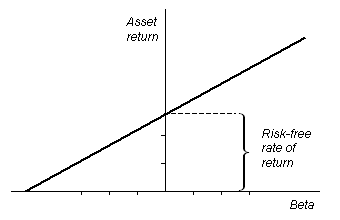
The Security Market Line
This is an example of a security market line graphed. The y-intercept of this line is the risk-free rate (the ROI of an investment with beta value of 0), and the slope is the premium that the market charges for risk.
8.7.3: Impact of the SML on the Cost of Capital
The plotted location of an instrument on the SML has consequences on its price, return, and cost of capital it contributes to a firm.
Learning Objective
Describe the impact of the SML on determining the cost of capital
Key Points
- The security market line is a hypothetical concept that suggests that investors require compensation in the form of expected returns for the risk the investment exposes them to.
- A capital investment below the security market wouldn’t be efficiently priced to the buyer of the investment. A higher return or lower price would be required, both increasing the cost of capital.
- A capital investment above the security market line wouldn’t be efficiently priced for the seller or whomever raises the capital. A lower return or higher price would be necessary to justify this cost of capital for the company.
Key Term
- capital asset pricing model
-
In finance, the capital asset pricing model (CAPM) is used to determine a theoretically appropriate required rate of return of an asset, if that asset is to be added to an already well-diversified portfolio, given that asset’s non-diversifiable risk.
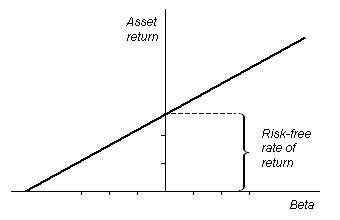
The Security Market Line
The location of a financial instrument above, below, or on the security market line will lead to consequences for a company’s cost of capital.
The security market line is a graphical representation of the capital asset pricing model that illustrates the idea that investments are priced efficiently based on the expected return and beta-value (risk). Companies often turn to capital markets in order to generate funds — using the issuance of either debt or equity. The cost of obtaining funds in such a manner is known as a company’s cost of capital. There is a tradeoff between a security’s price and its expected return. If the price of the instrument goes up, its expected returns go down, and vice versa. A firm that is raising capital would like to sell these instruments for a high price, and investors want to buy them for a low price.
An instrument plotted below the SML would have a low expected return and a high price. This market situation would be quite attractive from the perspective of a company raising capital; however, such an investment wouldn’t make sense for a rational buyer. The rational investor will require either a higher return or lower price, which will both result in a higher cost of capital for the company.
An instrument plotted above the line has a high expected return and a low price. This would not be an attractive market situation for a company looking to raise capital. Such a firm wants to raise as much money as possible, which means getting investors to pay the highest price possible.
An instrument plotted on the SML can be thought of to be fairly priced for the amount of expected return. Such an instrument would be a fair investment from an individual’s perspective, and would lead to a fair cost of capital from a company’s perspective.
Chapter 7: Stock Valuation
7.1: Defining Stock
7.1.1: Ownership Nature of Stock
The stock of a company represents the original capital paid into the business by its founders and can be purchased in the form of shares.
Learning Objective
Describe the ownership nature of stock
Key Points
- The stock (capital stock) of a company or business entity is equal to the original capital paid into the business by its founders.
- Stock serves as a security for creditors and investors in the business. While it may fluctuate in value, it is different from the assets and property of a business.
- A shareholder legally owns share of a stock in a public or private corporation, and has certain rights with regards to the company because of share ownership.
Key Terms
- Stock
-
The stock of a company represents the original capital paid into the business by its founders. It serves as a security for investors.
- shareholder
-
A shareholder legally owns at least one share of stock in a company and has rights with regards to the company because of this.
The Ownership Nature of Stock
The capital stock (or stock) of a business entity represents the original capital paid into or invested in the business by its founders. It serves as a security for the creditors of a business since it cannot be withdrawn to the detriment of the creditors. Stock is different from the property and assets of a business, both of which may fluctuate in quantity and value. Stock of a company is valued according to market demand and overall business health and this value will fluctuate over time. Ownership of stock represents a stake of ownership in the business entity. The stock is a security that represents equity in the company.
Ownership of shares is documented by issuance of a stock certificate . A stock certificate is a legal document that specifies the amount of shares owned by the shareholder, It also specifies other aspects of the shares like the par value or class of the shares. Other documents will specify what rights come with ownership of certain classes of stock.

1903 stock certificate of the Baltimore and Ohio Railroad
Ownership of shares is documented by the issuance of a stock certificate and represents the shareholder’s rights with regards to the business entity.
Stakeholders
A shareholder or stockholder is an individual or institution (including a corporation) that legally owns a share of stock in a public or private corporation. Stockholders or shareholders are considered by some to be a subset of stakeholders, which may include anyone who has a direct or indirect interest in the business entity. For example, labor, suppliers, customers and the community are typically considered stakeholders because they contribute value and/or are impacted by the corporation.
7.1.2: Control and Preemption
Shareholders have the right of preemption, meaning they have the first chance at buying newly issued shares of stock before the general public.
Learning Objective
Explain a shareholders’ control and preemption rights
Key Points
- Shareholders gain certain rights with regards to a business entity when purchasing stock. These include being able to sell shares, voting rights and dividends.
- Shareholders have the right of preemption, meaning they have the first chance at buying newly issued shares of stock before the general public.
- Even if shareholders do have the option of using their preemptive right, they do not have to exercise it.
Key Terms
- preemptive right
-
a contractual ability to acquire certain property newly coming into existence before it can be offered to any other person or entity
- Preemption
-
The right of a shareholder to purchase newly issued shares of a business entity before they are available to the general public so as to protect individual ownership from dilution.
Rights of Stockholders
A shareholder or stockholder is an individual or institution (including a corporation) that legally owns a share of stock in a public or private corporation. Stockholders are granted special privileges depending on the class of stock. These rights may include:
- The right to sell shares
- The right to vote on directors nominated by the board,
- The right to nominate directors (although this is very difficult in practice because of minority protections) and propose shareholder resolutions
- The right to dividends if they are declared
- The right to purchase new shares issued by the company
- The right to what assets remain after a liquidation
Owners of common and preferred stock generally have to wait until debt-holders receive assets after bankruptcy to see any assets after liquidation.
Control and Preemption
Control and preemption are particular stockholder rights.
A preemption right, or right of preemption, is a contractual right to acquire certain property coming into existence before it can be offered to any other person or entity. This right is frequently applied for shareholders of a business entity as they are usually offered the first chance to buy newly issued shares of stock before it becomes available to the general public. While shareholders are offered the option of early purchase, they do not necessarily have to take it. The incentive to exercise this option is based on the desire to protect individual ownership or stake in a company from dilution. The conditions of preemptive rights will vary from company to company and share type to share type.

Shareholder Meeting
This scene from “The Office” humorously illustrates a shareholder meeting, where the shareholder can exercise their right to vote on company issues or question company directors.
7.2: Types of Stock
7.2.1: Common Stock
Common stock is a form of ownership and equity, different from preferred stock, that still earns rights of ownership for its shareholders.
Learning Objective
Describe what benefits a common shareholder receives
Key Points
- Common stock is a form of equity ownership. It is a type of security that is also known as a voting share or an ordinary share.
- Common stock shareholders will not receive assets after bankruptcy unless the bondholders, other creditors, and preferred shareholders are paid first. Common shareholders also do not get dividends unless preferred shareholders receive them first.
- Common shareholders do receive voting rights. Some shareholders may also be able to exercise preemptive rights.
Key Terms
- Common stock
-
Common stock is a form of equity and type of security. Common stock shareholders are at the bottom of the line when it comes to dividends and receiving compensation in the case of bankruptcy.
- equity
-
The residual claim or interest to investors in assets after all liabilities are paid. If liability exceeds assets, negative equity exists and can be purchased through stock.
- dividend
-
Dividends are payments made by a corporation to its shareholder members.
Common stock is a form of corporate equity ownership, which is a type of security . The terms “voting share” or “ordinary share” are also used in other parts of the world. “Common stock” is used primarily in the United States. It is called “common” to distinguish it from preferred stock. If both types of stock exist, common stock holders cannot be paid dividends until all preferred stock dividends (including payments in arrears) are paid in full. Should bankruptcy occur, common stock shareholders receive any remaining funds after the bondholders, creditors (including employees), and preferred stockholders. Such shareholders usually receive nothing in the case of company liquidation.

New York Stock Exchange
Stocks can be bought and sold on exchanges, like the New York Stock Exchange shown above.
While Common stockholders are generally last in line among other creditors to receive assets should the business in question go bankrupt, common shares do tend to perform better than preferred shares over time. Also, Common stock usually carries the right to vote on certain matters. These matters include but are not limited to deciding for who gets to sit on the board of directors of the company. However, a company can have both a “voting” and “non-voting” class of common stock. Common shareholders do not get guaranteed dividends, so their returns can be uncertain. It must be remembered that Preferred stock generally does not carry voting rights.
Holders of common stock are able to influence the corporation through votes on establishing corporate objectives and policy, stock splits, and electing the company’s board of directors. Some holders of common stock also receive preemptive rights, which enable them to retain their proportional ownership in a company should it issue another stock offering.
7.2.2: Preferred Stock
Preferred stock usually carries no voting rights, but may carry a dividend, have priority over common stock upon liquidation and/or have other benefits.
Learning Objective
Describe the rights and obligations of preferred stock
Key Points
- Preferred Stock is a security which has characteristics of both equity and debt securities.
- Preferred Stock shareholders have rights to dividends and assets (in the case of bankruptcy) before Common Stock shareholders.
- Preferred stockholders have a number of rights which will vary based on the business entity, but generally do not carry voting rights.
Key Terms
- bond
-
A bond is an instrument of indebtness of the bond issuers toward the bond holders.
- Preferred Stock
-
Preferred stock is an equity security that has the properties of both an equity and debt instrument and is higher ranking than common stock.
Preferred stock (also called preferred shares, preference shares or simply preferreds) is an equity security with properties of both an equity and a debt instrument , and is generally considered a hybrid instrument. It is senior (i.e. higher ranking) to common stock, but subordinate to bonds in terms of claim (or rights to their share of the assets of the company). In other words, in the case of liquidation or bankruptcy, preferred stock will have claim to assets before common stock, but after corporate bonds or other debt instruments.
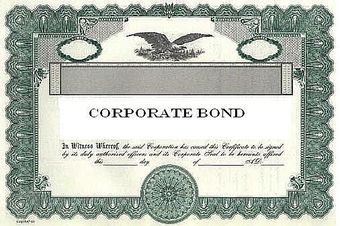
Bond
Preferred Stocks are considered a hybrid security with properties of both stocks and bonds, but are subordinate to bonds when it comes to rights of claim to company assets.
Preferred stock usually carries no voting rights, but may carry a dividend and may have priority over common stock in the payment of dividends and upon liquidation. The specific terms of owning preferred stock are specified in a certificate of designation. The features and rights which are generally associated with preferred stock are as follows:
- Preference in dividends
- Preference in assets in the event of liquidation
- Convertibility to common stock
- Callability, at the option of the corporation
- Nonvoting rights.
Similar to bonds, preferred stocks are rated by the major credit-rating companies. The rating for preferreds is generally lower, since preferred dividends do not carry the same guarantees as interest payments from bonds, and they are junior to all creditors.
Details with regards to the rights associated with preferred stock will vary with the business entity that issues the shares, and preferred stock can come in a number of different classes. Some examples are prior preferred stock (highest priority), preference preferred stock, convertible preferred stock (exchangeable for common stock), cumulative preferred stock, exchangeable preferred stock, participating preferred stock, putable preferred stock, monthly income preferred stock, and non-cumulative preferred stock.
7.3: Rules and Rights of Common and Preferred Stock
7.3.1: Claim to Income
In the cases of bankruptcy and dividend distribution, preferred stock shareholders will receive assets before common stock shareholders.
Learning Objective
Describe the rights preferred stock has to a company’s income
Key Points
- Common stock and preferred stock are both forms of equity ownership but carry different rights and claims to income.
- Preferred stock shareholders will have claim to assets over common stock shareholders in the case of company liquidation.
- Preferred stock also has first right to dividends.
Key Terms
- Common stock
-
Common stock is a form of equity and type of security. Common stock shareholders are at the bottom of the line when it comes to dividends and receiving compensation in the case of bankruptcy.
- Preferred Stock
-
Preferred stock is an equity security that has the properties of both an equity and debt instrument and is higher ranking than common stock.
Preferred and common stock have varying claims to income which will change from one equity issuer to another. In general, preferred stock will be given some preference in assets to common assets in the case of company liquidation, but both will fall behind bondholders when asset distribution takes place. In the event of bankruptcy, common stock investors receive any remaining funds after bondholders, creditors (including employees), and preferred stock holders are paid. As such, these investors often receive nothing after a bankruptcy. Preferred stock also has the first right to receive dividends. In general, common stock shareholders will not receive dividends until it is paid out to preferred shareholders. Access to dividends and other rights vary from firm to firm.

1903 stock certificate of the Baltimore and Ohio Railroad
Preferred and common stock both carry rights of ownership, but represent different classes of equity ownership.
Preferred stock may or may not have a fixed liquidation value (or par value) associated with it. This represents the amount of capital that was contributed to the corporation when the shares were first issued. Preferred stock has a claim on liquidation proceeds of a stock corporation equal to its par (or liquidation) value, unless otherwise negotiated. This claim is senior to that of common stock, which has only a residual claim.
Both types of stock can have a claim to income in the form of capital appreciation as well. As company value increases based on market determinants, the value of equity held in this company also will increase. This translates to a return on investment to shareholders. This will be different to common stock shareholders and preferred stock shareholders because of the different prices and rewards based on holding these different kinds of shares. In turn, should market forces decrease, the value of equity held will decrease as well, reflecting a loss on investment and, therefore, a decrease on the value of any claims to income for shareholders.
7.3.2: Voting Right
Common stock generally carries voting rights, while preferred stock does not; however, this will vary from company to company.
Learning Objective
Summarize the voting rights associated with common and preferred stock
Key Points
- Common stock shareholders can generally vote on issues, such as members of the board of directors, stock splits, and the establishment of corporate objectives and policy.
- While having superior rights to dividends and assets over common stock, generally preferred stock does not carry voting rights.
- Many of the voting rights of a shareholder can be exercised at annual general body meetings of companies. An annual general meeting is a meeting that official bodies, and associations involving the general public, are often required by law to hold.
Key Terms
- Voting rights
-
Rights which are generally associated with common stock shareholders in regards to business entity matters ( such as electing the board of directors or establishing corporate policy)
- Preferred Stock
-
Preferred stock is an equity security that has the properties of both an equity and debt instrument and is higher ranking than common stock.
- Common stock
-
Common stock is a form of equity and type of security. Common stock shareholders are at the bottom of the line when it comes to dividends and receiving compensation in the case of bankruptcy.
Voting Rights
Common stock can also be referred to as a “voting share. ” Common stock usually carries with it the right to vote on business entity matters, such as electing the board of directors, establishing corporate objectives and policy, and stock splits. However, common stock can be broken into voting and non-voting classes. While having superior rights to dividends and assets over common stock, generally preferred stock does not carry voting rights.
The matters that a stockholder gets to vote on vary from company to company. In many cases, the shareholder will be able to vote for members of a company board of directors and, in general, each share gets a vote as opposed to each shareholder. Therefore, a single investor who owns 300 shares will have more say in a voting matter than a single shareholder that owns 30.
Exercising Voting Rights
Many of the voting rights of a shareholder can be exercised at annual general body meetings of companies. An annual general meeting is a meeting that official bodies and associations involving the general public (including companies with shareholders) are often required by law (or the constitution, charter, by-laws, etc., governing the body) to hold. An AGM is held every year to elect the board of directors and inform their members of previous and future activities. It is an opportunity for the shareholders and partners to receive copies of the company’s accounts, as well as reviewing fiscal information for the past year and asking any questions regarding the directions the business will take in the future. Shareholders also have the option to mail their votes in if they cannot attend the shareholder meetings. In 2007, the Securities and Exchange Commission voted to require all public companies to make their annual meeting materials available online. Shareholders with the right to vote will have numerous options in how to make their voice heard with regards to voting matters should they choose to.

Shareholder Meeting
This scene from “The Office” humorously illustrates a shareholder meeting, where the shareholder can exercise their right to vote on company issues or question company directors.
7.3.3: Purchasing New Shares
New shares can be purchased on exchanges and current shareholders will usually have preemptive rights to newly issued shares.
Learning Objective
Discuss the process and implication of purchasing new shares by a shareholder that already holds shares in a company
Key Points
- New share purchase is an important indicator of current shareholder belief in the health of the company and long term prospects for growth.
- Current Shareholders will often have preemptive rights that give them the right to purchase newly issued company shares before they go on sale to the general public.
- New shares can be purchased on exchanges, which offer a platform for the financial marketplace.
Key Terms
- Stock Exchange
-
A form of exchange that provides services for stock brokers and traders to trade stocks, bonds and other securities.
- Preemption
-
The right of a shareholder to purchase newly issued shares of a business entity before they are available to the general public so as to protect individual ownership from dilution.
New share purchases are an important action by share shareholders, since it requires a further investment in a business entity and is a reflection of a shareholder’s decision to maintain an ownership position in a company, or a potential investor’s belief that purchasing equity in a company will be an investment that grows in value.
Current shareholders may have preemptive rights over new shares offered by the company. In practice, the most common form of preemption right is the right of existing shareholders to acquire new shares issued by a company in a rights issue, a usually but not always public offering. In this context, the pre-emptive right is also called “subscription right” or “subscription privilege. ” This is the right, but not the obligation, of existing shareholders to buy the new shares before they are offered to the public. In this way, existing shareholders can maintain their proportional ownership of the company, preventing stock dilution.
New shares may be purchased over the same exchange mechanisms that previous stock was acquired. A stock exchange is a form of exchange which provides services for stock brokers and traders to trade stocks, bonds, and other securities. Stock exchanges also provide facilities for issue and redemption of securities and other financial instruments, and capital events, including the payment of income and dividends. The initial offering of stocks and bonds to investors is by definition done in the primary market and subsequent trading is done in the secondary market. A stock exchange is often the most important component of a stock market. Supply and demand in stock markets are driven by various factors that, as in all free markets, affect the price of stocks.

Exchanges
New shares can be traded on exchanges such as the Nasdaq, but will usually be offered to current shareholders before being put on sale to the general public.
7.3.4: Preferred Stock Rules and Rights
Preferred stock can include rights such as preemption, convertibility, callability, and dividend and liquidation preference.
Learning Objective
List the rights that preferred stock generally has
Key Points
- Preferred stock generally does not carry voting rights, but this may vary from company to company.
- Preferred stock can gain cumulative dividends, convertibility to common stock, and callability.
- The rights that come with ownership of preferred stock are detailed in a “Certificate of Designation”.
Key Terms
- liquidation
-
liquidation is the process by which a company (or part of a company) is brought to an end, and the assets and property of the company redistributed
- Preferred Stock
-
Preferred stock is an equity security that has the properties of both an equity and debt instrument and is higher ranking than common stock.
Preferred stock usually carries no voting rights, but may carry a dividend and may have priority over common stock in the payment of dividends and upon liquidation. Terms of the preferred stock are stated in a “Certificate of Designation. “

VOC stock
Preferred stock is a security ( a little more modern that this stock from the VOC or Dutch East India Company) that carries certain rights which designate it from common stock or debt.
Preferred stock is a special class of shares that may have any combination of features not possessed by common stock. The following features are usually associated with preferred stock: Preference in dividends preference in assets, in the event of liquidation, convertibility to common stock, callability, and at the option of the corporation. Some preferred shares have special voting rights to approve extraordinary events (such as the issuance of new shares or approval of the acquisition of a company) or to elect directors, but, once again, most preferred shares have no voting rights associated with them. Some preferred shares gain voting rights when the preferred dividends are in arrears for a substantial time.
Preferred stock may or may not have a fixed liquidation value (or par value) associated with it. This represents the amount of capital which was contributed to the corporation when the shares were first issued. Preferred stock has a claim on liquidation proceeds of a stock corporation equal to its par (or liquidation) value, unless otherwise negotiated. This claim is senior to that of common stock, which has only a residual claim.Almost all preferred shares have a negotiated, fixed-dividend amount. The dividend is usually specified as a percentage of the par value, or as a fixed amount. Sometimes, dividends on preferred shares may be negotiated as floating; they may change according to a benchmark interest-rate index. Preferred stock may also have rights to cumulative dividends.
7.3.5: Provisions of Preferred Stock
Preferred shares have numerous rights which can be attached to them, such as cumulative dividends, convertibility, and participation.
Learning Objective
Describe in detail the different types of provisions for preferred stock
Key Points
- If a preferred share has cumulative dividends, then it contains the provision that should a company fail to pay out dividends at any time at the stated rate, then the issuer will have to make up for it as time goes on.
- Convertible preferred stock can be exchanged for a predetermined number of company common stock shares.
- Often times companies will keep the right to call or buy back preferred shares at a predetermined price.
- Participating preferred issues offer holders the opportunity to receive extra dividends if the company achieves predetermined financial goals.
- Sometimes, dividends on preferred shares may be negotiated as floating; they may change according to a benchmark interest-rate index.
Key Terms
- Callable shares
-
Shares which can be bought back by the issuer at a predetermined price.
- Convertible preferred stock
-
Convertible preferred stock can be exchanged for a predetermined number of company common stock shares.
- Cumulative Dividends
-
Condition where owners of certain shares will receive accumulated dividends in the case a company cannot pay out dividends at the stated rate at the stated time.
Preferred stock may be entitled to numerous rights, depending on what is designated by the issuer. One of these rights may be the right to cumulative dividends. Preferred stock shareholders already have rights to dividends before common stock shareholders, but cumulative preferred shares contain the provision that should a company fail to pay out dividends at any time at the stated rate, then the issuer will have to make up for it as time goes on.

Historical dividend information for Franklin Automobile Company
Dividends are one of the privileges of stock ownership, and preferred shares get more rights to them than common shares do.
Convertible preferred stock can be exchanged for a predetermined number of company common stock shares. Generally, this can occur at the discretion of the investor, and he or she may pick any time to do so and, therefore, take advantage of fluctuations in the price of common stock. Once converted, the common stock cannot be converted back to preferred status.
Often times companies will keep the right to call or buy back preferred shares at a predetermined price. These shares are callable shares.
There is a class of preferred shares known as “participating preferred stock. ” These preferred issues offer holders the opportunity to receive extra dividends if the company achieves predetermined financial goals. Investors who purchased these stocks receive their regular dividend regardless of company performance (assuming the company does well enough to make its annual dividend payments). If the company achieves predetermined sales, earnings, or profitability goals, the investors receive an additional dividend.
Almost all preferred shares have a negotiated, fixed-dividend amount. The dividend is usually specified as a percentage of the par value, or as a fixed amount. Sometimes, dividends on preferred shares may be negotiated as floating; they may change according to a benchmark interest-rate index or floating rate. An example of this would be tying the dividend rate to LIBOR.
7.3.6: Comparing Common Stock, Preferred Stock, and Debt
Common stock, preferred stock, and debt are all securities that a company may offer; each of these securities carries different rights.
Learning Objective
Differentiate between the rights of common shareholders, preferred shareholders, and bond holders
Key Points
- Common stock and preferred stock fall behind debt holders as creditors that would receive assets in the case of company liquidation.
- Common stock and preferred stock are both types of equity ownership. They receive rights of ownership in the company, such as voting and dividends.
- Debt holders often receive a bond for lending and while this does not give the ownership rights of being a stockholder, it does create a superior claim to a company’s assets in the case of liquidation.
Key Terms
- Common stock
-
Common stock is a form of corporate equity ownership, a type of security.
- bond
-
A bond is an instrument of indebtness of the bond issuers toward the bond holders.
- Preferred Stock
-
Preferred stock is an equity security that has the properties of both an equity and debt instrument and is higher ranking than common stock.
Equity
Common Stock and Preferred Stock are both methods of purchasing equity in a business entity.
Common stock generally carries voting rights along with it, while preferred shares generally do not.
Preferred shares act like a hybrid security, in between common stock and holding debt. Preferred stock can (depending on the issue) be converted to common stock and have access to accumulated dividends and multiple other rights. Preferred stock also has access to dividends and assets in the case of liquidation before common stock does.
However, both common and preferred stock fall behind debt holders when it comes to claims to assets of a business entity should bankruptcy occur. Common shareholders often do not receive any assets after bankruptcy as a result of this principle. However, common stock shareholders can theoretically use their votes to affect company decision making and direction in a way they believe will help the company avoid liquidation in the first place.
Debt
Debt can be “purchased” from a company in the form of a bond.

A bond from the Dutch East India Company
A bond is a financial security that represents a promise by a company or government to repay a certain amount, with interest, to the bondholder.
In finance, a bond is an instrument of indebtedness of the bond issuer to the holders. It is a debt security, under which the issuer owes the holders a debt and, depending on the terms of the bond, is obliged to pay them interest and/or to repay the principal at a later date, termed the maturity. Therefore, a bond is a form of loan or IOU: the holder of the bond is the lender (creditor), the issuer of the bond is the borrower (debtor), and the coupon is the interest. Bonds provide the borrower with external funds to finance long-term investments, or, in the case of government bonds, to finance current expenditure.
Bonds and stocks are both securities, but the major difference between the two is that (capital) stockholders have an equity stake in the company (i.e., they are owners), whereas, bondholders have a creditor stake in the company (i.e., they are lenders). Another difference is that bonds usually have a defined term, or maturity, after which the bond is redeemed, whereas stocks may be outstanding indefinitely.
7.4: Stock Markets
7.4.1: Market Actors
Market actors include individual retail investors, mutual funds, banks, insurance companies, hedge funds, and corporations.
Learning Objective
Identify the different actors that participate in a stock market
Key Points
- Pension funds are important shareholders of listed and private companies.
- Insurance companies are generally classified as either mutual or proprietary companies.
- A mutual fund is a type of professionally-managed collective investment vehicle that pools money from many investors to purchase securities.
- An index fund or index tracker is a collective investment scheme (usually a mutual fund or exchange-traded fund) that aims to replicate the movements of an index of a specific financial market, or a set of rules of ownership that are held constant, regardless of market conditions.
- An exchange-traded fund (ETF) is an investment fund traded on stock exchanges, much like stocks.
- A hedge fund is an fund that can undertake a wider range of investment and trading activities than other funds. It is generally only open to certain types of investors specified by regulators.
Key Terms
- open-end
-
An open-end(ed) fund is a collective investment scheme which can issue and redeem shares at any time.
- closed-end
-
Closed-end funds (or closed-ended funds) are mutual funds with a fixed number of shares (or units). Unlike open-end funds, new shares/units are not created by managers, to meet demand from investors, but the shares can only be purchased (and sold) in the market.
The individual actors in the financial markets can be broken down into three main categories: investors, intermediaries, and issuers. Specifically, market actors include individual retail investors, institutional investors such as mutual funds, banks, insurance companies and hedge funds, and also publicly traded corporations trading in their own shares. The value of a stock is derived from buying and selling decisions of these actors. Some studies have suggested that institutional investors and corporations trading in their own shares generally receive higher risk-adjusted returns than retail investors .

Stock Market
Different kinds of investors are active in stock market.
Investors
An investor is someone who allocates capital with the expectation of a financial return. The types of investments include, — equity, debt securities, real estate, currency, commodity, derivatives such as put and call options, etc. A few decades ago, worldwide, buyers and sellers were individual investors, such as wealthy businessmen, usually with long family histories to particular corporations. Over time, markets have become more “institutionalized. ” Buyers and sellers are largely institutions. Investors can include: pension funds, insurance companies, mutual funds, index funds, exchange-traded funds, and hedge funds.
Issuers
The issuer is a legal entity that develops, registers, and sells securities for the purpose of financing its operations. Issuers may be domestic or foreign governments, corporations, or investment trusts.
Intermediaries
Financial institutions (intermediaries) perform the vital role of bringing together those economic agents with surplus funds who want to lend, with those with a shortage of funds who want to borrow. The classic example of a financial intermediary is a bank that consolidates bank deposits and uses the funds to transform them into bank loans. Other classes of intermediaries include: credit unions, financial advisers or brokers, collective investment schemes, and pension funds.
Pension funds
A pension fund is any plan, fund, or scheme that provides retirement income.
Pension funds are important shareholders of listed and private companies. They are especially important to the stock market where large institutional investors dominate. The largest 300 pension funds collectively hold about $6 trillion in assets. In January 2008, The Economist reported that Morgan Stanley estimates that pension funds worldwide hold over $20 trillion in assets, the largest for any category of investor ahead of mutual funds, insurance companies, currency reserves, sovereign wealth funds, hedge funds, or private equity.
Insurance companies
Insurance companies are generally classified as either mutual or proprietary companies. Mutual companies are owned by the policyholders, while shareholders (who may or may not own policies) own proprietary insurance companies.
Mutual funds
A mutual fund is a type of professionally-managed collective investment vehicle that pools money from many investors to purchase securities. While there is no legal definition of mutual fund, the term is most commonly applied only to those collective investment vehicles that are regulated, available to the general public, and open-ended in nature. Hedge funds are not considered a type of mutual fund.
There are three types of U.S. mutual funds: open-end, unit investment trust, and closed-end. The most common type, the open-end mutual fund, must be willing to buy back its shares from its investors at the end of every business day. Exchange-traded funds are open-end funds or unit investment trusts that trade on an exchange. Open-end funds are most common, but exchange-traded funds have been gaining in popularity.
Index fund
An index fund or index tracker is a collective investment scheme (usually a mutual fund or exchange-traded fund) that aims to replicate the movements of an index of a specific financial market, or a set of rules of ownership that are held constant, regardless of market conditions. As of 2007, index funds made up over 11% of equity mutual fund assets in the United States.
Exchange-traded fund (ETF)
An exchange-traded fund (ETF) is an investment fund traded on stock exchanges, much like stocks. An ETF holds assets such as stocks, commodities, or bonds, and trades close to its net asset value over the course of the trading day. Most ETFs track an index, such as a stock index or bond index. ETFs may be attractive as investments because of their low costs, tax efficiency, and stock-like features. ETFs are the most popular type of exchange-traded product.
Hedge fund
A hedge fund is an fund that can undertake a wider range of investment and trading activities than other funds. It is generally only open to certain types of investors specified by regulators. These investors are typically institutions, such as pension funds, university endowments and foundations, or high-net-worth individuals, who are considered to have the knowledge or resources to understand the nature of the funds. As a class, hedge funds invest in a diverse range of assets, but they most commonly trade liquid securities on public markets. They also employ a wide variety of investment strategies, and make use of techniques such as short selling and leverage.
7.4.2: NYSE
The New York Stock Exchange is the world’s largest stock exchange by market capitalization at $14.242 trillion as of December 2011.
Learning Objective
Distinguish the New York Stock Exchange from other stock exchanges
Key Points
- The origin of the NYSE can be traced to May 17, 1792, when the Buttonwood Agreement was signed by 24 stockbrokers outside of 68 Wall Street in New York under a buttonwood tree on Wall Street.
- The New York Stock Exchange (sometimes referred to as “the Big Board”) provides a means for buyers and sellers to trade shares of stock in companies registered for public trading.
- The New York Stock Exchange is open for trading Monday through Friday from 9:30 am to 4:00 pm ET, with the exception of holidays declared by the NYSE in advance.
- Traders can gather around the appropriate post. There, a specialist broker acts as an auctioneer in an open outcry auction market environment to bring buyers and sellers together and to manage the actual auction.
- To be listed on the New York Stock Exchange, a company must have issued at least a million shares of stock worth $100 million and must have earned more than $10 million over the last three years.
Key Terms
- Dutch auction
-
an event to buy or sell that starts at a high price that is gradually reduced by the auctioneer until someone is willing to buy
- secondary market
-
The financial market in which previously issued financial instruments such as stock, bonds, options, and futures are bought and sold.
- NASDAQ
-
The National Association of Securities Dealers Automated Quotations; this is an electronic stock market.
New York Stock Exchange
The New York Stock Exchange, commonly referred to as the NYSE, is a stock exchange, or a secondary market. With primary issuances of securities or financial instruments, or the primary market, investors purchase these securities directly from issuers such as corporations issuing shares in an IPO or private placement, or directly from the federal government in the case of treasuries.
After the initial issuance, investors can purchase from other investors in secondary markets like the NYSE. If an investor wished to buy a stock from Apple, for example, the actual company is not directly involved. Secondary markets can be further subdivided into auction or dealer markets, typified by the mode of transactions. The NYSE is an auction market. Buyers and sellers meet at a physical location (in this case, Wall Street) and announce their bid or ask prices.
At the NYSE, traders gather around a specialist broker, who acts as an auctioneer in an open outcry auction market environment to bring buyers and sellers together and to manage the actual auction. The auction market format aims to bring together the parties with mutually agreeing prices in an efficient manner. The auction process moved toward automation in 1995 through the use of wireless hand held computers (HHC). The system enabled traders to receive and execute orders electronically via wireless transmission .

NYSE Trading Floor
Buyers and sellers meet and engage in face-to-face transactions at the NYSE, which is an auction-style secondary market.
The NYSE is by far the world’s largest stock exchange by market capitalization of its listed companies at $14.242 trillion as of December 2011, and most of the largest US companies are listed on the NYSE. The NYSE’s biggest competitor is NASDAQ; both are major secondary markets vying for large and profitable companies to list on their exchange.
Secondary markets like the NYSE serve a vital function as a setting where companies can raise capital for expansion through selling shares to the investing public. They also gain advertising and a boost in prestige, which likely increases their stock value. To be able to trade a security on the NYSE, it must be listed. To be listed on the New York Stock Exchange, a company must have issued at least a million shares of stock worth $100 million and must have earned more than $10 million over the last three years. They must also disclose certain information to the exchange, providing a measure of transparency that prevents insider manipulation of the stock prices.
7.4.3: NASDAQ
The NASDAQ is an American dealer-based stock market in which the dealers sell electronically to investors or firms.
Learning Objective
Distinguish the NASDAQ from other stock exchanges
Key Points
- NASDAQ was founded in 1971 by the National Association of Securities Dealers (NASD), who divested themselves of it in a series of sales in 2000 and 2001.
- NASDAQ quotes are available at three levels: Level 1 shows the highest bid and lowest offer; Level 2 shows all public quotes of market makers; Level 3 is used by the market makers and allows them to enter their quotes and execute orders.
- NASDAQ has a pre-market session from 7:00am to 9:30am, a normal trading session from 9:30am to 4:00pm, and a post-market session from 4:00pm to 8:00pm (all times in ET).
- Three market tiers are NASDAQ Capital Market – Small Cap, NASDAQ Global Market – Mid Cap, NASDAQ Global Select Market – Large Cap.
Key Term
- FINRA
-
In the United States, the Financial Industry Regulatory Authority, Inc., or FINRA, is a private corporation that acts as a self-regulatory organization (SRO). FINRA is the successor to the National Association of Securities Dealers, Inc. (NASD). Though sometimes mistaken for a government agency, it is a non-governmental organization that performs financial regulation of member brokerage firms and exchange markets. The government organization which acts as the ultimate regulator of the securities industry, including FINRA, is the Securities and Exchange Commission.
NASDAQ Stock Market
The NASDAQ Stock Market, also known simply as the NASDAQ, is an American stock exchange. “NASDAQ” originally stood for “National Association of Securities Dealers Automated Quotations. ” It is one of the largest stock exchanges in the world along with the New York Stock Exchange.

NASDAQ
NASDAQ is the second-largest stock exchange market in the world, as of 2012.
The NASDAQ is a dealer-based market in which stock dealers sell directly to investors or firms electronically via phone or Internet. The New York Stock Exchange conducts its trading in person.
History
NASDAQ was founded in 1971 by the National Association of Securities Dealers (NASD), who divested themselves of it in a series of sales in 2000 and 2001. It is owned and operated by the NASDAQ OMX Group and regulated by the Financial Industry Regulatory Authority (FINRA), the successor to the NASD.
When the NASDAQ stock exchange began trading on February 8, 1971, it was the world’s first electronic stock market. At first, it was merely a computer bulletin board system and did not actually connect buyers and sellers. The NASDAQ helped lower the spread (the difference between the bid price and the ask price of the stock), but paradoxically was unpopular among brokerages because they made much of their money on the spread.
Firms including Microsoft began doing business through NASDAQ early in their history, and remained with this exchange as the technology industry boomed. NASDAQ became known for its concentration of tech and high-growth firms, making it the primary tech market and an indicator for industry trends.
Indices
A stock index or stock market index is a method of measuring the value of a section of the stock market. It is computed from the prices of selected stocks, which vary depending on the index. Investors and financial managers can use it as a “snapshot” to describe the market conditions, and also as a tool to compare the return on specific investments. NASDAQ’s major indices include:
- NASDAQ-100
- NASDAQ Bank
- NASDAQ Biotechnology Index
- NASDAQ Transportation Index
- NASDAQ Composite
The NASDAQ Composite is often referred to as the NASDAQ. It is calculated from weighting common stocks and similar securities listed on the NASDAQ stock market. Thus “NASDAQ” can mean two things: either the stock exchange itself, or the index.
7.4.4: Market Reporting
Market indices provide valuable information for stock valuation.
Learning Objective
Explain how a market index works and its purpose
Key Points
- The is a tool used by investors and financial managers to describe the market and to compare the return on specific investments.
- An index is a mathematical construct, so it may not be invested in directly.
- A ‘world’ or ‘global’ stock market index includes (typically large) companies without regard for where they are domiciled or traded.
- A ‘national’ index represents the performance of the stock market of a given nation—and by proxy, reflects investor sentiment on the state of its economy.
- Stock market indices provide invaluable information for investors and accountants.
Key Terms
- market capitalization
-
The total market value of the equity in a publicly traded entity.
- weighted average
-
An arithmetic mean of values biased according to agreed weightings.
- Common stock
-
Shares of an ownership interest in the equity of a corporation or other entity with limited liability. Holders of this type of stock are entitled to dividends. Importantly, the financial rights for holders of this type of stock are junior to preferred stock and liabilities.
Market Reporting
A stock index or stock market index is a method of measuring the value of a section of the stock market. It is computed from the prices of selected stocks (sometimes a weighted average). It is a tool used by investors and financial managers to describe the market and to compare the return on specific investments.
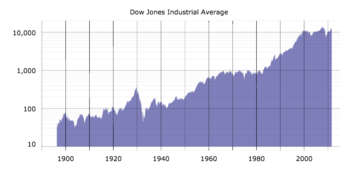
Historical Graph of the Dow Jones Industrial Average
This graph shows the general increase in the DJIA over the last century. Particularly notable is the growth from around 1,000 points in the late 1980s to around 10,000 points in 2005.
An index is a mathematical construct, so it may not be invested in directly. Many mutual funds and exchange-traded funds attempt to “track” an index. The funds that do may not be judged against those that do.
Stock market indices may be classed in many ways. A ‘world’ or ‘global’ stock market index includes (typically large) companies without regard for where they are domiciled or traded. Two examples are MSCI World and S&P Global 100.
A ‘national’ index represents the performance of the stock market of a given nation—and by proxy, reflects investor sentiment on the state of its economy. The most regularly quoted market indices are national indices composed of the stocks of large companies listed on a nation’s largest stock exchanges, such as the American S&P 500, the Japanese Nikkei 225, the Brazilian Ibovespa, the Russian RTSI, the Indian SENSEX, and the British FTSE 100.
Stock market indices provide invaluable information for investors and accountants. For example, the current market price per share, market capitalization, and trading volume are all readily available. With this information, along with a company’s consolidated financial statements, the following ratios and calculations can be performed:
- Dividend yield on common stock ratio=Dividend per share of common stock
- Payout ratio on common stock = Dividend per share of common stock
- Earnings per share (EPS)
By comparing the above ratios with those of other companies, investors, accountants, and forecasters can determine the position and health of their respective company’s stock.
7.5: Stock Valuation
7.5.1: Expected Dividends, No Growth
A no-growth company would be expected to return high dividends under traditional finance theory.
Learning Objective
Describe how a company should make a dividend decision when it expect no growth
Key Points
- Companies generally either retain earnings for investment, or distribute them as dividend, according to their growth strategy.
- Clientele effects suggests that different dividend levels attract different types of investors.
- Value investors look for indications that a stock is undervalued. High dividends are one indication of undervaluation.
- Knowing a firm’s cost of capital is needed in order to make better decisions. Managers make capital budgeting decisions while capital providers make decisions about lending and investment.
Key Term
- clientele
-
The body or class of people who frequent an establishment or purchase a service, especially when considered as forming a more-or-less homogeneous group of clients in terms of values or habits.
The Dividend Decision
Whether to issue dividends and what amount is calculated mainly on the basis of the company’s unappropriated profit and its earning prospects for the coming year. The amount is also often calculated based on expected free cash flows, which means cash remaining after all business expenses, and capital investment needs have been met.
If there are no favorable investment opportunities–projects where return exceed the hurdle rate–finance theory suggests that management will return excess cash to shareholders as dividends. However, there are exceptions. For example, shareholders of a “growth stock,” expect that the company will, almost by definition, retain earnings so as to fund growth internally.
At the other end of the spectrum, investors of a “no growth,” or value stock will expect the firm to retain little cash for investment, and to distribute a comparatively greater proportion to investors as a dividend.
Clientele Effects
This suggests that a particular pattern of dividend payments may suit one type of stock holder more than another; this is sometimes called the “clientele effect. ” A retiree may prefer to invest in a firm that provides a consistently high dividend yield, whereas a person with a high income from employment may prefer to avoid dividends due to their high marginal tax rate on income. If clienteles exist for particular patterns of dividend payments, a firm may be able to maximize its stock price and minimize its cost of capital by catering to a particular clientele. This model may help to explain the relatively consistent dividend policies followed by mostlisted companies.
Value Investors
No growth, high dividend stocks may appeal to value investors. Value investing involves buying securities with shares that appear underpriced by some form of fundamental analysis. As examples, such securities may be stock in public companies that have high dividend yields, low price-to-earning multiples, or have low price-to-book ratios. Thus, high dividends and low reinvestment of retained earnings can signal an appealing value stock to an investor.

Investing trade-offs
Value investors trade growth for dividends.
7.5.2: Expected Dividends and Constant Growth
Valuations rely heavily on the expected growth rate of a company; past growth rate of sales and income provide insight into future growth.
Learning Objective
Calculate a company’s stock price using the Constant Growth Approximation
Key Points
- Companies are constantly changing, as well as the economy. Solely using historical growth rates to predict the future is not an acceptable form of valuation. Calculating the future growth rate requires personal investment research.
- A generalized version of the Walter model (1956), SPM considers the effects of dividends, earnings growth, as well as the risk profile of a firm on a stock’s value.
- The Gordon model or Gordon’s growth model is the best known of a class of discounted dividend models. It assumes that dividends will increase at a constant growth rate (less than the discount rate) forever.
Key Term
- Gordon Growth Model
-
Gordon Growth Model is also called the dividend discount model (DDM), which is a way of valuing a company based on the theory that a stock is worth the discounted sum of all of its future dividend payments.
Growth Rate
Valuations rely very heavily on the expected growth rate of a company. One must look at the historical growth rate of both sales and income to get a feeling for the type of future growth expected. However, companies are constantly changing, as well as the economy, so solely using historical growth rates to predict the future is not an acceptable form of valuation. Instead, they are used as guidelines for what future growth could look like if similar circumstances are encountered by the company. Calculating the future growth rate requires personal investment research. This may take form in listening to the company’s quarterly conference call or reading a press release or other another company article that discusses the company’s growth guidance. However, although companies are in the best position to forecast their own growth, they are far from accurate. Unforeseen events could cause rapid changes in the economy and in the company’s industry.
And for any valuation technique, it’s important to look at a range of forecast values.
- For example, if the company being valued has been growing earnings between 5 and 10% each year for the last five years, but believes that it will grow 15 – 20% this year, a more conservative growth rate of 10 – 15% would be appropriate in valuations.
- Another example would be for a company that has been going through restructuring. They may have been growing earnings at 10 – 15% over the past several quarters / years because of cost cutting, but their sales growth could be only 0 – 5%. This would signal that their earnings growth will probably slow when the cost cutting has fully taken effect. Therefore, forecasting an earnings growth closer to the 0 – 5% rate would be more appropriate rather than the 15 – 20%. Nonetheless, the growth rate method of valuations relies heavily on gut feel to make a forecast. This is why analysts often make inaccurate forecasts. It is also why familiarity with a company is essential before making a forecast.
Sum of Perpetuities Method
The PEG ratio is a special case in the Sum of Perpetuities Method (SPM) equation. A generalized version of the Walter model (1956), SPM considers the effects of dividends, earnings growth, as well as the risk profile of a firm on a stock’s value. Derived from the compound interest formula using the present value of a perpetuity equation, SPM is an alternative to the Gordon Growth Model. The variables are:
- P is the value of the stock or business
- E is a company’s earnings
- G is the company’s constant growth rate
- K is the company’s risk adjusted discount rate
- D is the company’s dividend payment
Constant Growth Approximation
The Gordon model or Gordon’s growth model is the best known of a class of discounted dividend models . It assumes that dividends will increase at a constant growth rate (less than the discount rate) forever. The valuation is given by the formula:

Your Dividend
DDM can be used to calculate a constant growth company.
7.5.3: Relationship Between Dividend Payments and the Growth Rate
The portion of the earnings not paid to investors is, ideally, left for investment in order to provide for future earnings growth.
Learning Objective
Describe the relationship between dividend payments and a company’s growth
Key Points
- Investors take into account how much capital is distributed to investors, and conversely how much capital is kept from investors.
- Investors hope that firms will use retained earnings to either maximize their current operations or invest in such as a way as to lead to higher profits.
- Some firms are unable to distribute earnings, since their funds are tied up in maintenance, repairs, et cetera.
- On the other hand, some companies can retain earnings and put that money back to work – i.e., invest in growth opportunities.
Key Term
- capital gains
-
Profit that results from a disposition of a capital asset, such as stock, bond, or real estate due to arbitrage.
From an investor’s point of view, the fundamentals of a company are of the utmost importance. One such fundamental that that investors take into account is how much capital is distributed to investors, and conversely how much capital is kept from investors. Capital is distributed to investors via dividend payments and, indirectly, through capital gains. Capital that is kept from investors is known as retained earnings. Investors hope that firms will use retained earnings to either maximize their current operations or invest in such as a way as to lead to higher profits. In other words, the portion of profits not paid out to investors via dividends is, ideally, left for investment in order to provide for future earnings growth.
Some companies require large amounts of new capital just to continue operations. Such firms are usually unable to distribute earnings, since their funds are tied up in maintenance, repairs, et cetera. These companies also provide limited growth opportunities, since earnings are not reinvested for the purpose of growth. On the other hand, some companies can retain earnings and put that money back to work – i.e., invest in growth opportunities. Firms that can do this tend to retain more of their earnings. These firms are attractive to investors, even though there is relatively low distribution of profits.
Put succinctly, investors seeking high current income and limited capital growth prefer companies with a high dividend payout ratio. However, investors seeking higher capital growth may prefer a lower payout ratio because capital gains are taxed at a lower rate. High growth firms in early life generally have low or zero payout ratios in order to reinvest as much of their earnings as possible. As they mature, they tend to return more of the earnings back to investors. Note that dividend payout ratio is calculated as dividend per share divided by earnings per share.
7.5.4: Understanding Future Stock Value
There are many different ways to appraise the future value of stocks, including fundamental criteria and stock valuation methods.
Learning Objective
Describe different ways of valuing stock
Key Points
- Earnings Per Share is the total net income of the company divided by the number of shares outstanding; the Profits/Earnings ratio is the stock price divided by the annual EPS figure.
- Return on Invested Capital measures how much money the company makes each year per dollar of invested capital and approximates the expected level of growth; Return on Assets measures the company’s ability to make money from its assets.
- To measure Market Capitalization (the value of all of a company’s stock), multiply the current stock price by the fully diluted shares outstanding; Enterprise Value is equal to the total value the company is trading for on the stock market.
- Enterprise Value (EV) to earnings before interest, taxes, depreciation and amortization (EBITDA) is one of the best measurements of whether or not a company should be valued as cheap or expensive.
Key Terms
- GAAP
-
Generally Accepted Accounting Principles refer to the standard framework of guidelines, conventions, and rules accountants are expected to follow in recording, summarizing, and preparing financial statements in any given jurisdiction.
- risk premium
-
A risk premium is the minimum amount of money by which the expected return on a risky asset must exceed the known return on a risk-free asset, or the expected return on a less risky asset, in order to induce an individual to hold the risky asset rather than the risk-free asset.
Example
- P/E Ratio: For example, if the stock is trading at 10 and the EPS is 0.50, the P/E is 20 times. To get a good feeling of what P/E multiple a stock trades at, be sure to look at both the historical and forward ratios.
In financial markets, stock valuation involves calculating theoretical values of companies and their stocks. The main use of stock valuation is to predict future market prices and profit from price changes. Stocks that are judged as undervalued (with respect to their theoretical value) are bought, while stocks that are perceived to be overvalued are sold, in the expectation that undervalued stocks will, on the whole, rise, while overvalued stocks will, on the whole, fall .

Stock Valuation
Stock valuation involves many methods.
Fundamental Criteria (Fair Value)
The soundest stock valuation method, the discounted cash flow (DCF) method of income valuation, involves discounting the profits (dividends, earnings, or cash flows) the stock will bring to stockholders in the foreseeable future, and calculating a final value on disposal. The discounted rate normally includes a risk premium which is often based on the capital asset pricing model.
Stock Valuation Methods
There are many different ways to value stocks. The key is to take each approach into account while formulating an overall opinion of the stock. If the valuation of a company is lower or higher than other similar stocks, then the next step would be to determine the reasons for the discrepancy.
1. Earnings Per Share (EPS)
EPS is the total net income of the company divided by the number of shares outstanding. Numbers are usually reported as a GAAP EPS number (which means it is computed using mutually agreed upon accounting rules) and a Pro Forma EPS figure (income is adjusted to exclude any one time items as well as some non-cash items like amortization of goodwill or stock option expenses).
2. Price to Earnings (P/E)
Once one has several EPS figures (historical and forecasts), the most common valuation technique used by analysts is the price to earnings ratio, or P/E. To compute this figure, the stock price is divided by the annual EPS figure.
3. Price Earnings to Growth (PEG) Ratio
This valuation technique has become more popular over the past decade or so. It is better than just looking at a P/E because it takes three factors into account: the price, earnings, and earnings growth rates. To compute the PEG ratio, divide the Forward P/E by the expected earnings growth rate (historical P/E and historical growth rate are also used to see where the stock has traded in the past).
4. Return on Invested Capital (ROIC)
This valuation technique measures how much money the company makes each year per dollar of invested capital. Invested capital is the amount of money invested in the company by both stockholders and debtors. The ratio is expressed as a percent and Return on Invested Capital ratio should have a percent that approximates the expected level of growth. In its simplest definition, this ratio measures the investment return that management is able to get for its capital. The higher the number, the better the return.
5. Return on Assets (ROA)
Similar to ROIC, ROA, expressed as a percent, measures the company’s ability to make money from its assets. To measure the ROA, take the pro forma net income divided by the total assets. However, because of very common irregularities in balance sheets (due to things like goodwill, write-offs, discontinuations, etc. ) this ratio is not always a good indicator of the company’s potential. If the ratio is higher or lower than expected, be sure to look closely at the assets to see what could be overstating or understating the figure.
6. Price to Sales (P/S)
This figure is useful because it compares the current stock price to the annual sales. In other words, it tells you how much the stock costs per dollar of sales earned.
7. Market Cap
Market Cap, which is short for Market Capitalization, is the value of all of the company’s stock. To measure it, multiply the current stock price by the fully diluted shares outstanding.
8. Enterprise Value (EV)
Enterprise Value is equal to the total value of the company, as trading on the stock market. To compute it, add the Market Cap (see above) and the total net debt of the company.
9. EBITDA
EBITDA stands for earnings before interest, taxes, depreciation and amortization. It is one of the best measures of a company’s cash flow and is used for valuing both public and private companies.
10. EV to EBITDA
This is perhaps one of the best measurements of whether or not a company should be valued as cheap or expensive. To compute, divide the EV by EBITDA (see above for calculations). The higher the number, the more expensive the company is.
7.5.5: Valuing Nonconstant Growth Dividends
Limited high-growth approximation, implied growth models, and the imputed growth acceleration ratio are used to value nonconstant growth dividends.
Learning Objective
Describe the limitations of valuing a company with dividends that have a nonconstant growth rate
Key Points
- Limited high-growth approximation: When a stock has a significantly higher growth rate than its peers, it is sometimes assumed that the earnings growth rate will be sustained for a short time (say, 5 years), and then the growth rate will revert to the mean.
- Implied Growth Models: One can use the Gordon model or the limited high-growth period approximation model to impute an implied growth estimate.
- Imputed growth acceleration ratio: Subsequently, one can divide this imputed growth estimate by recent historical growth rates.
Key Terms
- DCF models
-
Valuation using discounted cash flows is a method for determining the current value of a company using future cash flows adjusted for time value. The future cash flow set is made up of the cash flows within the determined forecast period and a continuing value that represents the cash flow stream after the forecast period.
- break-even
-
Break-even (or break even) is the point of balance between making either a profit or a loss.
Limited high-growth period approximation
When a stock has a significantly higher growth rate than its peers, it is sometimes assumed that the earnings growth rate will be sustained for a short time (say, 5 years), and then the growth rate will revert to the mean. This is probably the most rigorous approximation that is practical.
While these DCF models are commonly used, the uncertainty in these values is hardly ever discussed. Note that the models diverge for and hence are extremely sensitive to the difference of dividend growth to discount factor. One might argue that an analyst can justify any value (and that would usually be one close to the current price supporting his call) by fine-tuning the growth/discount assumptions.
Implied Growth Models
One can use the Gordon model or the limited high-growth period approximation model to impute an implied growth estimate. To do this, one takes the average P/E and average growth for a comparison index, uses the current (or forward) P/E of the stock in question, and calculates what growth rate would be needed for the two valuation equations to be equal. This gives you an estimate of the “break-even” growth rate for the stock’s current P/E ratio. (Note: we are using earnings not dividends here because dividend policies vary and may be influenced by many factors including tax treatment).
Imputed growth acceleration ratio
Subsequently, one can divide this imputed growth estimate by recent historical growth rates. If the resulting ratio is greater than one, it implies that the stock would need to experience accelerated growth relative to its prior recent historical growth to justify its current P/E (higher values suggest potential overvaluation). If the resulting ratio is less than one, it implies that either the market expects growth to slow for this stock or that the stock could sustain its current P/E with lower than historical growth (lower values suggest potential undervaluation). Comparison of the IGAR across stocks in the same industry may give estimates of relative value. IGAR averages across an industry may give estimates of relative expected changes in industry growth (e.g. the market’s imputed expectation that an industry is about to “take-off” or stagnate). Naturally, any differences in IGAR between stocks in the same industry may be due to differences in fundamentals, and would require further specific analysis.
7.6: Valuing the Corporation
7.6.1: Valuing the Corporation
Three approaches are commonly used in corporation valuation: the income approach, the asset-based approach, and the market approach.
Learning Objective
Distinguish between the income, asset-based, and market approaches for corporate valuation
Key Points
- Income approaches include Discount or capitalization rates, Capital Asset Pricing Model (CAPM), Modified Capital Asset Pricing Model, and Weighted average cost of capital (“WACC”).
- The asset approach to business valuation is based on the principle of substitution: no rational investor will pay more for the business assets than the cost of procuring assets of similar economic utility.
- The market approach to business valuation is rooted in the economic principle of competition: in a free market the supply and demand forces will drive the price of business assets to a certain equilibrium.
Key Terms
- net asset value
-
Net asset value (NAV) is the value of an entity’s assets less the value of its liabilities, often in relation to open-end or mutual funds, since shares of such funds registered with the U.S.
- corporation
-
a group of individuals, created by law or under authority of law, having a continuous existence independent of the existences of its members, and powers and liabilities distinct from those of its members
- discounted cash flow
-
In finance, discounted cash flow (DCF) analysis is a method of valuing a project, company, or asset using the concepts of the time value of money. All future cash flows are estimated and discounted to give their present values (PVs)–the sum of all future cash flows, both incoming and outgoing, is the net present value (NPV), which is taken as the value or price of the cash flows in question.
Corporation valuation is a process and a set of procedures used to estimate the economic value of an owner’s interest in a business. Valuation is used by financial market participants to determine the price they are willing to pay or receive to perfect the sale of a business. In addition to estimating the selling price of a business, the same valuation tools are often used by business appraisers to resolve disputes related to estate and gift taxation, divorce litigation, allocate business purchase price among business assets, establish a formula for estimating the value of partners’ ownership interest for buy-sell agreements, and many other business and legal purposes.
Three different approaches are commonly used in business valuation: the income approach, the asset-based approach, and the market approach. Within each of these approaches, there are various techniques for determining the value of a business using the definition of value appropriate for the appraisal assignment. Generally, the income approach determines value by calculating the net present value of the benefit stream generated by the business (discounted cash flow); the asset-based approach determines value by adding the sum of the parts of the business (net asset value); and the market approach determines value by comparing the subject company to other companies in the same industry, of the same size, and/or within the same region.
1. Income approaches
- Discount or Capitalization Rates
A discount rate or capitalization rate is used to determine the present value of the expected returns of a business. The discount rate and capitalization rate are closely related to each other, but are distinguishable. Generally speaking, the discount rate or capitalization rate may be defined as the yield necessary to attract investors to a particular investment, given the risks associated with that investment.
- Capital Asset Pricing Model (CAPM)
The Capital Asset Pricing Model (CAPM) is one method of determining the appropriate discount rate in business valuations. The CAPM method originated from the Nobel Prize winning studies of Harry Markowitz, James Tobin, and William Sharpe. The CAPM method derives the discount rate by adding a risk premium to the risk-free rate. In this instance, however, the risk premium is derived by multiplying the equity risk premium times “beta,” which is a measure of stock price volatility. Beta is published by various sources for particular industries and companies. Beta is associated with the systematic risks of an investment.
- Modified Capital Asset Pricing Model
The Cost of Equity (Ke) is computed by using the Modified Capital Asset Pricing Model
CAPM Model ke = Rf + B ( Rm-Rf) + SCRP + CSRP Where: Rf = Risk free rate of return (Generally taken as 10-year Government Bond Yield) B = Beta Value (Sensitivity of the stock returns to market returns) Ke = Cost of Equity Rm= Market Rate of Return SCRP = Small Company Risk Premium, CSRP= Company specific Risk premium
- Weighted Average Cost of Capital (“WACC”)
The weighted average cost of capital is an approach used to determine a discount rate. The WACC method determines the subject company’s actual cost of capital by calculating the weighted average of the company’s cost of debt and cost of equity. The WACC must be applied to the subject company’s net cash flow to total invested capital.
2. Asset-Based Approaches
The value of asset-based analysis of a business is equal to the sum of its parts. That is the theory underlying the asset-based approaches to business valuation. The asset approach to business valuation is based on the principle of substitution: no rational investor will pay more for the business assets than the cost of procuring assets of similar economic utility. In contrast to the income-based approaches, which require the valuation professional to make subjective judgments about capitalization or discount rates, the adjusted net book value method is relatively objective.
3. Market Approaches
The market approach to business valuation is rooted in the economic principle of competition: that in a free market the supply and demand forces will drive the price of business assets to a certain equilibrium. Buyers would not pay more for the business, and the sellers will not accept less than the price of a comparable business enterprise. It is similar in many respects to the “comparable sales” method that is commonly used in real estate appraisal. The market price of the stocks of publicly traded companies engaged in the same or a similar line of business, whose shares are actively traded in a free and open market, can be a valid indicator of value when the transactions in which stocks are traded are sufficiently similar to permit meaningful comparison.
7.6.2: Discounted Dividend vs. Corporate Valuation
The dividend discount model values a firm at the discounted sum of all of its future dividends, and does not factor in income or assets.
Learning Objective
Calculate a company’s stock price using the discounted dividend formula
Key Points
- P = D1 / ( r – g ). P is the current stock price, g is the constant growth rate in perpetuity expected for the dividends, r is the constant cost of equity for that company, and D1 is the value of the next year’s dividends.
- The equation can also be understood to generate the value of a stock such that the sum of its dividend yield (income) plus its growth (capital gains) equals the investor’s required total return.
- There are also problems with the model, such as the presumption of a steady and perpetual growth rate less than the cost of capital may not be reasonable.
Key Term
- Miller-Modigliani hypothesis
-
The Modigliani–Miller theorem (of Franco Modigliani, Merton Miller) forms the basis for modern thinking on capital structure. The basic theorem states that, under a certain market price process (the classical random walk), in the absence of taxes, bankruptcy costs, agency costs, and asymmetric information, and in an efficient market, the value of a firm is unaffected by how that firm is financed.
The dividend discount model (DDM) is a way of valuing a company based on the theory that a stock is worth the discounted sum of all of its future dividend payments. In other words, it is used to value stocks based on the net present value of the future dividends. The equation most always used is called the “Gordon Growth Model. ” It is named after Myron J. Gordon who originally published it in 1959, although the theoretical underpin was provided by John Burr Williams in his 1938 text The Theory of Investment Value.
The variables and equation are:
- P is the current stock price.
- g is the constant growth rate in perpetuity expected for the dividends.
- r is the constant cost of equity for that company.
- D1 is the value of the next year’s dividends.
- There is no reason to use a calculation of next year’s dividend using the current dividend and the growth rate, when management commonly disclose the future year’s dividend, and websites post it.
Income plus capital gains equals total return:
The equation can also be understood to generate the value of a stock such that the sum of its dividend yield (income) plus its growth (capital gains) equals the investor’s required total return. Consider the dividend growth rate as a proxy for the growth of earnings and by extension the stock price and capital gains. Consider the company’s cost of equity capital as a proxy for the investor’s required total return.
Income + Capital Gain = Total Return
Dividend Yield + Growth = Cost of Equity
Problems with the Model
- a) The presumption of a steady and perpetual growth rate less than the cost of capital may not be reasonable.
- b) If the stock does not currently pay a dividend, like many growth stocks, more general versions of the discounted dividend model must be used to value the stock. One common technique is to assume that the Miller-Modigliani hypothesis of dividend irrelevance is true and, therefore, replace the stocks’s dividend D with E earnings per share. However, this requires the use of earnings growth rather than dividend growth, which might be different.
- c) The stock price resulting from the Gordon model is hypersensitive to the growth rate chosen.
Chapter 6: Bond Valuation
6.1: The Basics of Interest Rates
6.1.1: Understanding the Cost of Money
The cost of money is the opportunity cost of holding money instead of investing it, depending on the rate of interest.
Learning Objective
Explain the sources of the cost of money
Key Points
- The concept of the cost of money has its basis, as does the subject of finance in general, in the time value of money.
- The time value of money refers to the fact that a dollar in hand today is worth more than a dollar promised at some future time.
- The trade-off between money now (holding money) and money later (investing) depends on, among other things, the rate of interest you can earn by investing. Therefore, interest is the cost of money.
Key Terms
- interest rate
-
The percentage of an amount of money charged for its use per some period of time. It can also be thought of as the cost of not having money for one period, or the amount paid on an investment per year.
- Opportunity cost
-
The cost of an opportunity forgone (and the loss of the benefits that could be received from that opportunity); the most valuable forgone alternative.
The concept of the cost of money has its basis, as does the subject of finance in general, in the time value of money. The time value of money is the value of money, taking into consideration the interest earned over a given amount of time. If offered a choice between $100 today or $100 in a year’s time – and there is a positive real interest rate throughout the year – a rational person will choose $100 today. This is described by economists as time preference. Time preference can be measured by auctioning off a risk free security–like a US Treasury bill. If a $100 note, payable in one year, sells for $80 now, then $80 is the present value of the note that will be worth $100 a year from now. This fee paid as compensation for the current use of assets is known as interest. In other words, the concept of interest describes the cost of having funds tied up in investments or savings.
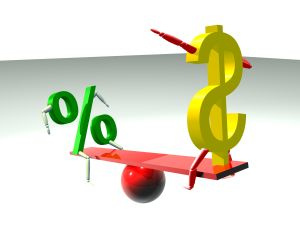
Cost Of Money
The cost of money is the opportunity cost of holding money in hands instead of investing it.
Furthermore, the time value of money is related to the concept of opportunity cost. The cost of any decision includes the cost of the most forgone alternative. The cost of money is the opportunity cost of holding money in hands instead of investing it. The trade-off between money now (holding money) and money later (investing) depends on, among other things, the rate of interest that can be earned by investing. An investor with money has two options: to spend it right now or to save it. The financial compensation for saving it as against spending it is that the money value will accrue through the compound interest that he will receive from a borrower (the bank account or investment in which he has the money).
6.1.2: Interest Rate Levels
An interest rate is the rate at which interest is paid by a borrower for the use of money that they borrow from a lender.
Learning Objective
Describe the crowding out phenomenon
Key Points
- In the U.S., the Federal Reserve (often referred to as ‘The Fed’) implements monetary policies largely by targeting the federal funds rate.
- Expansionary monetary policy is traditionally used to try to combat unemployment in a recession by lowering interest rates in the hope that easy credit will entice businesses into expanding.
- Contractionary monetary policy is intended to slow inflation in hopes of avoiding the resulting distortions and deterioration of asset values.
- Crowding out is a phenomenon occurring when expansionary fiscal policy causes interest rates to rise, thereby reducing investment spending.
Key Term
- monetary policy
-
The process by which the monetary authority of a country controls the supply of money, often targeting a rate of interest for the purpose of promoting economic growth and stability.
An interest rate is the rate at which interest is paid by a borrower for the use of money that they borrow from a lender. Changes in interest rate levels signal the status of the economy. As a vital tool of monetary policy, interest rates are kept at target levels – taking into account variables like investment, inflation, and unemployment – for the purpose of promoting economic growth and stability. In the U.S., the Federal Reserve (often referred to as ‘The Fed’) implements monetary policies largely by targeting the federal funds rate. This is the rate that banks charge each other for overnight loans of federal funds, which are the reserves held by banks at the Fed.
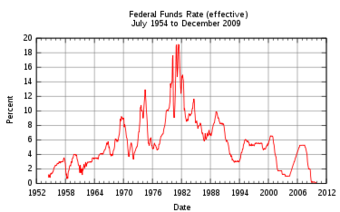
Federal fund rates
The effective federal funds rate in the U.S. charted over more than half a century.
Monetary policies are referred to as either expansionary or contractionary. Expansionary policy is traditionally used to try to combat unemployment in a recession by lowering interest rates in the hope that easy credit will entice businesses into expanding. An expansionary policy increases the total supply of money in the economy more rapidly than usual. Contractionary policy is intended to slow inflation in hopes of avoiding the resulting distortions and deterioration of asset values. Contractionary policy increases interest rate levels by expanding the money supply more slowly than usual or even shrinking it. Most central banks around the world assume and expect that lowering interest rates (expansionary monetary policies) would produce the effect of increasing investments and consumptions. However, lowering interest rates can sometimes lead to the creation of massive economic bubbles, when a large amount of investments are poured into the real estate market and stock market.
Crowding Out
Crowding out is a phenomenon occurring when expansionary fiscal policy causes interest rates to rise, thereby reducing investment spending. That means increase in government spending crowds out investment spending. This change in fiscal policy shifts equilibrium in the goods market. A fiscal expansion increases equilibrium income. If interest rates are unchanged, an increase in the level of aggregate demand will follow. This increase in demand must be met by rise in output.
With this increase in equilibrium income, the quantity of money demanded is higher. Because there is an excessive demand for real balances, the interest rate rises. Firms planned spending declines at higher interest rates, thus the aggregate demand falls. The adjustment of interest rates and their impact on aggregate demand dampen the expansionary effect of the increased government spending.
6.1.3: Drivers of Market Interest Rates
Market interest rates are mostly driven by inflationary expectations, alternative investments, risk of investment, and liquidity preference.
Learning Objective
Calculate the nominal interest rate of a given investment
Key Points
- A market interest rate is the rate at which interest is paid by a borrower for the use of money that they borrow from a lender in the market.
- Economists generally agree that the interest rates yielded by any investment take into account: the risk-free cost of capital, inflationary expectations, the level of risk in the investment, and the costs of the transaction.
- A basic interest rate pricing model for an asset is presented by the following formula: in = ir + pe + rp + lp.
Key Terms
- inflation
-
An increase in the general level of prices or in the cost of living.
- abscond
-
To flee; to withdraw from.
- interest rate risk
-
the potential for loss that arises for bond owners from fluctuating interest rates
- liquidity
-
Availability of cash over short term: ability to service short-term debt.
A market interest rate is the rate at which interest is paid by a borrower for the use of money that they borrow from a lender in the market.
Factors Influencing Market Interest Rates
Deferred consumption: When money is loaned the lender delays spending the money on consumption goods. According to time preference theory, people prefer goods now to goods later. In a free market there will be a positive interest rate.
Inflationary expectations: Most economies generally exhibit inflation, meaning a given amount of money buys fewer goods in the future than it will now. The borrower needs to compensate the lender for this. If the inflationary expectation goes up, then so does the market interest rate and vice versa.

Worldwide Inflation Rates 2009
World map showing inflation rate by country.
Alternative investments: The lender has a choice between using his money in different investments. If he chooses one, he forgoes the returns from all the others. Different investments effectively compete for funds, boosting the market interest rate up.
Risks of investment: There is always a risk that the borrower will go bankruptcy, abscond, die, or otherwise default on the loan. This means that a lender generally charges a risk premium to ensure that, across his investments, he is compensated for those that fail. The greater the risk is, the higher the market interest rate will get.
Liquidity preference: People prefer to have their resources available in a form that can immediately be exchanged, rather than a form that takes time or money to realize. If people are willing to hold more money in hands for convenience, the money supply will contract, increasing the market interest rate.
Market Impact
There is a market for investments which ultimately includes the money market, bond market, stock market, and currency market as well as retail financial institutions like banks. Exactly how these markets function are sometimes complicated. However, economists generally agree that the interest rates yielded by any investment take into account: the risk-free cost of capital, inflationary expectations, the level of risk in the investment, and the costs of the transaction. This rate incorporates the deferred consumption and alternative investments elements of interest. A basic interest rate pricing model for an asset is presented by the following formula: in = ir + pe + rp + lp.
Assuming perfect information, pe is the same for all participants in the market, and this is identical to: in = i*n+ rp + lp
where in is the nominal interest rate on a given investment, ir is the risk-free return to capital, pe = inflationary expectations, i*n = the nominal interest rate on a short-term risk-free liquid bond (such as U.S. Treasury Bills), rp = a risk premium reflecting the length of the investment and the likelihood the borrower will default, lp = liquidity premium (reflecting the perceived difficulty of converting the asset into money and thus into goods).
6.1.4: The Term Structure
Term structure of interest rates describes how rates change over time.
Learning Objective
Differentiate between the different theories explaining the different term structures of interest rates
Key Points
- Term structure of interest rates is often referred to as the yield curve.
- The expectation hypothesis of the term structure of interest rates is the proposition that the long-term rate is determined by the market’s expectation for the short-term rate plus a constant risk premium.
- The liquidity premium theory asserts that long-term interest rates not only reflect investors’ assumptions about future interest rates but also include a premium for holding long-term bonds.
- In the segmented market hypothesis, financial instruments of different terms are not substitutable; therefore, supply and demand in the markets for short-term and long-term instruments is determined largely independently.
Key Terms
- risk premium
-
A risk premium is the minimum amount of money by which the expected return on a risky asset must exceed the known return on a risk-free asset, or the expected return on a less risky asset, in order to induce an individual to hold the risky asset rather than the risk-free asset.
- premium
-
the price above par value at which a security is sold
- premium bond
-
a debt instrument bought at a price above par value
- Liquidity premium
-
Liquidity premium is a term used to explain a difference between two types of financial securities (e.g. stocks), that have all the same qualities except liquidity.
- term structure of interest rates
-
the relationship between the interest on a debt contract and the maturity of the contract
Term structure is a phrase used to describe how a given quantity or variable changes with time. In the case of bonds, time to maturity, or terms, vary from short-term – usually less than a year – to long-term – 10, 20, 30, 50 years, etc. Term structure of interest rates is often referred to as the yield curve.
In finance, the yield curve is a curve showing several yields or interest rates across different contract lengths (2 month, 2 year, 20 year, etc…) for a similar debt contract. The curve shows the relationship between the interest rate (or cost of borrowing) and the time to maturity – known as the “term” – of the debt for a given borrower in a given currency. “”
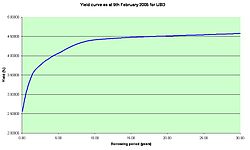
Yield curve for USD
The US dollar yield curve as of February 9, 2005. The curve has a typical upward sloping shape.
The curve allows an interest rate pattern to be determined, which can then be used to discount cash flows appropriately. Unfortunately, most bonds carry coupons, so the term structure must be determined using the prices of these securities. There are three main economic theories attempting to explain different term structures of interest rates. Two of the theories are extreme positions, while the third attempts to find a middle ground between two extremes.
The expectation hypothesis of the term structure of interest rates is the proposition that the long-term rate is determined by the market’s expectation for the short-term rate plus a constant risk premium. Shortcomings of the expectations theory is that it neglects the risks inherent in investing in bonds, namely interest rate risk and reinvestment rate risk.
The liquidity premiumtheory asserts that long-term interest rates not only reflect investors’ assumptions about future interest rates but also include a premium for holding long-term bonds (investors prefer short-term bonds to long-term bonds). This is called the term premium or the liquidity premium. This premium compensates investors for the added risk of having their money tied up for a longer period, including the greater price uncertainty. Because of the term premium, long-term bond yields tend to be higher than short-term yields, and the yield curve slopes upward. Long-term yields are also higher not just because of the liquidity premium, but also because of the risk premium added by the risk of default from holding a security over the long-term.
In the segmented market hypothesis, financial instruments of different terms are not substitutable. As a result, the supply and demand in the markets for short-term and long-term instruments is determined largely independently. Prospective investors decide in advance whether they need short-term or long-term instruments. If investors prefer their portfolio to be liquid, they will prefer short-term instruments to long-term instruments. Therefore, the market for short-term instruments will receive a higher demand. Higher demand for the instrument implies higher prices and lower yield. This explains the stylized fact that short-term yields are usually lower than long-term yields. This theory explains the predominance of the normal yield curve shape. However, because the supply and demand of the two markets are independent, this theory fails to explain the observed fact that yields tend to move together (i.e., upward and downward shifts in the curve).
6.2: Additional Detail on Interest Rates
6.2.1: The Yield Curve
A yield curve shows the relation between interest rate levels (or cost of borrowing) and the time to maturity.
Learning Objective
Describe different yield curves
Key Points
- In finance the yield curve is a curve showing several yields or interest rates across different contract lengths for a similar debt contract.
- Based on the shape of the yield curve, we have normal yield curves, steep yield curves, flat or humped yield curves, and inverted yield curves.
- There are three main economic theories that attempt to explain different term structures of interest rates, namely the expectation hypothesis, the liquidity premium theory, and the segmented market hypothesis.
Key Terms
- yield curve
-
the graph of the relationship between the interest on a debt contract and the maturity of the contract
- treasury bill
-
A United States Treasury security is a government debt issued by the United States Department of the Treasury through the Bureau of the Public Debt. Treasury securities are the debt financing instruments of the United States federal government. They are often referred to simply as treasuries. There are four types of marketable treasury securities: Treasury bills, Treasury notes, Treasury bonds, and Treasury Inflation Protected Securities (TIPS), in which Treasury bills have the shortest maturity of one year or less.
- Treasury bond
-
A United States Treasury security is a government debt issued by the United States Department of the Treasury through the Bureau of the Public Debt. Treasury securities are the debt financing instruments of the United States federal government, and they are often referred to simply as Treasuries. There are four types of marketable treasury securities: Treasury bills, Treasury notes, Treasury bonds, and Treasury Inflation Protected Securities (TIPS), in which Treasury bonds have the longest maturity, from 20 years to 30 years.
Overview
In finance the yield curve is a curve showing several yields or interest rates across different contract lengths (two month, two year, 20 year, etc…) for a similar debt contract. The curve shows the relation between the (level of) interest rate (cost of borrowing) and the time to maturity, known as the “term,” of the debt for a given borrower in a given currency. Based on the shape of the yield curve, we have normal yield curves, steep yield curves, flat or humped yield curves, and inverted yield curves .
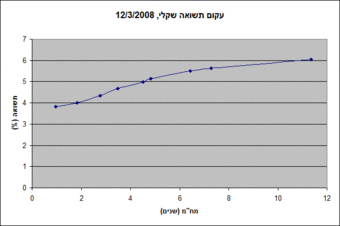
Israel Shekel yield curve
This graph is an example of a yield curve on Israeli Non-Linked Fixed Rate government bonds.
The yield curve is normal meaning that yields rise as maturity lengthens (i.e., the slope of the yield curve is positive). This positive slope reflects investor expectations for the economy to grow in the future and, importantly, for this growth to be associated with a greater expectation that inflation will rise in the future rather than fall. This expectation of higher inflation leads to expectations that the central bank will tighten monetary policy by raising short term interest rates in the future to slow economic growth and dampen inflationary pressure.
Shapes of Curves
Sometimes, treasury bond yield averages higher than that of treasury bills (e.g. 20-year Treasury yield rises higher than the three-month Treasury yield). In situations when this gap increases, the economy is expected to improve quickly in the future. This type of steep yield curve can be seen at the beginning of an economic expansion (or after the end of a recession). Here, economic stagnation will have depressed short-term interest rates. However, rates begin to rise once the demand for capital is re-established by growing economic activity.
A flat yield curve is observed when all maturities have similar yields, whereas a humped curve results when short-term and long-term yields are equal and medium-term yields are higher than those of the short-term and long-term. A flat curve sends signals of uncertainty in the economy.
An inverted yield curve occurs when long-term yields fall below short-term yields. Why this would happen is that when lenders are seeking long-term debt contracts more aggressively than short-term debt contracts. The yield curve “inverts,” with interest rates (yields) being lower and lower for each longer periods of repayment so that lenders can attract long-term borrowing .
Theories
There are three main economic theories attempting to explain different term structures of interest rates. Two of the theories are extreme positions, while the third attempts to find a middle ground between the former two.
The expectation hypothesis of the term structure of interest rates is the proposition that the long-term rate is determined by the market’s expectation for the short-term rate plus a constant risk premium. Shortcomings of expectations theory is that it neglects the risks inherent in investing in bonds, namely interest rate risk and reinvestment rate risk.
The liquidity premium theory asserts that long-term interest rates not only reflect investors’ assumptions about future interest rates, but also include a premium for holding long-term bonds (investors prefer short term bonds to long term bonds), called the term premium or the liquidity premium. This premium compensates investors for the added risk of having their money tied up for a longer period, including the greater price uncertainty. Because of the term premium, long-term bond yields tend to be higher than short-term yields, and the yield curve slopes upward. Long term yields are also higher not just because of the liquidity premium, but also because of the risk premium added by the risk of default from holding a security over the long term.
In the segmented market hypothesis, financial instruments of different terms are not substitutable. As a result, the supply and demand in the markets for short-term and long-term instruments is determined largely independently. Prospective investors decide in advance whether they need short-term or long-term instruments. If investors prefer their portfolio to be liquid, they will prefer short-term instruments to long-term instruments. Therefore, the market for short-term instruments will receive a higher demand. Higher demand for the instrument implies higher prices and lower yield. This explains the stylized fact that short-term yields are usually lower than long-term yields. This theory explains the predominance of the normal yield curve shape. However, because the supply and demand of the two markets are independent, this theory fails to explain the observed fact that yields tend to move together (i.e., upward and downward shifts in the curve).
6.2.2: Using the Yield Curve to Estimate Interest Rates in the Future
Yield curves on bonds and government provided securities are correlative, and are useful in projected future rates.
Learning Objective
Understand the conceptual implications of bond yield rates is they pertain to broader market interest rates
Key Points
- While the strict calculations involved in interest rate projections via bond yield curves come in a number of varieties (and complexities), it’s useful to note that there are strong correlations between the two.
- Yield curves combine the interest rate compounded over the duration of the debt security’s lifetime to demonstrate yield over time.
- The financial stress index uses bond yield rates to determine projected future yield curves, which can indicate a variety of economic predictions (such as recessions and interest rate changes).
- Market expectations theory uses existing projects for short-term interest rates based upon yield to project longer-term interest rates.
- The Heath-Jarrow-Morton Framework is a well-established norm for predicting interest rates based upon various inputs (including yield curves). Understanding the conceptual inputs to this model gives some scope as to interest rate derivation.
Key Terms
- yield curve
-
A curve that shows the compounded interest rate applied to the value of the security over its lifetime.
- recessions
-
Downturns in a given economic environment.
Defining the Yield Curve
For debt contracts, the overall duration of time of the debt security coupled with the interest rate compounded over that time frame will illustrate the overall yield of the security during its lifetime. This is referred to as a yield curve. When this is applied to U.S. treasury securities in respect to interest rates, useful information regarding projected interest rates in the future over time can be estimated. This is carefully monitored by many traders, and utilized as a point of comparison or benchmark for other investments (particularly valuation of bonds).
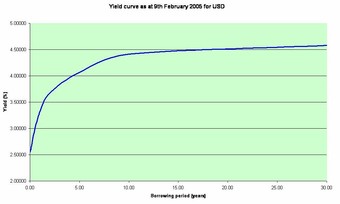
Yield Curve Example
This yield curve from 2005 demonstrates the projected yield over time of USD. As you can see, this is a typical yield curve shape, as the longer the contract is held out the higher the rate of return (with diminishing returns).
Relationship to the Business Cycle
Through assessing the slope of a yield curve on debt instruments such as governmental treasury bonds, investors can estimate the overall health of the economy in the future (i.e. inflation, interest rates, recessions, growth). Inverted yield curves are typically predictors of recession, while positively sloped yield curves indicate inflationary growth.
The Financial Stress Index
Defined as the rate of difference between a 10-year treasury bond rate and a 3-month treasury bond rate, the Financial Stress Index is a useful tool in projected future economic well-being. In fact, each of the recessionary periods since 1970 have demonstrated an inverted yield curve when subjected to Financial Stress Test just prior to that recessionary period.
Market Expectations (i.e. Pure Expectations)
When it comes to interest rates specifically, yield curves are useful constructs in projecting future behavior. The market expectations theory assumes that various maturities are perfect substitutes, and as a result the shape of the yield curve represents market expectations over time in relation to interest rates. In short, through investor expectations of what the 1-year interest rates will be next year, the current 2-year interest rate can be calculated as the compounding of this year’s 1-year interest rate by next year’s expected 1-year interest rate. Or, as an equation:
(ist and ilt are the expected short-term and actual long-term interest rates, respectively)
Heath-Jarrow-Morton Framework
When it comes to predicting future interest rates, the Heath-Jarrow-Morton framework is considered a standard approach. It focuses on modeling the evolution of the interest rate curve (instantaneous forward rate curve in particular). The equation itself is a rather evolved derivation, incorporating bond prices, forward rates, risk free rates, the Wiener process, Leibniz’s rule, and Fubini’s Theorem. While the details of this calculation are a bit outside the scope of discussion here, the equation can ultimately be described as:
For the sake of this discussion, it suffices to say that the input of existing yield curves is useful in projected future interest rates under a number of varying perspectives.
6.2.3: Macroeconomic Factors Influencing the Interest Rate
Taylor explained the rule of determining interest rates using three variables: inflation rate, GDP growth, and the real interest rate.
Learning Objective
Describe how the nominal interest rate is influenced by inflation, output, and other economic conditions
Key Points
- In economics, the Taylor rule is a monetary-policy rule that stipulates how much the Central Bank should change the nominal interest rate in response to changes in inflation, output, or other economic conditions.
- If the inflationary expectation goes up, then so does the market interest rate and vice versa.
- If output gap is positive, it is called an “inflationary gap,” possibly creating inflation, signaling a increase in interest rates made by the Central Bank; if output gap is negative, it is called a “recessionary gap,” possibly signifying deflation and a reduction in interest rates.
Key Terms
- Recessionary gap
-
An inflationary gap, in economics, is the amount by which the real Gross domestic product, or real GDP, is less than the potential GDP.
- Real interest rate
-
The “real interest rate” is the rate of interest an investor expects to receive after allowing for inflation. It can be described more formally by the Fisher equation, which states that the real interest rate is approximately the nominal interest rate minus the inflation rate.
- inflationary gap
-
An inflationary gap, in economics, is the amount by which the real gross domestic product, or real GDP, exceeds potential GDP.
Interest Rate Overview
An interest rate is the rate at which interest is paid by a borrower for the use of money that they borrow from a lender in the market. The interest rates are influenced by macroeconomic factors. In economics, a Taylor rule is a monetary-policy rule that stipulates how much the Central Bank should change the nominal interest rate in response to changes in inflation, output, or other economic conditions. In particular, the rule stipulates that for each 1% increase in inflation, the Central Bank should raise the nominal interest rate by more than one percentage point.
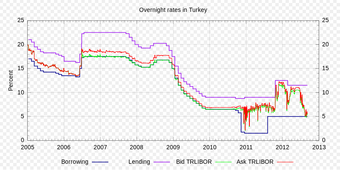
Interest Rates in Turkey
Overnight rates in Turkey are estimated to fall in 2013, indicating a loosened monetary policy.
Taylor Rule
According to Taylor’s original version of the rule, the nominal interest rate should respond to divergences of actual inflation rates from target inflation rates and of actual Gross Domestic Product (GDP) from potential GDP:
it = πt + r*t + απ(πt – π*t) + αy(yt – y*t)
In this equation, it is the target short-term nominal interest rate (e.g., the federal fund rates in the United States), πt is the rate of inflation as measured by the GDP deflator, π*t is the desired rate of inflation, r*t is the assumed equilibrium real interest rate, yt is the logarithm of real GDP, and y*t is the logarithm of potential output, as determined by a linear trend.
In other words, (πt – π*t)is inflation expectations that influence interest rates. Most economies generally exhibit inflation, meaning a given amount of money buys fewer goods in the future than it will now. The borrower needs to compensate the lender for this. If the inflationary expectation goes up, then so does the market interest rate and vice versa.
Output Gap
The GDP gap or the output gap is (yt – y*t). If this calculation yields a positive number, it is called an “inflationary gap” and indicates the growth of aggregate demand is outpacing the growth of aggregate supply (or high level of employment), possibly creating inflation, signaling an increase in interest rates made by the Central Bank; if the calculation yields a negative number it is called a “recessionary gap,” which is accompanied by a low employment rate, possibly signifying deflation and a reduction in interest rates.
In this equation, both απ and αy should be positive (as a rough rule of thumb, Taylor’s 1993 paper proposed setting απ =αy = 0.5). That is, the rule “recommends” a relatively high interest rate (a “tight” monetary policy) when inflation is above its target or when output is above its full-employment level, in order to reduce inflationary pressure. It recommends a relatively low interest rate (“easy” monetary policy) in the opposite situation to stimulate output.
Taylor explained the rule in simple terms using three variables: inflation rate, GDP growth, and the equilibrium real interest rate.
6.3: Key Characteristics of Bonds
6.3.1: Par Value
Par value is the amount of money a holder will get back once a bond matures; a bond can be sold at par, at premium, or discount.
Learning Objective
Assess when a bond should be sold at its par value
Key Points
- When a bond trades at a price above the face value, it is said to be selling at a premium. When a bond sells below face value, it is said to be selling at a discount.
- A bond’s price fluctuates throughout its life in response to a number of variables, including interest rates and time to maturity.
- Pull to par is the effect in which the price of a bond converges to par value as time passes. At maturity, the price of a debt instrument in good standing should equal its par (or face value).
Key Terms
- resale market
-
The resale market, also called “secondary market” or “aftermarket,” is the financial market in which previously issued financial instruments, such as stock, bonds, options, and futures, are bought and sold.
- par value
-
the stated value or amount of a bill or a note
Par value/face value (also known as the principal) is the amount of money a holder will get back once a bond matures. Par value means stated value or face value in finance and accounting. From this comes the expressions at par (at the par value), over par (over par value) and under par (under par value).
A newly issued bond usually sells at the par value. Corporate bonds normally have a par value of $1,000, but this amount can be much greater for government bonds. What confuses many people is that the par value is not the price of the bond. A bond’s price fluctuates throughout its life in response to a number of variables, including interest rates and time to maturity. When a bond trades at a price above the face value, it is said to be selling at a premium. When a bond sells below face value, it is said to be selling at a discount.

Temporary bonds for the state of Kansas issued in 1922
Par values of these bonds were $50, $100, $10000, and $3000.
Pull to par is the effect in which the price of a bond converges to par value as time passes. At maturity, the price of a debt instrument in good standing should equal its par (or face value). Another name for this effect is “reduction of maturity. ” It results from the difference between market interest rate and the nominal yield on the bond.
A bond selling at par has a coupon rate such that the bond is worth an amount equivalent to its original issue value or its value upon redemption at maturity. In other words, if you buy a bond at face value, or par, when it is issued and hold it until it matures, you’ll earn interest at the stated, or coupon, rate. For example, if you buy a 20-year $1,000 bond paying $550 a year for 20 years. The yield, or your return on investment, will also be 5%. You will get your $1,000 back when the 20 years are up. You can also buy and sell bonds through a broker after their date of issue. This is known as the “secondary market” or “resale market. “
6.3.2: Coupon Interest Rate
The coupon rate is the amount of interest that the bondholder will receive per payment, expressed as a percentage of the par value.
Learning Objective
Classify bonds based on coupon rate
Key Points
- Coupon interest rate is usually fixed throughout the life of the bond. It can also vary with a money market index.
- Not all bonds have coupons. Zero-coupon bonds are those that pay no coupons and thus have a coupon rate of 0%.
- Based on different coupon rates, there are fixed rate bonds, floating rate bonds, and inflation linked bonds.
Key Term
- time value of money
-
The value of money, figuring in a given amount of interest, earned over a given amount of time.
The coupon rate is the amount of interest that the bondholder will receive expressed as a percentage of the par value. Thus, if a bond has a par value of 1,000 and a coupon rate of 10,100 a year during the time between when the bond is issued and when it matures. Usually this rate is fixed throughout the life of the bond. It can also vary with a money market index, such as LIBOR, or it can be even more exotic. The bond will also specify when the interest is to be paid, whether monthly, quarterly, semi-annually, or annually.

Mecca Temple 1922 Bond Coupons
A coupon payment on a bond is a periodic interest payment that the bond holder receives during the time between when the bond is issued and when it matures.
The name “coupon” arose because in the past, paper bond certificates were issued that had coupons attached to them, one for each interest payment. On the due dates, the bondholder would hand in the coupon to a bank in exchange for the interest payment.
Not all bonds have coupons. Zero-coupon bonds are those that pay no coupons and thus have a coupon rate of 0%. Such bonds make only one payment–the payment of the face value on the maturity date. Normally, to compensate the bondholder for the time value of money, the price of a zero-coupon bond will always be less than its face value on any date before the maturity date. The bondholder receives the full principal amount on the redemption date. An example of zero coupon bonds is Series E savings bonds issued by the U.S. government.
Based on different coupon rates, bonds are classified into many types. Fixed-rate bonds have a coupon that remains constant throughout the life of the bond. A variation are stepped-coupon bonds, with a coupon that increases during the life of the bond.
Floating rate notes (FRNs, floaters) have a variable coupon that is linked to a reference rate of interest, such as LIBOR or Euribor. For example, the coupon may be defined as three month USD LIBOR + 0.20%. The coupon rate is recalculated periodically, typically every one or three months.
Inflation linked bonds (linkers), in which the principal amount and the interest payments are indexed to inflation. The interest rate is normally lower than for fixed rate bonds with a comparable maturity. However, as the principal amount grows, the payments increase with inflation. The United Kingdom was the first sovereign issuer to issue inflation linked Gilts in the 1980s. Treasury Inflation-Protected Securities (TIPS) and I-bonds are examples of inflation linked bonds issued by the U.S. government.
6.3.3: Maturity Date
Maturity date refers to the final payment date of a loan or other financial instrument.
Learning Objective
Define a US security based on its maturity date
Key Points
- As long as all due payments have been made, the issuer has no further obligations to the bond holders after the maturity date.
- The length of time until the maturity date is often referred to as the term or tenor or maturity of a bond.
- In the market for United States Treasury securities, there are three categories of bond maturities: short term, medium term, and long term.
Key Terms
- callable
-
A callable bond (also called “redeemable bond”) is a type of bond (debt security) that allows the issuer of the bond to retain the privilege of redeeming the bond at some point before the bond reaches its date of maturity.
- puttable
-
Puttable bond (put bond, putable, or retractable bond) is a bond with an embedded put option. The holder of the puttable bond has the right, but not the obligation, to demand early repayment of the principal.
In finance, maturity date or redemption date, refers to the final payment date of a loan or other financial instrument, at which point the principal (and all remaining interest) is due to be paid.

Austrian war bond
The first Austrian bonds had 5% rates of return and a five-year maturity.
The issuer has to repay the nominal amount on the maturity date. As long as all due payments have been made, the issuer has no further obligations to the bond holders after the maturity date. The length of time until the maturity date is often referred to as the term or tenor or maturity of a bond. The maturity can be any length of time, although debt securities with a term of less than one year are generally designated money market instruments rather than bonds. Most bonds have a term of up to 30 years. Some bonds have been issued with terms of 50 years or more and, historically, there have been some issues with no maturity date (irredeemables).
In the market for United States Treasury securities, there are three categories of bond maturities:
- short term (bills): maturities between 1 to 5 years (instruments with maturities less than one year are called “Money Market Instruments”);
- medium term (notes): maturities between 6 to 12 years; and
- long term (bonds): maturities greater than 12 years.
Normally the maturity of a bond is fixed. However, it is important to note that bonds are sometimes “callable,”which means that the issuer of the debt is able to pay back the principal at any time. In this case, the maturity date is the day when the bond is called. Thus, investors should inquire, before buying any fixed-income securities, whether the bond is callable or not. Bonds can also be puttable, meaning that the holder has the right, but not the obligation, to demand early repayment of the principal. Similarly, the maturity date, if applicable, is the date as the bond is redeemed.
6.3.4: Call Provisions
A callable bond allows the issuer to redeem the bond before the maturity date; this is likely to happen when interest rates go down.
Learning Objective
Classify a bond based on its call provision
Key Points
- A callable bond is a type of bond that allows the issuer of the bond to retain the privilege of redeeming the bond at some point before the bond reaches its date of maturity.
- If interest rates in the market have gone down by the time of the call date, the issuer will be able to refinance its debt at a cheaper level and so will be incentivized to call the bonds it originally issued.
- Most callable bonds allow the issuer to repay the bond at par. With some bonds, the issuer has to pay a premium, known as the call premium.
- Price of callable bond = Price of straight bond – Price of call option. Price of a callable bond is always lower than the price of a straight bond because the call option adds value to an issuer.
Key Terms
- par
-
Equal value; equality of nominal and actual value; the value expressed on the face or in the words of a certificate of value, as a bond or other commercial paper.
- straight bond
-
A straight bond is a bond with no embedded options (call or put options).
Occasionally a bond may contain an embedded option. That is, it grants option-like features to the holder or the issuer. A callable bond (also called redeemable bond) is a type of bond that allows the issuer of the bond to retain the privilege of redeeming the bond at some point before the bond reaches its date of maturity. In other words, on the call date, the issuer has the right, but not the obligation, to buy back the bonds from the bond holders at a defined call price. Technically speaking, the bonds are not really bought and held by the issuer. They are instead cancelled immediately.
Call dates are the dates on which callable bonds can be redeemed early.
There are three main categories.
- A Bermudan callable has several call dates, usually coinciding with coupon dates.
- A European callable has only one call date. This is a special case of a Bermudan callable.
- An American callable can be called at any time until the maturity date.
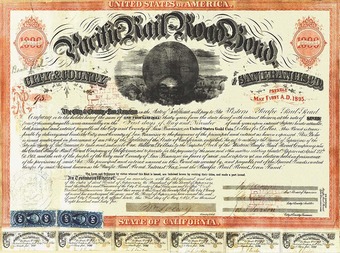
Redeemed Bonds
This Bond is one of the 400 issued to the Central Pacific Rail Road Company of California and 200 to the Western Pacific Rail Road Company in 1865 under the Act of the California Legislature passed on April 22, 1863. Coupon #1 was redeemed and cancelled on November 2, 1865, and coupon #35 on November 2, 1882, at which time the principal of $1,000.00 in gold coin was also paid from the Treasury of the City and County of San Francisco and the Bond was cancelled.
Most callable bonds allow the issuer to repay the bond at par. With some bonds, the issuer has to pay a premium, known as the call premium. This is mainly the case for high-yield bonds. These have very strict covenants, restricting the issuer in its operations. To be free from these covenants, the issuer can repay the bonds early, but only at a high cost.
The issuer has an option, for which it pays in the form of a higher coupon rate. If interest rates in the market have gone down by the time of the call date, the issuer will be able to refinance its debt at a cheaper level. The issuer will be incentivized to call the bonds it originally issued. Another way to look at this interplay is that as interest rates go down, the price of the bonds goes up. Therefore, it is advantageous to buy the bonds back at par value. With a callable bond, investors have the benefit of a higher coupon than they would have had with a straight, non-callable bond. On the other hand, if interest rates fall, the bonds will likely be called, and they can only invest at the lower rate.
The price behavior of a callable bond is the opposite of that of puttable bond. Since call option and put option are not mutually exclusive, a bond may have both options embedded.
Price of callable bond = Price of straight bond – Price of call option
Price of a callable bond is always lower than the price of a straight bond because the call option adds value to an issuer. Similarly, yield on a callable bond is higher than the yield on a straight bond.
6.3.5: Sinking Funds
A sinking fund is a method by which an organization sets aside money to retire debts.
Learning Objective
Describe how a sinking fund operates in regards to a bond issue
Key Points
- Sinking fund provision of the corporate bond indenture requires a certain portion of the issue to be retired periodically.
- A sinking fund reduces credit risk but presents reinvestment risk to bondholders.
- For the creditors, the fund reduces the risk the organization will default when the principal is due: it reduces credit risk. However, if the bonds are callable, this comes at a cost to creditors, because the organization has an option on the bonds.
Key Terms
- debentures
-
A debenture is a document that either creates a debt or acknowledges it, and it is a debt without collateral.
- Preferred Stock
-
Stock with a dividend, usually fixed, that is paid out of profits before any dividend can be paid on common stock. It also has priority to common stock in liquidation.
- call provision
-
the right for the issuer to buy back the bond at a predetermined price at a certain time in future
In modern finance, a sinking fund is a method by which an organization sets aside money over time to retire its indebtedness by repaying or purchasing outstanding loans and securities held against the entity. More specifically, it is a fund into which money can be deposited, so that over time preferred stock, debentures or stocks can be retired. Sinking funds can also be used to set aside money for purposes of replacing capital equipment as it becomes obsolete .

Farm bond
One purpose of a sinking fund is to repurchase outstanding bonds.
Sinking fund provision of the corporate bond indenture requires a certain portion of the issue to be retired periodically. The entire bond issue can be liquidated by the maturity date. Issuers may either pay to trustees, which in turn call randomly selected bonds in the issue, or, alternatively, purchase bonds in open market, then return them to trustees.
A sinking fund may operate in one or more of the following ways:
- The firm may repurchase a fraction of the outstanding bonds in the open market each year.
- The firm may repurchase a fraction of outstanding bonds at a special call price associated with the sinking fund provision (they are callable bonds).
- The firm has the option to repurchase the bonds at either the market price or the sinking fund price, whichever is lower. The firm can only repurchase a limited fraction of the bond issue at the sinking fund price. At best some indentures allow firms to use a doubling option, which allows repurchase of double the required number of bonds at the sinking fund price.
- A less common provision is to call for periodic payments to a trustee, with the payments invested so that the accumulated sum can be used for retirement of the entire issue at maturity: instead of the debt amortizing over the life, the debt remains outstanding and a matching asset accrues. Thus the balance sheet consists of Asset = Sinking fund, Liability = Bonds
For the creditors, the fund reduces the risk the organization will default when the principal is due: it reduces credit risk. However, if the bonds are callable, this comes at a cost to creditors, because the organization has an option on the bonds: The firm will choose to buy back discount bonds (selling below par) at their market price,while exercising its option to buy back premium bonds (selling above par) at par. Therefore, if interest rates fall and bond prices rise, a firm will benefit from the sinking fund provision that enables it to repurchase its bonds at below-market prices. In this case, the firm’s gain is the bondholder’s loss–thus callable bonds will typically be issued at a higher coupon rate, reflecting the value of the option.
6.3.6: Other Features
Other important features of bonds include the yield, market price and putability of a bond.
Learning Objective
Describe the effect a bond’s market price has on its yield
Key Points
- The yield is the rate of return received from investing in the bond. It usually refers either to the current yield, or to the yield to maturity or redemption yield.
- The market price of a tradeable bond will be influenced by the amounts, currency and timing of the interest payments and capital repayment due, the quality of the bond, and the available redemption yield of other comparable bonds which can be traded in the markets.
- Some bonds give the holder the right to force the issuer to repay the bond before the maturity date on the put dates. These are referred to as retractable or putable bonds.
Key Terms
- Yield to maturity
-
The internal rate of return on a bond held to maturity, assuming scheduled payment of principal and interest.
- clean price
-
the price of a bond excluding any interest that has accrued since issue or the most recent coupon payment.
Some other important features of bonds are presented below, namely the yield, market price and putability of a bond. “”

San Francisco Pacific Railroad Bond
$1,000 (30 year, 7%) “Pacific Railroad Bond” (#93 of 200) issued by the City and County of San Francisco under “An Act to Authorize the Board of Supervisors of the City and County of San Francisco to take and subscribe One Million Dollars to the Capital Stock of the Western Pacific Rail Road Company and the Central Pacific Rail Road Company of California and to provide for the payment of the same and other matters relating thereto” approved on April 22, 1863, as amended by section Five of the “Compromise Act” approved on April 4, 1864, to fund the construction of the Western Pacific Railroad between San Francisco Bay (at Alameda) and the CPRR of Cal. at Sacramento, dated May 1, 1865.
Yield
The yield is the rate of return received from investing in the bond. It usually refers either to the current yield, which is simply the annual interest payment divided by the current market price of the bond (often the clean price), or to the yield to maturity or redemption yield. Yield to maturity is a more useful measure of the return of the bond, taking into account the current market price, the amount and timing of all remaining coupon payments, and of the repayment due on maturity.
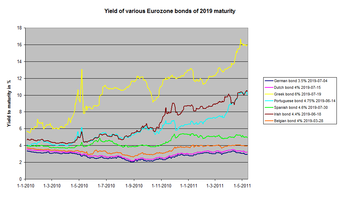
Eurozone Government Bonds Yield
Development of yield to maturity of bonds of 2019 maturity of a number of Eurozone governments.
Market Price
The market price of a tradeable bond will be influenced – amongst other things – by the amounts, currency and timing of the interest payments and capital repayment due; the quality of the bond; and the available redemption yield of other comparable bonds which can be traded in the markets. The price can be quoted as clean or dirty. “Dirty” refers to the actual price to be paid; while “clean” includes an adjustment for accrued interest. The issue price at which investors buy the bonds when they are first issued will typically be approximately equal to the nominal amount. The net proceeds that the issuer receives are thus the issue price, less issuance fees. The market price of the bond will vary over its life: it may trade at a premium (above par, usually because market interest rates have fallen since issue), or at a discount (below par, if market rates have risen or there is a high probability of default on the bond).
Putability
Some bonds give the holder the right to force the issuer to repay the bond before the maturity date on the put dates. These are referred to as retractable or putable bonds. Put dates are the dates on which putable bonds can be redeemed early. This type of bond protects investors: if interest rates rise after bond purchase, the future value of coupon payments will become less valuable. Therefore, investors sell bonds back to the issuer and may lend proceeds elsewhere at a higher rate. Bondholders are ready to pay for such protection by accepting a lower yield relative to that of a straight bond. A death put is an optional redemption feature on a debt instrument allowing the beneficiary of the estate of a deceased bondholder to put (sell) the bond (back to the issuer) at face value in the event of the bondholder’s death or legal incapacitation.
Price of puttable bond = Price of straight bond + Price of put option
Price of a puttable bond is always higher than the price of a straight bond because the put option adds value to an investor. Yield on a puttable bond is lower than the yield on a straight bond.
6.4: Understanding Bonds
6.4.1: The Nature of Bonds
A bond is an instrument of indebtedness of the bond issuer to the holders.
Learning Objective
Distinguish the various types of bonds from other types of securities
Key Points
- A bond is an instrument of indebtedness of the bond issuer to the holders. The issuer owes the holders a debt and, depending on the terms of the bond, is obliged to pay them interest (the coupon) and/or to repay the principal at a later date, termed the maturity.
- Bonds provide the borrower with external funds to finance long-term investments, or, in the case of government bonds, to finance current expenditure.
- Bonds and stocks are both securities, but the major difference between the two is that (capital) stockholders have an equity stake in the company (i.e. they are owners), whereas bondholders have a creditor stake in the company (i.e. they are lenders).
Key Terms
- municipal bonds
-
A municipal bond is a bond issued by an American city or other local government, or their agencies.
- Treasury bonds
-
A United States Treasury bond is a government debt issued by the United States Department of the Treasury through the Bureau of the Public Debt, with a maturity of 20 years to 30 years.
- corporate bonds
-
A corporate bond is a bond issue by a corporation. It is a bond that a corporation issues to raise money effectively in order to expand its business.
Nature of Bonds
A bond is an instrument of indebtedness of the bond issuer to the holders, as such it is often referred to as a debt instrument. A bond is a debt security, under which the issuer owes the holders a debt and, depending on the terms of the bond, is obliged to pay them interest (the coupon) and/or repay the principal at a later date, termed the maturity. Interest is usually payable at fixed intervals (semiannual, annual, sometimes monthly).
Bonds are issued by public authorities, credit institutions, companies, and supranational institutions in the primary market. Both individuals and companies can purchase bonds.
However, very often the bond is negotiable, i.e. the ownership of the instrument can be transferred in the secondary market .

A bond from the Dutch East India Company
A bond is a financial security that represents a promise by a company or government to repay a certain amount, with interest, to the bondholder.
Types of Bonds
The main categories of bonds are corporate bonds, municipal bonds, and U.S. Treasury bonds, notes, and bills, which are collectively referred to simply as “Treasuries. ” Two features of a bond – credit quality and duration – are the principal determinants of a bond’s interest rate. Bond maturities range from a 90-day Treasury bill to a 30-year government bond. Corporate and municipal bonds are typically in the three to 10-year range.
Overview of the Instrument
A bond is a form of loan: the holder of the bond is the lender (creditor), the issuer of the bond is the borrower (debtor), and the coupon is the interest. Bonds provide the borrower with external funds to finance long-term investments, or, in the case of government bonds, to finance current expenditure. Certificates of deposits (CDs), or short term commercial papers, are considered to be money market instruments and not bonds: the main difference is in the instruments length of term.
Bonds and stocks are both securities, but the major difference between the two is that (capital) stockholders have an equity stake in the company (they are owners), whereas bondholders have a creditor stake in the company (they are lenders). Another difference is that bonds usually have a defined term, or maturity, after which the bond is redeemed, whereas stocks may be outstanding indefinitely. An exception is an irredeemable bond, such as Consols, which is a perpetuity, that is, a bond with no maturity.
6.4.2: Duration
Duration is the weighted average of the times until fixed cash flows of a financial asset are received.
Learning Objective
Define the different types of duration
Key Points
- A good approximation for bond price changes due to yield is the duration, a measure for interest rate risk.
- The Macaulay duration is the name given to the weighted average time until cash flows are received and is measured in years. It really makes sense only for an instrument with fixed cash flows.
- The modified duration is the name given to the price sensitivity and is the percentage change in price for a unit change in yield. It really makes sense only for an instrument with fixed cash flows.
- The modified duration is a derivative (rate of change) or price sensitivity and measures the percentage rate of change of price with respect to yield. The concept of modified duration can be applied to interest-rate sensitive instruments with non-fixed cash flows.
Key Terms
- Convexity
-
As interest rates change, the price does not change linearly, but rather is a convex function of interest rates. Convexity is a measure of the curvature of how the price of a bond changes as the interest rate changes. Specifically, duration can be formulated as the first derivative of the price function of the bond with respect to the interest rate in question, and the convexity as the second derivative.
- Yield to maturity
-
The yield to maturity (YTM) of a bond or other fixed-interest security, such as gilts, is the internal rate of return (IRR, overall interest rate) earned by an investor who buys the bond today at the market price, assuming that the bond will be held until maturity and that all coupon and principal payments will be made on schedule.
Duration
In finance, the duration of a financial asset that consists of fixed cash flows, for example a bond, is the weighted average of the times until those fixed cash flows are received. When an asset is considered as a function of yield, duration also measures the price sensitivity to yield, the rate of change of price with respect to yield, or the percentage change in price for a parallel shift in yields. Since cash flows for bonds are usually fixed, a price change can come from two sources: The passage of time (convergence towards par) which is predictable and a change in the yield.
The yield-price relationship is inverse and investors would ideally wish to have a measure of how sensitive the bond price is to yield changes. A good approximation for bond price changes due to yield is the duration, a measure for interest rate risk. For large yield changes convexity can be added to improve the performance of the duration. A more important use of convexity is that it measures the sensitivity of duration to yield changes.
Types of Durations
The dual use of the word “duration” in the Macaulay duration and the modified duration, as both the weighted average time until repayment and as the percentage change in price, often causes confusion. The Macaulay duration is the name given to the weighted average time until cash flows are received and is measured in years.

Macaulay duration
The Macaulay duration is the name given to the weighted average time until cash flows are received and is measured in years.
Where: i indexes the cash flows, PVi is the present value of the cash payment from an asset, ti is the time in years until the payment will be received, and V is the present value of all cash payments from the asset.
The Modified duration is the name given to the price sensitivity and is the percentage change in price for a unit change in yield.

Modified duration
The modified duration is the name given to the price sensitivity and is the percentage change in price for a unit change in yield.
Where: k is the compounding frequency per year (1 for annual, 2 for semi-annual, 12 for monthly, 52 for weekly, and so on), y is the is the yield to maturity for an asset.
When yields are continuously-compounded the Macaulay duration and the modified duration will be numerically equal. When yields are periodically-compounded the Macaulay duration and the modified duration will differ slightly and in this case there is a simple relation between the two. The modified duration is used more than the Macaulay duration.
The Macaulay duration and the modified duration are both termed “duration” and have the same (or close to the same) numerical value, but it is important to keep in mind the conceptual distinctions between them. The Macaulay duration is a time measure with units in years and really makes sense only for an instrument with fixed cash flows. For a standard bond, the Macaulay duration will be between 0 and the maturity of the bond. It is equal to the maturity if and only if the bond is a zero-coupon bond.
The modified duration, on the other hand, is a derivative (rate of change) or price sensitivity and measures the percentage rate of change of price with respect to yield. The concept of modified duration can be applied to interest-rate sensitive instruments with non-fixed cash flows and can thus be applied to a wider range of instruments than can the Macaulay duration. For everyday use, the equality (or near-equality) of the values for the Macaulay duration and the modified duration can be a useful aid to intuition.
6.4.3: Indenture
A bond indenture is a legal contract issued to lenders that defines commitments and responsibilities of the seller and the buyer.
Learning Objective
Review the rights and responsibilities of parties to a bond
Key Points
- Terms of indentures include the interest rate, maturity date, repayment dates, convertibility, pledge, promises, representations, covenants, and other terms of the bond offering.
- A bond indenture is held by a trustee. If the company fails to live up to the terms of the bond indenture, the trustee may bring legal action against the company on behalf of the bondholders.
- The offering memorandum, also known as a prospectus, is a document that describes a financial security for potential buyers.
Key Terms
- convertibility
-
Quality of a bond that allows the holder to convert into shares of common stock in the issuing company or cash of equal value, at an agreed-upon price.
- indenture
-
a document, written as duplicates separated by indentations, specifying such a contract
- public debt offerings
-
A public debt offering is the offering of debt securities of a government, a company or a similar corporation to the public.
A bond indenture (also called a trust indenture or deed of trust) is a legal contract issued to lenders. The specifications given within the bond indenture define the responsibilities and commitments of the seller as well as those of the buyer by describing key terms such as the interest rate, maturity date, repayment dates, convertibility, pledge, promises, representations, covenants, and other terms of the bond offering. Failure to meet the payment requirements calls for drastic penalties, including liquidation of the issuer’s assets .

Indenture
Bond indenture (also trust indenture or deed of trust) is a legal contract issued to lenders.
Because it would be impractical for the corporation to enter into a direct agreement with each of the many bondholders, the bond indenture is held by a trustee – usually a commercial bank or other financial institution – appointed by the issuing firm to represent the rights of the bondholders. The issuer of a bond will use the indenture to describe detail about the issuer and the bond trustee for interested investors to research the background of the bond issue. This is to ensure that the bondholder has a clear idea of when to expect interest payments, as well as whom to contact if he or she has questions or concerns. If the company fails to live up to the terms of the bond indenture, the trustee may bring legal action against the company on behalf of the bondholders.
When the offering memorandum is prepared in advance of marketing a bond, the indenture will typically be summarized in the “description of notes” section. This offering memorandum, also known as a prospectus, is a document that describes a financial security for potential buyers. A prospectus commonly provides investors with material information about mutual funds, stocks, bonds, and other investments, such as a description of the company’s business, financial statements, biographies of officers and directors, detailed information about their compensation, any litigation that is taking place, a list of material properties, and any other material information.
In the United States, public debt offerings in excess of $10 million require the use of an indenture of trust under the Trust Indenture Act of 1939. The rationale for this is that it is necessary to establish a collective action mechanism under which creditors can collect in a fair, orderly manner if default takes place (like that which occurs during bankruptcy).
6.4.4: Ratings
Bond credit rating agencies assess and report the credit worthiness of a corporation’s or government’s debt issues.
Learning Objective
Use the ratings system to assess the risk associated with different bonds
Key Points
- Ratings play a critical role in determining how much companies and other entities that issue debt, including sovereign governments, have to pay to access credit markets; for example, the amount of interest they pay on their issued debt.
- The ratings are assigned by credit rating agencies such as Moody’s, Standard & Poor’s, and Fitch. Ratings to have letter designations (such as AAA, B, CC), which represent the quality of a bond.
- A bond is considered investment-grade (IG) if its credit rating is BBB- or higher by Standard & Poor’s, or Baa3 or higher by Moody’s, or BBB(low) or higher by DBRS. Bond ratings below BBB/Baa are not considered to be investment grade; such bonds are called junk bonds.
Key Term
- credit rating agencies
-
A credit rating agency (CRA) is a company that assigns credit ratings to issuers of certain types of debt obligations, as well as to the debt instruments themselves.
Ratings Overview
In investment, the bond credit rating assesses the credit worthiness of a corporation’s or government’s debt issue. The credit rating is analogous to a credit rating for individuals. The “quality” of the issue refers to the probability that the bondholders will receive the amounts promised on the due dates.
The credit rating is a financial indicator to potential investors of debt securities, such as bonds. Ratings play a critical role in determining the amount that companies (and other entities that issue debt, including sovereign governments) have to pay to access credit markets; for example, the amount of interest that must be paid on issued debt. The ratings are assigned by credit rating agencies, such as Moody’s, Standard & Poor’s, and Fitch Ratings, and are given in letter designations (AAA, B, CC), which represent the quality of a bond. Generally they are bonds that are judged by the rating agency as likely enough to meet payment obligations; banks are thus allowed to invest in them. “”
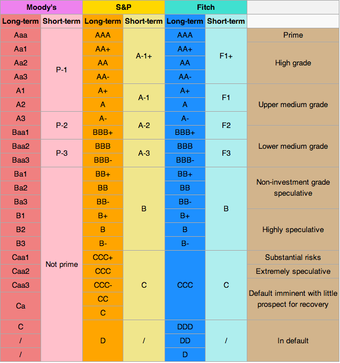
Credit Rating Equivalents
Credit ratings are used to report on the credit worthiness of a bond issuing company or government
Investment-grade Bonds
A bond is considered investment-grade, or IG, if its credit rating is BBB- or higher by Standard & Poor’s, or Baa3 or higher by Moody’s, or BBB(low) or higher by DBRS.
Bond ratings below BBB/Baa are not considered to be investment-grade; these bonds are called junk bonds. Junk bonds are also called high-yield bonds. These are bonds that are rated below investment grade by the credit rating agencies. As these bonds are more risky than investment grade bonds, investors expect them to earn a higher yield. The threshold between investment-grade and speculative-grade ratings has important market implications for issuers’ borrowing costs.
The risks associated with investment-grade bonds (or investment-grade corporate debt) are considered significantly higher than those associated with first-class government bonds. The difference between rates for first-class government bonds and investment-grade bonds is called “investment-grade spread. ” The range of this spread is an indicator of the market’s belief in the stability of the economy. The higher these investment-grade spreads (or risk premiums) are, the weaker the economy is considered.
Rating Agency Criticism
Until the early 1970s, bond credit ratings agencies were paid for their work by investors who wanted impartial information on the credit worthiness of securities issuers and their particular offerings. Starting in the early 1970s, the “Big Three” ratings agencies (S&P, Moody’s, and Fitch) began to receive payment for their work by the securities issuers for whom they issued ratings, which led to current charges that these ratings agencies can no longer always be impartial when issuing ratings for securities issuers. Securities issuers have been accused of “shopping” for the best ratings from S&P, Moody’s, and Fitch, in order to attract investors, until at least one of the agencies delivers favorable ratings.
6.5: Advantages and Disadvantages of Bonds
6.5.1: Advantages of Bonds
Bonds have some advantages over stocks, including relatively low volatility, high liquidity, legal protection, and a variety of term structures.
Learning Objective
Discuss the advantages of owning a bond
Key Points
- Bonds are a debt security under which the issuer owes the holders a debt and, depending on the terms of the bond, is obliged to pay them interest (the coupon) and or repay the principal at a later date, which is termed the maturity.
- The volatility of bonds (especially short and medium dated bonds) is lower than that of equities (stocks). Thus bonds are generally viewed as safer investments than stocks.
- Bonds are often liquid – it is often fairly easy for an institution to sell a large quantity of bonds without affecting the price much.
- Bondholders also enjoy a measure of legal protection: under the law of most countries, if a company goes bankrupt, its bondholders will often receive some money back (the recovery amount).
- There are also a variety of bonds to fit different needs of investors.
Key Terms
- inflation-linked bonds
-
Inflation-indexed bonds (also known as inflation-linked bonds or colloquially as linkers) are bonds where the principal is indexed to inflation. They are thus designed to cut out the inflation risk of an investment.
- Zero coupon bonds
-
A zero-coupon bond (also called a discount bond or deep discount bond) is a bond bought at a price lower than its face value, with the face value repaid at the time of maturity.
- Convertible bonds
-
A convertible bond is a type of bond that the holder can convert into shares of common stock in the issuing company or cash of equal value, at an agreed-upon price.
Definition and Purpose of a Bond
In finance, a bond is an instrument of indebtedness of the bond issuer to the holders. It is a debt security under which the issuer owes the holders a debt and, depending on the terms of the bond, is obliged to pay them interest (the coupon). In addition, the issuer might have to repay the principal at a later date, which is termed the maturity. Interest is usually payable at fixed intervals (semiannual, annual, and sometimes monthly). Very often the bond is negotiable; in other words, the ownership of the instrument can be transferred in the secondary market.

San Francisco Pacific Railroad Bond
A bond is an instrument of indebtedness of the bond issuer to the holders. It is a debt security under which the issuer owes the holders a debt and, depending on the terms of the bond, is obliged to pay them interest (the coupon). In addition, the issuer might have to repay the principal at a later date, which is termed the maturity.
Bonds are bought and traded mostly by institutions like central banks, sovereign wealth funds, pension funds, insurance companies, hedge funds, and banks. Insurance companies and pension funds have liabilities, which essentially include fixed amounts payable on predetermined dates. They buy the bonds to match their liabilities and may be compelled by law to do this. Most individuals who want to own bonds do so through bond funds. Still, in the U.S., nearly 10% of all outstanding bonds are held directly by households.
Advantages of Bonds
Bonds have a clear advantage over other securities. The volatility of bonds (especially short and medium dated bonds) is lower than that of equities (stocks). Thus bonds are generally viewed as safer investments than stocks. In addition, bonds do suffer from less day-to-day volatility than stocks, and the interest payments of bonds are sometimes higher than the general level of dividend payments.
Bonds are often liquid. It is often fairly easy for an institution to sell a large quantity of bonds without affecting the price much, which may be more difficult for equities. In effect, bonds are attractive because of the comparative certainty of a fixed interest payment twice a year and a fixed lump sum at maturity.
Bondholders also enjoy a measure of legal protection: under the law of most countries, if a company goes bankrupt, its bondholders will often receive some money back (the recovery amount), whereas the company’s equity stock often ends up valueless. Furthermore, bonds come with indentures (an indenture is a formal debt agreement that establishes the terms of a bond issue) and covenants (the clauses of such an agreement). Covenants specify the rights of bondholders and the duties of issuers, such as actions that the issuer is obligated to perform or is prohibited from performing.
There are also a variety of bonds to fit different needs of investors, including fixed rated bonds, floating rate bonds, zero coupon bonds, convertible bonds, and inflation linked bonds.
6.5.2: Disadvantages of Bonds
Bonds are subject to risks such as the interest rate risk, prepayment risk, credit risk, reinvestment risk, and liquidity risk.
Learning Objective
Discuss the disadvantages of owning a bond
Key Points
- A bond is an instrument of indebtedness of the bond issuer to the holders. It is a debt security under which the issuer owes the holders a debt and, depending on the terms of the bond, is obliged to pay them interest and possibly repay the principal at a later date, which is termed the maturity.
- Fixed rate bonds are subject to interest rate risk, meaning that their market prices will decrease in value when the generally prevailing interest rates rise.
- Bonds are also subject to various other risks such as call and prepayment risk, credit risk, reinvestment risk, liquidity risk, event risk, exchange rate risk, volatility risk, inflation risk, sovereign risk, and yield curve risk.
- A company’s bondholders may lose much or all their money if the company goes bankrupt. There is no guarantee of how much money will remain to repay bondholders.
- Some bonds are callable. This creates reinvestment risk, meaning the investor is forced to find a new place for his money. As a consequence, the investor might not be able to find as good a deal, especially because this usually happens when interest rates are falling.
Key Terms
- Reinvestment risk
-
The reinvestment risk is the possibility that the investor might be forced to find a new place for his money. As a consequence, the investor might not be able to find as good a deal, especially because this usually happens when interest rates are falling.
- Exchange rate risk
-
The exchange rate risk is a financial risk posed by an exposure to unanticipated changes in the exchange rate between two currencies.
Definition and Purpose of a Bond
A bond is a debt owed by the enterprise to the bondholder. Commercial bonds are normally issued in units of 1,000 dollars. Bondholders receive regular interest on their investment, depending on the terms of the bond. As a safe security, bonds are widely bought and traded by financial institutions. However, bonds have certain disadvantages.
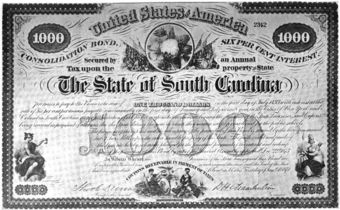
Bond
A bond is a debt owned by the enterprise to the bondholder.
Fixed rate bonds are subject to interest rate risk, meaning that their market prices will decrease in value when the generally prevailing interest rates rise. Since the payments are fixed, a decrease in the market price of the bond means an increase in its yield. When the market interest rate rises, the market price of bonds will fall, reflecting the ability of investors to get a higher interest rate on their money elsewhere — perhaps by purchasing a newly issued bond that already features the newly higher interest rate.
Disadvantages of Bonds
Bonds are also subject to various other risks such as call and prepayment risk, credit risk, reinvestment risk, liquidity risk, event risk, exchange rate risk, volatility risk, inflation risk, sovereign risk, and yield curve risk.
Price changes in a bond will immediately affect mutual funds that hold these bonds. If the value of the bonds in a trading portfolio falls, the value of the portfolio also falls. This can be damaging for professional investors such as banks, insurance companies, pension funds, and asset managers (irrespective of whether the value is immediately “marked to market” or not). If there is any chance a holder of individual bonds may need to sell his bonds and “cash out”, the interest rate risk could become a real problem.
Bond prices can become volatile depending on the credit rating of the issuer – for instance if credit rating agencies like Standard and Poor’s and Moody’s upgrade or downgrade the credit rating of the issuer. An unanticipated downgrade will cause the market price of the bond to fall. As with interest rate risk, this risk does not affect the bond’s interest payments (provided the issuer does not actually default), but puts at risk the market price, which affects mutual funds holding these bonds, and holders of individual bonds who may have to sell them.
A company’s bondholders may lose much or all their money if the company goes bankrupt. Under the laws of many countries (including the United States and Canada), bondholders are in line to receive the proceeds of the sale of the assets of a liquidated company ahead of some other creditors. Bank lenders, deposit holders (in the case of a deposit taking institution such as a bank) and trade creditors may take precedence. There is no guarantee of how much money will remain to repay bondholders. In a bankruptcy involving reorganization or recapitalization, as opposed to liquidation, bondholders may end up having the value of their bonds reduced, often through an exchange for a smaller number of newly issued bonds.
Some bonds are callable, meaning that even though the company has agreed to make payments plus interest toward the debt for a certain period of time, the company can choose to pay off the bond early. This creates reinvestment risk, meaning the investor is forced to find a new place for his money. As a consequence, the investor might not be able to find as good a deal, especially because this usually happens when interest rates are falling.
6.6: Types of Bonds
6.6.1: Government Bonds
A government bond is a bond issued by a national government denominated in the country’s domestic currency.
Learning Objective
Analyze the risks and characteristics of government bonds
Key Points
- A government bond is a bond issued by a national government, generally promising to pay a certain amount (the face value) on a certain date, as well as periodic interest payments. Such bonds are often denominated in the country’s domestic currency.
- In the primary market, Government Bonds are often issued via auctions at Stock Exchanges. In the secondary market, government bonds are traded at Stock Exchanges.
- Although, government bonds are usually referred to as risk-free, there are currency, inflation, and default risks for government bondholders.
Key Terms
- purchasing power
-
Purchasing power (sometimes retroactively called adjusted for inflation) is the amount of goods or services that can be purchased with a unit of currency.
- purchasing power parity
-
a theory of long-term equilibrium exchange rates based on relative price levels of two countries
A government bond is a bond issued by a national government, generally promising to pay a certain amount (the face value) on a certain date as well as periodic interest payments. Such bonds are often denominated in the country’s domestic currency. Government bonds are sometimes regarded as risk-free bonds because national governments can raise taxes or reduce spending up to a certain point. In many cases, they “print more money” to redeem the bond at maturity. Most developed country governments are prohibited by law from printing money directly, that function having been relegated to their central banks. However, central banks may buy government bonds in order to finance government spending, thereby monetizing the debt .

Government Bond
The short-term bond of Kolchak government in 1919 with a face value of 500 rubles.
Bonds issued by national governments in foreign currencies are normally referred to as sovereign bonds. Investors in sovereign bonds denominated in foreign currency have the additional risk that the issuer may be unable to obtain foreign currency to redeem the bonds. For example, in the 2010 Greek debt crisis the debt was held by Greece in Euros. One proposed solution was for Greece to go back to issuing its own Drachma.
In the primary market, Government Bonds are often issued via auctions at Stock Exchanges. There are several different methods of issuing such as auctions, including guarantee, combined auction and guarantee, and others. There are two types of interest rates: fixed and floating. In the secondary market, government bonds are traded at Stock Exchanges. Unlikely equity system, the bond secondary market uses a completely different system with different method of trading. At the secondary market, each bond will be assigned with very own bond code (ISIN code).
Government bonds are usually referred to as risk-free bonds because the government can raise taxes or create additional currency in order to redeem the bond at maturity. Some counter examples do exist where a government has defaulted on its domestic currency debt, such as Russia in 1998 (the “ruble crisis”), although this is very rare (see national bankruptcy). Another example is Greece in 2011. Its bonds were considered very risky, in part because Greece did not have its own currency.
There is currency risk for government bondholders. As an example, in the U.S., Treasury securities are denominated in U.S. dollars. In this instance, the term “risk-free” means free of credit risk. However, other risks still exist, such as currency risk for foreign investors (for example non-U.S. investors of U.S. Treasury securities would have received lower returns in 2004 because the value of the U.S. dollar declined against most other currencies). Secondly, there is inflation risk, in that the principal repaid at maturity will have less purchasing power than anticipated if the inflation rate is higher than expected. Many governments issue inflation-indexed bonds, which protect investors against inflation risk by increasing the interest rate given to the investor as the inflation rate of the economy increases.
6.6.2: Zero-Coupon Bonds
A zero-coupon bond is a bond with no coupon payments, bought at a price lower than its face value, with the face value repaid at the time of maturity.
Learning Objective
Distinguish zero coupon bonds from other types
Key Points
- Zero-coupon bonds may be created from fixed rate bonds by a financial institution separating (“stripping off”) the coupons from the principal. In other words, the separated coupons and the final principal payment of the bond may be traded separately.
- Zero coupon bonds have a duration equal to the bond’s time to maturity, which makes them sensitive to any changes in the interest rates.
- Pension funds and insurance companies like to own long maturity zero-coupon bonds since these bonds’ prices are particularly sensitive to changes in the interest rate and, therefore, offset or immunize the interest rate risk of these firms’ long-term liabilities.
Key Terms
- immunize
-
In finance, interest rate immunization is a strategy that ensures that a change in interest rates will not affect the value of a portfolio. Similarly, immunization can be used to ensure that the value of a pension fund’s or a firm’s assets will increase or decrease in exactly the opposite amount of their liabilities, thus leaving the value of the pension fund’s surplus or firm’s equity unchanged, regardless of changes in the interest rate.
- Pension funds
-
A pension fund is any plan, fund, or scheme which provides retirement income.
Zero coupon bonds were first introduced in 1960s, but they did not become popular until the 1980s. A zero-coupon bond (also called a “discount bond” or “deep discount bond”) is a bond bought at a price lower than its face value, with the face value repaid at the time of maturity. It does not make periodic interest payments, or have so-called “coupons,” hence the term zero-coupon bond. When the bond reaches maturity, its investor receives its par (or face) value. Examples of zero-coupon bonds include U.S. Treasury bills, U.S. savings bonds, and long-term zero-coupon bonds.
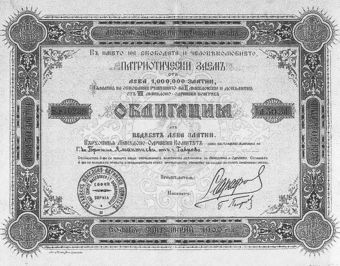
SMAC bond
Bond on VMOK with the signature on Boris Saraf.
Zero-coupon bonds may be created from fixed rate bonds by a financial institution separating (“stripping off”) the coupons from the principal. In other words, the separated coupons and the final principal payment of the bond may be traded separately. Investment banks or dealers separate coupons from the principal of coupon bonds, which is known as the “residue,” so that different investors may receive the principal and each of the coupon payments. This creates a supply of new zero coupon bonds. The coupons and residue are sold separately to investors. Each of these investments then pays a single lump sum. This method of creating zero coupon bonds is known as stripping, and the contracts are known as strip bonds. “STRIPS” stands for Separate Trading of Registered Interest and Principal Securities.
Zero coupon bonds may be long- or short-term investments. Long-term zero coupon maturity dates typically start at 10 to 15 years. The bonds can be held until maturity or sold on secondary bond markets. Short-term zero coupon bonds generally have maturities of less than one year and are called bills. The U.S. Treasury bill market is the most active and liquid debt market in the world.
Zero coupon bonds have a duration equal to the bond’s time to maturity, which makes them sensitive to any changes in the interest rates. The impact of interest rate fluctuations on strip bonds is higher than for a coupon bond.
Pension funds and insurance companies like to own long maturity zero-coupon bonds because of the bonds’ high duration. This high duration means that these bonds’ prices are particularly sensitive to changes in the interest rate and, therefore, offset or immunize the interest rate risk of these firms’ long-term liabilities.
6.6.3: Floating-Rate Bonds
Floating rate bonds are bonds that have a variable coupon equal to a money market reference rate (e.g., LIBOR), plus a quoted spread.
Learning Objective
Describe a floating-rate bond
Key Points
- FRBs are typically quoted as a spread over the reference rate. At the beginning of each coupon period, the coupon is calculated by taking the fixing of the reference rate for that day and adding the spread. A typical coupon would look like three months USD LIBOR +0.20%.
- FRBs carry little interest rate risk. A FRB has a duration close to zero, and its price shows very low sensitivity to changes in market rates. As FRBs are almost immune to interest rate risk. The risk that remains is a credit risk.
- Securities dealers make markets in FRBs. They are traded over the counter, instead of on a stock exchange. In Europe, most FRBs are liquid, as the biggest investors are banks. In the United States, FRBs are mostly held to maturity, so the markets aren’t as liquid.
Key Terms
- duration
-
A measure of the sensitivity of the price of a financial asset to changes in interest rates, computed for a simple bond as a weighted average of the maturities of the interest and principal payments associated with it
- LIBOR
-
The London Interbank Offered Rate is the average interest rate estimated by leading banks in London that they would be charged if borrowing from other banks.
- floating-rate bond
-
a debt instruments with a variable coupon
Floating rate bonds (FRBs) are bonds that have a variable coupon, equal to a money market reference rate, like LIBOR or federal funds rate, plus a quoted spread (i.e., quoted margin). The spread is a rate that remains constant. Almost all FRBs have quarterly coupons (i.e., they pay out interest every three months), though counter examples do exist. At the beginning of each coupon period, the coupon is calculated by taking the fixing of the reference rate for that day and adding the spread. A typical coupon would look like three months USD LIBOR +0.20%.
In the United States, government sponsored enterprises (GSEs), such as the Federal Home Loan Banks, the Federal National Mortgage Association (Fannie Mae), and the Federal Home Loan Mortgage Corporation (Freddie Mac), are important issuers. In Europe, the main issuers are banks.

Municipal bond
Municipal bond issued in 1929 by city of Kraków (Poland).
There are many variations of floating-rate bonds. For instance, some FRBs have special features, such as maximum or minimum coupons, called “capped FRBs” and “floored FRBs. ” Those with both minimum and maximum coupons are called collared FRBs. Perpetual FRBs are another form of FRBs that are also called irredeemable or unrated FRBs and are akin to a form of capital. FRBs can also be obtained synthetically by the combination of a fixed rate bond and an interest rate swap. This combination is known as an “asset swap. “
FRBs carry little interest rate risk. A FRB has a duration close to zero, and its price shows very low sensitivity to changes in market rates. When market rates rise, the expected coupons of the FRB increase in line with the increase in forward rates, which means its price remains constant. Thus, FRBs differ from fixed rate bonds, whose prices decline when market rates rise. As FRBs are almost immune to interest rate risk, they are considered conservative investments for investors who believe market rates will increase. The risk that remains is credit risk.
Securities dealers make markets in FRBs. They are traded over the counter, instead of on a stock exchange. In Europe, most FRBs are liquid, as the biggest investors are banks. In the United States, FRBs are mostly held to maturity, so the markets aren’t as liquid. In the wholesale markets, FRBs are typically quoted as a spread over the reference rate.
6.6.4: Other Types of Bonds
Other bonds include register vs. bearer bonds, convertible bonds, exchangeable bonds, asset-backed securities, and foreign currency bonds.
Learning Objective
Classify the different types of bonds
Key Points
- Bonds directly linked to interest rates include fixed rate bonds, floating rate bonds, and zero coupon bonds.
- Convertible bonds are bonds that let a bondholder exchange a bond to a number of shares of the issuer’s common stock. Exchangeable bonds allows for exchange to shares of a corporation other than the issuer.
- Asset-backed securities are bonds whose interest and principal payments are backed by underlying cash flows from other assets.
- Subordinated bonds are those that have a lower priority than other bonds of the issuer in case of liquidation.
- Foreign currency bonds are issued by companies, banks, governments, and other sovereign entities in foreign currencies, as it may appear to be more stable and predictable than their domestic currency.
Key Terms
- gross domestic product
-
A measure of the economic production of a particular territory in financial capital terms over a specific time period.
- tranches
-
One of a number of related securities offered as part of the same transaction.
- LIBOR
-
The London Interbank Offered Rate is the average interest rate estimated by leading banks in London that they would be charged if borrowing from other banks.
General Categorization
Based on coupon interest rates, bonds can be classified into
- Fixed rate bonds
- Floating rate bonds
- Zero-coupon bonds
Fixed rate bonds have a coupon that remains constant throughout the life of the bond. A variation is a stepped-coupon bonds, whose coupon increases during the life of the bond.
Floating rate notes (FRNs, floaters) have a variable coupon that is linked to a reference rate of interest, such as LIBOR or Euribor. For example the coupon may be defined as three month USD LIBOR + 0.20%. The coupon rate is recalculated periodically, typically every one or three months.
Zero-coupon bonds pay no regular interest. They are issued at a substantial discount to par value, so that the interest is effectively rolled up to maturity (and usually taxed as such). The bondholder receives the full principal amount on the redemption date. Zero-coupon bonds may be created from fixed rate bonds by a financial institution separating (“stripping off”) the coupons from the principal. In other words, the separated coupons and the final principal payment of the bond may be traded separately .

Government Bond
Bond of National Loan issued by Polish National Government in 1863.
Additional Types
There are additional special classes of bonds, including:
Inflation linked bonds (linkers) are those in which the principal amount and the interest payments are indexed to inflation. It is one type of floating rate bond. The interest rate is normally lower than for fixed rate bonds, with a comparable maturity. However, as the principal amount grows, the payments increase with inflation. Treasury Inflation-Protected Securities (TIPS) and I-bonds are examples of inflation linked bonds issued by the U.S. government. There are also other indexed bonds. For example equity-linked notes and bonds indexed on a business indicator (income, added value) or on a country’s gross domestic product (GDP).
Convertible bonds are bonds that let a bondholder exchange a bond for a number of shares of the issuer’s common stock. Exchangeable bonds allows for exchange to shares of a corporation other than the issuer.
Asset-backed securities are bonds whose interest and principal payments are backed by underlying cash flows from other assets. Examples of asset-backed securities are mortgage-backed securities (MBS’s), collateralized mortgage obligations (CMOs), and collateralized debt obligations (CDOs).
Subordinated bonds are those that have a lower priority than other bonds of the issuer in case of liquidation. In case of bankruptcy, there is a hierarchy of creditors. First the liquidator is paid, then government taxes, etc. The first bond holders in line to be paid are those holding what is called senior bonds. After they have been paid, the subordinated bond holders are paid. As a result, the risk is higher. Therefore, subordinated bonds usually have a lower credit rating than senior bonds. The main examples of subordinated bonds can be found in bonds issued by banks and asset-backed securities. The latter are often issued in tranches. The senior tranches get paid back first, the subordinated tranches later.
Perpetual bonds are also often called perpetuities or “perps. ” They have no maturity date. The most famous of these are the UK Consols, which are also known as Treasury Annuities or Undated Treasuries.
A registered bond is a bond whose ownership (and any subsequent purchaser) is recorded by the issuer or by a transfer agent. It is the alternative to a bearer bond. Interest payments, and the principal upon maturity, are sent to the registered owner. On the contrary, a bearer bond is an official certificate issued without a named holder. In other words, the person who has the paper certificate can claim the value of the bond. Often they are registered by a number to prevent counterfeiting, but may be traded like cash. Bearer bonds are very risky because they can be lost or stolen. Especially after federal income tax began in the United States, bearer bonds were seen as an opportunity to conceal income or assets.
A serial bond is a bond that matures in installments over a period of time. In effect, a $100,000, 5-year serial bond would mature in a $20,000 annuity over a 5-year interval.
Some companies, banks, governments, and other sovereign entities may decide to issue bonds in foreign currencies because it may appear to be more stable and predictable than their domestic currency. Issuing bonds denominated in foreign currencies also gives issuers the ability to access investment capital available in foreign markets. Some examples include:
- Eurodollar bond – U.S. dollar-denominated bond issued by a non-U.S. (European) entity.
- U.S. Yankee bond – a US dollar-denominated bond issued by a non-U.S. entity in the U.S. market.
- Samurai bond – a Japanese yen-denominated bond issued by a non-Japanese entity in the Japanese market.
- Bulldog bond – a pound-sterling-denominated bond issued in England by a foreign institution or government.
- Kimchi bond – a Korean won-denominated bond issued by a non-Korean entity in the Korean market.
6.7: Bond Markets
6.7.1: Purchase Process
Most individuals purchase bonds via a broker or through bond funds.
Learning Objective
Describe the process for purchasing a bond
Key Points
- Buying a bond involves setting up an account with a broker and requesting that the broker buy bonds on the buyer’s behalf.
- An individual can also purchase bonds by investing in bond funds, which hold baskets of bonds rather than competing for individual bond sales.
- Most bond funds pay out dividends more frequently than individual bonds.
Key Terms
- hedge funds
-
An investment fund that can undertake a wider range of investment and trading activities than other funds, but which is generally only open to certain types of investors specified by regulators.
- bond funds
-
A bond fund or debt fund is a fund that invests in bonds or other debt securities. Bond funds can be contrasted with stock funds and money funds.
- Pension funds
-
Any plan, fund, or scheme which provides retirement income.
Bonds are bought and traded mostly by institutions like central banks, sovereign wealth funds, pension funds, insurance companies, hedge funds, and banks. Insurance companies and pension funds have liabilities which essentially include fixed amounts payable on predetermined dates. They buy the bonds to match their liabilities, and may be compelled by law to do this. Most individuals who want to own bonds purchase bonds via a broker or do so through bond funds. Still, in the U.S., nearly 10% of all bonds outstanding are held directly by households.
Buying a bond involves setting up an account with a broker and requesting that the broker buy bonds on the buyer’s behalf. Brokers also can furnish considerable market information regarding prices, products, and market conditions. Like with stocks, accounts can be set up with an online discount broker to buy bonds while paying lower transaction fees. It is a good idea to look at several different brokers and their commission rates and services before choosing one. Additionally, bonds can be purchased directly from the U.S. federal government without the use of a broker and without paying broker commission fees.

Bond Brokers
Bonds can be purchased through brokerages, such Fidelity Investments.
An individual can also purchase bonds by investing in bond funds, which hold baskets of bonds rather than competing for individual bond sales. Bond funds typically pay periodic dividends that include interest payments on the fund’s underlying securities plus periodic realized capital appreciation. Bond funds typically pay higher dividends than certificates of deposits (CDs) and money market accounts. Most bond funds pay out dividends more frequently than individual bonds. Fund managers provide dedicated management and save the individual investor from researching issuer creditworthiness, maturity, price, face value, coupon rate, yield, and countless other factors that affect bond investing. Bond funds invest in many individual bonds, so that even a relatively small investment is diversified.
6.7.2: Price Transparency
Since bonds are traded in a decentralized, over-the-counter market dominated by dealers, there can be a lack of price transparency.
Learning Objective
Explain why bond markets may not have price transparency
Key Points
- A market is transparent if much is known–by many–about what products, services, or capital assets are available at what price and where.
- In most developed bond markets, such as the United States, Japan, and western Europe, bonds trade in decentralized, dealer-based, over-the-counter markets.
- Poor transparency contributes to investor differences in bond valuations, as well as other inefficiencies that may lead to economic losses for market participants and, ultimately, inhibit business development.
Key Terms
- market liquidity
-
In business, economics or investment, market liquidity is an asset’s ability to be sold without causing a significant movement in the price and with minimum loss of value.
- transparency
-
(figuratively) openness, degree of accessibility to view
In economics, a market is transparent if much is known–by many– about what products, services, or capital assets are available at what price and where.
There are two types of price transparency:
- Knowing what price will be charged to me
- Knowing what price will be charged to you
The two types of price transparency have different implications for differential pricing. Bond markets, unlike stock or share markets, sometimes do not have a centralized exchange or trading system. Rather, in most developed bond markets such as the United States, Japan, and western Europe, bonds trade in decentralized, dealer-based, over-the-counter markets. This convention, combined with the large number of debt issues outstanding, is largely responsible for the lack of price transparency that exists in the fixed income markets.

New York Stock Exchange
Most bonds are not sold in centralized marketplaces, such as the New York Stock Exchange, leading to a lack of price transparency.
Poor transparency contributes to investor differences in bond valuations, as well as other inefficiencies that may lead to economic losses for market participants, and, ultimately, inhibit business development. In such a market, market liquidity is provided by dealers and other market participants committing risk capital to trading activity. In the bond market, when an investor buys or sells a bond, the counterpart to the trade is almost always a bank or securities firm acting as a dealer. In some cases, when a dealer buys a bond from an investor, the dealer carries the bond “in inventory. ” In other words, the dealer holds it for his own account. The dealer is then subject to risks of price fluctuation. In other cases, the dealer immediately resells the bond to another investor.
Bond markets can also differ from stock markets in that, in some markets, investors sometimes do not pay brokerage commissions to dealers with whom they buy or sell bonds. Rather, the dealers earn revenue by means of the spread, or difference, between the price at which the dealer buys a bond from one investor–the “bid” price–and the price at which he or she sells the same bond to another investor—the “ask” or “offer” price. The bid/offer spread represents the total transaction cost associated with transferring a bond from one investor to another. In summary, since bonds are traded in a decentralized, over-the-counter market dominated by dealers, there is a lack of price transparency for bond markets.
6.8: Valuing Bonds
6.8.1: Present Value of Payments
The value of a bond is obtained by discounting the bond’s expected cash flows to the present using an appropriate discount rate.
Learning Objective
Calculate the present value of an annuity
Key Points
- The bond price can be summarized as the sum of the present value of the par value repaid at maturity and the present value of coupon payments.
- The present value of coupon payments is the present value of an annuity of coupon payments.
- The present value of an annuity is the value of a stream of payments, discounted by the interest rate to account for the payments being made at various moments in the future.
Key Term
- discount rate
-
The interest rate used to discount future cash flows of a financial instrument; the annual interest rate used to decrease the amounts of future cash flow to yield their present value.
The bond price can be calculated using the present value approach. Bond valuation is the determination of the fair price of a bond. As with any security or capital investment, the theoretical fair value of a bond is the present value of the stream of cash flows it is expected to generate. Therefore, the value of a bond is obtained by discounting the bond’s expected cash flows to the present using an appropriate discount rate. In practice, this discount rate is often determined by reference to similar instruments, provided that such instruments exist. The formula for calculating a bond’s price uses the basic present value (PV) formula for a given discount rate .

Bond Price
Bond price is the present value of coupon payments and face value paid at maturity.
F = face value, iF = contractual interest rate, C = F * iF = coupon payment (periodic interest payment), N = number of payments, i = market interest rate, or required yield, or observed / appropriate yield to maturity, M = value at maturity, usually equals face value, and P = market price of bond.
The bond price can be summarized as the sum of the present value of the par value repaid at maturity and the present value of coupon payments. The present value of coupon payments is the present value of an annuity of coupon payments.
An annuity is a series of payments made at fixed intervals of time. The present value of an annuity is the value of a stream of payments, discounted by the interest rate to account for the payments being made at various moments in the future. The present value is calculated by:
i is the number of periods and n is the per period interest rate.
6.8.2: Par Value at Maturity
Par value is stated value or face value, with a typical bond making a repayment of par value at maturity.
Learning Objective
Calculate a bond’s par value
Key Points
- A bond selling at par has a coupon rate such that the bond is worth an amount equivalent to its original issue value or its value upon redemption at maturity.
- A typical bond makes coupon payments at fixed intervals during the life of it and a final repayment of par value at maturity. Together with coupon payments, the par value at maturity is discounted back to the time of purchase to calculate the bond price.
- Par value of a bond usually does not change, except for inflation-linked bonds whose par value is adjusted by inflation rates every predetermined period of time.
Key Term
- inflation-linked bonds
-
Inflation-indexed bonds (also known as inflation-linked bonds or colloquially as linkers) are bonds where the principal is indexed to inflation. They are thus designed to cut out the inflation risk of an investment.
Par value, in finance and accounting, means the stated value or face value. From this comes the expressions at par (at the par value), over par (over par value) and under par (under par value). A bond selling at par has a coupon rate such that the bond is worth an amount equivalent to its original issue value or its value upon redemption at maturity. Corporate bonds usually have par values of $1,000 while municipal bonds generally have face values of $500. Federal government bonds tend to have much higher face values at $10,000.
A typical bond makes coupon payments at fixed intervals during the life of it and a final repayment of par value at maturity. Together with coupon payments, the par value at maturity is discounted back to the time of purchase to calculate the bond price.
Below is the formula for calculating a bond’s price, which uses the basic present value (PV) formula for a given discount rate .

Bond Price Formula
Bond price is the present value of coupon payments and the par value at maturity.
F = face value, iF = contractual interest rate, C = F * iF = coupon payment (periodic interest payment), N = number of payments, i = market interest rate, or required yield, or observed/ appropriate yield to maturity, M = value at maturity, usually equals face value, P = market price of bond.
Par value of a bond usually does not change, except for inflation-linked bonds whose par value is adjusted by inflation rates every predetermined period of time. The coupon payments of such bonds are also accordingly adjusted even though the coupon interest rate is unchanged.
6.8.3: Yield to Maturity
Yield to maturity is the discount rate at which the sum of all future cash flows from the bond are equal to the price of the bond.
Learning Objective
Classify a bond based on its market value and Yield to Maturity
Key Points
- The Yield to maturity is the internal rate of return earned by an investor who bought the bond today at the market price, assuming that the bond will be held until maturity, and that all coupon and principal payments will be made on schedule.
- Yield to maturity(YTM) = [(Face value/Present value)1/Time period]-1.
- If the YTM is less than the bond’s coupon rate, then the market value of the bond is greater than par value (premium bond). If a bond’s coupon rate is less than its YTM, then the bond is selling at a discount. If a bond’s coupon rate is equal to its YTM, then the bond is selling at par.
- There are some variants of YTM: yield to call, yield to put, yield to worst…
Key Terms
- quote
-
To name the current price, notably of a financial security.
- internal rate of return
-
IRR. The rate of return on an investment which causes the net present value of all future cash flows to be zero.
- call premium
-
the additional cost paid by the issuer for the right to buy back the bond at a predtermined price at a certain time in the future
The Yield to maturity (YTM) or redemption yield of a bond or other fixed-interest security, such as gilts, is the internal rate of return (IRR, overall interest rate) earned by an investor who buys the bond today at the market price, assuming that the bond will be held until maturity, and that all coupon and principal payments will be made on schedule .
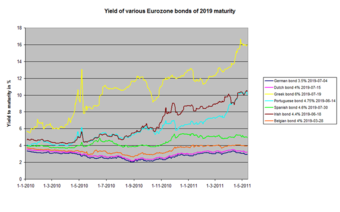
Yield to Maturity
Development of yield to maturity of bonds of 2019 maturity of a number of Eurozone governments.
Contrary to popular belief, including concepts often cited in advanced financial literature, Yield to maturity does not depend upon a reinvestment of dividends. Yield to maturity, rather, is simply the discount rate at which the sum of all future cash flows from the bond (coupons and principal) is equal to the price of the bond. The formula for yield to maturity:
Yield to maturity (YTM) = [(Face value / Present value)1/Time period]-1
The YTM is often given in terms of Annual Percentage Rate (A.P.R.), but usually market convention is followed: in a number of major markets the convention is to quote yields semi-annually (for example, an annual effective yield of 10.25% would be quoted as 5.00%, because 1.05 x 1.05 = 1.1025).
If the yield to maturity for a bond is less than the bond’s coupon rate, then the (clean) market value of the bond is greater than the par value (and vice versa).
- If a bond’s coupon rate is less than its YTM, then the bond is selling at a discount.
- If a bond’s coupon rate is more than its YTM, then the bond is selling at a premium.
- If a bond’s coupon rate is equal to its YTM, then the bond is selling at par.
As some bonds have different characteristics, there are some variants of YTM:
- Yield to call: when a bond is callable (can be repurchased by the issuer before the maturity), the market looks also to the Yield to call, which is the same calculation of the YTM, but assumes that the bond will be called, so the cash flow is shortened.
- Yield to put: same as yield to call, but when the bond holder has the option to sell the bond back to the issuer at a fixed price on specified date.
- Yield to worst: when a bond is callable, puttable, exchangeable, or has other features, the yield to worst is the lowest yield of yield to maturity, yield to call, yield to put, and others.
For instance, you buy ABC Company bond which matures in 1 year and has a 5% interest rate (coupon) and has a par value of $100. You pay $90 for the bond. The current yield is 5.56% ((5/90)*100). If you hold the bond until maturity, ABC Company will pay you $5 as interest and $100 par value for the matured bond. Now for your $90 investment, you get $105, so your yield to maturity is 16.67% [= (105/90)-1] or [=(105-90)/90].
6.8.4: Inflation Premium
An inflation premium is the part of prevailing interest rates that results from lenders compensating for expected inflation.
Learning Objective
Explain how to determine and use an inflation premium
Key Points
- Investors seek this premium to compensate for the erosion in the value of their capital due to inflation.
- Actual interest rates (without factoring in inflation) are viewed by economists and investors as being the nominal (stated) interest rate minus the inflation premium.
- Letting r denote the real interest rate, i denote the nominal interest rate, and let π denote the inflation rate, the Fisher equation is: i = r + π. In the Fisher equation, π is the inflation premium.
Key Term
- systematic risks
-
In finance and economics, systematic risk (sometimes called aggregate risk, market risk, or undiversifiable risk) is vulnerability to events which affect aggregate outcomes such as broad market returns, total economy-wide resource holdings, or aggregate income.
An inflation premium is the part of prevailing interest rates that results from lenders compensating for expected inflation by pushing nominal interest rates to higher levels.
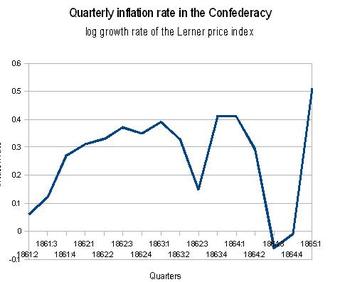
Inflation rate graph
Inflation rate in the Confederacy during the American Civil War.
In economics and finance, an individual who lends money for repayment at a later point in time expects to be compensated for the time value of money, or not having the use of that money while it is lent. In addition, they will want to be compensated for the risks of the money having less purchasing power when the loan is repaid. These risks are systematic risks, regulatory risks and inflationary risks. The first includes the possibility that the borrower will default or be unable to pay on the originally agreed upon terms, or that collateral backing the loan will prove to be less valuable than estimated. The second includes taxation and changes in the law which would prevent the lender from collecting on a loan or having to pay more in taxes on the amount repaid than originally estimated. The third takes into account that the money repaid may not have as much buying power from the perspective of the lender as the money originally lent, that is inflation, and may include fluctuations in the value of the currencies involved. The inflation premium will compensate for the third risk, so investors seek this premium to compensate for the erosion in the value of their capital, due to inflation.
Actual interest rates (without factoring in inflation) are viewed by economists and investors as being the nominal (stated) interest rate minus the inflation premium.
The Fisher equation in financial mathematics and economics estimates the relationship between nominal and real interest rates under inflation. In economics, this equation is used to predict nominal and real interest rate behavior. Letting r denote the real interest rate, i denote the nominal interest rate, and let π denote the inflation rate, the Fisher equation is: i = r + π. In the Fisher equation, π is the inflation premium.
For example, if an investor were able to lock in a 5% interest rate for the coming year and anticipates a 2% rise in prices, he would expect to earn a real interest rate of 3%. 2% is the inflation premium. This is not a single number, as different investors have different expectations of future inflation.
Since the inflation rate over the course of a loan is not known initially, volatility in inflation represents a risk to both the lender and the borrower.
6.8.5: Differences Between Real and Nominal Rates
Nominal rate refers to the rate before adjustment for inflation; the real rate is the nominal rate minus inflation: r = R – i or, 1+r = (1+r)(1+E(r)).
Learning Objective
Differentiate between real and nominal interest rates
Key Points
- Nominal rate refers to the rate before adjustment for inflation; the real rate is the nominal rate minus inflation.
- Fisher equation states that the real interest rate is approximately the nominal interest rate minus the inflation rate: 1 + i = (1+r) (1+E(r)).
- Simple equation between nominal rates and real rates: i = R – r.
Key Term
- purchasing power
-
Purchasing power (sometimes retroactively called adjusted for inflation) is the amount of goods or services that can be purchased with a unit of currency.
In finance and economics, nominal rate refers to the rate before adjustment for inflation (in contrast with the real rate). The real rate is the nominal rate minus inflation. In the case of a loan, it is this real interest that the lender receives as income. If the lender is receiving 8% from a loan and inflation is 8%, then the real rate of interest is zero, because nominal interest and inflation are equal. A lender would have no net benefit from such a loan because inflation fully diminishes the value of the loan’s profit.
The relationship between real and nominal rates can be described in the equation:

Real and nominal
The relationship between real and nominal interest rates is captured by the formula.
Where r is the real rate, i is the inflation rate, and R is the nominal rate.
The real rate can be described more formally by the Fisher equation, which states that the real interest rate is approximately the nominal interest rate minus the inflation rate: 1 + i = (1+r) (1+E(r)), where i = nominal interest rate; r = real interest rate; E(r) = expected inflation rate.
For example, if somebody lends $1,000 for a year at 10%, and receives $1,100 back at the end of the year, this represents a 10% increase in his purchasing power if prices for the average goods and services that he buys are unchanged from what they were at the beginning of the year. However, if the prices of the food, clothing, housing, and other things that he wishes to purchase have increased 20% over this period, he has in fact suffered a real loss of about 12% in his purchasing power.
In this analysis, the nominal rate is the stated rate, and the real rate is the rate after the expected losses due to inflation. Since the future inflation rate can only be estimated, the ex ante and ex post (before and after the fact) real rates may be different; the premium paid to actual inflation may be higher or lower.
6.8.6: Time to Maturity
“Time to maturity” refers to the length of time before the par value of a bond must be returned to the bondholder.
Learning Objective
Discuss the importance of a bond’s maturity when determining its value
Key Points
- The maturity can be any length of time, but debt securities with a term of less than one year are generally not designated as bonds. Instead, they are considered money market instruments.
- In the market for United States Treasury securities, there are three categories of bond maturities: short-term, medium-term and long-term bonds.
- A bond that takes longer to mature necessarily has a greater duration. The bond price in this type of a situation, therefore, is more sensitive to changes in interest rates.
Key Terms
- duration
-
A measure of the sensitivity of the price of a financial asset to changes in interest rates, computed for a simple bond as a weighted average of the maturities of the interest and principal payments associated with it
- money market
-
A market for trading short-term debt instruments, such as treasury bills, commercial paper, bankers’ acceptances, and certificates of deposit
Time to Maturity
“Time to maturity” refers to the length of time that can elapse before the par value (face value) for a bond must be returned to a bondholder. This time may be as short as a few months, or longer than 50 years. Once this time has been reached, the bondholder should receive the par value for their particular bond.
The issuer of a bond has to repay the nominal amount for that bond on the maturity date. After this date, as long as all due payments have been made, the issuer will have no further obligations to the bondholders. The length of time until a bond’s matures is referred to as its term, tenor, or maturity. These dates can technically be any length of time, but debt securities with a term of less than one year are generally not designated as bonds. Instead, they are designated as money market instruments .

Money market interest rates
Interest rates of one-month maturity of German banks from 1967 to 2003
Most bonds have a term of up to 30 years. That being said, bonds have been issued with terms of 50 years or more, and historically, issues have arisen where bonds completely lack maturity dates (irredeemables). In the market for United States Treasury securities, there are three categories of bond maturities:
- Short term (bills): maturities between one to five years (Instruments that mature in less than one year are considered Money Market Instruments. )
- Medium term (notes): maturities between six to twelve years
- Long term (bonds): maturities greater than twelve years
Because bonds with long maturities necessarily have long durations, the bond prices in these situations are more sensitive to interest rate changes. In other words, the price risk of such bonds is higher. The fair price of a “straight bond,” a bond with no embedded options, is usually determined by discounting its expected cash flows at the appropriate discount rate. Although this present value relationship reflects the theoretical approach to determining the value of a bond, in practice, the price is (usually) determined with reference to other, more liquid instruments.
In general, coupon and par value being equal, a bond with a short time to maturity will trade at a higher value than one with a longer time to maturity. This is because the par value is discounted at a higher rate further into the future.
Finally, it is important to recognize that future interest rates are uncertain, and that the discount rate is not adequately represented by a single fixed number (this would be the case if an option was written on the bond in question) stochastic calculus may be employed. Where the market price of a bond is less than its face value (par value), the bond is selling at a discount. Conversely, if the market price of bond is greater than its face value, the bond is selling at a premium.
6.8.7: Calculating Yield to Maturity Using the Bond Price
The yield to maturity is the discount rate that returns the bond’s market price: YTM = [(Face value/Bond price)1/Time period]-1.
Learning Objective
Calculate a bond’s yield to maturity
Key Points
- To achieve a return equal to YTM (i.e., where it is the required return on the bond), the bond owner must buy the bond at price P0, hold the bond until maturity, and redeem the bond at par.
- If a bond’s coupon rate is less than its YTM, then the bond is selling at a discount. If a bond’s coupon rate is more than its YTM, then the bond is selling at a premium. If a bond’s coupon rate is equal to its YTM, then the bond is selling at par.
- Formula for yield to maturity: Yield to maturity(YTM) = [(Face value/Bond price)1/Time period]-1.
Key Term
- discount rate
-
The interest rate used to discount future cash flows of a financial instrument; the annual interest rate used to decrease the amounts of future cash flow to yield their present value.
YTM
The yield to maturity is the discount rate which returns the market price of the bond. YTM is the internal rate of return of an investment in the bond made at the observed price.
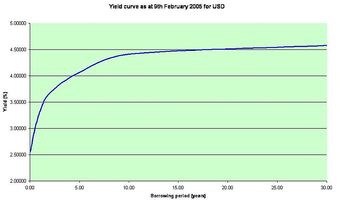
USD Yield Curve
2005 USD yield curve
To achieve a return equal to YTM (i.e., where it is the required return on the bond), the bond owner must buy the bond at price P0, hold the bond until maturity, and redeem the bond at par.
If the yield to maturity for a bond is less than the bond’s coupon rate, then the (clean) market value of the bond is greater than the par value (and vice versa). If a bond’s coupon rate is less than its YTM, then the bond is selling at a discount. If a bond’s coupon rate is more than its YTM, then the bond is selling at a premium. If a bond’s coupon rate is equal to its YTM, then the bond is selling at par.
Calculating YTM
Formula for yield to maturity: Yield to maturity(YTM) = [(Face value/Bond price)1/Time period]-1
As can be seen from the formula, the yield to maturity and bond price are inversely correlated.
Consider a 30-year, zero-coupon bond with a face value of $100. If the bond is priced at an annual YTM of 10%, it will cost $5.73 today (the present value of this cash flow, 100/(1.1)30 = 5.73). Over the coming 30 years, the price will advance to $100, and the annualized return will be 10%.
What happens in the meantime? Suppose that over the first 10 years of the holding period, interest rates decline, and the yield-to-maturity on the bond falls to 7%. With 20 years remaining to maturity, the price of the bond will be 100/1.0720, or $25.84. Even though the yield-to-maturity for the remaining life of the bond is just 7%, and the yield-to-maturity bargained for when the bond was purchased was only 10%, the return earned over the first 10 years is 16.25%. This can be found by evaluating (1+i) from the equation (1+i)10 = (25.842/5.731), giving 1.1625.
Over the remaining 20 years of the bond, the annual rate earned is not 16.25%, but rather 7%. This can be found by evaluating (1+i) from the equation (1+i)20 = 100/25.84, giving 1.07. Over the entire 30 year holding period, the original $5.73 invested increased to $100, so 10% per annum was earned, irrespective of any interest rate changes in between.
6.8.8: Impact of Payment Frequency on Bond Prices
Payment frequency can be annual, semi annual, quarterly, or monthly; the more frequently a bond makes coupon payments, the higher the bond price.
Learning Objective
Calculate the price of a bond
Key Points
- Payment frequency can be annual, semi annual, quarterly, monthly, weekly, daily, or continuous.
- Bond price is the sum of the present value of face value paid back at maturity and the present value of an annuity of coupon payments. The present value of face value received at maturity is the same. However, the present values of annuities of coupon payments vary among payment frequencies.
- The more frequent a bond makes coupon payments, the higher the bond price, given equal coupon, par, and face.
Key Term
- annuity
-
A specified income payable at stated intervals for a fixed or a contingent period, often for the recipient’s life, in consideration of a stipulated premium paid either in prior installment payments or in a single payment. For example, a retirement annuity paid to a public officer following his or her retirement.
The payment schedule of financial instruments defines the dates at which payments are made by one party to another on, for example, a bond or a derivative. It can be either customised or parameterized. Payment frequency can be annual, semi annual, quarterly, monthly, weekly, daily, or continuous.
Bond prices is the present value of all coupon payments and the face value paid at maturity. The formula to calculate bond prices:

Bond price formula
Bond price is the present value of all coupon payments and the face value paid at maturity.
F = face value, iF = contractual interest rate, C = F * iF = coupon payment (periodic interest payment), N = number of payments, i = market interest rate, or required yield, or observed / appropriate yield to maturity, M = value at maturity, usually equals face value, P = market price of bond.
In other words, bond price is the sum of the present value of face value paid back at maturity and the present value of an annuity of coupon payments. For bonds of different payment frequencies, the present value of face value received at maturity is the same. However, the present values of annuities of coupon payments vary among payment frequencies.
The present value of an annuity is the value of a stream of payments, discounted by the interest rate to account for the payments are being made at various moments in the future. The formula is:

Annuity formula
The formula to calculate PV of annuities.
Where n is the number of terms or number of payments n =1 (annually), n = 2 (semi-annually), n = 4 (quarterly)… and i is the per period interest rate.
According to the formula, the greater n, the greater the present value of the annuity (coupon payments). To put it differently, the more frequent a bond makes coupon payments, the higher the bond price.
6.8.9: Deciding to Refund Bonds
Refunding occurs when an entity that has issued callable bonds calls those debt securities to issue new debt at a lower coupon rate.
Learning Objective
Explain when to refund a debt issue
Key Points
- The issue of new, lower-interest debt allows the company to prematurely refund the older, higher-interest debt.
- Bond refunding occurs when a) interest rates in the market are sufficiently less than the coupon rate on the old bond, b) the price of the old bond is less than par. and c) the sinking fund has accumulated enough money to retire the bond issue.
- The decision of whether to refund a particular debt issue is usually based on a capital budgeting (present value) analysis.
Key Term
- sinking fund
-
A sinking fund is a fund established by a government agency or business for the purpose of reducing debt by repaying or purchasing outstanding loans and securities held against the entity. It helps keep the borrower liquid so it can repay the bondholder.
Refunding occurs when an entity that has issued callable bonds calls those debt securities from the debt holders with the express purpose of reissuing new debt at a lower coupon rate. In essence, the issue of new, lower-interest debt allows the company to prematurely refund the older, higher-interest debt. On the contrary, nonrefundable bonds may be callable, but they cannot be re-issued with a lower coupon rate (i.e., they cannot be refunded).

French Bond
French Bond for the Akhtala mines issued in 1887.
The decision of whether to refund a particular debt issue is usually based on a capital budgeting (present value) analysis. The principal benefit, or cash inflow, is the present value of the after-tax interest savings over the life of the issue.
Bond refunding occurs when all three of the following are true
- Interest rates in the market are sufficiently less than the coupon rate on the old bond
- The price of the old bond is less than par
- The sinking fund has accumulated enough money to retire the bond issue.
The three steps of whether to make a refunding decision are as follows:
Step 1: Calculate the present value of interest savings (cash inflows):
Interest savings = annual interest of old issue – annual interest of new issue
Step 2: Calculate the net investment (net cash outflow at time 0). This involves computing the after-tax call premium, the issuance cost of the new issue, the issuance cost of the old issue, and the overlapping interest. The call premium is a cash outflow.
Step 3: Finally, calculate the net present value of refunding.
Net present value of refunding = Present value of interest savings – Present value of net investment
6.9: Bond Risk
6.9.1: Price Risk
Price risk is the risk that the market price of a bond will fall, usually due to a rise in the market interest rate.
Learning Objective
Identify a bond’s price risk
Key Points
- The market price of bonds will decrease in value when the generally prevailing interest rates rise and vice versa.
- Unless you plan to buy or sell them in the open market, changing interest rates do not affect the interest payments to the bondholder.
- Price changes in a bond will immediately affect mutual funds that hold these bonds. If the value of the bonds in their trading portfolio falls, the value of the portfolio also falls.
Key Term
- mutual funds
-
A type of professionally-managed collective investment vehicle that pools money from many investors to purchase securities. While there is no legal definition, the term is most commonly applied only to those collective investment vehicles that are regulated, available to the general public and open-ended in nature.
Interest rates and bond prices carry an inverse relationship. Bond price risk is closely related to fluctuations in interest rates. Fixed-rate bonds are subject to interest rate risk, meaning that their market prices will decrease in value when the generally prevailing interest rates rise. Since the payments are fixed, a decrease in the market price of the bond means an increase in its yield. When the market interest rate rises, the market price of bonds will fall, reflecting investors’ ability to get a higher interest rate on their money elsewhere — perhaps by purchasing a newly-issued bond that already features the new higher interest rate. On the flip side, if the prevailing interest rate were on the decline, investors would naturally buy bonds that pay lower rates of interest. This would force bond prices up.
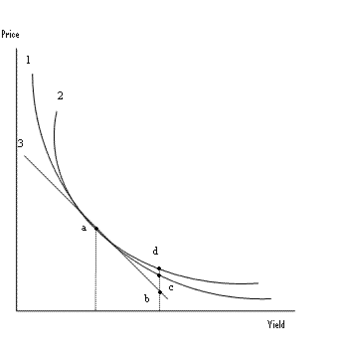
Bond price and yield
Several curves depicting the inverse relationship between bond price and yield (interest rates).
Unless you plan to buy or sell them in the open market, changing interest rates do not affect the interest payments to the bondholder, so long-term investors who want a specific amount at the maturity date do not need to worry about price swings in their bonds and do not suffer from interest rate risk. However, because of the interest rate risk, bonds with longer terms are more risky than bonds with shorter terms.
Price changes in a bond will immediately affect mutual funds that hold these bonds. If the value of the bonds in their trading portfolio falls, the value of the portfolio also falls. This can be damaging for professional investors such as banks, insurance companies, pension funds and asset managers (irrespective of whether the value is immediately “marked to market” or not). If there is any chance a holder of individual bonds may need to sell his bonds and “cash out”, interest rate risk could become a real problem.
Bond prices can become volatile depending on the credit rating of the issuer – for instance if the credit rating agencies like Standard & Poor’s and Moody’s upgrade or downgrade the credit rating of the issuer. An unanticipated downgrade will cause the market price of the bond to fall. As with interest rate risk, this risk does not affect the bond’s interest payments (provided the issuer does not actually default), but puts at risk the market price, which affects mutual funds holding these bonds, and holders of individual bonds who may have to sell them.
6.9.2: Reinvestment Risk
Reinvestment risk is the risk that a bond is repaid early, and an investor has to find a new place to invest with the risk of lower returns.
Learning Objective
Define reinvestment risk
Key Points
- Reinvestment risk is more likely when interest rates are declining.
- Reinvestment risk affects the yield-to-maturity of a bond, which is calculated on the premise that all future coupon payments will be reinvested at the interest rate in effect when the bond was first purchased.
- Two factors that have a bearing on the degree of reinvestment risk are maturity of the bond and the coupon interest rate.
Key Term
- Yield to maturity
-
The Yield to maturity (YTM) or redemption yield of a bond or other fixed-interest security, such as gilts, is the internal rate of return (IRR, overall interest rate) earned by an investor who buys the bond today at the market price, assuming that the bond will be held until maturity, and that all coupon and principal payments will be made on schedule.
Reinvestment risk is one of the main genres of financial risk. The term describes the risk that a particular investment might be canceled or stopped somehow, and that one may have to find a new place to invest their money with the risk being there might not be a similarly attractive investment available. This primarily occurs if bonds (which are portions of loans to entities) are paid back earlier than expected.
The risk resulting from the fact that interest or dividends earned from an investment may not be able to be reinvested in such a way that they earn the same rate of return as the invested funds that generated them. Reinvestment risk is more likely when interest rates are declining. For example, falling interest rates may prevent bond coupon payments from earning the same rate of return as the original bond. Pension funds are also subject to reinvestment risk. Especially with the short-term nature of cash investments, there is always the risk that future proceeds will have to be reinvested at a lower interest rate.
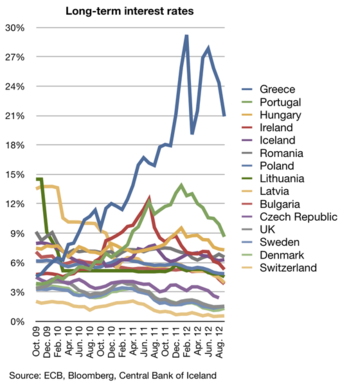
Interest rates
Reinvestment risk is more likely when interest rates are declining.
Reinvestment risk affects the yield-to-maturity of a bond, which is calculated on the premise that all future coupon payments will be reinvested at the interest rate in effect when the bond was first purchased.
Two factors that have a bearing on the degree of reinvestment risk are:
Maturity of the bond – The longer the maturity of the bond, the higher the likelihood that interest rates will be lower than they were at the time of the bond purchase.
Interest rate on the bond – The higher the interest rate, the bigger the coupon payments that have to be reinvested, and, consequently, the reinvestment risk. Zero coupon bonds are the only fixed-income instruments to have no reinvestment risk, since they have no interim coupon payments.
6.9.3: Comparing Price Risk and Reinvestment Risk
Price risk is positively correlated to changes in interest rates, while reinvestment risk is inversely correlated.
Learning Objective
Differentiate between price risk and reinvestment risk
Key Points
- Price risk and reinvestment risk are both the uncertainty associated with the effects of changes in market interest rates.
- Price risk and changes in interest rates are positively correlated.
- Reinvestment risk and changes in interest rates are inversely correlated.
Key Term
- duration
-
A measure of the sensitivity of the price of a financial asset to changes in interest rates, computed for a simple bond as a weighted average of the maturities of the interest and principal payments associated with it
Overview
Price risk and reinvestment risk both represent the uncertainty associated with the effects of changes in market interest rates. Both types of interest rate risks are important considerations in investments, corporate financial planning, and banking.

Pacific Railroad Bond
$1,000 (30 year, 7%) “Pacific Railroad Bond” (#93 of 200) issued by the City and County of San Francisco.
Price Risk
Price risk is the uncertainty associated with potential changes in the price of an asset caused by changes in interest rate levels in the economy. The price risk is sometimes referred to as maturity risk since the greater the maturity of an investment (the greater the duration), the greater the change in price for a given change in interest rates. Bond market prices will decrease in value when the generally prevailing interest rates rise (price risk is on the rise). Since the payments are fixed, a decrease in the market price of the bond means an increase in its yield. When the market interest rate rises, the market price of bonds will fall, reflecting investors’ ability to get a higher interest rate on their money elsewhere — perhaps by purchasing a newly issued bond that already features the newly higher interest rate. When interest rates fall, bond prices increase, and there is less price risk. To sum up, price risk and interest rates are positively correlated.
Reinvestment Risk
Reinvestment risk is the risk that a particular investment might be canceled or stopped somehow, and that one may have to find a new place to invest their money with the risk that there might not be a similarly attractive investment available. This primarily occurs if bonds (which are portions of loans to entities) are paid back earlier than expected. When interest rates increase, there is less likelihood that a bond is called and paid back before maturity. So there is little reinvestment risk. When interest rates decrease, there is more likelihood that the bond is called and paid back earlier than expected. There is, accordingly, more reinvestment risk. Reinvestment risk and interest rates are inversely correlated.
Discussion
In summary, price risk and reinvestment risk are two main financial risks resulting from changes in interest rates. The former is positively correlated to interest rates, while reinvestment risk is inversely correlated to fluctuations in interest rates.
6.9.4: Default Risk
Default risk is the risk that a bond issuer will default on any type of debt by failing to make payments which it is obligated to make.
Learning Objective
Define default risk
Key Points
- With default risk, the risk is primarily that of the bondholder and includes lost principal and interest, disruption to cash flows, and increased collection costs.
- To reduce the bondholders’ credit risk, the lender may perform a credit check on the prospective borrower and may require the issuer to take out appropriate insurance.
- A company’s bondholders may lose much or all their money if the company goes bankrupt. There is no guarantee of how much money will remain to repay bondholders.
Key Terms
- liquidated
-
In law, liquidation is the process by which a company (or part of a company) is brought to an end and the assets and property of the company redistributed.
- insolvent
-
Unable to pay one’s bills as they fall due.
Default risk (or credit risk) of a bond refers to the risk that a bond issuer will default on any type of debt by failing to make payments which it is obligated to do. The risk is primarily that of the bondholder and includes lost principal and interest, disruption to cash flows, and increased collection costs. The loss may be complete or partial and can arise in a number of circumstances. For example, a company is unable to repay amounts secured by a fixed or floating charge over the assets of the company, a business or consumer does not pay a trade invoice when due, a business does not pay an employee’s earned wages when due, a business or government bond issuer does not make a payment on a coupon or principal payment when due, an insolvent insurance company does not pay a policy obligation, and an insolvent bank won’t return funds to a depositor .
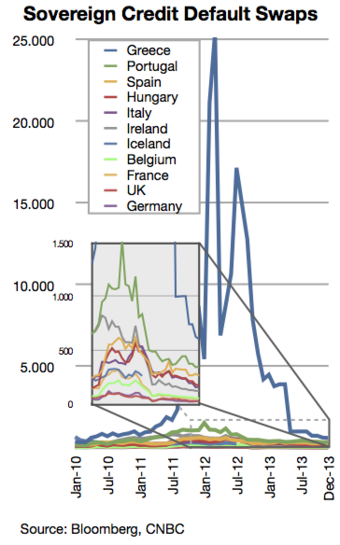
Prices of sovereign credit default swaps
Credit default swaps are an instrument to protect against default risk. This image shows the monthly prices of sovereign credit default swaps from January 2010 till September 2011 of Greece, Portugal, Ireland, Hungary, Italy, Spain, Belgium, France, Germany, and the UK (Greece is illustrated by blue line). Higher credit default swap prices mean that investors perceive a higher risk of default.
To reduce the bondholders’ credit risk, the lender may perform a credit check on the prospective borrower, may require the issuer to take out appropriate insurance, such as mortgage insurance or seek security or guarantees of third parties, besides other possible strategies. In general, the higher the risk, the higher will be the interest rate that the issuer will have to pay.
A company’s bondholders may lose much or all their money if the company goes bankrupt. Under the laws of many countries (including the United States and Canada), bondholders are in line to receive the proceeds of the sale of the assets of a liquidated company ahead of some other creditors. Bank lenders, deposit holders (in the case of a deposit taking institution such as a bank), and trade creditors may take precedence.
There is no guarantee of how much money will remain to repay bondholders. As an example, after an accounting scandal and a Chapter 11 bankruptcy at the giant telecommunications company Worldcom, in 2004 its bondholders ended up being paid 35.7 cents on the dollar. In a bankruptcy involving reorganization or recapitalization, as opposed to liquidation, bondholders may end up having the value of their bonds reduced, often through an exchange for a smaller number of newly issued bonds.
6.9.5: Bond Rating System
The credit rating is a financial indicator assigned by credit rating agencies; bond ratings below BBB-/Baa are considered junk bonds.
Learning Objective
Discuss the role of NRSROs in the bond market
Key Points
- In investment, the bond credit rating assesses the credit worthiness of a corporation’s or government debt issues.
- The credit rating is a financial indicator to potential investors of debt securities, such as bonds. These are assigned by credit rating agencies such as Moody’s, Standard & Poor’s, and Fitch Ratings to have letter designations (such as AAA, B, CC) which represent the quality of a bond.
- Bond ratings below BBB-/Baa are considered not to be investment grade and are colloquially called junk bonds.
Key Term
- asset-backed securities
-
An asset-backed security is a security that has value and income payments derived from and collateralized (or “backed”) by a specified pool of underlying assets. The pool of assets is typically a group of small and illiquid assets that are unable to be sold individually.
In investment, the bond credit rating assesses the credit worthiness of a corporation’s or government’s debt issues. It is analogous to credit ratings for individuals.The credit rating is a financial indicator to potential investors of debt securities, such as bonds. These are assigned by credit rating agencies such as Moody’s, Standard & Poor’s, and Fitch Ratings to have letter designations (such as AAA, B, CC), which represent the quality of a bond. Bond ratings below BBB-/Baa are considered to be not investment grade and are colloquially called “junk bonds. “
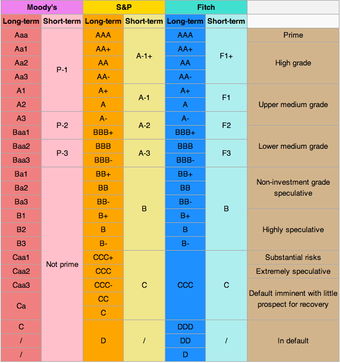
Bond rating
Bond ratings below BBB-/Baa are considered to be not investment grade and are colloquially called “junk bonds. “
Credit rating agencies registered as such with the SEC are “Nationally recognized statistical rating organizations. ” The following firms are currently registered as NRSROs: A.M. Best Company, Inc.; DBRS Ltd.; Egan-Jones Rating Company; Fitch, Inc.; Japan Credit Rating Agency, Ltd.; LACE Financial Corp.; Moody’s Investors Service, Inc.; Rating and Investment Information, Inc.; and Standard & Poor’s Ratings Services.
Under the Credit Rating Agency Reform Act, an NRSRO may be registered with respect to up to five classes of credit ratings: (1) financial institutions, brokers, or dealers; (2) insurance companies; (3) corporate issuers; (4) issuers of asset-backed securities; and (5) issuers of government securities, municipal securities, or securities issued by a foreign government. S&P, Moody’s, and Fitch dominate the market with approximately 90-95% of world market share.
Moody’s assigns bond credit ratings of Aaa, Aa, A, Baa, Ba, B, Caa, Ca, C, with WR and NR as withdrawn and not rated. Standard & Poor’s and Fitch assign bond credit ratings of AAA, AA, A, BBB, BB, B, CCC, CC, C, and D.
A bond is considered investment grade or IG if its credit rating is BBB- or higher by Standard & Poor’s or Baa3 or higher by Moody’s or BBB (low) or higher by DBRS. Generally, they are bonds that are judged by the rating agency as likely enough to meet payment obligations that banks are allowed to invest in them. Ratings play a critical role in determining how much companies and other entities that issue debt, including sovereign governments, have to pay to access credit markets (i.e., the amount of interest they pay on their issued debt). The threshold between investment-grade and speculative-grade ratings has important market implications for issuers’ borrowing costs. Bonds that are not rated as investment-grade bonds are known as high-yield bonds or more derisively as junk bonds. The risks associated with investment-grade bonds (or investment-grade corporate debt) are considered significantly higher than those associated with first-class government bonds.
6.9.6: Bankruptcy and Bond Value
There is no guarantee of how much money will remain to repay bondholders in a bankruptcy, therefore, the value of the bond is uncertain.
Learning Objective
Identify which stakeholders take precedence in receiving cash from a bankrupt business
Key Points
- When a business is unable to service its debt or pay its creditors, it or its creditors can file with a federal bankruptcy court for protection under either Chapter 7 or Chapter 11 of the Bankruptcy code.
- If a company goes bankrupt, its bondholders will often receive some money back (the recovery amount).
- In a bankruptcy involving reorganization or recapitalization, as opposed to liquidation, bondholders may end up having the value of their bonds reduced, often through an exchange for a smaller number of newly-issued bonds.
Key Terms
- recapitalization
-
A restructuring of a company’s mixture of equity and debt.
- liquidation
-
The selling of the assets of a business as part of the process of dissolving the business.
A company’s bondholders may lose much or all their money if the company goes bankrupt. Under the laws of many countries (including the United States and Canada), bondholders are in line to receive the proceeds of the sale of the assets of a liquidated company ahead of some other creditors.
Bank lenders, deposit holders (in the case of a deposit-taking institution such as a bank) and trade creditors may take precedence. However, compared to equity holders, bondholders also enjoy a measure of legal protection: under the law of most countries, if a company goes bankrupt, its bondholders will often receive some money back (the recovery amount), whereas the company’s equity stock often ends up valueless.
When a business is unable to service its debt or pay its creditors, the business or its creditors can file with a federal bankruptcy court for protection under either Chapter 7 or Chapter 11 of the Bankruptcy code. In Chapter 7, the business ceases operations, a trustee sells all of its assets, and then distributes the proceeds to its creditors. Any residual amount is returned to the owners of the company. In Chapter 11, in most instances, the debtor remains in control of its business operations as a debtor in possession, and is subject to the oversight and jurisdiction of the court.

Bankruptcy Courthouse
Old U.S. Post Office and Court House, now used by the U.S. Bankruptcy Court for the Northern District of Florida.
There is no guarantee of how much money will remain to repay bondholders, therefore, the value of the bond is uncertain. As an example, after an accounting scandal and a chapter 11 bankruptcy at the giant telecommunications company Worldcom in 2004, its bondholders ended up being paid 35.7 cents on the dollar. In a bankruptcy involving reorganization or recapitalization, as opposed to liquidation, bondholders may end up having the value of their bonds reduced, often through an exchange for a smaller number of newly-issued bonds.
Chapter 5: The Time Value of Money
5.1: Introduction to the Time Value of Money
5.1.1: Defining the Time Value of Money
The Time Value of Money is the concept that money is worth more today that it is in the future.
Learning Objective
Identify the variables that are used to calculate the time value of money
Key Points
- Being given $100 today is better than being given $100 in the future because you don’t have to wait for your money.
- Money today has a value (present value, or PV) and money in the future has a value (future value, or FV).
- The amount that the value of the money changes after one year is called the interest rate (i). For example, if money today is worth 10% more in one year, the interest rate is 10%.
Key Terms
- Interest Rate (i or r)
-
The cost of not having money for one period, or the amount paid on an investment per year.
- Present Value (PV)
-
The value of the money today.
- Future Value (FV)
-
The value of the money in the future.
One of the most fundamental concepts in finance is the Time Value of Money. It states that money today is worth more than money in the future.
Imagine you are lucky enough to have someone come up to you and say “I want to give you $500. You can either have $500 right now, or I can give you $500 in a year. What would you prefer? ” Presumably, you would ask to have the $500 right now. If you took the money now, you could use it to buy a TV. If you chose to take the money in one year, you could still use it to buy the same TV, but there is a cost. The TV might not be for sale, inflation may mean that the TV now costs $600, or simply, you would have to wait a year to do so and should be paid for having to wait. Since there’s no cost to taking the money now, you might as well take it.
There is some value, however, that you could be paid in one year that would be worth the same to you as $500 today. Say it’s $550- you are completely indifferent between taking $500 today and $550 next year because even if you had to wait a year to get your money, you think $50 is worth waiting.
In finance, there are special names for each of these numbers to help ensure that everyone is talking about the same thing. The $500 you get today is called the Present Value (PV). This is what the money is worth right now. The $550 is called the Future Value (FV). This is what $500 today is worth after the time period (t)- one year in this example. In this example money with a PV of $500 has a FV of $550. The rate that you must be paid per year in order to not have the money is called an Interest Rate (i or r).
All four of the variables (PV, FV, r, and t) are tied together in the equation in . Don’t worry if this seems confusing; the concept will be explored in more depth later.

Simple Interest Formula
Simple interest is when interest is only paid on the amount you originally invested (the principal). You don’t earn interest on interest you previously earned.
5.1.2: Importance of the Time Value of Money
Time value of money is integral in making the best use of a financial player’s limited funds.
Learning Objective
Describe why the time value of money is important when analyzing a potential project
Key Points
- Money today is worth more than the same quantity of money in the future. You can invest a dollar today and receive a return on your investment.
- Loans, investments, and any other deal must be compared at a single point in time to determine if it’s a good deal or not.
- The process of determining how much a future cash flow is worth today is called discounting. It is done for most major business transactions during investing decisions in capital budgeting.
Key Terms
- discounting
-
The process of determining how much money paid/received in the future is worth today. You discount future values of cash back to the present using the discount rate.
- interest rate
-
The percentage of an amount of money charged for its use per some period of time. It can also be thought of as the cost of not having money for one period, or the amount paid on an investment per year.
Why is the Time Value of Money Important?
The time value of money is a concept integral to all parts of business. A business does not want to know just what an investment is worth todayit wants to know the total value of the investment. What is the investment worth in total? Let’s take a look at a couple of examples.
Suppose you are one of the lucky people to win the lottery. You are given two options on how to receive the money.
- Option 1: Take $5,000,000 right now.
- Option 2: Get paid $600,000 every year for the next 10 years.
In option 1, you get $5,000,000 and in option 2 you get $6,000,000. Option 2 may seem like the better bet because you get an extra $1,000,000, but the time value of money theory says that since some of the money is paid to you in the future, it is worth less. By figuring out how much option 2 is worth today (through a process called discounting), you’ll be able to make an apples-to-apples comparison between the two options. If option 2 turns out to be worth less than $5,000,000 today, you should choose option 1, or vice versa.
Let’s look at another example. Suppose you go to the bank and deposit $100. Bank 1 says that if you promise not to withdraw the money for 5 years, they’ll pay you an interest rate of 5% a year. Before you sign up, consider that there is a cost to you for not having access to your money for 5 years. At the end of 5 years, Bank 1 will give you back $128. But you also know that you can go to Bank 2 and get a guaranteed 6% interest rate, so your money is actually worth 6% a year for every year you don’t have it. Converting our present cash worth into future value using the two different interest rates offered by Banks 1 and 2, we see that putting our money in Bank 1 gives us roughly $128 in 5 years, while Bank 2’s interest rate gives $134. Between these two options, Bank 2 is the better deal for maximizing future value.

Compound Interest
In this formula, your deposit ($100) is PV, i is the interest rate (5% for Bank 1, 6% for Bank 2), t is time (5 years), and FV is the future value.
5.2: Future Value, Single Amount
5.2.1: Single-Period Investment
Since the number of periods (n or t) is one, FV=PV(1+i), where i is the interest rate.
Learning Objective
Calculate the future value of a single-period investment
Key Points
- Single-period investments use a specified way of calculating future and present value.
- Single-period investments take place over one period (usually one year).
- In a single-period investment, you only need to know two of the three variables PV, FV, and i. The number of periods is implied as one since it is a single-period.
Key Terms
- Single-period investment
-
An investment that takes place over one period, usually one year.
- Multi-period investment
-
An investment that takes place over more than one periods.
- Periods (t or n)
-
Units of time. Usually one year.
Example
- What is the value of a single-period, $100 investment at a 5% interest rate? PV=100 and i=5% (or .05) so FV=100(1+.05). FV=100(1.05) FV=$105.
The amount of time between the present and future is called the number of periods. A period is a general block of time. Usually, a period is one year. The number of periods can be represented as either t or n.
Suppose you’re making an investment, such as depositing your money in a bank. If you plan on leaving the money there for one year, you’re making a single-period investment. Any investment for more than one year is called a multi-period investment.
Let’s go through an example of a single-period investment. As you know, if you know three of the following four values, you can solve for the fourth:
- Present Value (PV)
- Future Value (FV)
- Interest Rate (i or r) [Note: for all formulas, express interest in it’s decimal form, not as a whole number. 7% is .07, 12% is .12, and so on. ]
- Number of Periods (t or n)
In a single-period, there is only one formula you need to know: FV=PV(1+i). The full formulas, which we will be addressing later, are as follows:
Compound interest:
.
Simple interest:
We will address these later, but note that when
both formulas become $FV = PV \cdot (1+i)$.
For example, suppose you deposit $100 into a bank account that pays 3% interest. What is the balance in your account after one year?
In this case, your PV is $100 and your interest is 3%. You want to know the value of your investment in the future, so you’re solving for FV. Since this is a single-period investment, t (or n) is 1. Plugging the numbers into the formula, you get FV=100(1+.03) so FV=100(1.03) so FV=103. Your balance will be $103 in one year.
5.2.2: Multi-Period Investment
Multi-period investments take place over more than one period (usually multiple years). They can either accrue simple or compound interest.
Learning Objective
Calculate the future value of a multi-period investment with simple and complex interest rates
Key Points
- Investments that accrue simple interest have interest paid based on the amount of the principal, not the balance in the account.
- Investments that accrue compound interest have interest paid on the balance of the account. This means that interest is paid on interest earned in previous periods.
- Simple interest increases the balance linearly, while compound interest increases it exponentially.
Key Terms
- accrue
-
To add, or grow.
- principal
-
The money originally invested or loaned, on which basis interest and returns are calculated.
There are two primary ways of determining how much an investment will be worth in the future if the time frame is more than one period.
The first concept of accruing (or earning) interest is called “simple interest. ” Simple interest means that you earn interest only on the principal. Your total balance will go up each period, because you earn interest each period, but the interest is paid only on the amount you originally borrowed/deposited. Simple interest is expressed through the formula in.

Simple Interest Formula
Simple interest is when interest is only paid on the amount you originally invested (the principal). You don’t earn interest on interest you previously earned.
Suppose you make a deposit of $100 in the bank and earn 5% interest per year. After one year, you earn 5% interest, or $5, bringing your total balance to $105. One more year passes, and it’s time to accrue more interest. Since simple interest is paid only on your principal ($100), you earn 5% of $100, not 5% of $105. That means you earn another $5 in the second year, and will earn $5 for every year of the investment. In simple interest, you earn interest based on the original deposit amount, not the account balance.
The second way of accruing interest is called “compound interest. ” In this case, interest is paid at the end of each period based on the balance in the account. In simple interest, it is only how much the principal is that matters. In compound interest, it is what the balance is that matters. Compound interest is named as such because the interest compounds: Interest is paid on interest. The formula for compound interest is.

Compound Interest
Interest is paid at the total amount in the account, which may include interest earned in previous periods.
Suppose you make the same $100 deposit into a bank account that pays 5%, but this time, the interest is compounded. After the first year, you will again have $105. At the end of the second year, you also earn 5%, but it’s 5% of your balance, or $105. You earn $5.25 in interest in the second year, bringing your balance to $110.25. In the third year, you earn interest of 5% of your balance, or $110.25. You earn $5.51 in interest bringing your total to $115.76.
Compare compound interest to simple interest. Simple interest earns you 5% of your principal each year, or $5 a year. Your balance will go up linearly each year. Compound interest earns you $5 in the first year, $5.25 in the second, a little more in the third, and so on. Your balance will go up exponentially.
Simple interest is rarely used compared to compound interest, but it’s good to know both types.
5.2.3: Calculating Future Value
The Future Value can be calculated by knowing the present value, interest rate, and number of periods, and plugging them into an equation.
Learning Objective
Distinguish between calculating future value with simple interest and with compound interest
Key Points
- The future value is the value of a given amount of money at a certain point in the future if it earns a rate of interest.
- The future value of a present value is calculated by plugging the present value, interest rate, and number of periods into one of two equations.
- Unless otherwise noted, it is safe to assume that interest compounds and is not simple interest.
Key Term
- compound interest
-
Interest, as on a loan or a bank account, that is calculated on the total on the principal plus accumulated unpaid interest.
When calculating a future value (FV), you are calculating how much a given amount of money today will be worth some time in the future. In order to calculate the FV, the other three variables (present value, interest rate, and number of periods) must be known. Recall that the interest rate is represented by either r or i, and the number of periods is represented by either t or n. It is also important to remember that the interest rate and the periods must be in the same units. That is, if the interest rate is 5% per year, one period is one year. However, if the interest rate is 5% per month, t or n must reflect the number of periods in terms of months.
Example 1
What is the FV of a $500, 10-year loan with 7% annual interest?
In this case, the PV is $500, t is 10 years, and i is 7% per year. The next step is to plug these numbers into an equation. But recall that there are two different formulas for the two different types of interest, simple interest and compound interest . If the problem doesn’t specify how the interest is accrued, assume it is compound interest, at least for business problems.

Compound Interest
Interest is paid at the total amount in the account, which may include interest earned in previous periods.

Simple Interest Formula
Simple interest is when interest is only paid on the amount you originally invested (the principal). You don’t earn interest on interest you previously earned.
So from the formula, we see that FV=PV(1+i)t so FV=500(1+.07)10. Therefore, FV=$983.58.
In practical terms, you just calculated how much your loan will be in 10 years. This assumes that you don’t need to make any payments during the 10 years, and that the interest compounds. Unless the problem states otherwise, it is safe to make these assumptions – you will be told if there are payments during the 10 year period or if it is simple interest.
Example 2
Suppose we want to again find the future value of a $500, 10-year loan, but with an interest rate of 1% per month. In order to get our total number of periods (t), we would multiply 12 months by 10 years, which equals 120 periods. Therefore:
FV=500(1+.01)120
FV=$1,650.19
5.2.4: Approaches to Calculating Future Value
Calculating FV is a matter of identifying PV, i (or r), and t (or n), and then plugging them into the compound or simple interest formula.
Learning Objective
Describe the difference between compounding interest and simple interest
Key Points
- The “present” can be moved based on whatever makes the problem easiest. Just remember that moving the date of the present also changes the number of periods until the future for the FV.
- To find FV, you must first identify PV, the interest rate, and the number of periods from the present to the future.
- The interest rate and the number of periods must have consistent units. If one period is one year, the interest rate must be X% per year, and vis versa.
Key Term
- quarter
-
A period of three consecutive months (1/4 of a year).
The method of calculating future value for a single amount is relatively straightforward; it’s just a matter of plugging numbers into an equation. The tough part is correctly identifying what information needs to be plugged in.
As previously discussed, there are four things that you need to know in order to find the FV:
- How does the interest accrue? Is it simple or compounding interest?
- Present Value
- Interest Rate
- Number of periods
Let’s take one complex problem as an example:
On June 1, 2014, you will take out a $5000 loan for 8-years. The loan accrues interest at a rate of 3% per quarter. On January 1, 2015, you will take out another $5000, eight-year loan, with this one accruing 5% interest per year. The loan accrues interest on the principal only. What is the total future value of your loans on December 31, 2017?
First, the question is really two questions: What is the value of the first loan in 2017, and what is the value of the second in 2017? Once both values are found, simply add them together.
Let’s talk about the first loan first. The present value is $5,000 on June 1, 2014. It is possible to find the value of the loan today, and then find it’s value in 2017, but since the value is the same in 2017, it’s okay to just imagine it is 2014 today. Next, we need to identify the interest rate. The problem says it’s 3% per quarter, or 3% every three months. Since the problem doesn’t say otherwise, we assume that the interest on this loan is compounded. That means we will use the formula in . Finally, we need to identify the number of periods. There are two and a half years between the inception of the loan and when we need the FV. But recall that the interest rate and periods must be in the same units. That means that the interest must either be converted to % per year, or one period must be one quarter. Let’s take one period to be one quarter. That means there are 10 periods. Please note that we don’t really care when the loan ends in this problem–we only care about the value of the loan on December 31, 2017.

Compound Interest
Interest is paid at the total amount in the account, which may include interest earned in previous periods.
Next, we simply plug the numbers into . PV=5000, i=.03, and t=10. That gives us a FV of $6,719.58.
Now let’s find the value of the second loan at December 31, 2017. Again, PV=$5000, but this time, pretend it is January 1, 2015. This time, the interest is 5% per year and it is explicitly stated to be simple interest. That means we use the formula in . January 31, 2017 is exactly two years from the January 1, 2015 and since the interest is measured per year, we can set t=2 years.
When we plug all of those numbers into , we find that FV=$5,500.00

Simple Interest Formula
Simple interest is when interest is only paid on the amount you originally invested (the principal). You don’t earn interest on interest you previously earned.
Since the problem asks for the total FV of the loans, we add $6,719.58 to $5,500.00, and get a total value of $12,219.58
5.3: Present Value, Single Amount
5.3.1: Single-Period Investment
When considering a single-period investment, n is one, so the PV is simply FV divided by 1+i.
Learning Objective
Calculate the present value of a future, single-period payment
Key Points
- A single period investment has the number of periods (n or t) equal to one.
- For both simple and compound interest, the PV is FV divided by 1+i.
- The time value of money framework says that money in the future is not worth as much as money in the present.
Key Terms
- interest rate
-
The percentage of an amount of money charged for its use per some period of time. It can also be thought of as the cost of not having money for one period, or the amount paid on an investment per year.
- period
-
The length of time during which interest accrues.
The time value of money framework says that money in the future is not worth as much as money in the present. Investors would prefer to have the money today because then they are able to spend it, save it, or invest it right now instead of having to wait to be able to use it.
The difference between what the money is worth today and what it will be worth at a point in the future can be quantified. The value of the money today is called the present value (PV), and the value of the money in the future is called the future value (FV). There is also a name for the cost of not having the money today: the interest rate or discount rate (i or r). For example, if the interest rate is 3% per year, it means that you would be willing to pay 3% of the money to have it one year sooner. The amount of time is also represented by a variable: the number of periods (n). One period could be any length of time, such as one day, one month, or one year, but it must be clearly defined, consistent with the time units in the interest rate, and constant throughout your calculations.

FV of a single payment
The FV is related to the PV by being i% more each period.
All of these variables are related through an equation that helps you find the PV of a single amount of money. That is, it tells you what a single payment is worth today, but not what a series of payments is worth today (that will come later). relates all of the variables together. In order to find the PV, you must know the FV, i, and n.
When considering a single-period investment, n is, by definition, one. That means that the PV is simply FV divided by 1+i. There is a cost to not having the money for one year, which is what the interest rate represents. Therefore, the PV is i% less than the FV.
5.3.2: Multi-Period Investment
Multi-period investments require an understanding of compound interest, incorporating the time value of money over time.
Learning Objective
Calculate the return on a multi-period investment over time
Key Points
- A dollar today is worth more than a dollar tomorrow, and the time value of money must take into account foregone opportunities.
- Single period investments are relatively simple to calculate in terms of future value, applying the interest rate to a present value a single time.
- Multi-period investments require a slightly more complex equation, where interest gets compounded based on the number of periods the investment spans.
- As a result of multiple periods, it is usually a good idea to calculate the average rate of return (cumulatively) over the lifetime of the investment.
Key Term
- Compound interest
-
An interest rate applied to multiple applications of interest during the lifetime of the investment.
When investing, the time value of money is a core concept investors simply cannot ignore. A dollar today is valued higher than a dollar tomorrow, and when utilizing the capital it is important to recognize the opportunity cost involved in what could have been invested in instead.
Single Period Investments
With single period investments, the concept of time value of money is relatively straightforward. The future value is simply the present value applied to the interest rate compounded one time. When comparing this to the opportunity costs involved, the rate of return of an alternative investment during the same time is similarly straightforward.
The variables involved in understanding the time value of money in these investments are:
- Present Value (PV)
- Future Value (FV)
- Interest Rate (i or r) [Note: for all formulas, express interest in its decimal form, not as a whole number. 7% is .07, 12% is .12, and so on. ]
- Number of Periods (t or n)
With these variables, a single period investment could be calculated as follows:
‘t’ in this equation would simply be 1, simplifying this equation to FV = PV(1+r).
Multi-period Investments
With multi-periods in mind, interest begins to compound. Compound interest simple means that the interest from the first period is added to the future present value, and the interest rate the next time around is now being applied to a larger amount. This turns into an exponential calculation of interest, calculated as follows:
This means that the interest rate of a given period may not be the same percentage as the interest rate over multiple periods (in most situations). A useful tool at this point is a way to create an average rate of return over the life of the investment, which can be derived with the following:
Conclusion
All and all, the difference from a time value of money perspective between single and multiple period investments is relatively straightforward. Normalizing expected returns in present value terms (or projecting future returns over multiple time periods of compounding interest) paints a clearer and more accurate picture of the actual worth of a given investment opportunity.
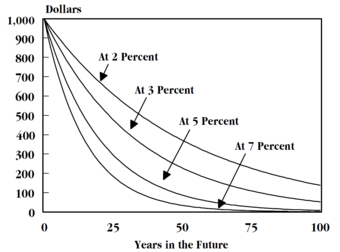
Time Value of Money
Time value of money requires an understanding of how return rates impact fixed values over time.
5.3.3: The Discount Rate
Discounting is the procedure of finding what a future sum of money is worth today.
Learning Objective
Describe what real world costs to the investor comprise an investment’s interest rate
Key Points
- The discount rate represents some cost (or group of costs) to the investor or creditor.
- Some costs to the investor or creditor are opportunity cost, liquidity cost, risk, and inflation.
- The discount rate is used by both the creditor and debtor to find the present value of an amount of money.
Key Terms
- discount rate
-
The interest rate used to discount future cash flows of a financial instrument; the annual interest rate used to decrease the amounts of future cash flow to yield their present value.
- discounting
-
The process of finding the present value using the discount rate.
- discount
-
to account for the time value of money
Another common name for finding present value (PV) is discounting. Discounting is the procedure of finding what a future sum of money is worth today. As you know from the previous sections, to find the PV of a payment you need to know the future value (FV), the number of time periods in question, and the interest rate. The interest rate, in this context, is more commonly called the discount rate.
The discount rate represents some cost (or group of costs) to the investor or creditor. The sum of these costs amounts to a percentage which becomes the interest rate (plus a small profit, sometimes). Here are some of the most significant costs from the investor/creditor’s point of view:

Borrowing and lending
Banks like HSBC take such costs into account when determining the terms of a loan for borrowers.
- Opportunity Cost: The cost of not having the cash on hand at a certain point of time. If the investor/creditor had the cash s/he could spend it, but since it has been invested/loaned out, s/he incurs the cost of not being able to spend it.
- Inflation: The real value of a single dollar decreases over time with inflation. That means that even if everything else is constant, a $100 item will retail for more than $100 in the future. Inflation is generally positive in most countries at most times (if it’s not, it’s called deflation, but it’s rare).
- Risk: There is a chance that you will not get your money back because it is a bad investment, the debtor defaults. You require compensation for taking on that risk.
- Liquidity: Investing or loaning out cash necessarily reduces your liquidity.
All of these costs combine to determine the interest rate on an account, and that interest rate in turn is the rate at which the sum is discounted.
The PV and the discount rate are related through the same formula we have been using,
.
If FV and n are held as constants, then as the discount rate (i) increases, PV decreases. PV and the discount rate, therefore, vary inversely, a fundamental relationship in finance. Suppose you expect $1,000 dollars in one year’s time (FV = $1,000) . To determine the present value, you would need to discount it by some interest rate (i). If this discount rate were 5%, the $1,000 in a year’s time would be the equivalent of $952.38 to you today (1000/[1.00 + 0.05]).
5.3.4: Number of Periods
The number of periods corresponds to the number of times the interest is accrued.
Learning Objective
Define what a period is in terms of present value calculations
Key Points
- A period is just a general term for a length of time. It can be anything- one month, one year, one decade- but it must be clearly defined and fixed.
- For both simple and compound interest, the number of periods varies jointly with FV and inversely with PV.
- The number of periods is also part of the units of the discount rate: if one period is one year, the discount rate must be defined as X% per year. If one period is one month, the discount rate must be X% per month.
Key Term
- period
-
The length of time during which interest accrues.
In , nrepresents the number of periods. A period is just a general term for a length of time. It can be anything- one month, one year, one decade- but it must be clearly defined and fixed. The length of one period must be the same at the beginning of an investment and at the end. It is also part of the units of the discount rate: if one period is one year, the discount rate must be defined as X% per year. If one period is one month, the discount rate must be X% per month.

FV of a single payment
The PV and FV are directly related.
The number of periods corresponds to the number of times the interest is accrued. In the case of simple interest the number of periods, t, is multiplied by their interest rate. This makes sense because if you earn $30 of interest in the first period, you also earn $30 of interest in the last period, so the total amount of interest earned is simple t x $30.
Simple interest is rarely used in comparison to compound interest . In compound interest, the interest in one period is also paid on all interest accrued in previous periods. Therefore, there is an exponential relationship between PV and FV, which is reflected in (1+i)n .

Car
Car loans, mortgages, and student loans all generally have compound interest.
For both forms of interest, the number of periods varies jointly with FV and inversely with PV. Logically, if more time passes between the present and the future, the FV must be higher or the PV lower (assuming the discount rate remains constant).
5.3.5: Calculating Present Value
Calculating the present value (PV) is a matter of plugging FV, the interest rate, and the number of periods into an equation.
Learning Objective
Distinguish between the formula used for calculating present value with simple interest and the formula used for present value with compound interest
Key Points
- The first step is to identify if the interest is simple or compound. Most of the time, it is compound.
- The interest rate and number of periods must have consistent units.
- The PV is what a future sum is worth today given a specific interest rate (often called a “discount rate”).
Key Terms
- compound interest
-
Interest, as on a loan or a bank account, that is calculated on the total on the principal plus accumulated unpaid interest.
- simple interest
-
interest paid only on the principal.
Finding the present value (PV) of an amount of money is finding the amount of money today that is worth the same as an amount of money in the future, given a certain interest rate.
Calculating the present value (PV) of a single amount is a matter of combining all of the different parts we have already discussed. But first, you must determine whether the type of interest is simple or compound interest. If the interest is simple interest, you plug the numbers into the simple interest formula.

Simple Interest Formula
Simple interest is when interest is only paid on the amount you originally invested (the principal). You don’t earn interest on interest you previously earned.
If it is compound interest, you can rearrange the compound interest formula to calculate the present value.

Present Value Single Payment
Finding the PV is a matter of plugging in for the three other variables.
Inputs
- Future Value: The known value of the money at a declared point in the future.
- Interest Rate (Discount Rate): Represented as either i or r. This is the percentage of interest paid each period.
- Number of periods: Represented as n or t.
Once you know these three variables, you can plug them into the appropriate equation. If the problem doesn’t say otherwise, it’s safe to assume the interest compounds. If you happen to be using a program like Excel, the interest is compounded in the PV formula. Simple interest is pretty rare.
One area where there is often a mistake is in defining the number of periods and the interest rate. They have to have consistent units, which may require some work. For example, interest is often listed as X% per year. The problem may talk about finding the PV 24 months before the FV, but the number of periods must be in years since the interest rate is listed per year. Therefore, n = 2. As long as the units are consistent, however, finding the PV is done by plug-and-chug.
5.4: Annuities
5.4.1: Annuities
An annuity is a type of investment in which regular payments are made over the course of multiple periods.
Learning Objective
Classify the different types of annuity
Key Points
- Annuities have payments of a fixed size paid at regular intervals.
- There are three types of annuities: annuities-due, ordinary annuities, and perpetuities.
- Annuities help both the creditor and debtor have predictable cash flows, and it spreads payments of the investment out over time.
Key Term
- period
-
The length of time during which interest accrues.
An annuity is a type of multi-period investment where there is a certain principal deposited and then regular payments made over the course of the investment. The payments are all a fixed size. For example, a car loan may be an annuity: In order to get the car, you are given a loan to buy the car. In return you make an initial payment (down payment), and then payments each month of a fixed amount. There is still an interest rate implicitly charged in the loan. The sum of all the payments will be greater than the loan amount, just as with a regular loan, but the payment schedule is spread out over time.
Suppose you are the bank that makes the car loan. There are three advantages to making the loan an annuity. The first is that there is a regular, known cash flow. You know how much money you’ll be getting from the loan and when you’ll be getting them. The second is that it should be easier for the person you are loaning to to repay, because they are not expected to pay one large amount at once. The third reason why banks like to make annuity loans is that it helps them monitor the financial health of the debtor. If the debtor starts missing payments, the bank knows right away that there is a problem, and they could potentially amend the loan to make it better for both parties.
Similar advantages apply to the debtor. There are predictable payments, and paying smaller amounts over multiple periods may be advantageous over paying the whole loan plus interest and fees back at once.
Since annuities, by definition, extend over multiple periods, there are different types of annuities based on when in the period the payments are made. The three types are:
- Annuity-due: Payments are made at the beginning of the period . For example, if a period is one month, payments are made on the first of each month.
- Ordinary Annuity: Payments are made at the end of the period . If a period is one month, this means that payments are made on the 28th/30th/31st of each month. Mortgage payments are usually ordinary annuities.
- Perpetuities: Payments continue forever. This is much rarer than the first two types.
5.4.2: Future Value of Annuity
The future value of an annuity is the sum of the future values of all of the payments in the annuity.
Learning Objective
Calculate the future value of different types of annuities
Key Points
- To find the FV, you need to know the payment amount, the interest rate of the account the payments are deposited in, the number of periods per year, and the time frame in years.
- The first and last payments of an annuity due both occur one period before they would in an ordinary annuity, so they have different values in the future.
- There are different formulas for annuities due and ordinary annuities because of when the first and last payments occur.
Key Terms
- annuity-due
-
An investment with fixed-payments that occur at regular intervals, paid at the beginning of each period.
- ordinary repair
-
expense accrued in normal maintenance of an asset
- annuity-due
-
a stream of fixed payments where payments are made at the beginning of each period
- ordinary annuity
-
An investment with fixed-payments that occur at regular intervals, paid at the end of each period.
The future value of an annuity is the sum of the future values of all of the payments in the annuity. It is possible to take the FV of all cash flows and add them together, but this isn’t really pragmatic if there are more than a couple of payments.
If you were to manually find the FV of all the payments, it would be important to be explicit about when the inception and termination of the annuity is. For an annuity-due, the payments occur at the beginning of each period, so the first payment is at the inception of the annuity, and the last one occurs one period before the termination.
For an ordinary annuity, however, the payments occur at the end of the period. This means the first payment is one period after the start of the annuity, and the last one occurs right at the end. There are different FV calculations for annuities due and ordinary annuities because of when the first and last payments occur.
There are some formulas to make calculating the FV of an annuity easier. For both of the formulas we will discuss, you need to know the payment amount (m, though often written as pmt or p), the interest rate of the account the payments are deposited in (r, though sometimes i), the number of periods per year (n), and the time frame in years (t).
The formula for an ordinary annuity is as follows:
where m is the payment amount, r is the interest rate, n is the number of periods per year, and t is the length of time in years.
In contrast, the formula for an annuity-due is as follows:
Provided you know m, r, n, and t, therefore, you can find the future value (FV) of an annuity.
5.4.3: Present Value of Annuity
The PV of an annuity can be found by calculating the PV of each individual payment and then summing them up.
Learning Objective
Calculate the present value of annuities
Key Points
- The PV for both annuities-due and ordinary annuities can be calculated using the size of the payments, the interest rate, and number of periods.
- The PV of a perpetuity can be found by dividing the size of the payments by the interest rate.
- Payment size is represented as p, pmt, or A; interest rate by i or r; and number of periods by n or t.
Key Term
- perpetuity
-
An annuity in which the periodic payments begin on a fixed date and continue indefinitely.
The Present Value (PV) of an annuity can be found by calculating the PV of each individual payment and then summing them up . As in the case of finding the Future Value (FV) of an annuity, it is important to note when each payment occurs. Annuities-due have payments at the beginning of each period, and ordinary annuities have them at the end.
Recall that the first payment of an annuity-due occurs at the start of the annuity, and the final payment occurs one period before the end. The PV of an annuity-due can be calculated as follows:
where
is the size of the payment (sometimes
or
),
is the interest rate, and
is the number of periods.
An ordinary annuity has annuity payments at the end of each period, so the formula is slightly different than for an annuity-due. An ordinary annuity has one full period before the first payment (so it must be discounted) and the last payment occurs at the termination of the annuity (so it must be discounted for one period more than the last period in an annuity-due). The formula is:
where, again,
,
, and
are the size of the payment, the interest rate, and the number of periods, respectively.
Both annuities-due and ordinary annuities have a finite number of payments, so it is possible, though cumbersome, to find the PV for each period. For perpetuities, however, there are an infinite number of periods, so we need a formula to find the PV. The formula for calculating the PV is the size of each payment divided by the interest rate.
Example 1
Suppose you have won a lottery that pays $1,000 per month for the next 20 years. But, you prefer to have the entire amount now. If the interest rate is 8%, how much will you accept?
Consider for argument purposes that two people, Mr. Cash, and Mr. Credit, have won the same lottery of $1,000 per month for the next 20 years. Now, Mr. Credit is happy with his $1,000 monthly payment, but Mr. Cash wants to have the entire amount now. Our job is to determine how much Mr. Cash should get. We reason as follows: If Mr. Cash accepts x dollars, then the x dollars deposited at 8% for 20 years should yield the same amount as the $1,000 monthly payments for 20 years. In other words, we are comparing the future values for both Mr. Cash and Mr. Credit, and we would like the future values to be equal.
Since Mr. Cash is receiving a lump sum of x dollars, its future value is given by the lump sum formula:
Since Mr. Credit is receiving a sequence of payments, or an annuity, of $1,000 per month, its future value is given by the annuity formula:
The only way Mr. Cash will agree to the amount he receives is if these two future values are equal. So we set them equal and solve for the unknown:
The reader should also note that if Mr. Cash takes his lump sum of $119,554.36 and invests it at 8% compounded monthly, he will have $589,020.41 in 20 years.
Example 2
Find the monthly payment for a car costing $15,000 if the loan is amortized over five years at an interest rate of 9%.
Again, consider the following scenario: Two people, Mr. Cash and Mr. Credit, go to buy the same car that costs $15,000. Mr. Cash pays cash and drives away, but Mr. Credit wants to make monthly payments for five years. Our job is to determine the amount of the monthly payment.
We reason as follows: If Mr. Credit pays x dollars per month, then the x dollar payment deposited each month at 9% for 5 years should yield the same amount as the $15,000 lump sum deposited for 5 years. Again, we are comparing the future values for both Mr. Cash and Mr. Credit, and we would like them to be the same.
Since Mr. Cash is paying a lump sum of $15,000, its future value is given by the lump sum formula:
Mr. Credit wishes to make a sequence of payments, or an annuity, of x dollars per month, and its future value is given by the annuity formula:
We set the two future amounts equal and solve for the unknown:
5.4.4: Calculating Annuities
Understanding the relationship between each variable and the broader concept of the time value of money enables simple valuation calculations of annuities.
Learning Objective
Calculate the present or future value of various annuities based on the information given
Key Points
- Annuities are basically loans that are paid back over a set period of time at a set interest rate with consistent payments each period.
- A mortgage or car loan are simple examples of an annuity. Borrowers agree to pay a given amount each month when borrowing capital to compensate for the risk and the time value of money.
- The six potential variables included in an annuity calculation are the present value, the future value, interest, time (number of periods), payment amount, and payment growth (if applicable).
- Through integrating each of these (excluding payment growth, if payments are consistent over time), it is simple to solve for the present of future value of a given annuity.
Key Term
- annuity
-
A right to receive amounts of money regularly over a certain fixed period in repayment of a loan or investment (or perpetually, in the case of a perpetuity).
Annuities Defined
To understand how to calculate an annuity, it’s useful to understand the variables that impact the calculation. An annuity is essentially a loan, a multi-period investment that is paid back over a fixed (or perpetual, in the case of a perpetuity) period of time. The amount paid back over time is relative to the amount of time it takes to pay it back, the interest rate being applied, and the principal (when creating the annuity, this is the present value).
Generally speaking, annuities and perpetuities will have consistent payments over time. However, it is also an option to scale payments up or down, for various reasons.
Variables
This gives us six simple variables to use in our calculations:
- Present Value (PV) – This is the value of the annuity at time 0 (when the annuity is first created)
- Future Value (FV) – This is the value of the annuity at time n (i.e. at the conclusion of the life of the annuity).
- Payments (A) – Each period will require individual payments that will be represented by this amount.
- Number of Payments (n) – The number of payments (A) will equate to the number of expected periods of payment over the life of the annuity.
- Interest (i) – Annuities occur over time, and thus a given rate of return (interest) is applied to capture the time value of money.
- Growth (g) – For annuities that have changes in payments, there is a growth rate applied to these payments over time.
Calculating Annuities
With all of the inputs above at hand, it’s fairly simply to value various types of annuities. Generally investors, lenders, and borrowers are interested in the present and future value of annuities.
Present Value
The present value of an annuity can be calculated as follows:
For a growth annuity (where the payment amount changes at a predetermined rate over the life of the annuity), the present value can be calculated as follows:
Future Value
The future value of an annuity can be determined using this equation:
In a situation where payments grow over time, the future value can be determined using this equation:
Various Formula Arrangements
It is also possible to use existing information to solve for missing information. Which is to say, if you know interest and time, you can solve for the following (given the following):
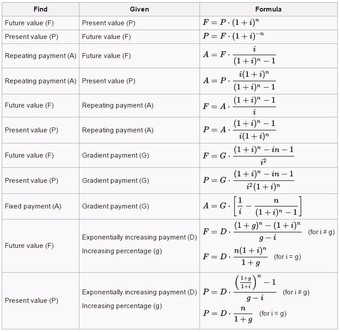
Annuities Equations
This table is a useful way to view the calculation of annuities variables from a number of directions. Understanding how to manipulate the formula will underline the relationship between the variables, and provide some conceptual clarity as to what annuities are.
5.5: Valuing Multiple Cash Flows
5.5.1: Future Value, Multiple Flows
To find the FV of multiple cash flows, sum the FV of each cash flow.
Learning Objective
Calculate the Future Value of Multiple Annuities
Key Points
- The FV of multiple cash flows is the sum of the FV of each cash flow.
- To sum the FV of each cash flow, each must be calculated to the same point in the future.
- If the multiple cash flows are a fixed size, occur at regular intervals, and earn a constant interest rate, it is an annuity. There are formulas for calculating the FV of an annuity.
Key Terms
- incremental cash flows
-
the additional money flowing in or out of a business due to a project
- annuity
-
A specified income payable at stated intervals for a fixed or a contingent period, often for the recipient’s life, in consideration of a stipulated premium paid either in prior installment payments or in a single payment. For example, a retirement annuity paid to a public officer following his or her retirement.
- cash flow
-
The sum of cash revenues and expenditures over a period of time.
Future Value, Multiple Cash Flows
Finding the future value (FV) of multiple cash flows means that there are more than one payment/investment, and a business wants to find the total FV at a certain point in time. These payments can have varying sizes, occur at varying times, and earn varying interest rates, but they all have a certain value at a specific time in the future.
The first step in finding the FV of multiple cash flows is to define when the future is. Once that is done, you can determine the FV of each cash flow using the formula in . Then, simply add all of the future values together.

FV of a single payment
The FV of multiple cash flows is the sum of the future values of each cash flow.
Manually calculating the FV of each cash flow and then summing them together can be a tedious process. If the cash flows are irregular, don’t happen at regular intervals, or earn different interest rates, there isn’t a special way to find the total FV.
However, if the cash flows do happen at regular intervals, are a fixed size, and earn a uniform interest rate, there is an easier way to find the total FV. Investments that have these three traits are called “annuities. “
There are formulas to find the FV of an annuity depending on some characteristics, such as whether the payments occur at the beginning or end of each period. There is a module that goes through exactly how to calculate the FV of annuities.
If the multiple cash flows are a part of an annuity, you’re in luck; there is a simple way to find the FV. If the cash flows aren’t uniform, don’t occur at fixed intervals, or earn different interest rates, the only way to find the FV is do find the FV of each cash flow and then add them together.
5.5.2: Present Value, Multiple Flows
The PV of multiple cash flows is simply the sum of the present values of each individual cash flow.
Learning Objective
Calculate the present value of an investment portfolio that has multiple cash flows
Key Points
- To find the PV of multiple cash flows, each cash flow much be discounted to a specific point in time and then added to the others.
- To discount annuities to a time prior to their start date, they must be discounted to the start date, and then discounted to the present as a single cash flow.
- Multiple cash flow investments that are not annuities unfortunately cannot be discounted by any other method but by discounting each cash flow and summing them together.
Key Terms
- discount
-
To find the value of a sum of money at some earlier point in time. To find the present value.
- net present value
-
the present value of a project or an investment decision determined by summing the discounted incoming and outgoing future cash flows resulting from the decision
The PV of multiple cash flows follows the same logic as the FV of multiple cash flows. The PV of multiple cash flows is simply the sum of the present values of each individual cash flow .

Sum FV
The PV of an investment is the sum of the present values of all its payments.
Each cash flow must be discounted to the same point in time. For example, you cannot sum the PV of two loans at the beginning of the loans if one starts in 2012 and one starts in 2014. If you want to find the PV in 2012, you need to discount the second loan an additional two years, even though it doesn’t start until 2014.
The calculations get markedly simpler if the cash flows make up an annuity. In order to be an annuity (and use the formulas explained in the annuity module), the cash flows need to have three traits:
- Constant payment size
- Payments occur at fixed intervals
- A constant interest rate
Things may get slightly messy if there are multiple annuities, and you need to discount them to a date before the beginning of the payments.
Suppose there are two sets of cash flows which you determine are both annuities. The first extends from 1/1/14 to 1/1/16, and the second extends from 1/1/15 to 1/1/17. You want to find the total PV of all the cash flows on 1/1/13.
The annuity formulas are good for determining the PV at the date of the inception of the annuity. That means that it’s not enough to simply plug in the payment size, interest rate, and number of periods between 1/1/13 and the end of the annuities. If you do, that supposes that both annuities begin on 1/1/13, but neither do. Instead, you have to first find the PV of the first annuity on 1/1/14 and the second on 1/1/15 because that’s when the annuities begin.
You now have two present values, but both are still in the future. You then can discount those present values as if they were single sums to 1/1/13.
Unfortunately, if the cash flows do not fit the characteristics of an annuity, there isn’t a simple way to find the PV of multiple cash flows: each cash flow much be discounted and then all of the PVs must be summed together.
Example
A corporation must decide whether to introduce a new product line. The new product will have start-up expenditures, operational expenditures, and then it will have associated incoming cash receipts (sales) and disbursements (Cash paid for materials, supplies, direct labor, maintenance, repairs, and direct overhead) over 12 years. This project will have an immediate (t=0) cash outflow of 100,000 (which might include all cash paid for the machinery, transportation-in and set-up expenditures, and initial employee training disbursements. ) The annual net cash flow (receipts less disbursements) from this new line for years 1-12 is forecast as follows: -54672, -39161, 3054, 7128, 25927, 28838, 46088, 77076, 46726, 76852, 132332, 166047, reflecting two years of running deficits as experience and sales are built up, with net cash receipts forecast positive after that. At the end of the 12 years it’s estimated that the entire line becomes obsolete and its scrap value just covers all the removal and disposal expenditures. All values are after-tax, and the required rate of return is given to be 10%. (This also makes the simplifying assumption that the net cash received or paid is lumped into a single transaction occurring on the last day of each year. )
The present value (PV) can be calculated for each year:
T=0:
T=1:
T=2:
T=3:
T=4:
T=5:
T=6:
T=7:
T=8:
T=9:
T=10:
T=11:
T=12:
The sum of all these present values is the net present value, which equals 65,816.04. Since the NPV is greater than zero, it would be better to invest in the project than to do nothing, and the corporation should invest in this project if there is no alternative with a higher NPV.
5.6: Additional Detail on Present and Future Values
5.6.1: The Relationship Between Present and Future Value
Present value (PV) and future value (FV) measure how much the value of money has changed over time.
Learning Objective
Discuss the relationship between present value and future value
Key Points
- The future value (FV) measures the nominal future sum of money that a given sum of money is “worth” at a specified time in the future assuming a certain interest rate, or more generally, rate of return. The FV is calculated by multiplying the present value by the accumulation function.
- PV and FV vary jointly: when one increases, the other increases, assuming that the interest rate and number of periods remain constant.
- As the interest rate (discount rate) and number of periods increase, FV increases or PV decreases.
Key Terms
- discounting
-
The process of finding the present value using the discount rate.
- present value
-
a future amount of money that has been discounted to reflect its current value, as if it existed today
- capitalization
-
The process of finding the future value of a sum by evaluating the present value.
The future value (FV) measures the nominal future sum of money that a given sum of money is “worth” at a specified time in the future assuming a certain interest rate, or more generally, rate of return. The FV is calculated by multiplying the present value by the accumulation function. The value does not include corrections for inflation or other factors that affect the true value of money in the future. The process of finding the FV is often called capitalization.
On the other hand, the present value (PV) is the value on a given date of a payment or series of payments made at other times. The process of finding the PV from the FV is called discounting.
PV and FV are related , which reflects compounding interest (simple interest has n multiplied by i, instead of as the exponent). Since it’s really rare to use simple interest, this formula is the important one.

FV of a single payment
The PV and FV are directly related.
PV and FV vary directly: when one increases, the other increases, assuming that the interest rate and number of periods remain constant.
The interest rate (or discount rate) and the number of periods are the two other variables that affect the FV and PV. The higher the interest rate, the lower the PV and the higher the FV. The same relationships apply for the number of periods. The more time that passes, or the more interest accrued per period, the higher the FV will be if the PV is constant, and vice versa.
The formula implicitly assumes that there is only a single payment. If there are multiple payments, the PV is the sum of the present values of each payment and the FV is the sum of the future values of each payment.
5.6.2: Calculating Perpetuities
The present value of a perpetuity is simply the payment size divided by the interest rate and there is no future value.
Learning Objective
Calculate the present value of a perpetuity
Key Points
- Perpetuities are a special type of annuity; a perpetuity is an annuity that has no end, or a stream of cash payments that continues forever.
- To find the future value of a perpetuity requires having a future date, which effectively converts the perpetuity to an ordinary annuity until that point.
- Perpetuities with growing payments are called Growing Perpetuities; the growth rate is subtracted from the interest rate in the present value equation.
Key Term
- growth rate
-
The percentage by which the payments grow each period.
Perpetuities are a special type of annuity; a perpetuity is an annuity that has no end, or a stream of cash payments that continues forever. Essentially, they are ordinary annuities, but have no end date. There aren’t many actual perpetuities, but the United Kingdom has issued them in the past.
Since there is no end date, the annuity formulas we have explored don’t apply here. There is no end date, so there is no future value formula. To find the FV of a perpetuity would require setting a number of periods which would mean that the perpetuity up to that point can be treated as an ordinary annuity.
There is, however, a PV formula for perpetuities . The PV is simply the payment size (A) divided by the interest rate (r). Notice that there is no n, or number of periods. More accurately, is what results when you take the limit of the ordinary annuity PV formula as n → ∞.
It is also possible that an annuity has payments that grow at a certain rate per period. The rate at which the payments change is fittingly called the growth rate (g). The PV of a growing perpetuity is represented as
. It is essentially the same as in except that the growth rate is subtracted from the interest rate. Another way to think about it is that for a normal perpetuity, the growth rate is just 0, so the formula boils down to the payment size divided by r.
5.6.3: Calculating Values for Different Durations of Compounding Periods
Finding the Effective Annual Rate (EAR) accounts for compounding during the year, and is easily adjusted to different period durations.
Learning Objective
Calculate the present and future value of something that has different compounding periods
Key Points
- The units of the period (e.g. one year) must be the same as the units in the interest rate (e.g. 7% per year).
- When interest compounds more than once a year, the effective interest rate (EAR) is different from the nominal interest rate.
- The equation in skips the step of solving for EAR, and is directly usable to find the present or future value of a sum.
Key Terms
- Future Value
-
The value of an asset at a specific date. It measures the nominal future sum of money that a given sum of money is “worth” at a specified time in the future, assuming a certain interest rate, or more generally, rate of return, it is the present value multiplied by the accumulation function.
- present value
-
Also known as present discounted value, is the value on a given date of a payment or series of payments made at other times. If the payments are in the future, they are discounted to reflect the time value of money and other factors such as investment risk. If they are in the past, their value is correspondingly enhanced to reflect that those payments have been (or could have been) earning interest in the intervening time. Present value calculations are widely used in business and economics to provide a means to compare cash flows at different times on a meaningful “like to like” basis.
Sometimes, the units of the number of periods does not match the units in the interest rate. For example, the interest rate could be 12% compounded monthly, but one period is one year. Since the units have to be consistent to find the PV or FV, you could change one period to one month. But suppose you want to convert the interest rate into an annual rate. Since interest generally compounds, it is not as simple as multiplying 1% by 12 (1% compounded each month). This atom will discuss how to handle different compounding periods.
Effective Annual Rate
The effective annual rate (EAR) is a measurement of how much interest actually accrues per year if it compounds more than once per year. The EAR can be found through the formula in where i is the nominal interest rate and n is the number of times the interest compounds per year (for continuous compounding, see ). Once the EAR is solved, that becomes the interest rate that is used in any of the capitalization or discounting formulas.

EAR with Continuous Compounding
The effective rate when interest compounds continuously.

Calculating the effective annual rate
The effective annual rate for interest that compounds more than once per year.
For example, if there is 8% interest that compounds quarterly, you plug .08 in for i and 4 in for n. That calculates an EAR of .0824 or 8.24%. You can think of it as 2% interest accruing every quarter, but since the interest compounds, the amount of interest that actually accrues is slightly more than 8%. If you wanted to find the FV of a sum of money, you would have to use 8.24% not 8%.
Solving for Present and Future Values with Different Compounding Periods
Solving for the EAR and then using that number as the effective interest rate in present and future value (PV/FV) calculations is demonstrated here. Luckily, it’s possible to incorporate compounding periods into the standard time-value of money formula. The equation in is the same as the formulas we have used before, except with different notation. In this equation, A(t) corresponds to FV, A0 corresponds to Present Value, r is the nominal interest rate, n is the number of compounding periods per year, and t is the number of years.

FV Periodic Compounding
Finding the FV (A(t)) given the PV (Ao), nominal interest rate (r), number of compounding periods per year (n), and number of years (t).
The equation follows the same logic as the standard formula. r/n is simply the nominal interest per compounding period, and nt represents the total number of compounding periods.
Solving for n
The last tricky part of using these formulas is figuring out how many periods there are. If PV, FV, and the interest rate are known, solving for the number of periods can be tricky because n is in the exponent. It makes solving for n manually messy. shows an easy way to solve for n. Remember that the units are important: the units on n must be consistent with the units of the interest rate (i).

Solving for n
This formula allows you to figure out how many periods are needed to achieve a certain future value, given a present value and an interest rate.
5.6.4: Comparing Interest Rates
Variables, such as compounding, inflation, and the cost of capital must be considered before comparing interest rates.
Learning Objective
Discuss the differences between effective interest rates, real interest rates, and cost of capital
Key Points
- A nominal interest rate that compounds has a different effective rate (EAR), because interest is accrued on interest.
- The Fisher Equation approximates the amount of interest accrued after accounting for inflation.
- A company will theoretically only invest if the expected return is higher than their cost of capital, even if the return has a high nominal value.
Key Term
- inflation
-
An increase in the general level of prices or in the cost of living.
The amount of interest you would have to pay on a loan or would earn on an investment is clearly an important consideration when making any financial decisions. However, it is not enough to simply compare the nominal values of two interest rates to see which is higher.
Effective Interest Rates
The reason why the nominal interest rate is only part of the story is due to compounding. Since interest compounds, the amount of interest actually accrued may be different than the nominal amount. The last section went through one method for finding the amount of interest that actually accrues: the Effective Annual Rate (EAR).
The EAR is a calculation that account for interest that compounds more than one time per year. It provides an annual interest rate that accounts for compounded interest during the year. If two investments are otherwise identical, you would naturally pick the one with the higher EAR, even if the nominal rate is lower.
Real Interest Rates
Interest rates are charged for a number of reasons, but one is to ensure that the creditor lowers his or her exposure to inflation. Inflation causes a nominal amount of money in the present to have less purchasing power in the future. Expected inflation rates are an integral part of determining whether or not an interest rate is high enough for the creditor.
The Fisher Equation is a simple way of determining the real interest rate, or the interest rate accrued after accounting for inflation. To find the real interest rate, simply subtract the expected inflation rate from the nominal interest rate.

Fisher Equation
The nominal interest rate is approximately the sum of the real interest rate and inflation.
For example, suppose you have the option of choosing to invest in two companies. Company 1 will pay you 5% per year, but is in a country with an expected inflation rate of 4% per year. Company 2 will only pay 3% per year, but is in a country with an expected inflation of 1% per year. By the Fisher Equation, the real interest rates are 1% and 2% for Company 1 and Company 2, respectively. Thus, Company 2 is the better investment, even though Company 1 pays a higher nominal interest rate.
Cost of Capital
Another major consideration is whether or not the interest rate is higher than your cost of capital. The cost of capital is the rate of return that capital could be expected to earn in an alternative investment of equivalent risk. Many companies have a standard cost of capital that they use to determine whether or not an investment is worthwhile.
In theory, a company will never make an investment if the expected return on the investment is less than their cost of capital. Even if a 10% annual return sounds really nice, a company with a 13% cost of capital will not make that investment.
5.6.5: Calculating Values for Fractional Time Periods
The value of money and the balance of the account may be different when considering fractional time periods.
Learning Objective
Calculate the future and present value of an account when a fraction of a compounding period has passed
Key Points
- The balance of an account only changes when interest is paid. To find the balance, round the fractional time period down to the period when interest was last accrued.
- To find the PV or FV, ignore when interest was last paid an use the fractional time period as the time period in the equation.
- The discount rate is really the cost of not having the money over time, so for PV/FV calculations, it doesn’t matter if the interest hasn’t been added to the account yet.
Key Terms
- time period assumption
-
business profit or loses are measured on timely basis
- compounding period
-
The length of time between the points at which interest is paid.
- time value of money
-
the value of an asset accounting for a given amount of interest earned or inflation accrued over a given period
Up to this point, we have implicitly assumed that the number of periods in question matches to a multiple of the compounding period. That means that the point in the future is also a point where interest accrues. But what happens if we are dealing with fractional time periods?
Compounding periods can be any length of time, and the length of the period affects the rate at which interest accrues.

Compounding Interest
The effect of earning 20% annual interest on an initial $1,000 investment at various compounding frequencies.
Suppose the compounding period is one year, starting January1, 2012. If the problem asks you to find the value at June 1, 2014, there is a bit of a conundrum. The last time interest was actually paid was at January 1, 2014, but the time-value of money theory clearly suggests that it should be worth more in June than in January.
In the case of fractional time periods, the devil is in the details. The question could ask for the future value, present value, etc., or it could ask for the future balance, which have different answers.
Future/Present Value
If the problem asks for the future value (FV) or present value (PV), it doesn’t really matter that you are dealing with a fractional time period. You can plug in a fractional time period to the appropriate equation to find the FV or PV. The reasoning behind this is that the interest rate in the equation isn’t exactly the interest rate that is earned on the money. It is the same as that number, but more broadly, is the cost of not having the money for a time period. Since there is still a cost to not having the money for that fraction of a compounding period, the FV still rises.
Account Balance
The question could alternatively ask for the balance of the account. In this case, you need to find the amount of money that is actually in the account, so you round the number of periods down to the nearest whole number (assuming one period is the same as a compounding period; if not, round down to the nearest compounding period). Even if interest compounds every period, and you are asked to find the balance at the 6.9999th period, you need to round down to 6. The last time the account actually accrued interest was at period 6; the interest for period 7 has not yet been paid.
If the account accrues interest continuously, there is no problem: there can’t be a fractional time period, so the balance of the account is always exactly the value of the money.
5.6.6: Loans and Loan Amortization
When borrowing money to be paid back via a number of installments over time, it is important to understand the time value of money and how to build an amortization schedule.
Learning Objective
Understand amortization schedules
Key Points
- Amortization of a loan is the process of identifying a payment amount for each period of repayment on a given outstanding debt.
- Repaying capital over time at an interest rate requires an amortization schedule, which both parties agree to prior to the exchange of capital. This schedule determines the repayment period, as well as the amount of repayment per period.
- Time value of money is a central concept to amortization. A dollar today, for example, is worth more than a dollar tomorrow due to the opportunity cost of other investments.
- When purchasing a home for $100,000 over 30 years at 8% interest (consistent payments each month), for example, the total amount of repayment is more than 2.5 times the original principal of $100,000.
Key Term
- amortization
-
This is the process of scheduling intervals of payment over time to pay back an existing debt, taking into account the time value of money.
When lending money (or borrowing, depending on your perspective), it is common to have multiple payback periods over time (i.e. multiple, smaller cash flow installments to pay back the larger borrowed sum). In these situations, an amortization schedule will be created. This will determine how much will be paid back each period, and how many periods of repayment will be required to cover the principal balance. This must be agreed upon prior to the initial borrowing occurs, and signed by both parties.
Time Value of Money
Now if you add up all of the separate payments in an amortization schedule, you’ll find the total exceeds the amount borrowed. This is because amortization schedules must take into account the time value of money. Time value of money is a fairly simple concept at it’s core: a dollar today is worth more than a dollar tomorrow.
Why? Because capital can be invested, and those investments can yield returns. Lending your money to someone means incurring the opportunity cost of the other things you could do with that money. This gets even more drastic as the scale of capital increases, as the returns on capital over time are expressed in a percentage of the capital invested. Say you spend $100 on some stock, and turn 10% on that investment. You now have $110, a profit of $10. Say instead of only a $100, you put in $10,000. Now you have $11,000, a profit of $1,000.
Principle and Interest
As a result of this calculation, amortization schedules charge interest over time as a percentage of the principal borrowed. The calculation will incorporate the number of payment periods (n), the principal (P), the amortization payment (A) and the interest rate (r).
To make this a bit more realistic, let’s insert some numbers. Let’s say you find a dream house, at the reasonable rate of $100,000. Unfortunately, a bit of irresponsible borrowing in your past means you must pay 8% interest over a 30 year loan, which will be paid via a monthly amortization schedule (12 months x 30 years = 360 payments total). If you do the math, you should find yourself paying $734 per month 360 times. 360 x 734 will leave you in the ballpark of $264,000 in total repayment. that means you are paying more than 2.5 times as much for this house due to time value of money! This bit of knowledge is absolutely critical for personal financial decisions, as well as for high level business decisions.
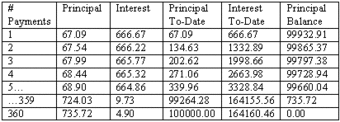
Amortization Schedule Example
This shows the first few installments in the example discussed above (i.e. borrowing $100,000 at 8% interest paid monthly over 30 years).
5.7: Yield
5.7.1: Calculating the Yield of a Single-Period Investment
The yield of a single period investment is simply
.
Learning Objective
Differentiate between the different methods of calculating yield of a single period investment
Key Points
- There are a number of ways to calculate yield, but the most common ones are to calculate the percent change from the initial investment, APR, and APY (or EAR).
- APR (annual percentage rate) is a commonly used calculation that figures out the nominal amount of interest accrued per year. It does not account for compounding interest.
- APY (annual percentage yield) is a way of using the nominal interest rate to calculate the effective interest rate per year. It accounts for compounding interest.
- EAR (effective annual rate) is a special type of APY that uses APR as the nominal interest rate.
Key Terms
- effective-interest method
-
amortizing a debt according to the effective interest rate paid
- Nominal Interest
-
The amount of interest accrued per year without accounting for compounding.
- Effective Interest
-
The amount of interest accrued per year after accounting for compounding.
Determining Yield
The yield on an investment is the amount of money that is returned to the owner at the end of the term. In short, it’s how much you get back on your investment.
Naturally, this is a number that people care a lot about. The whole point of making an investment is to get a yield. There are a number of different ways to calculate an investment’s yield, though. You may get slightly different numbers using different methods, so it’s important to make sure that you use the same method when you are comparing yields. This section will address the yield calculation methods you are most likely to encounter, though there are many more.
Change-In-Value
The most basic type of yield calculation is the change-in-value calculation. This is simply the change in value (FV minus PV) divided by the PV times 100%. This calculation measures how different the FV is from the PV as a percentage of PV.

Percent Change
The percent change in value is the change in value from PV to FV (V2 to V1) divided by PV (V1) times 100%.
Annual Percentage Rate
Another common way of calculating yield is to determine the Annual Percentage Rate, or APR. You may have heard of APR from ads for car loans or credit cards. These generally have monthly loans or fees, but if you want to get an idea of how much you will accrue in interest per year, you need to calculate an APR. Nominal APR is simply the interest rate multiplied by the number of payment periods per year. However, since interest compounds, nominal APR is not a very accurate measure of the amount of interest you actually accrue.
Effective Annual Rate
To find the effective APR, the actual amount of interest you would accrue per year, we use the Effective Annual Rate, or EAR.

EAR
The Effective Annual Rate is the amount of interest actually accrued per year based on the APR. n is the number of compounding periods of APR per year.
For example, you may see an ad that says you can get a car loan at an APR of 10% compounded monthly. That means that APR=.10 and n=12 (the APR compounds 12 times per year). That means the EAR is 10.47%.
The EAR is a form of the Annual Percentage Yield (APY). APY may also be calculated using interest rates other than APR, so a more general formula is in . The logic behind calculating APY is the same as that used when calculating EAR: we want to know how much you actually accrue in interest per year. Interest usually compounds, so there is a difference between the nominal interest rate (e.g. monthly interest times 12) and the effective interest rate.

Annual Percentage Yield
The Annual Percentage Yield is a way or normalizing the nominal interest rate. Basically, it is a way to account for the time factor in order to get a more accurate number for the actual interest rate.inom is the nominal interest rate.N is the number of compounding periods per year.
5.7.2: Calculating the Yield of an Annuity
The yield of an annuity is commonly found using either the percent change in the value from PV to FV, or the internal rate of return.
Learning Objective
Calculate the yield of an annuity using the internal rate of return method
Key Points
- The yield of an annuity may be found by discounting to find the PV, and then finding the percentage change from the PV to the FV.
- The Internal Rate of Return (IRR) is the discount rate at which the NPV of an investment equals 0.
- The IRR calculates an annualized yield of an annuity.
Key Terms
- Net Present Value (NPV)
-
The present value of a project or an investment decision determined by summing the discounted incoming and outgoing future cash flows resulting from the decision.
- Internal Rate of Return (IRR)
-
The discount rate that will cause the NPV of an investment to equal 0.
- yield
-
In finance, the term yield describes the amount in cash that returns to the owners of a security. Normally it does not include the price variations, at the difference of the total return. Yield applies to various stated rates of return on stocks (common and preferred, and convertible), fixed income instruments (bonds, notes, bills, strips, zero coupon), and some other investment type insurance products
The yield of annuity can be calculated in similar ways to the yield for a single payment, but two methods are most common.
The first is the standard percentage-change method. Just as for a single payment, this method calculated the percentage difference between the FV and the PV. Since annuities include multiple payments over the lifetime of the investment, the PV (or V1 in is the present value of the entire investment, not just the first payment.
The second popular method is called the internal rate of return (IRR). The IRR is the interest rate (or discount rate) that causes the Net Present Value (NPV) of the annuity to equal 0. That means that the PV of the cash outflows equals the PV of the cash inflows. The higher the IRR, the more desirable is the investment. In theory, you should make investment with an IRR greater than the cost of capital.
Let’s take an example investment: It is not technically an annuity because the payments vary, but still is a good example for how to find IRR:
Suppose you have a potential investment that would require you to make a $4,000 investment today, but would return cash flows of $1,200, $1,410, $1,875, and $1,050 in the four successive years. This investment has an implicit rate of return, but you don’t know what it is. You plug the numbers into the NPV formula and set NPV equal to 0. You then solve for r, which is your IRR (it’s not easy to solve this problem by hand. You will likely need to use a business calculator or Excel). When r = 14.3%, NPV = 0, so therefore the IRR of the investment is 14.3%.

IRR Example
The setup to find the IRR of the investment with cash flows of -4000, 1200, 1410, 1875, and 1050. By setting NPV = 0 and solving for r, you can find the IRR of this investment.
Chapter 4: Forecasting Financial Statements
4.1: The Role of Financial Forecasting in Planning
4.1.1: Strategic Planning
The financial forecast is a key input to strategic planning, a firm’s process of defining strategy and making decisions about allocating resources.
Learning Objective
Explain how financial forecasting influences a company’s strategic planning
Key Points
- Using historical internal accounting and sales data, in addition to external market and economic indicators, a financial forecast is an economist’s best guess of what will happen to a company in financial terms over a given time period, which is usually one year.
- Financial forecasting is often helped by financial modeling processes. Financial modeling is the task of building an abstract representation (a model) of a financial decision-making situation.
- Assumptions play a key role in financial forecasts and can affect the way the forecasts predict the outcomes of decisions made on the corporate level.
Key Terms
- financial modeling
-
the task of building an abstract representation (a model) of a financial decision making situation.
- financial forecast
-
estimate of future financial outcomes for a company or country
- strategy
-
A plan of action intended to accomplish a specific goal
Strategic Planning
Strategic planning is an organization’s process of defining its strategy, or direction, and making decisions about allocating resources to pursue this strategy. In order to determine the direction of the organization, it is necessary to understand its current position and the possible avenues through which it can pursue a particular course of action.
A financial forecast is an estimate of future financial outcomes for a company. Using historical internal accounting and sales data, in addition to external market and economic indicators, a financial forecast is an economist’s best guess of what will happen to a company in financial terms over a given time period—which is usually one year. Often, the forecaster’s own assumptions and beliefs will be used to guess future growth rates and potential events that will affect the numbers on a financial statement.
Arguably, the most difficult aspect of preparing a financial forecast is predicting revenue. Future costs can be estimated by using historical accounting data; variable costs are also a function of sales. Unlike a financial plan or a budget, a financial forecast doesn’t have to be used as a planning document. Outside analysts can use a financial forecast to estimate a company’s success in the coming year.

Strategic Planning
Financial forecasting is essential for a company’s strategic planning, management, and organization.
Financial forecasting is often helped by processes of financial modeling. Financial modeling is the task of building an abstract representation (a model) of a financial decision making situation. This is a mathematical model designed to represent a simplified version of the performance of a financial asset or portfolio of a business, project, or any other investment. Financial modeling is a general term that means different things to different users; the reference usually relates either to accounting and corporate finance applications, or to quantitative finance applications.Typically, financial modelling is understood to mean an exercise in either asset pricing or corporate finance, of a quantitative nature. In other words, financial modelling is about translating a set of hypotheses about the behavior of markets or agents into numerical predictions; for example, a firm’s decisions about investments or investment returns. Once again, these are assumptions that will factor into the financial forecasting and planning for the corporation. Once the financial statements are forecast, one can attach a value to the firm, and see what changes need to be made to put the company in a better financial position.
4.1.2: Additional Funds Needed (AFN)
AFN is “additional funds needed,” and refers to the additional resources that will be needed for a company to expand its operations.
Learning Objective
Calculate the additional funds needed equation
Key Points
- AFN is a way of calculating how much new funding will be required, so that the firm can realistically look at whether or not they will be able to generate the additional funding and therefore be able to achieve the higher sales level.
- The simplified formula is: AFN = Projected increase in assets – spontaneous increase in liabilities – any increase in retained earnings. If this value is negative, this means the action or project which is being undertaken will generate extra income for the company, which can be invested elsewhere.
- The mathematical formulas used to determine AFN are based on showing how liabilities will grow relative to new assets and sales when a project is undertaken and can be used as tools to determine whether a project or operational expansion is worthwhile.
Key Terms
- liabilities
-
An amount of money in a company that is owed to someone and has to be paid in the future, such as tax, debt, interest, and mortgage payments.
- asset
-
Something or someone of any value; any portion of one’s property or effects so considered.
- sales
-
Revenues
AFN stands for “additional funds needed. ” It is a concept used most commonly in business looking to expand operations and influence. Since a business that seeks to increase its sales level will require more assets to meet that goal, some provision must be made to accommodate the change in assets . To phrase it another way, the business must have some plan to actually finance the new assets that will be needed to increase sales.

Assets – Economic Resources
AFN determines the extra assets and financing that will be needed for a firm to undertake a new project or expand its operations and sales.
AFN is a way of calculating how much new funding will be required, so that the firm can realistically look at whether or not they will be able to generate the additional funding and therefore be able to achieve the higher sales level. Determining the amount of external funding needed is a key part of calculating AFN. This can be determined by mathematical formulas which use inputs that can be found in a company’s financial statements.
The simplified formula is:
AFN = Projected increase in assets – spontaneous increase in liabilities – any increase in retained earnings.
If this value is negative, this means the action or project which is being undertaken will generate extra income for the company, which can be invested elsewhere.
The more formal equation for AFN is
AFN = (A*/S0)ΔS – (L*/S0)ΔS – MS1(RR)
- A- Assets tied directly to sales
- L-spontaneous liabilities that are affected by sales
- S0=the previous year’s sales
- S1=total projected sales for next year
- ΔS=the change in sales between S0 and S1
- M=profit margin
- MS1=projected net income
- RR=the retention ratio from net income (equal to 1 minus the dividend payout ratio; disregard if dividends are not declared).
4.1.3: Adjusting Capacity
Capacity adjustment takes into account maximum production levels and the alteration of this level depending on how the firm wants to grow.
Learning Objective
Calculate a company’s capacity using a variety of information
Key Points
- Capacity planning is the process of determining the production capacity needed by an organization to meet changing demands for its products.
- Capacity utilization is a concept in economics and managerial accounting which refers to the extent to which an enterprise or a nation actually uses its installed productive capacity.
- When planning out how to manage capacity at the optimal level to attain the long term goals of the firm, capacity planning and utilization and other processes should be analyzed.
Key Terms
- capacity
-
The maximum that can be produced on a machine or in a facility or group.
- capitalism
-
A socio-economic system based on private property rights, including the private ownership of resources or capital, with economic decisions made largely through the operation of a market unregulated by the state.
- forecast
-
An estimation of a future condition.
Adjusting capacity takes into account the maximum level of output that can be produced by a firm, and how that can be changed in order to change the potential forecasts of a firm’s performance long term . This involves capacity planning and management that will keep a firm from growing too fast in sales and making sure it is utilizing capital in the most efficient way possible. Capacity planning is the process of determining the production capacity needed by an organization to meet changing demands for its products. In the context of capacity planning, “design capacity” is the maximum amount of work that an organization is capable of completing in a given period. “Effective capacity” is the maximum amount of work that an organization is capable of completing in a given period due to constraints such as quality problems, delays, material handling, etc.

Thunderbird Assembly Line
Adjusting capacity will affect the amount of items produced on the assembly line.
Capacity utilization is a concept in economics and managerial accounting that refers to the extent to which an enterprise or a nation actually uses its installed productive capacity. Therefore, it refers to the relationship between actual output that ‘is’ produced with the installed equipment and the potential output which ‘could’ be produced with it, if capacity was fully used. Implicitly, the capacity utilization rate is also an indicator of how efficiently the factors of production are being used. Much statistical and anecdotal evidence shows that many industries in the developed capitalist economies suffer from chronic excess capacity. Therefore, critics of market capitalism argue the system is not as efficient as it may seem, since at least 1/5 more output could be produced and sold, if buying power was better distributed. However, a level of utilization somewhat below the maximum prevails, regardless of economic conditions. As a result, we look into capacity utilization to forecast a firm’s success and growth numbers when predicting how financial statements will look into the future. The decision makers at the firm will be able to adjust this capacity in order to grow the firm in a way they feel is optimal.
4.2: Overview of Forecasting
4.2.1: Inputs
The main inputs of forecasting include time series, cross-sectional and longitudinal data, or using judgmental methods.
Learning Objective
Describe the different forecasting methods
Key Points
- Forecasting is the process of making statements about events whose actual outcomes (typically) have not yet been observed.
- Time series is a sequence of data points, measured typically at successive time instants spaced at uniform time intervals.
- Cross-sectional data refers to data collected by observing many subjects at the same point of time, or without regard to differences in time.
- A longitudinal data involves repeated observations of the same variables over long periods of time — often many decades.
- Judgmental forecasting methods incorporate intuitive judgements, opinions and subjective probability estimates.
Key Terms
- nonprobability sample
-
a subset of the population in which the probability of getting any particular sample may be calculated, and therefore cannot be used to represent the whole population
- Dow Jones index
-
It is an index that shows how 30 large publicly-owned companies based in the United States have traded during a standard trading session in the stock market.
- probability sample
-
a technique of studying a population subset in which the liklihood of getting any particular subset may be calculated
Forecasting in Accounting
In corporate finance, investment banking, and the accounting profession, financial modeling is largely synonymous with cash flow forecasting.
This usually involves the preparation of detailed company specific models used for decision making purposes and financial analysis.
A financial forecast is an estimate of future financial outcomes for a company or country (for futures and currency markets). Using historical internal accounting and sales data, in addition to external market and economic indicators, a financial forecast is an economist’s best guess of what will happen to a company in financial terms over a given time period—usually one year.
Challenges
Arguably, the most difficult aspect of preparing a financial forecast is predicting revenue. Future costs can be estimated by using historical accounting data; variable costs are also a function of sales.
Forecasting vs. Financial Plans and Budgets
Unlike a financial plan or a budget, a financial forecast doesn’t have to be used as a planning document. Outside analysts can use a financial forecast to estimate a company’s success in the coming year.
Forecasting is the process of making statements about events whose actual outcomes (typically) have not yet been observed. A commonplace example might be the estimation of some variable of interest at some specified future date. Prediction is a similar, but more general term. Both might refer to formal statistical methods employing time series, cross-sectional or longitudinal data, or less formal judgmental methods.
Time Series Data
Time series is a sequence of data points, measured typically at successive time instants and spaced at uniform time intervals. Examples of time series are the daily closing value of the Dow Jones index or the annual flow volume of the Nile River at Aswan. Time series analysis comprises methods for analyzing time series data in order to extract meaningful statistics and other characteristics of the data. Time series forecasting is the use of a model to predict future values based on previously observed values. Time series are very frequently plotted via line charts.

Time Series Data
Wall Street uses time series data to monitor the stock market.
Cross-sectional data
Cross-sectional data refers to data collected by observing many subjects (such as individuals, firms or countries/regions) at the same point in time, or without regard to differences in time. Analysis of cross-sectional data usually consists of comparing the differences among the subjects.
For example, if we want to measure current obesity levels in a population, we could randomly draw a sample of 1,000 people from the population (also known as a cross section of that population), measure their weight and height, and calculate what percentage of that sample is categorized as obese. For example, 30% of our sample may be categorized as obese based on our measures. This cross-sectional sample provides us with a snapshot of that population, at that one point in time. Note that we do not know based on one cross-sectional sample if obesity is increasing or decreasing; we can only describe the current proportion. Cross-sectional data differs from time series data also known as longitudinal data, which follows one subject’s changes over the course of time. Another variant, panel data (or time-series cross-sectional (TSCS) data), combines both and looks at multiple subjects and how they change over the course of time. Panel analysis uses panel data to examine changes in variables over time and differences in variables between subjects.
Longitudinal Data
A longitudinal study is a correlational research study that involves repeated observations of the same variables over long periods of time — often many decades. It is a type of observational study. Longitudinal studies are often used in psychology to study developmental trends across the life span, and in sociology to study life events throughout lifetimes or generations. The reason for this is that unlike cross-sectional studies, in which different individuals with same characteristics are compared, longitudinal studies track the same people, and therefore the differences observed in those people are less likely to be the result of cultural differences across generations. Because of this benefit, longitudinal studies make observing changes more accurate, and they are applied in various other fields. In medicine, the design is used to uncover predictors of certain diseases. In advertising, the design is used to identify the changes that adverts have produced in the attitudes and behaviors of those within the target audience who have seen the advertising campaign.
Judgmental methods
Judgmental forecasting methods incorporate intuitive judgements, opinions and subjective probability estimates, such as Composite forecasts, Delphi method, Forecast by analogy, Scenario building, Statistical surveys and Technology forecasting.
Usage of forecasting can differ between areas of application: for example, in hydrology, the terms “forecast” and “forecasting” are sometimes reserved for estimates of values at certain specific future times, while the term “prediction” is used for more general estimates, such as the number of times floods will occur over a long period.
4.2.2: Steps Required to Forecast
Steps of forecast include problem definition, cash flow forecast, profit forecast, balance sheet forecast and profit determination.
Learning Objective
Describe the process for performing a forecast
Key Points
- It is important to note those earlier identified ‘threats’ to your business to ensure that as you forecast you can see the deviation of the best and worst models.
- Three key forecasts include problem definition, cash flow forecast, profit forecast, and balance sheet forecast.
- By completing these scenarios you gain an insight into the various risks that a business faces.
Key Term
- taxable income
-
Taxable income refers to the base upon which an income tax system imposes tax.
Example
- For example, if a business has previously identified the threat of a diminishing cheap labor force, then its forecast needs to reflect that the price of labor (or any other resource, such as power) is going to go up.
Problem definition
It is important to note those earlier identified ‘threats’ to your business to ensure that, as you forecast, you can see the deviation of the best and worst models. For example, if a business has previously identified the threat of a diminishing cheap labor force, then its forecast needs to reflect that the price of labor (or any other resource, such as power) is going to go up.

Forecast
Just like a weather forecast, businesses use different types of forecasts to analyze and prepare for their futures.
Three key forecasts
Cash flow forecast
This seeks to forecast a bank balance after a period – typically 12 months. This forecast shows the sources and application of funds.
Profit forecast
This modifies the cash flow in an attempt to calculate taxable income and, in the process, forecast a businesses income tax liability. There are two differences between a cash flow and a profit forecast. The cash flow forecast includes all expenditure in the period, whereas the profit forecast looks to match revenue with the costs associated with generating that revenue. To achieve this, one uses non-cash expenses to estimate some of the costs associated with running a business.
These two forecasts are reconciled with a forecast balance sheet.
Balance sheet forecast
While we have based this example on a smaller business and, while forecasting balance sheets demonstrates completeness and a high level of technical integrity in forecasting, we feel the process is complex and better left to a professional. We also feel that the additional benefit is outweighed by the costs for a small business.
It is always easier to forecast the future performance of a business if your business is already up and running as there are past trading results to look at. When a completely new venture is being planned, a certain amount of imagination is required. However, this is in no way a license to be overly optimistic.
Basic Steps
By completing these scenarios you gain an insight into the various risks that a business faces. Spreadsheet programs make this quite easy if they are well set up.
1. The
sales
forecast
This is the dominant influence on the performance of your business. Also, many expenses have a link to the level of activity in a business.
For existing businesses, past sales are the best predictor of future sales, for new businesses it is less simple. However, once the business is established, you will find you have a better understanding between the business’s products and its markets.
The most important thing is to keep detailed records of sales as it is these that will provide you with the growing ability to forecast income accurately.
- Forecast the number of units you expect to sell
- Begin with an analysis of current performance
- Divide sales into appropriate categories
- Consider factors that affect each category
- Internal factors might include staffing changes (for service industries)
- External factors might include the impact of inflation – current relevance
- Now attempt to forecast unit sales in cash category
2. Multiply by unit price
3. Determine market price
4. Cost plus
- Expected mark-up
- Expected revenue per unit sold
- Statistical review of the market
- Determination of units sold
- Seasonal sales pattern
- Cash flow
- Every business needs cash (sometimes called liquidity) to keep going.
- Forecasting cash flow lets us anticipate liquidity problems and helps identify solutions.
5. Profit determination
The essential difference between cash flow and profit is that cash flow includes all items of income and expense, whereas profit seeks to match income and costs related to the generation of the income in a period of time; usually 12 months.
To facilitate the calculation of profit (and hence, the income tax due) the cash flow statements were split into four sections. We now take the total of income and the operational costs into a Profit Statement. We add depreciation to the operational costs and subtract our adjusted operational costs from income. This difference will indicate a profit (where the difference is positive) or a loss (where the difference is negative).
Where there is profit, we need to then calculate income tax. This calculation depends on the legal structure adopted for the business. Where a business is registered for Goods and Services Tax, we take only the net payments and receipts into account.
It should be noted there is always a risk in new product development. Despite the time and effort put into planning the new product may not earn a significant return on investment.
4.3: Forecasting the Income Statement
4.3.1: Sales Forecast Input
Target volume, price, and contribution margin per unit are the key inputs to a sales forecast.
Learning Objective
Apply forecasting techniques to determine a company’s target volume
Key Points
- Net sales are operating revenues earned by a company for selling its products or rendering its services.
- Gross sales are the sum of all sales during a time period. Net sales are gross sales minus sales returns, sales allowances, and sales discounts.
- The purpose of profit-based sales target metrics is to ensure that marketing and sales objectives mesh with profit targets.
Key Terms
- fixed costs
-
In economics, fixed costs are business expenses that are not dependent on the level of goods or services produced by the business.
- contribution margin
-
In cost-volume-profit analysis, a form of management accounting, contribution margin is the marginal profit per unit sale.
Sales
Net sales are operating revenues earned by a company for selling its products or rendering its services. Also referred to as revenue, they are reported directly on the income statement as Sales or Net sales.
For financial ratios that use income statement sales values, “sales” refers to net sales, not gross sales. Sales are the unique transactions that occur in professional selling or during marketing initiatives.
The term sales in a marketing, advertising or a general business context often refers to a contract in which a buyer has agreed to purchase some products at a set time in the future. “Outstanding orders” refers to sales orders that have not been filled.
A sale is a transfer of property for money or credit. In double-entry bookkeeping, a sale of merchandise is recorded in the general journal as a debit to cash or accounts receivable and a credit to the sales account. A discount from list price might be noted if it applies to the sale (discount expense debit).
Fees for services are recorded separately from sales of merchandise, but the bookkeeping transactions for recording sales of services are similar to those for recording sales of tangible goods.
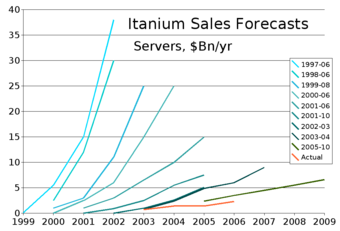
Sales Forecasting
An example of sales forecasting for a company over a decade.
Forecasting: Gross Sales and Net Sales
Net sales = Gross sales – (Customer discounts, returns, allowances)
Gross sales are the sum of all sales during a time period. Net sales are gross sales minus sales returns, sales allowances, and sales discounts. Gross sales do not normally appear on an income statement. The sales figures reported on an income statement are net sales.
- sales returns are refunds to customers for returned merchandise/credit notes
- debit notes
- sales journal entries non-current, current batch-processed transactions, predictive analytics in strategic management/administration/governance research metaframeworks
- sales allowances are reductions in sales price for merchandise with minor defects, the allowance agreed upon after the customer has purchased the merchandise
- sales discounts allowed are reduced payments from the customer based on invoice payment terms such as 2/10, n/30 (2% discount if paid within 10 days, net invoice total due in 30 days)
- interest received for amounts in arrears
- includes/excludes amounts capital goods & services, non-capital goods & services, input valued-added tax, with cost of non-capital goods sold
- input vat – output vat
- sales of portfolio items and capital gains taxes
- Sales Returns and Allowances and Sales Discounts are contra-revenue accounts
Sales Forecasting
In launching a program, managers often start with an idea of the dollar profit they desire and ask what sales levels will be required to reach it. Target volume is the unit sales quantity required to meet an earnings goal. Target revenue is the corresponding figure for dollar sales. Both of these metrics can be viewed as extensions of break-even analysis. Increasingly, marketers are expected to generate volumes that meet the target profits of their firm. This will often require them to revise sales targets as prices and costs change.
- Target volume: the volume of sales necessary to generate the profits specified in a company’s plans.
- Target Volume = [Fixed costs + Target Profits] / Contribution per Unit
- The formula for target volume will be familiar to those who have performed break-even analysis. The only change is to add the required profit target to the fixed costs. From another perspective, the break-even volume equation can be viewed as a special case of the general target volume calculation — one in which the profit target is zero, and a company seeks only to cover its fixed costs.
- In target volume calculations, the company broadens this objective to solve for a desired profit.
- Target Revenue = Target Volume * Selling Price per Unit; or
- Target Revenue = 100 * [ { Fixed Costs + Target Profits } / Contribution Margin ]
The purpose of profit-based sales target metrics is to ensure that marketing and sales objectives mesh with profit targets. In target volume and target revenue calculations, managers go beyond break-even analysis (the point at which a company sells enough to cover its fixed costs) to determine the level of unit sales or revenues needed not only to cover a firm’s costs but also to attain its profit targets.
4.3.2: Inputs to the Production Schedule
Production schedule can be divided into raw materials, work in process, finished goods and goods for resale.
Learning Objective
Differentiate the different production schedule inputs
Key Points
- A good purchased as a “raw material” goes into the manufacture of a product.
- A good only partially completed during the manufacturing process is called “work in process”.
- When the good is completed as to manufacturing but not yet sold or distributed to the end-user, it is called a “finished good”.
- Inventory management is primarily about specifying the shape and percentage of stocked goods.
- Basic reasons for keeping an inventory involve time, uncertainty and economics of scales.
Key Term
- ABC analysis
-
The ABC analysis is a business term used to define an inventory categorization technique often used in materials management. It is also known as Selective Inventory Control. Policies based on ABC analysis: A ITEMS, very tight control and accurate records; B ITEMS, less tightly controlled, and good records; and C ITEMS, simplest controls possible and minimal records.
Example
- By taking the Costs-To-Date divided by the Cost Estimate, the “percentage complete” for the project is calculated. For example: Assume a project is estimated to cost $70,000 by the time the work is complete, Assume at the end of December, $35,000 has been spent to date for the project, $35,000 divided by $70,000 is 50%, therefore, the project can be considered 50% complete at December 31.
Production schedule inputs:
- A good purchased as a “raw material” goes into the manufacture of a product.
- A good only partially completed during the manufacturing process is called “work in process. “
- When the good is completed as to manufacturing but not yet sold or distributed to the end user, it is called a “finished good. “
Raw materials – materials and components scheduled for use in making a product.
A raw material is the basic material from which a product is manufactured or made, frequently used with an extended meaning. For example, the term is used to denote material that came from nature and is in an unprocessed or minimally processed state. Latex, iron ore, logs, and crude oil, and salt water are examples. The use of raw material by non-human species includes twigs and found objects as used by birds to make nests.
Work in process, WIP – materials and components that have begun their transformation to finished goods.
Work in process (WIP) or in-process inventory includes the set at large of unfinished items for products in a production process. These items are not yet completed but either just being fabricated or waiting in a queue for further processing or in a buffer storage. The term is used in production and supply chain management.
Optimal production management aims to minimize work in process. Work in process requires storage space, represents bound capital not available for investment, and carries an inherent risk of earlier expiration of shelf life of the products. A queue leading to a production step shows that the step is well buffered for shortage in supplies from preceding steps, but may also indicate insufficient capacity to process the output from these preceding steps.
Finished goods – goods ready for sale to customers.
Finished goods are goods that have completed the manufacturing process but have not yet been sold or distributed to the end user. Finished goods is a relative term. In a Supply chain management flow, the finished goods of a supplier can constitute the raw material of a buyer.
Goods for resale – returned goods that are salable.
Inventory management
Inventory management is primarily about specifying the shape and percentage of stocked goods. It is required at different locations within a facility or within many locations of a supply network to precede the regular and planned course of production and stock of materials.
The scope of inventory management concerns the fine lines between replenishment lead time, carrying costs of inventory, asset management, inventory forecasting, inventory valuation, inventory visibility, future inventory price forecasting, physical inventory, available physical space for inventory, quality management, replenishment, returns and defective goods, and demand forecasting. Balancing these competing requirements leads to optimal inventory levels, which is an on-going process as the business needs shift and react to the wider environment.
Inventory management involves a retailer seeking to acquire and maintain a proper merchandise assortment while ordering, shipping, handling, and related costs are kept in check. It also involves systems and processes that identify inventory requirements, set targets, provide replenishment techniques, report actual and projected inventory status, and handle all functions related to the tracking and management of material. This would include the monitoring of material moved into and out of stockroom locations and the reconciling of the inventory balances. It also may include ABC analysis, lot tracking, cycle counting support, etc. Management of the inventories, with the primary objective of determining/controlling stock levels within the physical distribution system, functions to balance the need for product availability against the need for minimizing stock holding and handling costs.
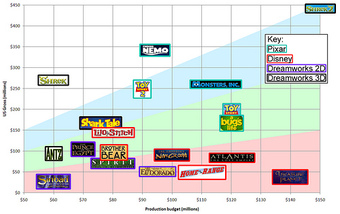
Production budget
Production budget is important for inventory and sales revenue
There are three basic reasons for keeping an inventory:
- Time: The time lags present in the supply chain, from supplier to user at every stage, requires that you maintain certain amounts of inventory to use in this lead time. However, in practice, inventory is to be maintained for consumption during variations in lead time. Lead time itself can be addressed by ordering that many days in advance.
- Uncertainty: Inventories are maintained as buffers to meet uncertainties in demand, supply and movements of goods.
- Economies of scale: Ideal condition of “one unit at a time at a place where a user needs it, when he needs it” principle tends to incur lots of costs in terms of logistics. So bulk buying, movement, and storing brings in economies of scale, thus inventory.

A Sample Production Plan
An example of a production plan covering one week.
4.3.3: Inputs to COGS
COGS is difficult to forecast due to the sheer amount of expenses included and differing methods of estimating each.
Learning Objective
Classify the different components of Cost of Goods Sold (COGS)
Key Points
- Costs include all costs of purchase, costs of conversion, and other costs incurred in bringing the inventories to their present location and condition.
- The key components of cost generally include: parts – raw materials and supplies used, labor – including associated costs such as payroll taxes and benefits, and overhead of the business allocable to production.
- A miscalculation or faulty estimation can be amplified drastically, causing a vastly different forecasted amount of income than what will actually come to pass.
Key Terms
- overhead
-
Any cost or expenditure (monetary, time, effort or otherwise) incurred in a project or activity, which does not directly contribute to the progress or outcome of the project or activity.
- allocate
-
To distribute according to a plan.
Cost of goods sold (COGS) refer to the inventory costs of the goods a business has sold during a particular period. Costs include all costs of purchase, costs of conversion, and other costs incurred in bringing the inventories to their present location and condition. Costs of goods made by the business include material, labor, and allocated overhead. The costs of those goods not yet sold are deferred as costs of inventory until the inventory is sold or written down in value.
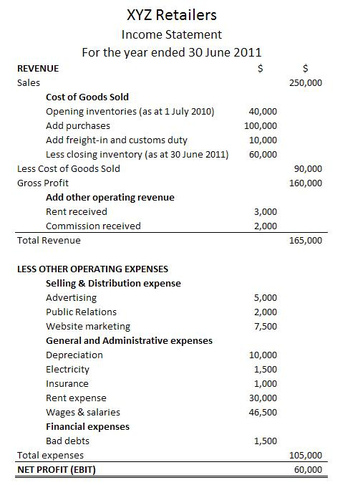
A Sample Income Statement
Expenses are listed on a company’s income statement.
Because costs of goods sold is a major expense for most companies, it is an extremely important input to a forecast of the income statement. A miscalculation or faulty estimation can be amplified drastically, causing a vastly different forecasted amount of income than what will actually come to pass. Specifically, underestimating the costs associated with goods to be sold can cause the forecasted income to be much higher than what it actually will be, and vice versa. Also, because cost of goods sold is such a broad input, encompassing many separate expenses with different methods of estimating each, it becomes difficult to accurately forecast all phases.
Components of COGS
Parts, Raw Materials, and Supplies Used
Most businesses make more than one of a particular item. Therefore, costs are incurred for multiple items rather than a particular item sold. Determining how much of each of these components to allocate to particular goods requires either tracking the particular costs or making some allocations of costs. Parts and raw materials are often tracked to particular sets (e.g., batches or production runs) of goods, then allocated to each item.
Labor and Associated Costs
Labor costs include direct labor and indirect labor. Direct labor costs are the wages paid to those employees who spend all their time working directly on the product being manufactured. Indirect labor costs are the wages paid to other factory employees involved in production. Costs of payroll taxes and employee benefits are generally included in labor costs, but may be treated as overhead costs. Labor costs may be allocated to an item or set of items based on timekeeping records.
Overhead of the Business Allocable to Production
Determining overhead costs often involves making assumptions about what costs should be associated with production activities and what costs should be associated with other activities. Traditional methods attempt to make these assumptions based on past experience and management judgment as to factual relationships. Activity based costing attempts to allocate costs based on those factors that drive the business to incur the costs.
Variable production overheads are allocated to units produced based on actual use of production facilities. Fixed production overheads are often allocated based on normal capacities or expected production. More or fewer goods may be produced than expected when developing cost assumptions (like burden rates). These differences in production levels often result in too much or too little cost being assigned to the goods produced. This also gives rise to variances.
4.3.4: Other Expenses
Other expenses include SG&A, depreciation, amortization, R&D, finance costs, income tax expense, discontinued operations expenses.
Learning Objective
Differentiate the different inputs that are classified as “other expenses”
Key Points
- Other expenses include operation expenses section and non-operation expenses section.
- Operation section expenses include SG&A, depreciation, amortization, and R&D expenses.
- Non-operation section expenses include finance costs, income tax expense, and discontinued operations expenses.
- SG&A is usually understood as a major portion of non-production related costs, in contrast to production costs such as direct labour.
Key Terms
- intangible assets
-
Intangible assets are defined as identifiable non-monetary assets that cannot be seen, touched or physically measured, and are created through time and effort, and are identifiable as a separate asset.
- deferred tax liabilities
-
Deferred tax liabilities generally arise where tax relief is provided in advance of an accounting expense, or income is accrued but not taxed until received.
Example
- Extraordinary items: natural disaster might not qualify depending on location.
Operation Section:

Expenses
Operational expenses and non-operational expenses are the main cash outflow of a business.
Selling, General, and Administrative expenses (SG&A or SGA)
Selling, General, and Administrative expenses (SG&A or SGA) consist of the combined payroll costs. SGA is usually understood as a major portion of non-production related costs, in contrast to production costs such as direct labor.
- Selling expenses – represent expenses needed to sell products (e.g. salaries of sales people, commissions and travel expenses, advertising, freight, shipping, depreciation of sales store buildings and equipment, rent, and all expenses and taxes directly related to producing and selling product, etc. )
- General expenses- general operating expenses and taxes that are directly related to the general operation of the company, but don’t relate to the other two categories.
- Administrative expenses – executive salaries, general support, and all associated taxes related to the overall administration of the company.
Depreciation
1. The decrease in value of assets (fair value depreciation).
2. The allocation of the cost of assets to periods in which the assets are used (depreciation with the matching principle).
The former affects values of businesses and entities. The latter affects net income. Generally, the cost is allocated, as depreciation expense, among the periods in which the asset is expected to be used. Such expense is recognized by businesses for financial reporting and tax purposes. Methods of computing depreciation may vary by asset for the same business. Methods and lives may be specified in accounting and/or tax rules in a country. Several standard methods of computing depreciation expense may be used, including fixed percentage, straight line, and declining balance methods. Depreciation expense generally begins when the asset is placed in service.
Amortization
Amortization (or amortisation) is the process of decreasing or accounting for an amount over a period. When used in the context of a home purchase, amortization is the process by which loan principal decreases over the life of a loan. With each mortgage payment that is made, a portion of the payment is applied towards reducing the principal, and another portion of the payment is applied towards paying the interest on the loan. An amortization table shows this ratio of principal and interest and demonstrates how a loan’s principal amount decreases over time. Amortization is generally known as depreciation of intangible assets of a firm.
Research & Development (R&D) Expenses
The term R&D or research and development refers to a specific group of activities within a business. The activities that are classified as R&D differ from company to company, but there are two primary models. In one model, the primary function of an R&D group is to develop new products. In the other model, the primary function of an R&D group is to discover and create new knowledge about scientific and technological topics for the purpose of uncovering and enabling development of valuable new products, processes, and services.
Non-operating section
- Other expenses or losses – expenses or losses not related to primary business operations, (e.g. foreign exchange loss).
- Finance costs – costs of borrowing from various creditors (e.g. interest expenses, bank charges).
- Income tax expense – sum of the amount of tax payable to tax authorities in the current reporting period (current tax liabilities/ tax payable) and the amount of deferred tax liabilities (or assets).
- Discontinued operations are the most common type of irregular items. Shifting business location(s), stopping production temporarily, or changes due to technological improvement do not qualify as discontinued operations. Discontinued operations must be shown separately.
- Extraordinary items are both unusual (abnormal) and infrequent, for example, unexpected natural disaster, expropriation, prohibitions under new regulations.
4.3.5: Pro Forma Income Statement
A pro forma income statement is planned and prepared in advance to of a transaction to project the future status of the company.
Learning Objective
Prepare a pro forma income statement
Key Points
- The pro forma accounting is a statement of the company’s financial activities while excluding “unusual and nonrecurring transactions” when stating how much money the company actually made.
- Income statement is a company’s financial statement that indicates how the revenue is transformed into the net income during a certain period of time.
- Pro forma Income statement includes revenue, COGS, operational expenses and non-operational expenses.
Key Terms
- depreciation
-
The measurement of the decline in value of assets. Not to be confused with impairment, which is the measurement of the unplanned, extraordinary decline in value of assets.
- pro forma
-
For the sake of form only.
- write-off
-
The term written-off describes a reduction in recognized value. In accounting terminology, it refers to recognition of the reduced or zero value of an asset.
Pro forma
The term pro forma, Latin for “as a matter of form” or “for the sake of form”, is a term applied to practices or documents that are done as a pure formality, perfunctorily, or seek to satisfy the minimum requirements or to conform to a convention or doctrine. It has different meanings in different fields.
Pro forma financial statements are prepared in advance of a planned transaction, such as a merger, an acquisition, a new capital investment, or a change in capital structure like an incurrence of new debt or issuance of equity.
The pro forma models the anticipated results of the transaction, with particular emphasis on the projected cash flows, net revenues and (for taxable entities) taxes. Consequently, pro forma statements summarize the projected future status of a company, based on the current financial statements. For example, when a transaction with a material effect on a company’s financial condition is contemplated, the Finance Department will prepare, for management and Board review, a business plan containing pro forma financial statements demonstrating the expected effect of the proposed transaction on the company’s financial viability. Lenders and investors will require such statements to structure or confirm compliance with debt covenants, such as debt service reserve coverage and debt to equity ratios. Similarly, when a new corporation is envisioned, its founders will prepare pro forma financial statements for the information of prospective investors.
Pro forma accounting is a statement of the company’s financial activities while excluding “unusual and nonrecurring transactions” when stating how much money the company actually made. Expenses often excluded from pro forma results include company restructuring costs, a decline in the value of the company’s investments, or other accounting charges, such as adjusting the current balance sheet to fix faulty accounting practices in previous years.
Income Statement
The income statement is a company’s financial statement that indicates how the revenue is transformed into the net income (the result after all revenues and expenses have been accounted for, also known as Net Profit or the “bottom line”). It displays the revenues recognized for a specific period, and the cost and expenses charged against these revenues, including write-offs (e.g., depreciation and amortization of various assets) and taxes.
Pro Forma Income Statement
Pro forma figures should be clearly labeled as such and the reason for any deviation from reported past figures clearly explained. A pro forma Income statement could be planned and prepared in advance, which includes the items below:
Operating Section:
- Revenue – Cash inflows or other enhancements of assets of an entity during a period from delivering or producing goods, rendering services, or other activities that constitute the entity’s ongoing major operations. It is usually presented as sales minus sales discounts, returns, and allowances.
- Expenses – Cash outflows or other using-up of assets or incurrence of liabilities during a period from delivering or producing goods, rendering services, or carrying out other activities that constitute the entity’s ongoing major operations.
- Cost of Goods Sold (COGS) / Cost of Sales – represents the direct costs attributable to goods produced and sold by a business (manufacturing or merchandizing). It includes material costs, direct labour, and overhead costs (as in absorption costing).
- Selling, General and Administrative expenses (SG&A or SGA) – consist of the combined payroll costs. SGA is usually understood as a major portion of non-production related costs, in contrast to production costs such as direct labour.
- Depreciation / Amortization – the charge with respect to fixed assets / intangible assets that have been capitalised on the balance sheet for a specific (accounting) period. It is a systematic and rational allocation of cost rather than the recognition of market value decrement.
- Research & Development (R&D) expenses – expenses included in research and development.
Non-Operating Section:
- Other revenues or gains – income from other than primary business activities (e.g. rent, income from patents). It also includes gains that are either unusual or infrequent, but not both (e.g. gain from sale of securities or gain from disposal of fixed assets)
- Other expenses or losses – not related to primary business operations, (e.g. foreign exchange loss).
- Finance costs – costs of borrowing from various creditors (e.g. interest expenses, bank charges).
- Income tax expense – sum of the amount of tax payable to tax authorities in the current reporting period (current tax liabilities / tax payable) and the amount of deferred tax liabilities (or assets).
- Irregular items – these are reported separately because this way users can better predict future cash flows – irregular items most likely will not recur. These are reported net of taxes.
- Discontinued operations is the most common type of irregular items. Shifting business location(s), stopping production temporarily, or changes due to technological improvement do not qualify as discontinued operations. Discontinued operations must be shown separately.
4.4: Forecasting the Balance Sheet
4.4.1: Pro Forma Balance Sheet
A pro forma balance sheet summarizes the projected future status of a company after a planned transaction, based on the current financial statements.
Learning Objective
Prepare pro forma balance sheets when the situation requires
Key Points
- The pro forma accounting is a statement of the company’s financial activities while excluding “unusual and nonrecurring transactions” when stating how much money the company actually made.
- In business, pro forma financial statements are prepared in advance of a planned transaction, such as a merger, an acquisition, a new capital investment, or a change in capital structure such as incurrence of new debt or issuance of equity.
- Pro forma figures should be clearly labeled as such and the reason for any deviation from reported past figures clearly explained.
Key Terms
- a merger, an acquisition
-
Mergers and acquisitions (abbreviated M&A) is an aspect of corporate strategy, corporate finance, and management dealing with the buying, selling, dividing, and combining of different companies and similar entities that can help an enterprise grow rapidly in its sector or location of origin, or a new field or new location, without creating a subsidiary, other child entity or using a joint venture.
- intangible assets
-
Intangible assets are defined as identifiable non-monetary assets that cannot be seen, touched, or physically measured. They are created through time and effort, and are identifiable as a separate asset.
- warranties
-
In business and legal transactions, a warranty is an assurance by one party to the other party that specific facts or conditions are true or will happen. The other party is permitted to rely on that assurance and seek some type of remedy if it is not true or followed.
Example
- For example, when a transaction with a material effect on a company’s financial condition is contemplated, the Finance Department will prepare, for management and board review, a business plan containing pro forma financial statements demonstrating the expected effect of the proposed transaction on the company’s financial viability.
Pro Forma Financial Statements
In business, pro forma financial statements are prepared in advance of a planned transaction, such as a merger, an acquisition, a new capital investment, or a change in capital structure such as incurrence of new debt or issuance of equity. The pro forma models the anticipated results of the transaction, with particular emphasis on the projected cash flows, net revenues and (for taxable entities) taxes. Consequently, pro forma statements summarize the projected future status of a company, based on the current financial statements. For example, when a transaction with a material effect on a company’s financial condition is contemplated, the Finance Department will prepare, for management and Board review, a business plan containing pro forma financial statements demonstrating the expected effect of the proposed transaction on the company’s financial viability.
Pro Forma Balance Sheet
If applicable to the business, summary values for the following items should be included in the pro forma balance sheet :
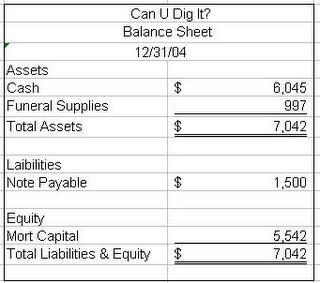
Balance Sheet
Simple balance sheet including basic items
-
Assets
- Current assets
- Cash and cash equivalents
- Accounts receivable
- Inventories
- Prepaid expenses for future services that will be used within a year
- Non-current assets (Fixed assets)
- Property, plant and equipment
- Investment property, such as real estate held for investment purposes
- Intangible assets
- Financial assets (excluding investments accounted for using the equity method, accounts receivables, and cash and cash equivalents)
- Investments accounted for using the equity method
- Biological assets, which are living plants or animals. Bearer biological assets are plants or animals which bear agricultural produce for harvest, such as apple trees grown to produce apples and sheep raised to produce wool.
-
Liabilities
- Accounts payable
- Provisions for warranties or court decisions
- Financial liabilities (excluding provisions and accounts payable), such as promissory notes and corporate bonds
- Liabilities and assets for current tax
- Deferred tax liabilities and deferred tax assets
- Unearned revenue for services paid for by customers, but not yet provided
- Equity
- The net assets shown by the balance sheet equals the third part of the balance sheet, which is known as the shareholders’ equity. It comprises:
- Issued capital and reserves attributable to equity holders of the parent company (controlling interest)
- Non-controlling interest in equity
- Formally, shareholders’ equity is part of the company’s liabilities: they are funds “owing” to shareholders (after payment of all other liabilities). Usually, however, “liabilities” is used in the more restrictive sense of liabilities excluding shareholders’ equity. The balance of assets and liabilities (including shareholders’ equity) is not a coincidence. Records of the values of each account in the balance sheet are maintained using a system of accounting known as double-entry bookkeeping. In this sense, shareholders’ equity by construction must equal assets minus liabilities, and are a residual.
- Regarding the items in equity section, the following disclosures are required:
- Numbers of shares authorized, issued and fully paid, and issued but not fully paid
- Par value of shares
- Reconciliation of shares outstanding at the beginning and the end of the period
- Description of rights, preferences, and restrictions of shares
- Treasury shares, including shares held by subsidiaries and associates
- Shares reserved for issuance under options and contracts
- A description of the nature and purpose of each reserve within owners’ equity
Lenders and investors will require such statements to structure or confirm compliance with debt covenants such as debt service reserve coverage and debt to equity ratios. Similarly, when a new corporation is envisioned, its founders will prepare pro forma financial statements for the information of prospective investors. Pro forma figures should be clearly labeled as such and the reason for any deviation from reported past figures clearly explained.
4.4.2: Balance Sheet Analysis
Balance sheet analysis is process of understanding the risk and profitability of a firm through analysis of reported financial information.
Learning Objective
Analyze a company’s balance sheet
Key Points
- Balance sheet is a summary of the financial balances of a sole proprietorship, a business partnership, a corporation or other business organization. Assets, liabilities and ownership equity are listed as of a specific date, such as the end of its financial year.
- Balance sheet analysis (or financial analysis) the process of understanding the risk and profitability of a firm (business, sub-business or project) through analysis of reported financial information, particularly annual and quarterly reports.
- Financial ratio analysis should be based on regrouped and adjusted financial statements. Two types of ratio analysis are performed: 3.1) Analysis of risk and 3.2) analysis of profitability.
- Balance sheet analysis consists of 1) reformulating reported Balance sheet, 2) analysis and adjustments of measurement errors, and 3) financial ratio analysis on the basis of reformulated and adjusted Balance sheet.
Key Terms
- RNOA
-
return on net operating assets
- NFD
-
net financial debt
- NFIR
-
the net financial interest rate
Balance sheet
In financial accounting, a balance sheet or statement of financial position is a summary of the financial balances of a sole proprietorship, a business partnership, a corporation or other business organization. Assets, liabilities and ownership equity are listed as of a specific date, such as the end of its financial year. A balance sheet is often described as a “snapshot of a company’s financial condition”. Of the four basic financial statements, the balance sheet is the only statement which applies to a single point in time of a business’ calendar year.
A business operating entirely in cash can measure its profits by withdrawing the entire bank balance at the end of the period, plus any cash in hand. However, many businesses are not paid immediately; they build up inventories of goods and they acquire buildings and equipment. In other words: businesses have assets and so they cannot, even if they want to, immediately turn these into cash at the end of each period. Often, these businesses owe money to suppliers and to tax authorities, and the proprietors do not withdraw all their original capital and profits at the end of each period. In other words businesses also have liabilities.
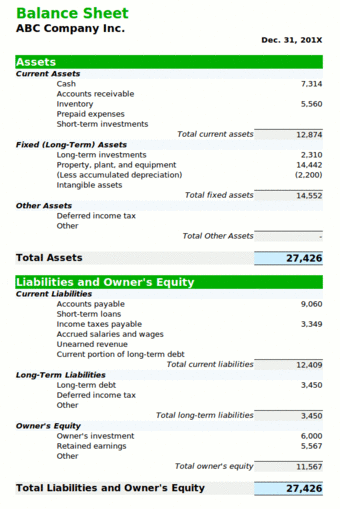
Balance Sheet
An example of a classified balance sheet.
Balance sheet analysis
Balance sheet analysis (or financial analysis) the process of understanding the risk and profitability of a firm (business, sub-business or project) through analysis of reported financial information, particularly annual and quarterly reports.
Balance sheet analysis consists of 1) reformulating reported Balance sheet, 2) analysis and adjustments of measurement errors, and 3) financial ratio analysis on the basis of reformulated and adjusted Balance sheet. The two first steps are often dropped in practice, meaning that financial ratios are just calculated on the basis of the reported numbers, perhaps with some adjustments. Financial statement analysis is the foundation for evaluating and pricing credit risk and for doing fundamental company valuation.
Financial ratio analysis should be based on regrouped and adjusted financial statements. Two types of ratio analysis are performed: 3.1) Analysis of risk and 3.2) analysis of profitability:
3.1) Analysis of risk typically aims at detecting the underlying credit risk of the firm. Risk analysis consists of liquidity and solvency analysis. Liquidity analysis aims at analyzing whether the firm has enough liquidity to meet its obligations when they should be paid. A usual technique to analyze illiquidity risk is to focus on ratios such as the current ratio and interest coverage. Cash flow analysis is also useful. Solvency analysis aims at analyzing whether the firm is financed so that it is able to recover from a losses or a period of losses.
3.2) Analysis of profitability refers to the analysis of return on capital, for example return on equity, ROE, defined as earnings divided by average equity. Return on equity, ROE, could be decomposed: ROE = RNOA + (RNOA – NFIR) * NFD/E
Purposes of balance sheet analysis
“The objective of financial statements is to provide information about the financial position, performance and changes in financial position of an enterprise that is useful to a wide range of users in making economic decisions. ” Financial statements should be understandable, relevant, reliable and comparable. Reported assets, liabilities, equity, income and expenses are directly related to an organization’s financial position.
Financial statements are intended to be understandable by readers who have “a reasonable knowledge of business and economic activities and accounting and who are willing to study the information diligently. ” Financial statements may be used by users for different purposes:
- Owners and managers require financial statements to make important business decisions that affect its continued operations. Financial analysis is then performed on these statements to provide management with a more detailed understanding of the figures. These statements are also used as part of management’s annual report to the stockholders.
- Employees also need these reports in making collective bargaining agreements (CBA) with the management, in the case of labor unions or for individuals in discussing their compensation, promotion and rankings.
- Prospective investors make use of financial statements to assess the viability of investing in a business. Financial analyses are often used by investors and are prepared by professionals (financial analysts), thus providing them with the basis for making investment decisions.
- Financial institutions (banks and other lending companies) use them to decide whether to grant a company with fresh working capital or extend debt securities (such as a long-term bank loan or debentures) to finance expansion and other significant expenditures.
- Government entities (tax authorities) need financial statements to ascertain the propriety and accuracy of taxes and other duties declared and paid by a company.
- Vendors who extend credit to a business require financial statements to assess the creditworthiness of the business.
- Media and the general public are also interested in financial statements for a variety of reasons.
4.5: Building a Cash Budget
4.5.1: Receipts
Forecasting incoming cash flows via receipts is a useful tool for organizations to determine the amount of cash that will be available on hand.
Learning Objective
Learn what organizational assets can be considered cash receivables, and understand how to forecast these receivables
Key Points
- Forecasting receipts is an important responsibility in corporate finance, as predicting cash on hand is critical in ensuring that organizations can invest their capital in a meaningful way.
- Receipts and disbursements are the two inputs of cash flow forecasting, particularly in the short term. Receipts include accounts receivable, interest on short-term investments, and the sale of assets.
- In the shorter term, predicting receipts is largely a process of compiling existing established contractual agreements. In the longer term, receipts can be predicted through understanding trends and growth over time.
Key Terms
- disbursements
-
Money paid out or spent.
- Receipts
-
Potential sources of incoming cash over a given time frame.
Why Forecast Receipts?
The broader field of cash flow forecasting is integral to ensuring organizational liquidity. Maintaining cash receipts over a given time frame enables organizations to have cash at hand in a predictable fashion, thus allowing them to reinvest in business operations to avoid the opportunity cost of having unused cash and cash receivables. Forecasting cash inflows and outflows in advance is a primary role of corporate financiers and accountants, and enables efficient use of existing assets to capture maximum competitive value in the marketplace.
Cash Receipts and Disbursements (R&D)
The direct method of projecting incoming cash flow is through understanding cash receipts and disbursements of the time period being projected.
Receipts
Receipts generally refer to the collection of accounts receivable, which are the payments of paying customers over time. Receipts also refer to the returns off of short-term investments as well as the sale of various assets. There are other potential incoming cash flows that also fall under receipts, which are worth noting on a case by case basis.
Disbursements
On the inverse side of receipts, disbursements are outgoing cash flows during a short-term business operation. These can quite accurately project accounts payable, payroll costs, dividend payments, interest payments, and other short-term alterations to existing cash flow. By comparing receipts with disbursements, the overall available cash flow can be derived.
How to Forecast Receipts
As with all forecasting, shorter term forecasts are more certain than longer term forecasts (in general). Short term forecasts can be quite accurate, as the various accounts receivable, accounts payable, short-term investments and short-term costs are often relatively established (contractually and operationally). In shorter term situations, most forecasting is done through implementing what is known with the probability that these obligations will be met.
With longer term forecasting, it can be useful to consider past averages over time. Larger organizations can look at their average cash receipts over the past few years, and couple that with growth trajectories to project what level of cash inflow is likely over a given time frame. It’s important to keep in mind that forecasts are only estimations, and organizations should be aware of the error margins involved.
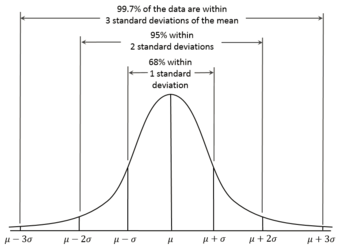
Normal Distributions
When creating a forecast utilizing past data, it is important to recognize the degree of certainty that can be reasonably applied to this forecast. By creating a normalized distribution, and identifying the percentage likelihood of a certain outcome, organizations can better prepare for all likely outcomes.
4.5.2: Payments
Cash payments describe cash flowing out of a business resulting from operating activities, investment activities and financing activities.
Learning Objective
Analyze a company’s disbursement cycle
Key Points
- Cash payments must be made for relevant expenses, which include those to suppliers for inventory or other supplies, employees for wages, government for taxes, and lenders for interest on borrowed money.
- A company’s objective in regards to the cash dispersement cycle should be to increase the cycle time, or delay making payments until they are due.
- Typical cash outflows from investing activities include purchase of capital assets, purchase of bonds/notes or shares of other entities, and loans to other entities.
- Typical cash outflows from financing activities include payments of dividends to the company’s own shareholders, redemption (repurchase) of company’s own shares, and repayment of principal and interest on company’s own bonds or notes.
Key Term
- disbursement
-
Money paid out or spent.
Why is cash flow forecasting important? If a business runs out of cash and is not able to obtain new financing, it will become insolvent. It is no excuse for management to claim that they didn’t see a cash flow crisis coming. So in business, “cash is king”.
Cash Payments
Cash payments describe cash flowing out of a business. These cash payments can result from operating activities, investment activities and financing activities.
Generally speaking, normal operating activities refer to the cash effects of transactions involving revenues and expenses that impact net income. Cash payments must be made for relevant expenses. Typical payments include those to:
- Suppliers for inventory or other supplies
- Employees for wages
- Government for taxes
- Lenders for interest on borrowed money
Typical cash outflows from investing activities include:
- Purchase of capital assets
- Purchase of bonds/notes or shares of other entities
- Loans to other entities
Typical cash outflows from financing activities include:
- Payments of dividends to the company’s own shareholders
- Redemption (repurchase) of company’s own shares
- Repayment of principal and interest on company’s own bonds or notes
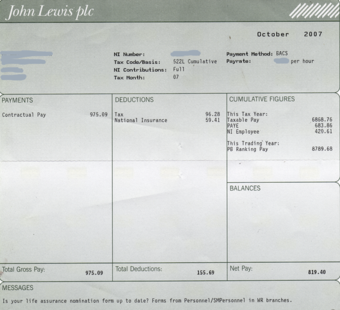
Sample Paystub
This is an example of a paystub to an employee, one of the most significant cash disbursements necessary for a company.
Disbursement Cycle
The cash disbursement cycle is important to consider when analyzing cash payments. This is the total time between when an obligation occurs and when the payment clears the bank. A company’s objective regarding the cash disbursement cycle should be to increase the cycle time, or delay making payments until they are due. A firm may delay payments by:
- Mailing checks from locations not close to customers. This will increase the mail time, or mail float, within the disbursement cycle.
- Disbursing checks from a remote bank. This will increase the time required for the payment to clear the bank.
- Purchasing with credit cards so that the time required for making payment is much longer. By using a credit card, you will receive a bill at the end of the month payable in 30 days. This creates more processing time or processing float.
Therefore, when a company manages cash flow cycles, it tries to control three types of float times:
- Mail float, or the time spent for a payment in the mail.
- Clearance float, or the time spent for a payment to clear the bank.
- Processing float, or the time required to process cash flow transactions.
4.5.3: The Forecast Budget
Understanding cash and liquidity needs is critical for organizations to capture opportunities and ensure all profitable processes are funded.
Learning Objective
Understand the various methods of forecasting budgets, and the importance of doing so regularly
Key Points
- Liquidity, or the ability to have cash on hand when it is required, is critical to capturing opportunities and ensuring smooth operations.
- Forecasting budgets in advance enables organizations to project what cash will be required during a given operating time frame and to keep these resources available when necessary.
- For larger organizations, this is usually done at the departmental or operational level, projecting different budgets for different operational teams.
- There are a number of methods involved in forecast budgets, including the direct method, the adjusted net income method, and the accrual reversal method.
Key Terms
- forecast
-
A projection of cash inflows and/or outflows.
- liquidity
-
The ease of turning assets into cash.
The Purpose of Forecasting
Financial planning is a critical financial tool for funding profitable operations and dividing existing organizational assets optimally to pursue revenue maximization. The forecast budget will project what cash flows will be needed for each organizational process, and how those cash flows will be utilized over a fixed period of time. If there is a problem with liquidity during an operational period, it can result in huge opportunity costs (i.e. an organization being unable to capture an existing opportunity in the market).
How to Forecast
There are a number of ways to approach financial forecasting for a cash budget. A cash budget is all about liquidity, and therefore forecasting what available liquidity will be required over a given period is the primary input for forecasting budgets. There are a number of different approaches, though most of them rely on understanding the inputs required for various business operations.
The inputs include the following cash obligations during regular operations:
- Payroll
- Payment of accounts payable
- Dividends
- Interest on debt
- Sourcing raw materials
It’s also worth noting that various cash inflows will occur during a given time period. For example, accounts receivable, short-term financing options, and various other sources of income may directly convert into usable capital. However, budgeting should either build these into the current budget forecast or utilize them during the next calculation of budgetary requirements.
The Direct Method
At its simplest, cash flow forecasting and budgeting can be computed directly based off of fixed information over a short time frame. This works particularly well for consistent businesses that run routine operations with limited risk-taking and diversification in process.
The Adjusted Net Income Method (ANI)
The adjusted net income method starts by calculating operating income (EBIT or EBITDA) and adding/subtracting short-term changes in the balance sheet, such as those that occur to inventories, payable, receivables and other short-term. This gives the organization some idea of what short-term cash flows are typically required during an operational period.
Pro-forma Balance Sheet
Pro-formas are financial statements created in advance as a projection or estimation of what that document will look like after the financial period is finished. By using a pro-forma balance sheet for the upcoming period being budgeted for, the short-term assets and liabilities (if accurately projected) will underline the amount of cash that should be set aside for budgeting purposes.
Accrual Reversal Method
A third option for projecting cash budgets is accrual reversal. This process relies on statistical distributions, reversing large accruals, and projecting cash effects via algorithms. This method requires a good deal of data and statistical skill, and is best utilized for mid-term forecasting (unlike the direct method, which is much better for a shorter time frame). The advantage of this method is that it is often accurate to the day or week, enabling high accuracy.
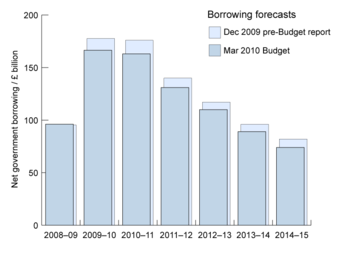
Budget Forecast Example
This chart demonstrates a forecast budget to the reality of what actually occurred. Budgeting is an estimation, often adjustments over time.
4.6: Analyzing Forecasts
4.6.1: Ratio Analysis and EPS
Ratio analysis and EPS are used to compare the strengths and weaknesses of various companies with industry or company benchmarks.
Learning Objective
Classify the different type of financial ratios
Key Points
- Financial analysts use financial ratios to compare the strengths and weaknesses in various companies.
- Financial ratios quantify many aspects of a business and are an integral part of the financial statement analysis. Financial ratios are categorized according to the financial aspect of the business which the ratio measures.
- Earnings per share (EPS) is the amount of earnings per each outstanding share of a company’s stock.
Key Terms
- Diluted EPS
-
Diluted Earnings Per Share (diluted EPS) is a company’s earnings per share (EPS) calculated using fully diluted shares outstanding (i.e. including the impact of stock option grants and convertible bonds).
- Preferred dividends
-
Preferred stock usually carries no voting rights, but may carry a dividend and may have priority over common stock in the payment of dividends and upon liquidation.
- Financial Accounting Standards Board (FASB)
-
The Financial Accounting Standards Board (FASB) is a private, not-for-profit organization whose primary purpose is to develop generally accepted accounting principles (GAAP) within the United States in the public’s interest.
Example
- If preferred dividends total $100,000, then that is money not available to distribute to each share of common stock.
Ratio Analysis
A financial ratio (or accounting ratio) is a relative magnitude of two selected numerical values taken from an enterprise’s financial statements. Often used in accounting, there are many standard ratios used to try to evaluate the overall financial condition of a corporation or other organization. Financial ratios may be used by managers within a firm, by current and potential shareholders (owners) of a firm, and by a firm’s creditors. Financial analysts use financial ratios to compare the strengths and weaknesses in various companies. If shares in a company are traded in a financial market, the market price of the shares is used in certain financial ratios.
Values used in calculating financial ratios are taken from the balance sheet, income statement, statement of cash flows or (sometimes) the statement of retained earnings. These comprise the firm’s “accounting statements” or financial statements. The statements’ data is based on the accounting method and accounting standards used by the organization.
Financial ratios quantify many aspects of a business and are an integral part of the financial statement analysis. Financial ratios are categorized according to the financial aspect of the business which the ratio measures .
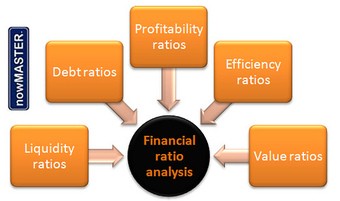
Ratio analysis
Ratio analysis includes profitability ratios, activity (efficiency) ratios, debt ratios, liquidity ratios and market (value) ratios
Liquidity ratios:
Liquidity ratios measure the availability of cash to pay
debt
.
Current ratio (Working Capital Ratio): Current assets / Current liabilities
Acid-test ratio (Quick ratio): (Current assets – Inventory – Prepayments) / Current liabilities
Activity ratios:
Activity ratios measure how quickly a firm converts non-cash assets to cash assets.
Average collection period: Accounts receivable / (Annual credit sales / 365 days)
Average payment period: Accounts payable / (Annual credit purchases / 365 days)
Inventory conversion ratio: 365 days / Inventory turnover
Cash Conversion Cycle: Inventory conversion period + Receivables conversion period – Payables conversion period
Debt ratios
Debt ratios measure the firm’s ability to repay long-term debt.
Debt ratio: Total liabilities / Total assets
Times interest earned ratio (Interest Coverage Ratio): EBIT / Annual interest expense
Profitability
ratios
Profitability ratios measure the firm’s use of its assets and control of its expenses to generate an acceptable rate of
return
.
Gross margin, Gross profit margin or Gross Profit Rate: Gross profit / Net sales
Profit margin, net margin or net profit margin: Net profit / Net sales
Return on equity (ROE): Net income / Average shareholders equity
Return on assets (ROA ratio or Du Pont Ratio): Net income / Average total assets
Market ratios
Market ratios measure
investor
response to owning a company’s stock and also the cost of issuing stock. These are concerned with the
return on
investment
for shareholders, and with the relationship between return and the value of an investment in company’s shares.
Earnings per share (EPS): Net earnings / Number of shares
Payout ratio: Dividends / Earnings
P/E ratio: Market price per share / Diluted EPS
Ratios generally are not useful unless they are benchmarked against something else, like past performance or another company. Thus, the ratios of firms in different industries, which face different risks, capital requirements, and competition are usually hard to compare.
Earnings per share (EPS)
Earnings per share (EPS) is the amount of earnings per each outstanding share of a company’s stock. In the United States, the Financial Accounting Standards Board (FASB) requires companies’ income statements to report EPS for each of the major categories of the income statement: continuing operations, discontinued operations, extraordinary items, and net income.
The EPS formula does not include preferred dividends for categories outside of continued operations and net income. Earnings per share for continuing operations and net income are more complicated in that any preferred dividends are removed from net income before calculating EPS. This is because preferred stock rights have precedence over common stock.
Earnings Per Share (Basic Formula):
Earnings per Share = Profit / Weighted average common shares
Ratios generally are not useful unless they are benchmarked against something else, like past performance or another company. Thus, the ratios of firms in different industries, which face different risks, capital requirements, and competition are usually hard to compare.
4.6.2: Impacts of Forecasting on a Business
Since actual business activities are planned in relation to forecasting, it is very important that realistic expectations and estimations be undertaken.
Learning Objective
Describe how forecasting can help a business improve its operations
Key Points
- Business planning and forecasting refers to the set of activities where business operations are planned against the business strategy.
- Forecasting financial statements comprises the estimation of several values – including sales, costs, and expected interest rates.
- It is always easier to forecast future performance of a business if your business is already up and running because there are past trading results to look at.
- Forecasting can be used in Supply Chain Management to make sure that the right product is at the right place at the right time.
- On a broader level, economic forecasting is the process of making predictions about the economy as a whole.
Key Terms
- supply chain management
-
Supply chain management (SCM) is the management of a network of interconnected businesses involved in the provision of product and service packages required by the end customers in a supply chain.
- inflation
-
In economics, inflation is a rise in the general level of prices of goods and services in an economy over a period of time.
- Egain Forecasting
-
a method of controlling building heating by calculating demand for heating energy that should be supplied to the building in each time unit.
Example
- The financial and economic crisis that erupted in 2007 – arguably the worst since the Great Depression of the 1930’s – was not foreseen by most of the forecasters, even if a few lone analysts had been crying wolf for some time (for example, Nouriel Roubini and Robert Shiller).
Business planning and forecasting refers to the set of activities where business operations are planned against the business strategy, and what forecast activities or results may occur from operational execution during a particular time period. In preparing financial forecasts, firms should always assume they will be reviewed by a bank manager, regulatory agency, or investor. With this goal in mind, the firm should be guided to keep forecasts tidy and easy to understand by grouping cash inflows and outflows in simple ways that are easy to understand quickly.
Forecasting financial statements comprises the estimation of several values – including sales, costs, and expected interest rates. Since actual business activities are planned in relation to these estimations, it is very important that realistic expectations and estimations be undertaken. With this in mind, there are specific points of interest to lenders and investors that need to be addressed. The profitability of a business reflects a sound relationship between market-driven sales projections and accurate cost estimates.
- Have you planned to have sufficient cash to meet your regular bills and also non-regular costs (like annual insurance premiums)?
- Does the financial position of the business remain sound when growth is forecast (this is what the balance sheet is for)?
- Is there a sensible balance between borrowings and the amount contributed by the owner (when the business is raising capital in its own right)?
- Are short and long-term obligations matched with relevant finance options?
- Do key business ratios remain within sensible bounds?
It is always easier to forecast future performance of a business when the business is already up and running because there are past trading results to look at. When a completely new venture is being planned a certain amount of imagination and estimation is required. However, this is in no way a license to be overly optimistic.
Forecasting has applications in many situations and impacts multiple aspects of a business. One such aspect is Supply Chain Management. Forecasting can be used in Supply Chain Management to make sure that the right product is at the right place at the right time. Accurate forecasting will help retailers reduce excess inventory and therefore increase the profit margin. Accurate forecasting will also help them meet consumer demand. On a broader level, economic forecasting is the process of making predictions about the economy as a whole. Forecasts can be carried out at a high level of aggregation — for GDP, inflation, unemployment or the fiscal deficit — or at a more disaggregated level — for specific sectors of the economy or even specific firms .

Economic Impact
Studies on the economic impact of business operations should be taken into account when forecasting financial statements and business activities. For example, a mining company may take into account a study such as the one pictured here.
Other important areas of forecasting include:
- Egain Forecasting
- Land use forecasting
- Player and team performance in sports
- Political Forecasting
- Product forecasting
- Sales Forecasting
- Technology forecasting
- Telecommunications forecasting
- Transport planning and Transportation forecasting
- Weather forecasting
4.6.3: Regression Analysis for Forecast Improvement
Regression Analysis is a causal / econometric forecasting method that is widely used for prediction and forecasting improvement.
Learning Objective
Explain how regression analysis works
Key Points
- Regression Analysis is a causal / econometric forecasting method. Some forecasting methods use the assumption that it is possible to identify the underlying factors that might influence the variable that is being forecast.
- Regression analysis includes several classical assumptions.
- Regression analysis includes many techniques for modeling and analyzing several variables when the focus is on the relationship between a dependent variable and one or more independent variables.
- A large body of techniques for carrying out regression analysis has been developed. Familiar methods, such as linear regression and ordinary least squares regression, are parametric.
Key Terms
- Ordinary least squares regression
-
In statistics, ordinary least squares (OLS) or linear least squares is a method for estimating the unknown parameters in a linear regression model. This method minimizes the sum of squared vertical distances between the observed responses in the dataset and the responses predicted by the linear approximation.
- linear regression
-
In statistics, linear regression is an approach to modeling the relationship between a scalar dependent variable y and one or more explanatory variables denoted X.
- independent
-
not contingent or depending on something else
Example
- One can forecast based on linear relationships. If one variable is linearly related to the other for a long enough period of time, it may be beneficial to predict such a relationship in the future.
Regression Analysis
Regression Analysis is a causal / econometric forecasting method. Some forecasting methods are based on the assumption that it is possible to identify underlying factors that might influence a variable that is being forecast. For example, including information about weather conditions might improve the ability of a model to predict umbrella sales. This is a model of seasonality that shows a regular pattern of up and down fluctuations. In addition to weather, seasonality can also result from holidays and customs such as predicting that sales in college football apparel will be higher during football season as opposed to the off season.
Regression analysis includes a large group of methods that can be used to predict future values of a variable using information about other variables. These methods include both parametric (linear or non-linear) and non-parametric techniques.
Classical assumptions for regression analysis include:
- The sample is representative of the population for the inference prediction.
- The error is a random variable with a mean of zero conditional on the explanatory variables.
- The independent variables are measured with no error. (Note: If this is not so, modeling may be performed instead, using errors-in-variables model techniques).
- The predictors are linearly independent, i.e. it is not possible to express any predictor as a linear combination of the others.
- The errors are uncorrelated, that is, the variance– co-variance matrix of the errors is diagonal, and each non-zero element is the variance of the error.
- The variance of the error is constant across observations (homoscedasticity). (Note: If not, weighted least squares or other methods might instead be used).
In statistics, regression analysis includes many techniques for modeling and analyzing several variables, when the focus is on the relationship between a dependent variable and one or more independent variables. More specifically, regression analysis helps one understand how the typical value of the dependent variable changes when any one of the independent variables is varied, while the other independent variables are held fixed.
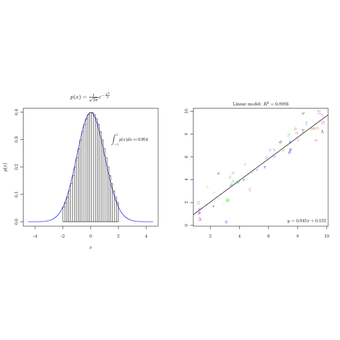
Regression analysis
Regression analysis shows the relationship between a dependent variable and one or more independent variables.
Most commonly, regression analysis estimates the conditional expectation of the dependent variable given the independent variables — that is, the average value of the dependent variable when the independent variables are fixed. Less commonly, the focus is on a quantile, or other location parameter of the conditional distribution of the dependent variable given the independent variables. In all cases, the estimation target is a function of the independent variables called the regression function. In regression analysis, it is also of interest to characterize the variation of the dependent variable around the regression function, which can be described by a probability distribution.
Forecast Improvement
Regression analysis is widely used for prediction and forecasting, where its use has substantial overlap with the field of machine learning. Regression analysis is also used to understand which among the independent variables is related to the dependent variable, and to explore the forms of these relationships. In restricted circumstances, regression analysis can be used to infer causal relationships between the independent and dependent variables. However, this can lead to illusions or false relationships, so caution is advisable.
A large body of techniques for carrying out regression analysis has been developed. Familiar methods, such as linear regression and ordinary least squares regression, are parametric, in that the regression function is defined in terms of a finite number of unknown parameters that are estimated from the data. Nonparametric regression refers to techniques that allow the regression function to lie in a specified set of functions, which may be infinite-dimensional.
The performance of regression analysis methods in practice depends on the form of the data generating process and how it relates to the regression approach being used. Since the true form of the data-generating process is generally not known, regression analysis often depends to some extent on making assumptions about this process. These assumptions are sometimes testable if a large amount of data is available. Regression models for prediction are often useful even when the assumptions are moderately violated, although they may not perform optimally. However, in many applications, especially with small effects or questions of causality based on observational data, regression methods give misleading results.
4.6.4: Impact of Modifying Inputs on Business Operations
Modifying inputs such as accounts receivable, inventory, and accounts payable will significantly influence forecasting and business operations.
Learning Objective
Explain how modifying different inputs will influence financial forecasts
Key Points
- Accounts receivable has a great effect on a firm’s expected cash inflows, and thus modifying this input on a forecast will affect how much cash a company decides to have on hand.
- Because of its prevalence as an expense, modifying the amount of inventory will have far reaching consequences on all forecasted financial statements.
- Accounts payable will influence the current liabilities of a business; therefore, its modification will change a company’s perspective on the amount of cash-on-hand needed.
Key Terms
- forecast
-
An estimation of a future condition.
- solvency
-
The state of having enough funds or liquid assets to pay all of one’s debts; the state of being solvent.
- liquidity
-
Availability of cash over short term: ability to service short-term debt.
Example
- For example, 2%,30 Net 31 terms mean that the payor will deduct 2% from the invoice if payment is made within 30 days. If the payment is made on Day 31 then the full amount is paid.
Inputs
The inputs of accounts receivable, inventory, accounts payable, and other line items on financial statements provide important data for financial forecasting. Modifying any one of these inputs can lead to major changes in forecasts. Similarly, drastic differences in expected values and actual values in regard to these inputs can cause problems for a company, possibly even leading to insolvency.
Accounts Receivable
Accounts receivable is money owed to a business by its customers and shown on its balance sheet as an asset. It is one of a series of accounting transactions dealing with the billing of a customer for goods and services that the customer has ordered. A business must not only anticipate the level of sales that will be made on credit, but it must also anticipate when payment on these accounts will occur and account for the fact that some of these credit accounts will default. Accounts receivable has a great effect on a firm’s expected cash inflows, and thus modifying this input on a forecast will affect how much cash a company decides to have on hand.
Inventory
Inventory management is primarily about specifying the scope and percentage of stocked goods. It is required at different locations within a facility or within many locations of a supply network to precede the regular and planned course of production and stock of materials. The scope of inventory management concerns the fine lines between replenishment lead time, carrying costs of inventory, asset management, inventory forecasting, inventory valuation, inventory visibility, future inventory price forecasting, physical inventory, available physical space for inventory, quality management, replenishment, returns and defective goods, and demand forecasting. Balancing these competing requirements leads to optimal inventory levels, which is an on-going process as the business needs shift and react to the wider environment.
Companies that rely on the sale of physical goods — i.e., those that must carry inventory — must manage inventory in such as way as to decrease expenses as much as possible. Since inventory is such a prevalent expense, accurate forecasting is of the utmost importance. Moreover, the modification of this particular input will have expansive effects on all of the financial statements a firm must forecast.

Inventory
Inventory management is a modifying input that can impact financial forecasts
Accounts Payable
Accounts payable is money owed by a business to its suppliers and is shown on its balance sheet as a liability. Commonly, a supplier will ship a product, issue an invoice, and collect payment later, which describes a cash conversion cycle. This is the period of time during which the supplier has already paid for raw materials but hasn’t been paid in return by the final customer.
Accounts payable will influence the current liabilities of a business, which will accordingly influence the liquidity of the business. A major requirement for a business to continue its operations is for that business to maintain solvency. Modifying accounts payable will drastically change the amount of cash-on-hand required for a business.
Chapter 3: Analyzing Financial Statements
3.1: Standardizing Financial Statements
3.1.1: Balance Sheets
A standard balance sheet has three parts: assets, liabilities, and ownership equity; Asset = Liabilities + Equity.
Learning Objective
Identify the basics of a balance sheet
Key Points
- Of the four basic financial statements, the balance sheet is the only statement which applies to a single point in time of a business’ calendar year.
- The main categories of assets are usually listed first (in order of liquidity) and are followed by the liabilities.
- The difference between the assets and the liabilities is known as “equity”.
- Balance sheets can either be in the report form or the account form.
- A balance sheet is often presented alongside one for a different point in time (typically the previous year) for comparison.
- Guidelines for balance sheets of public business entities are given by the International Accounting Standards Board and numerous country-specific organizations/companies.
Key Terms
- asset
-
Something or someone of any value; any portion of one’s property or effects so considered.
- equity
-
Ownership, especially in terms of net monetary value, of a business.
- balance sheet
-
A summary of a person’s or organization’s assets, liabilities and equity as of a specific date.
Balance sheet
In financial accounting, a balance sheet or statement of financial position is a summary of the financial balances of a sole proprietorship, a business partnership, a corporation or other business organization, such as an LLC or an LLP. Assets, liabilities and ownership equity are listed as of a specific date, such as the end of its financial year. A balance sheet is often described as a “snapshot of a company’s financial condition. ” Of the four basic financial statements, the balance sheet is the only statement which applies to a single point in time of a business’ calendar year.
A standard company balance sheet has three parts: assets, liabilities, and ownership equity. The main categories of assets are usually listed first, and typically in order of liquidity. Assets are followed by the liabilities. The difference between the assets and the liabilities is known as “equity. ” Equity is the net assets or net worth of the capital of the company. According to the accounting equation, net worth must equal assets minus liabilities.
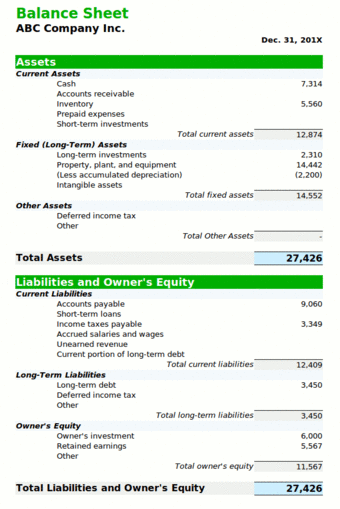
Balance Sheet Example
Types
A balance sheet summarizes an organization or individual’s assets, equity, and liabilities at a specific point in time. We have two forms of balance sheet. They are the report form and the account form. Individuals and small businesses tend to have simple balance sheets. Larger businesses tend to have more complex balance sheets, and these are presented in the organization’s annual report. Large businesses also may prepare balance sheets for segments of their businesses. A balance sheet is often presented alongside one for a different point in time (typically the previous year) for comparison.
Personal Balance Sheet
A personal balance sheet lists current assets, such as cash in checking accounts and savings accounts; long-term assets, such as common stock and real estate; current liabilities, such as loan debt and mortgage debt due; or long-term liabilities, such as mortgage and other loan debt. Securities and real estate values are listed at market value rather than at historical cost or cost basis. Personal net worth is the difference between an individual’s total assets and total liabilities.
U.S. Small Business Balance Sheet
A small business balance sheet lists current assets, such as cash, accounts receivable and inventory; fixed assets, such as land, buildings, and equipment; intangible assets, such as patents; and liabilities, such as accounts payable, accrued expenses, and long-term debt. Contingent liabilities, such as warranties, are noted in the footnotes to the balance sheet. The small business’s equity is the difference between total assets and total liabilities.
Public Business Entities Balance Sheet
Structure
Guidelines for balance sheets of public business entities are given by the International Accounting Standards Board and numerous country-specific organizations/companies.
Balance sheet account names and usage depend on the organization’s country and the type of organization. Government organizations do not generally follow standards established for individuals or businesses.
If applicable to the business, summary values for the following items should be included in the balance sheet: Assets are all the things the business owns, including property, tools, cars, etc.
Assets:
1. Current assets
- Cash and cash equivalents
- Accounts receivable
- Inventories
- Prepaid expenses for future services that will be used within a year
2. Non-current assets (fixed assets)
- Property, plant, and equipment.
- Investment property, such as real estate held for investment purposes.
- Intangible assets.
- Financial assets (excluding investments accounted for using the equity method, accounts receivables, and cash and cash equivalents).
- Investments accounted for using the equity method
- Biological assets, which are living plants or animals. Bearer biological assets are plants or animals which bear agricultural produce for harvest, such as apple trees grown to produce apples and sheep raised to produce wool.
Liabilities:
- Accounts payable.
- Provisions for warranties or court decisions.
- Financial liabilities (excluding provisions and accounts payable), such as promissory notes and corporate bonds.
- Liabilities and assets for current tax.
- Deferred tax liabilities and deferred tax assets.
- Unearned revenue for services paid for by customers but not yet provided.
Equity:
- Issued capital and reserves attributable to equity holders of the parent company (controlling interest).
- Non-controlling interest in equity.
Regarding the items in equity section, the following disclosures are required:
- Numbers of shares authorized, issued and fully paid, and issued but not fully paid.
- Par value of shares.
- Reconciliation of shares outstanding at the beginning and the end of the period/
- Description of rights, preferences, and restrictions of shares.
- Treasury shares, including shares held by subsidiaries and associates.
- Shares reserved for issuance under options and contracts.
- A description of the nature and purpose of each reserve within owners’ equity
3.1.2: Income Statements
Income statement is a company’s financial statement that indicates how the revenue is transformed into the net income.
Learning Objective
Describe the different methods used for presenting data in a company’s income statement
Key Points
- Income statement displays the revenues recognized for a specific period, and the cost and expenses charged against these revenues, including write offs (e.g., depreciation and amortization of various assets) and taxes.
- The income statement can be prepared in one of two methods: The Single Step income statement and Multi-Step income statement.
- The income statement includes revenue, expenses, COGS, SG&A, depreciation, other revenues and expenses, finance costs, income tax expense, and net income.
Key Term
- intangible asset
-
Intangible assets are defined as identifiable non-monetary assets that cannot be seen, touched, or physically measured, and are created through time and effort, and are identifiable as a separate asset.
Income Statement
Income statement (also referred to as profit and loss statement [P&L]), revenue statement, a statement of financial performance, an earnings statement, an operating statement, or statement of operations) is a company’s financial statement. This indicates how the revenue (money received from the sale of products and services before expenses are taken out, also known as the “top line”) is transformed into the net income (the result after all revenues and expenses have been accounted for, also known as “Net Profit” or the “bottom line”). It displays the revenues recognized for a specific period, and the cost and expenses charged against these revenues, including write offs (e.g., depreciation and amortization of various assets) and taxes. The purpose of the income statement is to show managers and investors whether the company made or lost money during the period being reported.
The important thing to remember about an income statement is that it represents a period of time. This contrasts with the balance sheet, which represents a single moment in time.
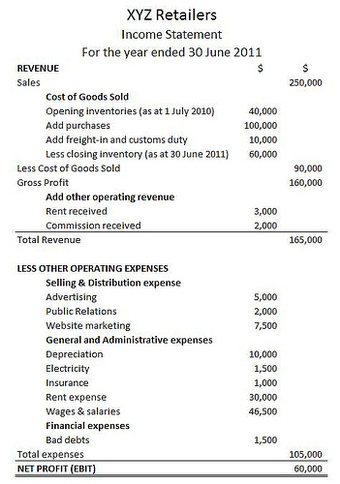
Income statement
GAAP and IRS accounting can differ.
Two Methods
- The Single Step income statement takes a simpler approach, totaling revenues and subtracting expenses to find the bottom line.
- The Multi-Step income statement (as the name implies) takes several steps to find the bottom line, starting with the gross profit. It then calculates operating expenses and, when deducted from the gross profit, yields income from operations. Adding to income from operations is the difference of other revenues and other expenses. When combined with income from operations, this yields income before taxes. The final step is to deduct taxes, which finally produces the net income for the period measured.
Operating Section
- Revenue – cash inflows or other enhancements of assets of an entity during a period from delivering or producing goods, rendering services, or other activities that constitute the entity’s ongoing major operations. It is usually presented as sales minus sales discounts, returns, and allowances. Every time a business sells a product or performs a service, it obtains revenue. This often is referred to as gross revenue or sales revenue.
- Expenses – cash outflows or other using-up of assets or incurrence of liabilities during a period from delivering or producing goods, rendering services, or carrying out other activities that constitute the entity’s ongoing major operations.
- Cost of Goods Sold (COGS)/Cost of Sales – represents the direct costs attributable to goods produced and sold by a business (manufacturing or merchandizing). It includes material costs, direct labor, and overhead costs (as in absorption costing), and excludes operating costs (period costs), such as selling, administrative, advertising or R&D, etc.
- Selling, General and Administrative expenses (SG&A or SGA) – consist of the combined payroll costs. SGA is usually understood as a major portion of non-production related costs, in contrast to production costs such as direct labour.
- Selling expenses – represent expenses needed to sell products (e.g., salaries of sales people, commissions, and travel expenses; advertising; freight; shipping; depreciation of sales store buildings and equipment, etc.).
- General and Administrative (G&A) expenses – represent expenses to manage the business (salaries of officers/executives, legal and professional fees, utilities, insurance, depreciation of office building and equipment, office rents, office supplies, etc.).
- Depreciation/Amortization – the charge with respect to fixed assets/intangible assets that have been capitalized on the balance sheet for a specific (accounting) period. It is a systematic and rational allocation of cost rather than the recognition of market value decrement.
- Research & Development (R&D) expenses – represent expenses included in research and development.
- Expenses recognized in the income statement should be analyzed either by nature (raw materials, transport costs, staffing costs, depreciation, employee benefit, etc.) or by function (cost of sales, selling, administrative, etc.).
Non-operating Section
- Other revenues or gains – revenues and gains from other than primary business activities (e.g., rent, income from patents).
- Other expenses or losses – expenses or losses not related to primary business operations, (e.g., foreign exchange loss).
- Finance costs – costs of borrowing from various creditors (e.g., interest expenses, bank charges).
- Income tax expense – sum of the amount of tax payable to tax authorities in the current reporting period (current tax liabilities/tax payable) and the amount of deferred tax liabilities (or assets).
- Irregular items – are reported separately because this way users can better predict future cash flows – irregular items most likely will not recur. These are reported net of taxes.
Bottom Line
Bottom line is the net income that is calculated after subtracting the expenses from revenue. Since this forms the last line of the income statement, it is informally called “bottom line. ” It is important to investors as it represents the profit for the year attributable to the shareholders.
3.2: Overview of Ratio Analysis
3.2.1: Classification
Ratio analysis consists of calculating financial performance using five basic types of ratios: profitability, liquidity, activity, debt, and market.
Learning Objective
Classify a financial ratio based on what it measures in a company
Key Points
- Ratio analysis consists of the calculation of ratios from financial statements and is a foundation of financial analysis.
- A financial ratio, or accounting ratio, shows the relative magnitude of selected numerical values taken from those financial statements.
- The numbers contained in financial statements need to be put into context so that investors can better understand different aspects of the company’s operations. Ratio analysis is one method an investor can use to gain that understanding.
Key Terms
- liquidity
-
Availability of cash over short term: ability to service short-term debt.
- ratio
-
A number representing a comparison between two things.
- ratio analysis
-
the use of quantitative techniques on values taken from an enterprise’s financial statements
- shareholder
-
One who owns shares of stock.
Classification
Financial statements are generally insufficient to provide information to investors on their own; the numbers contained in those documents need to be put into context so that investors can better understand different aspects of the company’s operations. Ratio analysis is one of three methods an investor can use to gain that understanding.

Business analysis and profitability
Financial ratio analysis allows an observer to put the data provided by a company in context. This allows the observer to gauge the strength of different aspects of the company’s operations.
Financial statement analysis is the process of understanding the risk and profitability of a firm through analysis of reported financial information. Ratio analysis is a foundation for evaluating and pricing credit risk and for doing fundamental company valuation. A financial ratio, or accounting ratio, is derived from a company’s financial statements and is a calculation showing the relative magnitude of selected numerical values taken from those financial statements.
There are various types of financial ratios, grouped by their relevance to different aspects of a company’s business as well as to their interest to different audiences. Financial ratios may be used internally by managers within a firm, by current and potential shareholders and creditors of a firm, and other audiences interested in understanding the strengths and weaknesses of a company, especially compared to the company over time or compared to other companies.
Types of Ratios
Most analysts think of financial ratios as consisting of five basic types:
- Profitability ratios measure the firm’s use of its assets and control of its expenses to generate an acceptable rate of return.
- Liquidity ratios measure the availability of cash to pay debt.
- Activity ratios, also called efficiency ratios, measure the effectiveness of a firm’s use of resources, or assets.
- Debt, or leverage, ratios measure the firm’s ability to repay long-term debt.
- Market ratios are concerned with shareholder audiences. They measure the cost of issuing stock and the relationship between return and the value of an investment in company’s shares.
3.3: Profitability Ratios
3.3.1: Operating Margin
The operating margin is a ratio that determines how much money a company is actually making in profit and equals operating income divided by revenue.
Learning Objective
Calculate a company’s operating margin
Key Points
- The operating margin equals operating income divided by revenue.
- The operating margin shows how much profit a company makes for each dollar in revenue. Since revenues and expenses are considered ‘operating’ in most companies, this is a good way to measure a company’s profitability.
- Although It is a good starting point for analyzing many companies, there are items like interest and taxes that are not included in operating income. Therefore, the operating margin is an imperfect measurement a company’s profitability.
Key Term
- operating income
-
Revenue – operating expenses. (Does not include other expenses such as taxes and depreciation).
Operating Margin
The financial job of a company is to earn a profit, which is different than earning revenue. If a company doesn’t earn a profit, their revenues aren’t helping the company grow. It is not only important to see how much a company has sold, it is important to see how much a company is making.
The operating margin (also called the operating profit margin or return on sales) is a ratio that shines a light on how much money a company is actually making in profit. It is found by dividing operating income by revenue, where operating income is revenue minus operating expenses .

Operating margin formula
The operating margin is found by dividing net operating income by total revenue.
The higher the ratio is, the more profitable the company is from its operations. For example, an operating margin of 0.5 means that for every dollar the company takes in revenue, it earns $0.50 in profit. A company that is not making any money will have an operating margin of 0: it is selling its products or services, but isn’t earning any profit from those sales.
However, the operating margin is not a perfect measurement. It does not include things like capital investment, which is necessary for the future profitability of the company. Furthermore, the operating margin is simply revenue. That means that it does not include things like interest and income tax expenses. Since non-operating incomes and expenses can significantly affect the financial well-being of a company, the operating margin is not the only measurement that investors scrutinize. The operating margin is a useful tool for determining how profitable the operations of a company are, but not necessarily how profitable the company is as a whole.
3.3.2: Profit Margin
Profit margin measures the amount of profit a company earns from its sales and is calculated by dividing profit (gross or net) by sales.
Learning Objective
Calculate a company’s net and gross profit margin
Key Points
- Profit margin is the profit divided by revenue.
- There are two types of profit margin: gross profit margin and net profit margin.
- A higher profit margin is better for the company, but there may be strategic decisions made to lower the profit margin or to even have it be negative.
Key Terms
- gross profit
-
The difference between net sales and the cost of goods sold.
- net profit
-
The gross revenue minus all expenses.
Profit Margin
Profit margin is one of the most used profitability ratios. Profit margin refers to the amount of profit that a company earns through sales.
The profit margin ratio is broadly the ratio of profit to total sales times 100%. The higher the profit margin, the more profit a company earns on each sale.
Since there are two types of profit (gross and net), there are two types of profit margin calculations. Recall that gross profit is simply the revenue minus the cost of goods sold (COGS). Net profit is the gross profit minus all other expenses. The gross profit margin calculation uses gross profit and the net profit margin calculation uses net profit . The difference between the two is that the gross profit margin shows the relationship between revenue and COGS, while the net profit margin shows the percentage of the money spent by customers that is turned into profit.

Net Profit Margin
The percentage of net profit (gross profit minus all other expenses) earned on a company’s sales.

Gross Profit Margin
The percentage of gross profit earned on the company’s sales.
Companies need to have a positive profit margin in order to earn income, although having a negative profit margin may be advantageous in some instances (e.g. intentionally selling a new product below cost in order to gain market share).
The profit margin is mostly used for internal comparison. It is difficult to accurately compare the net profit ratio for different entities. Individual businesses’ operating and financing arrangements vary so much that different entities are bound to have different levels of expenditure. Comparing one business’ arrangements with another has little meaning. A low profit margin indicates a low margin of safety. There is a higher risk that a decline in sales will erase profits and result in a net loss or a negative margin.
3.3.3: Return on Total Assets
The return on assets ratio (ROA) measures how effectively assets are being used for generating profit.
Learning Objective
Calculate a company’s return on assets
Key Points
- ROA is net income divided by total assets.
- The ROA is the product of two common ratios: profit margin and asset turnover.
- A higher ROA is better, but there is no metric for a good or bad ROA. An ROA depends on the company, the industry and the economic environment.
- ROA is based on the book value of assets, which can be starkly different from the market value of assets.
Key Terms
- net income
-
Gross profit minus operating expenses and taxes.
- asset
-
Something or someone of any value; any portion of one’s property or effects so considered.
Return
on Assets
The return on assets ratio (ROA) is found by dividing net income by total assets. The higher the ratio, the better the company is at using their assets to generate income. ROA was developed by DuPont to show how effectively assets are being used. It is also a measure of how much the company relies on assets to generate profit.

Return on Assets
The return on assets ratio is net income divided by total assets. That can then be broken down into the product of profit margins and asset turnover.
Components of ROA
ROA can be broken down into multiple parts. The ROA is the product of two other common ratios – profit margin and asset turnover. When profit margin and asset turnover are multiplied together, the denominator of profit margin and the numerator of asset turnover cancel each other out, returning us to the original ratio of net income to total assets.
Profit margin is net income divided by sales, measuring the percent of each dollar in sales that is profit for the company. Asset turnover is sales divided by total assets. This ratio measures how much each dollar in asset generates in sales. A higher ratio means that each dollar in assets produces more for the company.
Limits of ROA
ROA does have some drawbacks. First, it gives no indication of how the assets were financed. A company could have a high ROA, but still be in financial straits because all the assets were paid for through leveraging. Second, the total assets are based on the carrying value of the assets, not the market value. If there is a large discrepancy between the carrying and market value of the assets, the ratio could provide misleading numbers. Finally, there is no metric to find a good or bad ROA. Companies that operate in capital intensive industries will tend to have lower ROAs than those who do not. The ROA is entirely contextual to the company, the industry and the economic environment.
3.3.4: Basic Earning Power (BEP) Ratio
The Basic Earning Power ratio (BEP) is Earnings Before Interest and Taxes (EBIT) divided by Total Assets.
Learning Objective
Calculate a company’s Basic Earning Power ratio
Key Points
- The higher the BEP ratio, the more effective a company is at generating income from its assets.
- Using EBIT instead of operating income means that the ratio considers all income earned by the company, not just income from operating activity. This gives a more complete picture of how the company makes money.
- BEP is useful for comparing firms with different tax situations and different degrees of financial leverage.
Key Terms
- EBIT
-
Earnings before interest and taxes. A measure of a business’s profitability.
- Return on Assets
-
A measure of a company’s profitability. Calculated by dividing the net income for an accounting period by the average of the total assets the business held during that same period.
BEP Ratio
Another profitability ratio is the Basic Earning Power ratio (BEP). The purpose of BEP is to determine how effectively a firm uses its assets to generate income.
The BEP ratio is simply EBIT divided by total assets . The higher the BEP ratio, the more effective a company is at generating income from its assets.

Basic Earnings Power Ratio
BEP is calculated as the ratio of Earnings Before Interest and Taxes to Total Assets.
This may seem remarkably similar to the return on assets ratio (ROA), which is operating income divided by total assets. EBIT, or earnings before interest and taxes, is a measure of how much money a company makes, but is not necessarily the same as operating income:
EBIT = Revenue – Operating expenses+
Non-operating
income
Operating income = Revenue – Operating expenses
The distinction between EBIT and Operating Income is non-operating income. Since EBIT includes non-operating income (such as dividends paid on the stock a company holds of another), it is a more inclusive way to measure the actual income of a company. However, in most cases, EBIT is relatively close to Operating Income.
The advantage of using EBIT, and thus BEP, is that it allows for more accurate comparisons of companies. BEP disregards different tax situations and degrees of financial leverage while still providing an idea of how good a company is at using its assets to generate income.
BEP, like all profitability ratios, does not provide a complete picture of which company is better or more attractive to investors. Investors should favor a company with a higher BEP over a company with a lower BEP because that means it extracts more value from its assets, but they still need to consider how things like leverage and tax rates affect the company.
3.3.5: Return on Common Equity
Return on equity (ROE) measures how effective a company is at using its equity to generate income and is calculated by dividing net profit by total equity.
Learning Objective
Calculate the Return on Equity (ROE) for a business
Key Points
- ROE is net income divided by total shareholders’ equity.
- ROE is also the product of return on assets (ROA) and financial leverage.
- ROE shows how well a company uses investment funds to generate earnings growth. There is no standard for a good or bad ROE, but a higher ROE is better.
Key Term
- equity
-
Ownership, especially in terms of net monetary value, of a business.
Return on Equity
Return on equity (ROE) is a financial ratio that measures how good a company is at generating profit.
ROE is the ratio of net income to equity. From the fundamental equation of accounting, we know that equity equals net assets minus net liabilities. Equity is the amount of ownership interest in the company, and is commonly referred to as shareholders’ equity, shareholders’ funds, or shareholders’ capital.
In essence, ROE measures how efficient the company is at generating profits from the funds invested in it. A company with a high ROE does a good job of turning the capital invested in it into profit, and a company with a low ROE does a bad job. However, like many of the other ratios, there is no standard way to define a good ROE or a bad ROE. Higher ratios are better, but what counts as “good” varies by company, industry, and economic environment.
ROE can also be broken down into other components for easier use. ROE is the product of the net margin (profit margin), asset turnover, and financial leverage. Also note that the product of net margin and asset turnover is return on assets, so ROE is ROA times financial leverage.

Return on Equity
The return on equity is a ratio of net income to equity. It is a measure of how effective the equity is at generating income.
Breaking ROE into parts allows us to understand how and why it changes over time. For example, if the net margin increases, every sale brings in more money, resulting in a higher overall ROE. Similarly, if the asset turnover increases, the firm generates more sales for every unit of assets owned, again resulting in a higher overall ROE. Finally, increasing financial leverage means that the firm uses more debt financing relative to equity financing. Interest payments to creditors are tax deductible, but dividend payments to shareholders are not. Thus, a higher proportion of debt in the firm’s capital structure leads to higher ROE. Financial leverage benefits diminish as the risk of defaulting on interest payments increases. So if the firm takes on too much debt, the cost of debt rises as creditors demand a higher risk premium, and ROE decreases. Increased debt will make a positive contribution to a firm’s ROE only if the matching return on assets (ROA) of that debt exceeds the interest rate on the debt.
3.4: Asset Management Ratios
3.4.1: Inventory Turnover Ratio
Inventory turnover is a measure of the number of times inventory is sold or used in a time period, such as a year.
Learning Objective
Calculate inventory turnover and average days to sell inventory for a business
Key Points
- Inventory turnover = Cost of goods sold/Average inventory.
- Average days to sell the inventory = 365 days /Inventory turnover ratio.
- A low turnover rate may point to overstocking, obsolescence, or deficiencies in the product line or marketing effort.
- Conversely, a high turnover rate may indicate inadequate inventory levels, which may lead to a loss in business as the inventory is too low.
Key Term
- holding cost
-
In business management, holding cost is money spent to keep and maintain a stock of goods in storage.
Inventory Turnover
In accounting, the Inventory turnover is a measure of the number of times inventory is sold or used in a time period, such as a year. The equation for inventory turnover equals the cost of goods sold divided by the average inventory. Inventory turnover is also known as inventory turns, stockturn, stock turns, turns, and stock turnover.
Inventory Turnover Equation
- The formula for inventory turnover:
Inventory turnover = Cost of goods sold/Average inventory
- The formula for average inventory:
Average inventory = (Beginning inventory + Ending inventory)/2
- The average days to sell the inventory is calculated as follows:
Average days to sell the inventory = 365 days / Inventory turnover ratio
Application in Business
A low turnover rate may point to overstocking, obsolescence, or deficiencies in the product line or marketing effort. However, in some instances a low rate may be appropriate, such as where higher inventory levels occur in anticipation of rapidly rising prices or expected market shortages.

Inventory
A low turnover rate may point to overstocking, obsolescence, or deficiencies in the product line or marketing effort.
Conversely, a high turnover rate may indicate inadequate inventory levels, which may lead to a loss in business as the inventory is too low. This often can result in stock shortages.
Some compilers of industry data (e.g., Dun & Bradstreet) use sales as the numerator instead of cost of sales. Cost of sales yields a more realistic turnover ratio, but it is often necessary to use sales for purposes of comparative analysis. Cost of sales is considered to be more realistic because of the difference in which sales and the cost of sales are recorded. Sales are generally recorded at market value (i.e., the value at which the marketplace paid for the good or service provided by the firm). In the event that the firm had an exceptional year and the market paid a premium for the firm’s goods and services, then the numerator may be an inaccurate measure. However, cost of sales is recorded by the firm at what the firm actually paid for the materials available for sale. Additionally, firms may reduce prices to generate sales in an effort to cycle inventory. In this article, the terms “cost of sales” and “cost of goods sold” are synonymous.
An item whose inventory is sold (turns over) once a year has a higher holding cost than one that turns over twice, or three times, or more in that time. Stock turnover also indicates the briskness of the business. The purpose of increasing inventory turns is to reduce inventory for three reasons.
- Increasing inventory turns reduces holding cost. The organization spends less money on rent, utilities, insurance, theft, and other costs of maintaining a stock of good to be sold.
- Reducing holding cost increases net income and profitability as long as the revenue from selling the item remains constant.
- Items that turn over more quickly increase responsiveness to changes in customer requirements while allowing the replacement of obsolete items. This is a major concern in fashion industries.
When making comparison between firms, it’s important to take note of the industry, or the comparison will be distorted. Making comparison between a supermarket and a car dealer, will not be appropriate, as a supermarket sells fast moving goods, such as sweets, chocolates, soft drinks, so the stock turnover will be higher. However, a car dealer will have a low turnover due to the item being a slow moving item. As such, only intra-industry comparison will be appropriate.
3.4.2: Days Sales Outstanding
Days sales outstanding (also called DSO or days receivables) is a calculation used by a company to estimate their average collection period.
Learning Objective
Calculate the days sales outstanding ratio for a business
Key Points
- Days sales outstanding is a financial ratio that illustrates how well a company’s accounts receivables are being managed.
- DSO ratio = accounts receivable / average sales per day, or DSO ratio = accounts receivable / (annual sales / 365 days).
- Generally speaking, higher DSO ratio can indicate a customer base with credit problems and/or a company that is deficient in its collections activity. A low ratio may indicate the firm’s credit policy is too rigorous, which may be hampering sales.
Key Terms
- days in inventory
-
the average value of inventory divided by the average cost of goods sold per day
- average collection period
-
365 divided by the receivables turnover ratio
- outstanding check
-
a check that has been written but has not yet been deposited in the receiver’s bank account
- business cycle
-
The term business cycle (or economic cycle) refers to economy-wide fluctuations in production or economic activity over several months or years.
Days Sales Outstanding
In accountancy, days sales outstanding (also called DSO or days receivables) is a calculation used by a company to estimate their average collection period. It is a financial ratio that illustrates how well a company’s accounts receivables are being managed. The days sales outstanding figure is an index of the relationship between outstanding receivables and credit account sales achieved over a given period.
Typically, days sales outstanding is calculated monthly. The days sales outstanding analysis provides general information about the number of days on average that customers take to pay invoices. Generally speaking, though, higher DSO ratio can indicate a customer base with credit problems and/or a company that is deficient in its collections activity. A low ratio may indicate the firm’s credit policy is too rigorous, which may be hampering sales.
Days sales outstanding is considered an important tool in measuring liquidity. Days sales outstanding tends to increase as a company becomes less risk averse. Higher days sales outstanding can also be an indication of inadequate analysis of applicants for open account credit terms. An increase in DSO can result in cash flow problems, and may result in a decision to increase the creditor company’s bad debt reserve.
A DSO ratio can be expressed as:
- DSO ratio = accounts receivable / average sales per day, or
- DSO ratio = accounts receivable / (annual sales / 365 days)
For purposes of this ratio, a year is considered to have 365 days.
Days sales outstanding can vary from month to month and over the course of a year with a company’s seasonal business cycle. Of interest, when analyzing the performance of a company, is the trend in DSO. If DSO is getting longer, customers are taking longer to pay their bills, which may be a warning that customers are dissatisfied with the company’s product or service, or that sales are being made to customers that are less credit worthy or that sales people have to offer longer payment terms in order to generate sales. Many financial reports will state Receivables Turnover defined as Net Credit Account Sales / Trade Receivables; divide this value into the time period in days to get DSO.
However, days sales outstanding is not the most accurate indication of the efficiency of accounts receivable department. Changes in sales volume influence the outcome of the days sales outstanding calculation. For example, even if the overdue balance stays the same, an increase of sales can result in a lower DSO. A better way to measure the performance of credit and collection function is by looking at the total overdue balance in proportion of the total accounts receivable balance (total AR = Current + Overdue), which is sometimes calculated using the days’ delinquent sales outstanding (DDSO) formula.
3.4.3: Fixed Assets Turnover Ratio
Fixed-asset turnover is the ratio of sales to value of fixed assets, indicating how well the business uses fixed assets to generate sales.
Learning Objective
Calculate the fixed-asset turnover ratio for a business
Key Points
- Fixed asset turnover = Net sales / Average net fixed assets.
- The higher the ratio, the better, because a high ratio indicates the business has less money tied up in fixed assets for each unit of currency of sales revenue. A declining ratio may indicate that the business is over-invested in plant, equipment, or other fixed assets.
- Fixed assets, also known as a non-current asset or as property, plant, and equipment (PP&E), is a term used in accounting for assets and property that cannot easily be converted into cash.
Key Term
- IAS
-
International Financial Reporting Standards (IFRS) are designed as a common global language for business affairs so that company accounts are understandable and comparable across international boundaries.
Fixed Assets
Fixed assets, also known as a non-current asset or as property, plant, and equipment (PP&E), is a term used in accounting for assets and property that cannot easily be converted into cash. This can be compared with current assets, such as cash or bank accounts, which are described as liquid assets. In most cases, only tangible assets are referred to as fixed.
Moreover, a fixed/non-current asset also can be defined as an asset not directly sold to a firm’s consumers/end-users. As an example, a baking firm’s current assets would be its inventory (in this case, flour, yeast, etc.), the value of sales owed to the firm via credit (i.e., debtors or accounts receivable), cash held in the bank, etc. Its non-current assets would be the oven used to bake bread, motor vehicles used to transport deliveries, cash registers used to handle cash payments, etc. Each aforementioned non-current asset is not sold directly to consumers.
These are items of value that the organization has bought and will use for an extended period of time; fixed assets normally include items, such as land and buildings, motor vehicles, furniture, office equipment, computers, fixtures and fittings, and plant and machinery. These often receive favorable tax treatment (depreciation allowance) over short-term assets. According to International Accounting Standard (IAS) 16, Fixed Assets are assets which have future economic benefit that is probable to flow into the entity and which have a cost that can be measured reliably.
The primary objective of a business entity is to make a profit and increase the wealth of its owners. In the attainment of this objective, it is required that the management will exercise due care and diligence in applying the basic accounting concept of “Matching Concept.” Matching concept is simply matching the expenses of a period against the revenues of the same period.
The use of assets in the generation of revenue is usually more than a year–that is long term. It is, therefore, obligatory that in order to accurately determine the net income or profit for a period depreciation, it is charged on the total value of asset that contributed to the revenue for the period in consideration and charge against the same revenue of the same period. This is essential in the prudent reporting of the net revenue for the entity in the period.
Fixed-asset Turnover
Fixed-asset turnover is the ratio of sales (on the profit and loss account) to the value of fixed assets (on the balance sheet). It indicates how well the business is using its fixed assets to generate sales.

Turn Tables
Turn tables should help you remember turnover. Fixed-asset turnover indicates how well the business is using its fixed assets to generate sales.
Fixed asset turnover = Net sales / Average net fixed assets
Generally speaking, the higher the ratio, the better, because a high ratio indicates the business has less money tied up in fixed assets for each unit of currency of sales revenue. A declining ratio may indicate that the business is over-invested in plant, equipment, or other fixed assets.
3.4.4: Total Assets Turnover Ratio
Total asset turnover is a financial ratio that measures the efficiency of a company’s use of its assets in generating sales revenue.
Learning Objective
Calculate the total assets turnover ratio for a business
Key Points
- Total assets turnover = Net sales revenue / Average total assets.
- Net sales are operating revenues earned by a company for selling its products or rendering its services.
- Anything tangible or intangible that is capable of being owned or controlled to produce value and that is held to have positive economic value is considered an asset.
- Companies with low profit margins tend to have high asset turnover, while those with high profit margins have low asset turnover.
Key Term
- profit margins
-
Profit margin, net margin, net profit margin or net profit ratio all refer to a measure of profitability. It is calculated by finding the net profit as a percentage of the revenue.
Example
- Examples of intangible assets are goodwill, copyrights, trademarks, patents, computer programs, and financial assets, including such items as accounts receivable, bonds and stocks.
Total assets turnover
This is a financial ratio that measures the efficiency of a company’s use of its assets in generating sales revenue or sales income to the company.

Assets
Asset turnover measures the efficiency of a company’s use of its assets in generating sales revenue or sales income to the company.
Companies with low profit margins tend to have high asset turnover, while those with high profit margins have low asset turnover. Companies in the retail industry tend to have a very high turnover ratio due mainly to cut-throat and competitive pricing.
Total assets turnover = Net sales revenue / Average total assets
- “Sales” is the value of “Net Sales” or “Sales” from the company’s income statement”.
- Average Total Assets” is the average of the values of “Total assets” from the company’s balance sheet in the beginning and the end of the fiscal period. It is calculated by adding up the assets at the beginning of the period and the assets at the end of the period, then dividing that number by two.
Net sales
- In bookkeeping, accounting, and finance, Net sales are operating revenues earned by a company for selling its products or rendering its services. Also referred to as revenue, they are reported directly on the income statement as Sales or Net sales.
- In financial ratios that use income statement sales values, “sales” refers to net sales, not gross sales. Sales are the unique transactions that occur in professional selling or during marketing initiatives.
Total assets
In financial accounting, assets are economic resources. Anything tangible or intangible that is capable of being owned or controlled to produce value, and that is held to have positive economic value, is considered an asset. Simply stated, assets represent value of ownership that can be converted into cash (although cash itself is also considered an asset).
The balance sheet of a firm records the monetary value of the assets owned by the firm. It is money and other valuables belonging to an individual or business.
Two major asset classes are tangible assets and intangible assets.
- Tangible assets contain various subclasses, including current assets and fixed assets. Current assets include inventory, while fixed assets include such items as buildings and equipment.
- Intangible assets are non-physical resources and rights that have a value to the firm because they give the firm some kind of advantage in the market place.
3.5: Liquidity Ratios
3.5.1: Current Ratio
Current ratio is a financial ratio that measures whether or not a firm has enough resources to pay its debts over the next 12 months.
Learning Objective
Use a company’s current ratio to evaluate its short-term financial strength
Key Points
- The liquidity ratio expresses a company’s ability to repay short-term creditors out of its total cash. The liquidity ratio is the result of dividing the total cash by short-term borrowings.
- The current ratio is a financial ratio that measures whether or not a firm has enough resources to pay its debts over the next 12 months.
- Current ratio = current assets / current liabilities.
- Acceptable current ratios vary from industry to industry and are generally between 1.5 and 3 for healthy businesses.
Key Terms
- working capital management
-
Decisions relating to working capital and short term financing are referred to as working capital management [19]. These involve managing the relationship between a firm’s short-term assets and its short-term liabilities.
- current ratio
-
current assets divided by current liabilities
Liquidity Ratio
Liquidity ratio expresses a company’s ability to repay short-term creditors out of its total cash. The liquidity ratio is the result of dividing the total cash by short-term borrowings. It shows the number of times short-term liabilities are covered by cash. If the value is greater than 1.00, it means it is fully covered .

Liquidity
High liquidity means a company has the ability to meet its short-term obligations.
Liquidity ratio may refer to:
- Reserve requirement – a bank regulation that sets the minimum reserves each bank must hold.
- Acid Test – a ratio used to determine the liquidity of a business entity.
The formula is the following:
LR = liquid assets / short-term liabilities
Current Ratio
The current ratio is a financial ratio that measures whether or not a firm has enough resources to pay its debts over the next 12 months. It compares a firm’s current assets to its current liabilities. It is expressed as follows:
Current ratio = current assets / current liabilities
- Current asset is an asset on the balance sheet that can either be converted to cash or used to pay current liabilities within 12 months. Typical current assets include cash, cash equivalents, short-term investments, accounts receivable, inventory, and the portion of prepaid liabilities that will be paid within a year.
- Current liabilities are often understood as all liabilities of the business that are to be settled in cash within the fiscal year or the operating cycle of a given firm, whichever period is longer.
The current ratio is an indication of a firm’s market liquidity and ability to meet creditor’s demands. Acceptable current ratios vary from industry to industry and are generally between 1.5 and 3 for healthy businesses. If a company’s current ratio is in this range, then it generally indicates good short-term financial strength. If current liabilities exceed current assets (the current ratio is below 1), then the company may have problems meeting its short-term obligations. If the current ratio is too high, then the company may not be efficiently using its current assets or its short-term financing facilities. This may also indicate problems in working capital management. In such a situation, firms should consider investing excess capital into middle and long term objectives.
Low values for the current or quick ratios (values less than 1) indicate that a firm may have difficulty meeting current obligations. However, low values do not indicate a critical problem. If an organization has good long-term prospects, it may be able to borrow against those prospects to meet current obligations. Some types of businesses usually operate with a current ratio less than one. For example, if inventory turns over much more rapidly than the accounts payable do, then the current ratio will be less than one. This can allow a firm to operate with a low current ratio.
If all other things were equal, a creditor, who is expecting to be paid in the next 12 months, would consider a high current ratio to be better than a low current ratio. A high current ratio means that the company is more likely to meet its liabilities which fall due in the next 12 months.
3.5.2: Quick Ratio (Acid-Test Ratio)
The Acid Test or Quick Ratio measures the ability of a company to use its assets to retire its current liabilities immediately.
Learning Objective
Calculate a company’s quick ratio
Key Points
- Quick Ratio = (Cash and cash equivalent + Marketable securities + Accounts receivable) / Current liabilities.
- Acid Test Ratio = (Current assets – Inventory) / Current liabilities.
- Ideally, the acid test ratio should be 1:1 or higher, however this varies widely by industry. In general, the higher the ratio, the greater the company’s liquidity.
Key Term
- Treasury bills
-
Treasury bills (or T-Bills) mature in one year or less. Like zero-coupon bonds, they do not pay interest prior to maturity; instead they are sold at a discount of the par value to create a positive yield to maturity.
Quick ratio
In finance, the Acid-test (also known as quick ratio or liquid ratio) measures the ability of a company to use its near cash or quick assets to extinguish or retire its current liabilities immediately. Quick assets include those current assets that presumably can be quickly converted to cash at close to their book values. A company with a Quick Ratio of less than 1 cannot pay back its current liabilities.
Quick Ratio = (Cash and cash equivalent + Marketable securities + Accounts receivable) / Current liabilities.
Cash and cash equivalents are the most liquid assets found within the asset portion of a company’s balance sheet. Cash equivalents are assets that are readily convertible into cash, such as money market holdings, short-term government bonds or Treasury bills, marketable securities, and commercial paper. Cash equivalents are distinguished from other investments through their short-term existence. They mature within 3 months, whereas short-term investments are 12 months or less and long-term investments are any investments that mature in excess of 12 months. Another important condition that cash equivalents need to satisfy, is the investment should have insignificant risk of change in value. Thus, common stock cannot be considered a cash equivalent, but preferred stock acquired shortly before its redemption date can be.

Cash
Cash is the most liquid asset in a business.
Acid test ratio
Acid test often refers to Cash ratio instead of Quick ratio: Acid Test Ratio = (Current assets – Inventory) / Current liabilities.
Note that Inventory is excluded from the sum of assets in the Quick Ratio, but included in the Current Ratio. Ratios are tests of viability for business entities but do not give a complete picture of the business’ health. A business with large Accounts Receivable that won’t be paid for a long period (say 120 days), and essential business expenses and Accounts Payable that are due immediately, the Quick Ratio may look healthy when the business could actually run out of cash. In contrast, if the business has negotiated fast payment or cash from customers, and long terms from suppliers, it may have a very low Quick Ratio and yet be very healthy.
The acid test ratio should be 1:1 or higher, however this varies widely by industry. The higher the ratio, the greater the company’s liquidity will be (better able to meet current obligations using liquid assets).
3.6: Debt Management Ratios
3.6.1: Total Debt to Total Assets
The debt ratio is expressed as Total debt / Total assets.
Learning Objective
Use a company’s debt ratio to evaluate its financial strength
Key Points
- The debt ratio measures the firm’s ability to repay long-term debt by indicating the percentage of a company’s assets that are provided via debt.
- Debt ratio = Total debt / Total assets.
- The higher the ratio, the greater risk will be associated with the firm’s operation.
Key Terms
- goodwill
-
Goodwill is an accounting concept meaning the value of an asset owned that is intangible but has a quantifiable “prudent value” in a business for example a reputation the firm enjoyed with its clients.
- debt to total assets ratio
-
after tax income divided by liabilities
Example
- For example, a company with 2 million in total assets and 500,000 in total liabilities would have a debt ratio of 25%.
Financial Ratios
Financial ratios quantify many aspects of a business and are an integral part of the financial statement analysis. Financial ratios are categorized according to the financial aspect of the business which the ratio measures.
Financial ratios allow for comparisons:
- Between companies
- Between industries
- Between different time periods for one company
- Between a single company and its industry average
Ratios generally are not useful unless they are benchmarked against something else, like past performance or another company. Thus, the ratios of firms in different industries, which face different risks, capital requirements, and competition, are usually hard to compare.
Debt ratios

Debt
Debt ratio is an index of a business operation.
Debt ratios measure the firm’s ability to repay long-term debt. It is a financial ratio that indicates the percentage of a company’s assets that are provided via debt. It is the ratio of total debt (the sum of current liabilities and long-term liabilities) and total assets (the sum of current assets, fixed assets, and other assets such as ‘goodwill’).
- Debt ratio = Total debt / Total assets
Or alternatively:
- Debt ratio = Total liability / Total assets
The higher the ratio, the greater risk will be associated with the firm’s operation. In addition, high debt to assets ratio may indicate low borrowing capacity of a firm, which in turn will lower the firm’s financial flexibility. Like all financial ratios, a company’s debt ratio should be compared with their industry average or other competing firms.
Total liabilities divided by total assets. The debt/asset ratio shows the proportion of a company’s assets which are financed through debt. If the ratio is less than 0.5, most of the company’s assets are financed through equity. If the ratio is greater than 0.5, most of the company’s assets are financed through debt. Companies with high debt/asset ratios are said to be “highly leveraged,” not highly liquid as stated above. A company with a high debt ratio (highly leveraged) could be in danger if creditors start to demand repayment of debt.
3.6.2: Times-Interest-Earned Ratio
Times Interest Earned ratio (EBIT or EBITDA divided by total interest payable) measures a company’s ability to honor its debt payments.
Learning Objective
Use a company’s index coverage ratio to evaluate its ability to meet its debt obligations
Key Points
- Times interest earned (TIE) or Interest Coverage ratio is a measure of a company’s ability to honor its debt payments. It may be calculated as either EBIT or EBITDA divided by the total interest payable.
- Interest Charges = Traditionally “charges” refers to interest expense found on the income statement.
- EBIT = Revenue – Operating expenses (OPEX) + Non-operating income.
- EBITDA = Earnings before interest, taxes, depreciation and amortization.
- Times Interest Earned or Interest Coverage is a great tool when measuring a company’s ability to meet its debt obligations.
Key Term
- Non-operating income
-
Non-operating income, in accounting and finance, is gains or losses from sources not related to the typical activities of the business or organization. Non-operating income can include gains or losses from investments, property or asset sales, currency exchange, and other atypical gains or losses.
Times interest earned (TIE), or interest coverage ratio, is a measure of a company’s ability to honor its debt payments. It may be calculated as either EBIT or EBITDA, divided by the total interest payable.
Times-Interest-Earned = EBIT or EBITDA / Interest charges
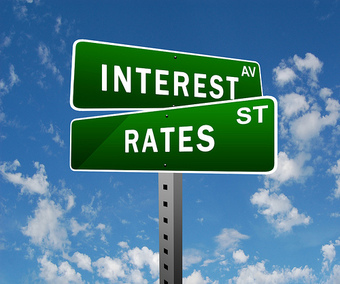
Interest
Interest rates of working capital financing can be largely affected by discount rate, WACC and cost of capital.
Times-Interest-Earned = EBIT or EBITDA / Interest charges
- Interest Charges = Traditionally “charges” refers to interest expense found on the income statement.
- EBIT = Earnings Before Interest and Taxes, also called operating profit or operating income. EBIT is a measure of a firm’s profit that excludes interest and income tax expenses. It is the difference between operating revenues and operating expenses. When a firm does not have non-operating income, then operating income is sometimes used as a synonym for EBIT and operating profit.
- EBIT = Revenue – Operating Expenses (OPEX) + Non-operating income.
- Operating income = Revenue – Operating expenses.
- EBITDA = Earnings Before Interest, Taxes, Depreciation and Amortization. The EBITDA of a company provides insight on the operational profitability of the business. It shows the profitability of a company regarding its present assets and operations with the products it produces and sells, taking into account possible provisions that need to be done.
If EBITDA is negative, then the business has serious issues. A positive EBITDA, however, does not automatically imply that the business generates cash. EBITDA ignores changes in Working Capital (usually needed when growing a business), capital expenditures (needed to replace assets that have broken down), taxes, and interest.
Times Interest Earned or Interest Coverage is a great tool when measuring a company’s ability to meet its debt obligations. When the interest coverage ratio is smaller than 1, the company is not generating enough cash from its operations EBIT to meet its interest obligations. The Company would then have to either use cash on hand to make up the difference or borrow funds. Typically, it is a warning sign when interest coverage falls below 2.5x.
3.7: Market Value Ratios
3.7.1: Price/Earnings Ratio
Price to earnings ratio (market price per share / annual earnings per share) is used as a guide to the relative values of companies.
Learning Objective
Calculate a company’s Price to Earnings Ratio
Key Points
- P/E ratio = Market price per share / Annual earnings per share.
- The P/E ratio is a widely used valuation multiple used as a guide to the relative values of companies; for example, a higher P/E ratio means that investors are paying more for each unit of current net income, so the stock is more expensive than one with a lower P/E ratio.
- Different types of P/E include: trailing P/E or P/E ttm, trailing P/E from continued operations, and forward P/E or P/Ef.
Key Terms
- time value of money
-
The value of money, figuring in a given amount of interest, earned over a given amount of time.
- inflation
-
An increase in the general level of prices or in the cost of living.
Example
- As an example, if stock A is trading at 24 and the earnings per share for the most recent 12 month period is three, then stock A has a P/E ratio of 24/3, or eight.
Price/Earnings Ratio
In stock trading, the price-to-earnings ratio of a share (also called its P/E, or simply “multiple”) is the market price of that share divided by the annual earnings per share (EPS).
The P/E ratio is a widely used valuation multiple used as a guide to the relative values of companies; a higher P/E ratio means that investors are paying more for each unit of current net income, so the stock is more “expensive” than one with a lower P/E ratio. The P/E ratio can be regarded as being expressed in years. The price is in currency per share, while earnings are in currency per share per year, so the P/E ratio shows the number of years of earnings that would be required to pay back the purchase price, ignoring inflation, earnings growth, and the time value of money.

Price-Earning Ratios as a Predictor of Twenty-Year Returns
The horizontal axis shows the real price-earnings ratio of the S&P Composite Stock Price Index as computed in Irrational Exuberance (inflation adjusted price divided by the prior ten-year mean of inflation-adjusted earnings). The vertical axis shows the geometric average real annual return on investing in the S&P Composite Stock Price Index, reinvesting dividends, and selling twenty years later. Note that over the last century, as the P/E ratio has decreased, annualized returns have increased.
P/E ratio = Market price per share / Annual earnings per share
The price per share in the numerator is the market price of a single share of the stock. The earnings per share in the denominator may vary depending on the type of P/E. The types of P/E include the following:
- Trailing P/E or P/E ttm: Here, earning per share is the net income of the company for the most recent 12 month period, divided by the weighted average number of common shares in issue during the period. This is the most common meaning of P/E if no other qualifier is specified. Monthly earnings data for individual companies are not available, and usually fluctuate seasonally, so the previous four quarterly earnings reports are used, and earnings per share are updated quarterly. Note, each company chooses its own financial year so the timing of updates will vary from one to another.
- Trailing P/E from continued operations: Instead of net income, this uses operating earnings, which exclude earnings from discontinued operations, extraordinary items (e.g. one-off windfalls and write-downs), and accounting changes. Longer-term P/E data, such as Shiller’s, use net earnings.
- Forward P/E, P/Ef, or estimated P/E: Instead of net income, this uses estimated net earnings over the next 12 months. Estimates are typically derived as the mean of those published by a select group of analysts (selection criteria are rarely cited). In times of rapid economic dislocation, such estimates become less relevant as the situation changes (e.g. new economic data is published, and/or the basis of forecasts becomes obsolete) more quickly than analysts adjust their forecasts.
By comparing price and earnings per share for a company, one can analyze the market’s stock valuation of a company and its shares relative to the income the company is actually generating. Stocks with higher (or more certain) forecast earnings growth will usually have a higher P/E, and those expected to have lower (or riskier) earnings growth will usually have a lower P/E. Investors can use the P/E ratio to compare the value of stocks; for example, if one stock has a P/E twice that of another stock, all things being equal (especially the earnings growth rate), it is a less attractive investment. Companies are rarely equal, however, and comparisons between industries, companies, and time periods may be misleading. P/E ratio in general is useful for comparing valuation of peer companies in a similar sector or group.
The P/E ratio of a company is a significant focus for management in many companies and industries. Managers have strong incentives to increase stock prices, firstly as part of their fiduciary responsibilities to their companies and shareholders, but also because their performance based remuneration is usually paid in the form of company stock or options on their company’s stock (a form of payment that is supposed to align the interests of management with the interests of other stock holders). The stock price can increase in one of two ways: either through improved earnings, or through an improved multiple that the market assigns to those earnings. In turn, the primary driver for multiples such as the P/E ratio is through higher and more sustained earnings growth rates.
Companies with high P/E ratios but volatile earnings may be tempted to find ways to smooth earnings and diversify risk; this is the theory behind building conglomerates. Conversely, companies with low P/E ratios may be tempted to acquire small high growth businesses in an effort to “rebrand” their portfolio of activities and burnish their image as growth stocks and thus obtain a higher P/E rating.
3.7.2: Market/Book Ratio
The price-to-book ratio is a financial ratio used to compare a company’s current market price to its book value.
Learning Objective
Calculate the different types of price to book ratios for a company
Key Points
- The calculation can be performed in two ways: 1) the company’s market capitalization can be divided by the company’s total book value from its balance sheet, 2) using per-share values, is to divide the company’s current share price by the book value per share.
- A higher P/B ratio implies that investors expect management to create more value from a given set of assets, all else equal.
- Technically, P/B can be calculated either including or excluding intangible assets and goodwill.
Key Term
- outstanding shares
-
Shares outstanding are all the shares of a corporation that have been authorized, issued and purchased by investors and are held by them.
Price/Book Ratio
The price-to-book ratio, or P/B ratio, is a financial ratio used to compare a company’s current market price to its book value. The calculation can be performed in two ways, but the result should be the same either way.
In the first way, the company’s market capitalization can be divided by the company’s total book value from its balance sheet.
- Market Capitalization / Total Book Value
The second way, using per-share values, is to divide the company’s current share price by the book value per share (i.e. its book value divided by the number of outstanding shares).
- Share price / Book value per share
As with most ratios, it varies a fair amount by industry. Industries that require more infrastructure capital (for each dollar of profit) will usually trade at P/B ratios much lower than, for example, consulting firms. P/B ratios are commonly used to compare banks, because most assets and liabilities of banks are constantly valued at market values.
A higher P/B ratio implies that investors expect management to create more value from a given set of assets, all else equal (and/or that the market value of the firm’s assets is significantly higher than their accounting value). P/B ratios do not, however, directly provide any information on the ability of the firm to generate profits or cash for shareholders.
This ratio also gives some idea of whether an investor is paying too much for what would be left if the company went bankrupt immediately. For companies in distress, the book value is usually calculated without the intangible assets that would have no resale value. In such cases, P/B should also be calculated on a “diluted” basis, because stock options may well vest on the sale of the company, change of control, or firing of management.
It is also known as the market-to-book ratio and the price-to-equity ratio (which should not be confused with the price-to-earnings ratio), and its inverse is called the book-to-market ratio.
Total Book Value vs Tangible Book Value
Technically, P/B can be calculated either including or excluding intangible assets and goodwill. When intangible assets and goodwill are excluded, the ratio is often specified to be “price to tangible book value” or “price to tangible book”.
3.8: The DuPont Equation, ROE, ROA, and Growth
3.8.1: The DuPont Equation
The DuPont equation is an expression which breaks return on equity down into three parts: profit margin, asset turnover, and leverage.
Learning Objective
Explain why splitting the return on equity calculation into its component parts may be helpful to an analyst
Key Points
- By splitting ROE into three parts, companies can more easily understand changes in their returns on equity over time.
- As profit margin increases, every sale will bring more money to a company’s bottom line, resulting in a higher overall return on equity.
- As asset turnover increases, a company will generate more sales per asset owned, resulting in a higher overall return on equity.
- Increased financial leverage will also lead to an increase in return on equity, since using more debt financing brings on higher interest payments, which are tax deductible.
Key Term
- competitive advantage
-
something that places a company or a person above the competition
Example
- A company has sales of 1,000,000. It has a net income of 400,000. Total assets have a value of 5,000,000, and shareholder equity has a value of 10,000,000. Using DuPont analysis, what is the company’s return on equity? Profit Margin = 400,000/1,000,000 = 40%. Asset Turnover = 1,000,000/5,000,000 = 20%. Financial Leverage = 5,000,000/10,000,000 = 50%. Multiplying these three results, we find that the Return on Equity = 4%.
The DuPont Equation
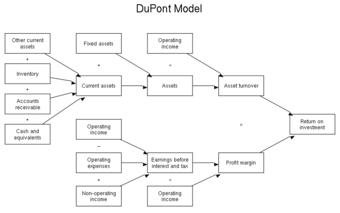
DuPont Model
A flow chart representation of the DuPont Model.
The DuPont equation is an expression which breaks return on equity down into three parts. The name comes from the DuPont Corporation, which created and implemented this formula into their business operations in the 1920s. This formula is known by many other names, including DuPont analysis, DuPont identity, the DuPont model, the DuPont method, or the strategic profit model.

The DuPont Equation
In the DuPont equation, ROE is equal to profit margin multiplied by asset turnover multiplied by financial leverage.
Under DuPont analysis, return on equity is equal to the profit margin multiplied by asset turnover multiplied by financial leverage. By splitting ROE (return on equity) into three parts, companies can more easily understand changes in their ROE over time.
Components of the DuPont Equation: Profit Margin
Profit margin is a measure of profitability. It is an indicator of a company’s pricing strategies and how well the company controls costs. Profit margin is calculated by finding the net profit as a percentage of the total revenue. As one feature of the DuPont equation, if the profit margin of a company increases, every sale will bring more money to a company’s bottom line, resulting in a higher overall return on equity.
Components of the DuPont Equation: Asset Turnover
Asset turnover is a financial ratio that measures how efficiently a company uses its assets to generate sales revenue or sales income for the company. Companies with low profit margins tend to have high asset turnover, while those with high profit margins tend to have low asset turnover. Similar to profit margin, if asset turnover increases, a company will generate more sales per asset owned, once again resulting in a higher overall return on equity.
Components of the DuPont Equation: Financial Leverage
Financial leverage refers to the amount of debt that a company utilizes to finance its operations, as compared with the amount of equity that the company utilizes. As was the case with asset turnover and profit margin, Increased financial leverage will also lead to an increase in return on equity. This is because the increased use of debt as financing will cause a company to have higher interest payments, which are tax deductible. Because dividend payments are not tax deductible, maintaining a high proportion of debt in a company’s capital structure leads to a higher return on equity.
The DuPont Equation in Relation to Industries
The DuPont equation is less useful for some industries, that do not use certain concepts or for which the concepts are less meaningful. On the other hand, some industries may rely on a single factor of the DuPont equation more than others. Thus, the equation allows analysts to determine which of the factors is dominant in relation to a company’s return on equity. For example, certain types of high turnover industries, such as retail stores, may have very low profit margins on sales and relatively low financial leverage. In industries such as these, the measure of asset turnover is much more important.
High margin industries, on the other hand, such as fashion, may derive a substantial portion of their competitive advantage from selling at a higher margin. For high end fashion and other luxury brands, increasing sales without sacrificing margin may be critical. Finally, some industries, such as those in the financial sector, chiefly rely on high leverage to generate an acceptable return on equity. While a high level of leverage could be seen as too risky from some perspectives, DuPont analysis enables third parties to compare that leverage with other financial elements that can determine a company’s return on equity.
3.8.2: ROE and Potential Limitations
Return on equity measures the rate of return on the ownership interest of a business and is irrelevant if earnings are not reinvested or distributed.
Learning Objective
Calculate a company’s return on equity
Key Points
- Return on equity is an indication of how well a company uses investment funds to generate earnings growth.
- Returns on equity between 15% and 20% are generally considered to be acceptable.
- Return on equity is equal to net income (after preferred stock dividends but before common stock dividends) divided by total shareholder equity (excluding preferred shares).
- Stock prices are most strongly determined by earnings per share (EPS) as opposed to return on equity.
Key Term
- fundamental analysis
-
An analysis of a business with the goal of financial projections in terms of income statement, financial statements and health, management and competitive advantages, and competitors and markets.
Example
- A small business’ net income after taxes is $10,000. The total shareholder equity in the business is $50,000. What is the return on equity? ROE = 10,000/50,000 ROE = 20%
Return On Equity
Return on equity (ROE) measures the rate of return on the ownership interest or shareholders’ equity of the common stock owners. It is a measure of a company’s efficiency at generating profits using the shareholders’ stake of equity in the business. In other words, return on equity is an indication of how well a company uses investment funds to generate earnings growth. It is also commonly used as a target for executive compensation, since ratios such as ROE tend to give management an incentive to perform better. Returns on equity between 15% and 20% are generally considered to be acceptable.
The Formula
Return on equity is equal to net income, after preferred stock dividends but before common stock dividends, divided by total shareholder equity and excluding preferred shares.

Return On Equity
ROE is equal to after-tax net income divided by total shareholder equity.
Expressed as a percentage, return on equity is best used to compare companies in the same industry. The decomposition of return on equity into its various factors presents various ratios useful to companies in fundamental analysis.

ROE Broken Down
This is an expression of return on equity decomposed into its various factors.
The practice of decomposing return on equity is sometimes referred to as the “DuPont System. “
Potential Limitations of ROE
Just because a high return on equity is calculated does not mean that a company will see immediate benefits. Stock prices are most strongly determined by earnings per share (EPS) as opposed to return on equity. Earnings per share is the amount of earnings per each outstanding share of a company’s stock. EPS is equal to profit divided by the weighted average of common shares.

Earnings Per Share
EPS is equal to profit divided by the weighted average of common shares.
The true benefit of a high return on equity comes from a company’s earnings being reinvested into the business or distributed as a dividend. In fact, return on equity is presumably irrelevant if earnings are not reinvested or distributed.
3.8.3: Assessing Internal Growth and Sustainability
Sustainable– as opposed to internal– growth gives a company a better idea of its growth rate while keeping in line with financial policy.
Learning Objective
Calculate a company’s internal growth and sustainability ratios
Key Points
- The internal growth rate is a formula for calculating the maximum growth rate a firm can achieve without resorting to external financing.
- Sustainable growth is defined as the annual percentage of increase in sales that is consistent with a defined financial policy.
- Another measure of growth, the optimal growth rate, assesses sustainable growth from a total shareholder return creation and profitability perspective, independent of a given financial strategy.
Key Terms
- sustainable growth rate
-
the optimal growth from a financial perspective assuming a given strategy with clear defined financial frame conditions/ limitations
- retention ratio
-
retained earnings divided by net income
- retention
-
The act of retaining; something retained
Example
- A company’s net income is 750,000 and its total shareholder equity is 5,000,000. Its earnings retention rate is 80%. What is its sustainable growth rate? Sustainable Growth Rate = (750,000/5,000,000) x (1-0.80). Sustainable Growth Rate = 3%
Internal Growth and Sustainability
The true benefit of a high return on equity arises when retained earnings are reinvested into the company’s operations. Such reinvestment should, in turn, lead to a high rate of growth for the company. The internal growth rate is a formula for calculating maximum growth rate that a firm can achieve without resorting to external financing. It’s essentially the growth that a firm can supply by reinvesting its earnings. This can be described as (retained earnings)/(total assets), or conceptually as the total amount of internal capital available compared to the current size of the organization.
We find the internal growth rate by dividing net income by the amount of total assets (or finding return on assets) and subtracting the rate of earnings retention. However, growth is not necessarily favorable. Expansion may strain managers’ capacity to monitor and handle the company’s operations. Therefore, a more commonly used measure is the sustainable growth rate.
Sustainable growth is defined as the annual percentage of increase in sales that is consistent with a defined financial policy, such as target debt to equity ratio, target dividend payout ratio, target profit margin, or target ratio of total assets to net sales.
We find the sustainable growth rate by dividing net income by shareholder equity (or finding return on equity) and subtracting the rate of earnings retention. While the internal growth rate assumes no financing, the sustainable growth rate assumes you will make some use of outside financing that will be consistent with whatever financial policy being followed. In fact, in order to achieve a higher growth rate, the company would have to invest more equity capital, increase its financial leverage, or increase the target profit margin.
Optimal Growth Rate
Another measure of growth, the optimal growth rate, assesses sustainable growth from a total shareholder return creation and profitability perspective, independent of a given financial strategy. The concept of optimal growth rate was originally studied by Martin Handschuh, Hannes Lösch, and Björn Heyden. Their study was based on assessments on the performance of more than 3,500 stock-listed companies with an initial revenue of greater than 250 million Euro globally, across industries, over a period of 12 years from 1997 to 2009.
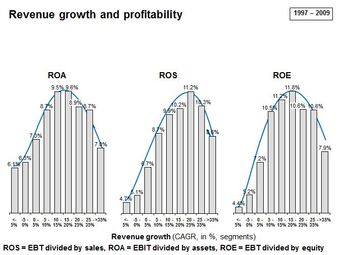
Revenue Growth and Profitability
ROA, ROS and ROE tend to rise with revenue growth to a certain extent.
Due to the span of time included in the study, the authors considered their findings to be, for the most part, independent of specific economic cycles. The study found that return on assets, return on sales and return on equity do in fact rise with increasing revenue growth of between 10% to 25%, and then fall with further increasing revenue growth rates. Furthermore, the authors attributed this profitability increase to the following facts:
- Companies with substantial profitability have the opportunity to invest more in additional growth, and
- Substantial growth may be a driver for additional profitability, whether by attracting high performing young professionals, providing motivation for current employees, attracting better business partners, or simply leading to more self-confidence.
However, according to the study, growth rates beyond the “profitability maximum” rate could bring about circumstances that reduce overall profitability because of the efforts necessary to handle additional growth (i.e., integrating new staff, controlling quality, etc).
3.8.4: Dividend Payments and Earnings Retention
The dividend payout and retention ratios offer insight into how much of a firm’s profit is distributed to shareholders versus retained.
Learning Objective
Calculate a company’s dividend payout and retention ratios
Key Points
- Many corporations retain a portion of their earnings and pay the remainder as a dividend.
- Dividends are usually paid in the form of cash, store credits, or shares in the company.
- Cash dividends are a form of investment income and are usually taxable to the recipient in the year that they are paid.
- Dividend payout ratio is the fraction of net income a firm pays to its stockholders in dividends.
- Retained earnings can be expressed in the retention ratio.
Key Term
- stock split
-
To issue a higher number of new shares to replace old shares. This effectively increases the number of shares outstanding without changing the market capitalization of the company.
Dividend Payments and Earnings Retention
Dividends are payments made by a corporation to its shareholder members. It is the portion of corporate profits paid out to stockholders. On the other hand, retained earnings refers to the portion of net income which is retained by the corporation rather than distributed to its owners as dividends. Similarly, if the corporation takes a loss, then that loss is retained and called variously retained losses, accumulated losses or accumulated deficit. Retained earnings and losses are cumulative from year to year with losses offsetting earnings. Many corporations retain a portion of their earnings and pay the remainder as a dividend.
A dividend is allocated as a fixed amount per share. Therefore, a shareholder receives a dividend in proportion to their shareholding. Retained earnings are shown in the shareholder equity section in the company’s balance sheet–the same as its issued share capital.
Public companies usually pay dividends on a fixed schedule, but may declare a dividend at any time, sometimes called a “special dividend” to distinguish it from the fixed schedule dividends. Dividends are usually paid in the form of cash, store credits (common among retail consumers’ cooperatives), or shares in the company (either newly created shares or existing shares bought in the market). Further, many public companies offer dividend reinvestment plans, which automatically use the cash dividend to purchase additional shares for the shareholder.
Cash dividends (most common) are those paid out in currency, usually via electronic funds transfer or a printed paper check. Such dividends are a form of investment income and are usually taxable to the recipient in the year they are paid. This is the most common method of sharing corporate profits with the shareholders of the company. For each share owned, a declared amount of money is distributed. Thus, if a person owns 100 shares and the cash dividend is $0.50 per share, the holder of the stock will be paid $50. Dividends paid are not classified as an expense but rather a deduction of retained earnings. Dividends paid do not show up on an income statement but do appear on the balance sheet.
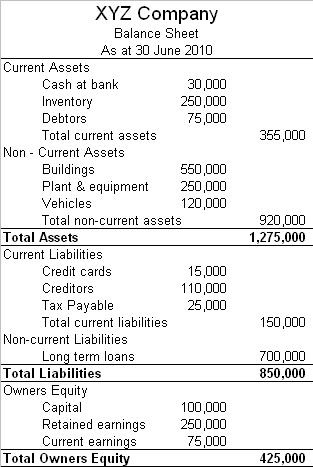
Example Balance Sheet
Retained earnings can be found on the balance sheet, under the owners’ (or shareholders’) equity section.
Stock dividends are those paid out in the form of additional stock shares of the issuing corporation or another corporation (such as its subsidiary corporation). They are usually issued in proportion to shares owned (for example, for every 100 shares of stock owned, a 5% stock dividend will yield five extra shares). If the payment involves the issue of new shares, it is similar to a stock split in that it increases the total number of shares while lowering the price of each share without changing the market capitalization, or total value, of the shares held.
Dividend Payout and Retention Ratios
Dividend payout ratio is the fraction of net income a firm pays to its stockholders in dividends:
The part of the earnings not paid to investors is left for investment to provide for future earnings growth. These retained earnings can be expressed in the retention ratio. Retention ratio can be found by subtracting the dividend payout ratio from one, or by dividing retained earnings by net income.

Dividend Payout Ratio
The dividend payout ratio is equal to dividend payments divided by net income for the same period.
3.8.5: Relationships between ROA, ROE, and Growth
Return on assets is a component of return on equity, both of which can be used to calculate a company’s rate of growth.
Learning Objective
Discuss the different uses of the Return on Assets and Return on Assets ratios
Key Points
- Return on equity measures the rate of return on the shareholders’ equity of common stockholders.
- Return on assets shows how profitable a company’s assets are in generating revenue.
- In other words, return on assets makes up two-thirds of the DuPont equation measuring return on equity.
- Capital intensity is the term for the amount of fixed or real capital present in relation to other factors of production. Rising capital intensity pushes up the productivity of labor.
Key Terms
- return on common stockholders’ equity
-
a fiscal year’s net income (after preferred stock dividends but before common stock dividends) divided by total equity (excluding preferred shares), expressed as a percentage
- quantitatively
-
With respect to quantity rather than quality.
Example
- A company has net income of 500,000. It has total assets valued at 3,000,000. Its retention rate is 80%, and its shareholder equity is equal to $1,500,000. What is the company’s ROA and internal growth rate? What is the company’s ROE and sustainable growth rate? ROA = 500,000/3,000,000 = 17% Internal growth rate = 17% x 80% = 13% ROE = 17% x (3,000,000/1,500,000) = 34% Sustainable growth rate = 34% x 80% = 27.2%
Return On Assets Versus Return On Equity
In review, return on equity measures the rate of return on the ownership interest (shareholders’ equity) of common stockholders. Therefore, it shows how well a company uses investment funds to generate earnings growth. Return on assets shows how profitable a company’s assets are in generating revenue. Return on assets is equal to net income divided by total assets.

Return On Assets
Return on assets is equal to net income divided by total assets.
This percentage shows what the company can do with what it has (i.e., how many dollars of earnings they derive from each dollar of assets they control). This is in contrast to return on equity, which measures a firm’s efficiency at generating profits from every unit of shareholders’ equity. Return on assets is, however, a vital component of return on equity, being an indicator of how profitable a company is before leverage is considered. In other words, return on assets makes up two-thirds of the DuPont equation measuring return on equity.
ROA, ROE, and Growth
In terms of growth rates, we use the value known as return on assets to determine a company’s internal growth rate. This is the maximum growth rate a firm can achieve without resorting to external financing. We use the value for return on equity, however, in determining a company’s sustainable growth rate, which is the maximum growth rate a firm can achieve without issuing new equity or changing its debt-to-equity ratio.
Capital Intensity and Growth
Return on assets gives us an indication of the capital intensity of the company. “Capital intensity” is the term for the amount of fixed or real capital present in relation to other factors of production, especially labor. The underlying concept here is how much output can be procured from a given input (assets!). The formula for capital intensity is below:
The use of tools and machinery makes labor more effective, so rising capital intensity pushes up the productivity of labor. While companies that require large initial investments will generally have lower return on assets, it is possible that increased productivity will provide a higher growth rate for the company. Capital intensity can be stated quantitatively as the ratio of the total money value of capital equipment to the total potential output. However, when we adjust capital intensity for real market situations, such as the discounting of future cash flows, we find that it is not independent of the distribution of income. In other words, changes in the retention or dividend payout ratios can lead to changes in measured capital intensity.
3.9: Using Financial Ratios for Analysis
3.9.1: Evaluating Financial Statements
With a few exceptions, the majority of the data used in ratio analysis comes from evaluation of the financial statements.
Learning Objective
Differentiate between recurring and non-recurring items in financial reports
Key Points
- Ratio analysis is a tool for evaluating financial statements but also relies on the numbers in the reported financial statements being put into order to be used for comparison. With a few exceptions, the majority of the data used in ratio analysis comes from the financial statements.
- Prior to the calculation of financial ratios, reported financial statements are often reformulated and adjusted by analysts to make the financial ratios more meaningful as comparisons across time or across companies.
- In terms of reformulation, earnings might be separated into recurring and non-recurring items. In terms of adjustment of financial statements, analysts may adjust earnings numbers up or down when they suspect the reported data is inaccurate due to issues like earnings management.
Key Terms
- valuation
-
The process of estimating the market value of a financial asset or liability.
- earnings management
-
A euphemism, such as creative accounting, to refer to fraudulent accounting practices that manipulate reporting of income, assets or liabilities with the intent to influence interpretations of the income statements.
Ratio analysis is a tool for evaluating financial statements but also relies on the numbers in the reported financial statements being put into order to be used as ratios for comparison over time or across companies. Financial statements are used as a way to discover the financial position and financial results of a business. With a few exceptions, such as ratios involving stock price, the majority of the data used in ratio analysis comes from the financial statements. Ratios put this financial statement information in context.

Putting Numbers in Order
Evaluating financial statements involves getting the numbers in order and then using these figures to perform ratio analysis.
Prior to the calculation of financial ratios, reported financial statements are often reformulated and adjusted by analysts to make the financial ratios more meaningful as comparisons across time or across companies. In terms of reformulation, one common reformulation is to divide reported items into recurring or normal items and non-recurring or special items. In this way, earnings could be separated into normal or core earnings and transitory earnings with the idea that normal earnings are more permanent and hence more relevant for prediction and valuation. In terms of adjustment of financial statements, analysts may adjust earnings numbers up or down when they suspect the reported data is inaccurate due to issues like earnings management.
The evaluation of a company’s financial statement analysis is a form of fundamental analysis that is bottoms up. While analysis of a company’s prospects can include a number of factors, including understanding the economic situation or the industry or sentiment about the company or its products, ratio analysis of a company relies on the specific company financials.
3.9.2: Industry Comparisons
While ratio analysis can be quite helpful in comparing companies within an industry, cross-industry comparisons should be done with caution.
Learning Objective
Describe how valuation methodologies are used to compare different companies in different sectors
Key Points
- One of the advantages of ratio analysis is that it allows comparison across companies. However, while ratios can be quite helpful in comparing companies within an industry and even across some similar industries, cross-industry comparisons may not be helpful and should be done with caution.
- An industry represents a classification of companies by economic activity, but “industry” can be too broad or narrow a definition for ratio analysis comparison. When comparing ratios, companies should be comparable in terms of having similar characteristics in the statistics being analyzed.
- Valuation using multiples only reveals patterns in relative values. For multiples to be useful, the statistic involved must bear a logical, meaningful relationship to the market value observed, which is something that can vary across industry.
Key Terms
- metric
-
A measure for something; a means of deriving a quantitative measurement or approximation for otherwise qualitative phenomena.
- valuation
-
The process of estimating the market value of a financial asset or liability.
One of the advantages of ratio analysis is that it allows comparison across companies, an activity which is often called benchmarking. However, while ratios can be quite helpful in comparing companies within an industry and even across some similar industries, comparing ratios of companies across different industries may not be helpful and should be done with caution .

Industry
Comparing ratios of companies within an industry can allow an analyst to make like to like (apples to apples) comparisons. Comparisons across industries may be like to unlike (apples to oranges) comparisons, and thus less useful.
An industry represents a classification of companies by economic activity. At a very broad level, industry is sometimes classified into three sectors: primary or extractive, secondary or manufacturing, and tertiary or services. At a very detailed level are classification systems like the ISIC (International Standard Industrial Classification).
However, in terms of ratio analysis and comparing companies, it is most helpful to consider whether the companies being compared are comparable in the financial metrics being evaluated in the ratios. Different businesses will have different ratios for different reasons. A peer group is a set of companies or assets which are selected as being sufficiently comparable to the company or assets being valued (usually by virtue of being in the same industry or by having similar characteristics in terms of earnings growth and return on investment). From the investor perspective, peers can include companies that are not only direct product competitors but are subject to similar cycles, suppliers, and other external factors.
Valuation using multiples involves estimating the value of an asset by comparing it to the values assessed by the market for similar or comparable assets in the peer group. A valuation multiple is simply an expression of market value of an asset relative to a key statistic that is assumed to relate to that value. To be useful, that statistic – whether earnings, cash flow, or some other measure – must bear a logical relationship to the market value observed; to be seen, in fact, as the driver of that market value. The price to earnings ratio, for example, is a common multiple but can differ across companies that have different capital structures; this could make it difficult to compare this particular ratio across industries.
Additionally, there could be problems with the valuation of an entire industry, making ratio analysis of a company relative to an industry less useful. The use of multiples only reveals patterns in relative values, not absolute values such as those obtained from discounted cash flow valuations. If the peer group as a whole is incorrectly valued (such as may happen during a stock market “bubble”), then the resulting multiples will also be misvalued.
3.9.3: Benchmarking
Comparing the financial ratios of a company to those of the top performer in its class is a type of benchmarking.
Learning Objective
Describe how benchmarking can be used to assess the strength of a company
Key Points
- Financial ratios allow for comparisons and, therefore, are intertwined with the process of benchmarking, comparing one’s business to that of relevant others or of the same company at a different point in time processes on a specific indicator or series of indicators.
- Benchmarking can be done in many ways and ratio analysis is only one of these. One benefit of ratio analysis as a component of benchmarking is that many financial ratios are well-established calculations derived from verified data.
- Benchmarking using ratio analysis can be useful to various audiences; for example, investors and managers interested in incorporate quantitative comparisons of a company to peers.
Key Terms
- benchmark
-
A standard by which something is evaluated or measured.
- ratio
-
A number representing a comparison between two things.
Benchmarking
Financial ratios allow for comparisons and, therefore, are intertwined with the process of benchmarking, comparing one’s business to that of others or of the same company at a different point in time. In many cases, benchmarking involves comparisons of one company to the best companies in a comparable peer group or the average in that peer group or industry. In the process of benchmarking, an analyst or manager identifies the best firms in their industry, or in another industry where similar processes exist, and compares the results and processes of those studied to one’s own results and processes on a specific indicator or series of indicators.
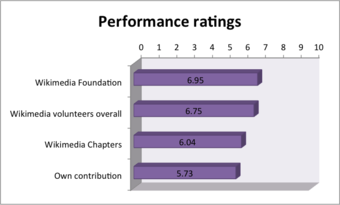
Benchmarking Measures Performance
Results are the paramount concern to a transactional leader.
Benchmarking can be done in many ways, and ratio analysis is only one of these. One benefit of ratio analysis as a component of benchmarking is that many financial ratios are well-established calculations derived from verified data. In benchmarking as a whole, benchmarking can be done on a variety of processes, meaning that definitions may change over time within the same organization due to changes in leadership and priorities. The most useful comparisons can be made when metrics definitions are common and consistent between compared units and over time.
Benchmarking using ratio analysis can be useful to various audiences. From an investor perspective, benchmarking can involve comparing a company to peer companies that can be considered alternative investment opportunities from the perspective of an investor. In this process, the investor may compare the focus company to others in the peer group (leaders, averages) on certain financial ratios relevant to those companies and the investor’s investment style. From a management perspective, benchmarking using ratio analysis may be a way for a manager to compare their company to peers using externally recognizable, quantitative data.
3.9.4: Trend Analysis
Trend analysis consists of using ratios to compare company performance on an indicator over time, often to forecast or inform future events.
Learning Objective
Analyze the benefits and challenges of using trend analysis to evaluate a company
Key Points
- Trend analysis is the practice of collecting information and attempting to spot a pattern or trend in the same metric historically, either by examining it in tables or charts. Often this trend analysis is used to predict or inform decisions around future events.
- Trend analysis can be performed in different ways in finance. Fundamental analysis relies on historical financial statement analysis, often in the form of ratio analysis.
- Trend analysis using financial ratios can be complicated by changes to companies and accounting over time. For example, a company may change its business model and begin to operate in a new industry or it may change the end of its financial year or the way it accounts for inventories.
Key Terms
- sentiment
-
A general thought, feeling, or sense.
- forecast
-
An estimation of a future condition.
In addition to using financial ratio analysis to compare one company with others in its peer group, ratio analysis is often used to compare the company’s performance on certain measures over time. Trend analysis is the practice of collecting information and attempting to spot a pattern, or trend, in the information. This often involves comparing the same metric historically, either by examining it in tables or charts. Often this trend analysis is used to forecast or inform decisions around future events, but it can be used to estimate uncertain events in the past .
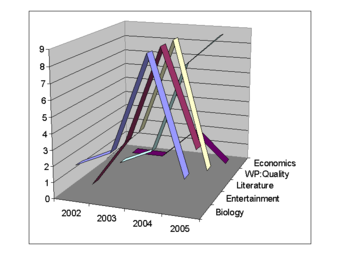
Trend Analysis
Determining the popularity and demand for specific subject over time through trend analysis.
Trend analysis can be performed in different ways in finance. For example, in technical analysis the direction of prices of a particular company’s public stock is calculated through the study of past market data, primarily price, and volume. Fundamental analysis, on the other hand, relies not on sentiment measures (like technical analysis) but on financial statement analysis, often in the form of ratio analysis. Creditors and company managers also use ratio analysis as a form of trend analysis. For example, they may examine trends in liquidity or profitability over time.
Trend analysis using financial ratios can be complicated by the fact that companies and accounting can change over time. For example, a company may change its business model so that it begins to operate in a new industry or it may change the end of its financial year or the way it accounts for inventories. When examining historical trends in ratios, analysts will often make adjustments to the ratios for these reasons, perhaps performing some ratio analysis in which they segment out business segments that are not consistent over time or they separate recurring from non-recurring items.
3.9.5: Limitations of Financial Statement Analysis
Financial statement analyses can yield a limited view of a company because of accounting, market, and management related limitations of such analyses.
Learning Objective
Describe the limitations associated with using ratio analysis
Key Points
- Ratio analysis is hampered by potential limitations with accounting and the data in the financial statements themselves. This can include errors as well as accounting mismanagement, which involves distorting the raw data used to derive financial ratios.
- Proponents of the stronger forms of the efficient-market hypothesis, technical analysts, and behavioral economists argue that fundamental analysis is limited as a stock valuation tool, all for their own distinct reasons.
- Ratio analysis can also omit important aspects of a firm’s success, such as key intangibles, like brand, relationships, skills and culture. These are primary drivers of success over the longer term even though they are absent from conventional financial statements.
- Other disadvantages of this type of analysis is that if used alone it can present an overly simplistic view of the company by distilling a great deal of information into a single number or series of numbers that may not provide adequate context or be comparable across time or industry.
Key Term
- valuation
-
The process of estimating the market value of a financial asset or liability.
Limitations of Financial Statement Analysis
Ratio analysis using financial statements includes accounting, stock market, and management related limitations. These limits leave analysts with remaining questions about the company.
First of all, ratio analysis is hampered by potential limitations with accounting and the data in the financial statements themselves. This can include errors as well as accounting mismanagement, which involves distorting the raw data used to derive financial ratios. While accounting measures may have more external standards and oversights than many other ways of benchmarking companies, this is still a limit.
Ratio analysis using financial statements as a tool for performing stock valuation can be limited as well. The efficient-market hypothesis (EMH), for example, asserts that financial markets are “informationally efficient. ” In consequence of this, one cannot consistently achieve returns in excess of average market returns on a risk-adjusted basis, given the information available at the time the investment is made. While the weak form of this hypothesis argues that there can be a long run benefit to information derived from fundamental analysis, stronger forms argue that fundamental analysis like ratio analysis will not allow for greater financial returns.
In another view on stock markets, technical analysts argue that sentiment is as much if not more of a driver of stock prices than is the fundamental data on a company like its financials. Behavioral economists attribute the imperfections in financial markets to a combination of cognitive biases such as overconfidence, overreaction, representative bias, information bias, and various other predictable human errors in reasoning and information processing. These audiences also see limits to ratio analysis as a predictor of stock market returns.
At the management and investor level, ratio analysis using financial statements can also leave out a number of important aspects of a firm’s success, such as key intangibles, like brand, relationships, skills, and culture. These are primary drivers of success over the longer term even though they are absent from conventional financial statements.
Other disadvantages of this type of analysis is that if used alone it can present an overly simplistic view of the company by distilling a great deal of information into a single number or series of numbers. Also, changes in the information underlying ratios can hamper comparisons across time and inconsistencies within and across the industry can also complicate comparisons.
3.10: Considering Inflation’s Distortionary Effects
3.10.1: Impact of Inflation on Financial Statement Analysis
General price level changes creates distortions in financial statements. Inflation accounting is used in countries with high inflation.
Learning Objective
Discuss how inflation can impact a company’s financial statements
Key Points
- Many of the historical numbers appearing on financial statements are not economically relevant because prices have changed since they were incurred.
- Since the numbers on financial statements represent dollars expended at different points of time and, in turn, embody different amounts of purchasing power, they are simply not additive.
- Reported profits may exceed the earnings that could be distributed to shareholders without impairing the company’s ongoing operations.
- Future earnings are not easily projected from historical earnings. Future capital needs are difficult to forecast and may lead to increased leverage, which increases the risk to the business.
- The asset values for inventory, equipment and plant do not reflect their economic value to the business.
Key Terms
- Financial Accounting Standards Board
-
private, not-for-profit organization whose primary purpose is to develop generally accepted accounting principles (GAAP) within the United States in the public’s interest
- hyperinflation
-
In economics, this occurs when a country experiences very high, accelerating, and perceptibly “unstoppable” rates of inflation. In such a condition, the general price level within an economy rapidly increases as the currency quickly loses real value.
- historical cost basis
-
Under this type of accounting, assets and liabilities are recorded at their values when first acquired. They are not then generally restated for changes in values. Costs recorded in the Income Statement are based on the historical cost of items sold or used, rather than their replacement costs.
Inflation’s Impact on Financial Statements
In most countries, primary financial statements are prepared on the historical cost basis of accounting without regard either to changes in the general level of prices. Accountants in the United Kingdom and the United States have discussed the effect of inflation on financial statements since the early 1900s .
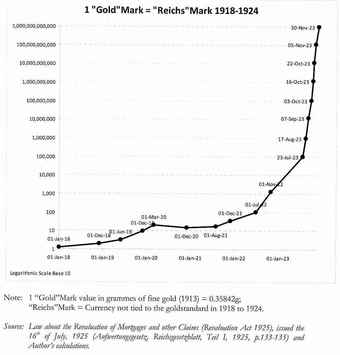
Hyperinflation Graph
German Hyperinflation Data
General price level changes in financial reporting creates distortions in financial statements such as:
- Many of the historical numbers appearing on financial statements are not economically relevant because prices have changed since they were incurred.
- Since the numbers on financial statements represent dollars expended at different points of time and, in turn, embody different amounts of purchasing power, they are simply not additive. Hence, adding cash of $10,000 held on December 31, 2002, with $10,000 representing the cost of land acquired in 1955 (when the price level was significantly lower) is a dubious operation because of the significantly different amount of purchasing power represented by the two identical numbers.
- Reported profits may exceed the earnings that could be distributed to shareholders without impairing the company’s ongoing operations.
- The asset values for inventory, equipment and plant do not reflect their economic value to the business.
- Future earnings are not easily projected from historical earnings.
- The impact of price changes on monetary assets and liabilities is not clear.
- Future capital needs are difficult to forecast and may lead to increased leverage, which increases the risk to the business.
- When real economic performance is distorted, these distortions lead to social and political consequenses that damage businesses (examples: poor tax policies and public misconceptions regarding corporate behavior).
Inflation accounting, a range of accounting systems designed to correct problems arising from historical cost accounting in the presence of inflation, is a solution to these problems. This type of accounting is used in countries experiencing high inflation or hyperinflation. For example, in countries such as these the International Accounting Standards Board requires corporate financial statements to be adjusted for changes in purchasing power using a price index.
3.10.2: Disinflation
Disinflation is a decrease in the inflation rate; a slowdown in the rate of increase of the general price level of goods, services.
Learning Objective
Describe what causes disinflation
Key Points
- Disinflation occurs when the increase in the “consumer price level” slows down from the previous period when the prices were rising. Disinflation is the reduction in the general price level in the economy but for a very short period of time.
- The causes of disinflation may be a decrease in the growth rate of the money supply. If the central bank of a country enacts tighter monetary policy, the supply of money reduces, and money becomes more upscale and the demand for money remains constant.
- Disinflation may result from a recession. The central bank adopts contractionary monetary policy, goods, and services are more expensive. Even though the demand for commodities fall, the supply still remains unaltered.Thus, the prices would fall over a period of time leading to disinflation.
Key Terms
- recession
-
A period of reduced economic activity.
- business cycle
-
A long-term fluctuation in economic activity between growth and recession.
Disinflation is a decrease in the rate of inflation–a slowdown in the rate of increase of the general price level of goods and services in a nation’s gross domestic product over time. Disinflation occurs when the increase in the “consumer price level” slows down from the previous period when the prices were rising. Disinflation is the reduction in the general price level in the economy but for a very short period of time. Disinflation takes place only when an economy is suffering from recession.
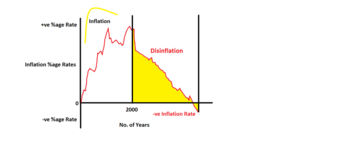
Disinflation
Disinflation is a decrease in the rate of inflation as illustrated in the yellow region of this graph.
If the inflation rate is not very high to start with, disinflation can lead to deflation–decreases in the general price level of goods and services. For example if the annual inflation rate for the month of January is 5% and it is 4% in the month of February, the prices disinflated by 1% but are still increasing at a 4% annual rate. Again, if the current rate is 1% and it is -2% for the following month, prices disinflated by 3% (i.e., 1%-[-2]%) and are decreasing at a 2% annual rate.
The causes of disinflation are either a decrease in the growth rate of the money supply, or a business cycle contraction (recession). If the central bank of a country enacts tighter monetary policy, (i.e., the government start selling its securities) this reduces the supply of money in an economy. This contraction of the monetary policy is known as a “quantitative tightening technique. ” When the government sell its securities in the market, the supply of money reduces, and money becomes more upscale and the demand for money remains constant. During a recession, competition among businesses for customers becomes more intense, and so retailers are no longer able to pass on higher prices to their customers. The main reason is that when the central bank adopts contractionary monetary policy, its becomes expensive to annex money, which leads to the fall in the demand for goods and services in the economy. Even though the demand for commodities fall, the supply of commodities still remains unaltered. Thus the prices fall over a period of time leading to disinflation.
When the growth rate of unemployment is below the natural rate of growth, this leads to an increase in the rate of inflation; whereas, when the growth rate of unemployment is above the natural rate of growth it leads to a decrease in the rate of inflation also known as disinflation. This happens when people are jobless, and they have a very small portion of money to spend, which indirectly implies reduction in the supply of money in an economy.
3.10.3: Deflation
Deflation is a decrease in the general price level of goods and services and occurs when the inflation rate falls below 0%.
Learning Objective
Explain how deflation can effect a business
Key Points
- In the IS/LM model (Investment and Saving equilibrium/ Liquidity Preference and Money Supply equilibrium model), deflation is caused by a shift in the supply-and-demand curve for goods and services, particularly a fall in the aggregate level of demand.
- In more recent economic thinking, deflation is related to risk: where the risk-adjusted return on assets drops to negative, investors and buyers will hoard currency rather than invest it. This can produce a liquidity trap.
- In monetarist theory, deflation must be associated with either a reduction in the money supply, a reduction in the velocity of money or an increase in the number of transactions. But any of these may occur separately without deflation.
- In mainstream economics, deflation may be caused by a combination of the supply and demand for goods and the supply and demand for money; specifically the supply of money going down and the supply of goods going up.
- The effects of deflation are: decreasing nominal prices for goods and services, increasing buying power of cash money and all assets denominated in cash terms, possibly decreasing investment and lending if cash holdings are seen as preferable, and benefiting recipients of fixed incomes.
Key Terms
- liquidity trap
-
A liquidity trap is a situation in which injections of cash into the private banking system by a central bank fail to lower interest rates and hence fail to stimulate economic growth. A liquidity trap is caused when people hoard cash because they expect an adverse event such as deflation, insufficient aggregate demand, or war.
- deflationary spiral
-
A deflationary spiral is a situation where decreases in price lead to lower production, which in turn leads to lower wages and demand, which leads to further decreases in price. Since reductions in general price level are called deflation, a deflationary spiral is when reductions in price lead to a vicious circle, where a problem exacerbates its own cause.
In economics, deflation is a decrease in the general price level of goods and services. This occurs when the inflation rate falls below 0% (a negative inflation rate). Inflation reduces the real value of money over time; conversely, deflation increases the real value of money – the currency of a national or regional economy. In turn, this allows one to buy more goods with the same amount of money over time.
Economists generally believe that deflation is a problem in a modern economy because they believe it may lead to a deflationary spiral .

US historical inflation rates
Annual inflation (in blue) and deflation (in green) rates in the United States from 1666 to 2004
In the IS/LM model (Investment and Saving equilibrium/ Liquidity Preference and Money Supply equilibrium model), deflation is caused by a shift in the supply-and-demand curve for goods and services, particularly with a fall in the aggregate level of demand. That is, there is a fall in how much the whole economy is willing to buy, and the going price for goods. Because the price of goods is falling, consumers have an incentive to delay purchases and consumption until prices fall further, which in turn reduces overall economic activity. Since this idles the productive capacity, investment also falls, leading to further reductions in aggregate demand. This is the deflationary spiral.
An answer to falling aggregate demand is stimulus, either from the central bank, by expanding the money supply; or by the fiscal authority to increase demand, and to borrow at interest rates which are below those available to private entities.
In more recent economic thinking, deflation is related to risk: where the risk-adjusted return on assets drops to negative, investors and buyers will hoard currency rather than invest it, even in the most solid of securities. This can produce a liquidity trap. A central bank cannot normally charge negative interest for money, and even charging zero interest often produces less stimulative effect than slightly higher rates of interest. In a closed economy, this is because charging zero interest also means having zero return on government securities, or even negative return on short maturities. In an open economy it creates a carry trade, and devalues the currency. A devalued currency produces higher prices for imports without necessarily stimulating exports to a like degree.
In monetarist theory, deflation must be associated with either a reduction in the money supply, a reduction in the velocity of money or an increase in the number of transactions. But any of these may occur separately without deflation. It may be attributed to a dramatic contraction of the money supply, or to adherence to a gold standard or to other external monetary base requirements.
In mainstream economics, deflation may be caused by a combination of the supply and demand for goods and the supply and demand for money, specifically: the supply of money going down and the supply of goods going up. Historic episodes of deflation have often been associated with the supply of goods going up (due to increased productivity) without an increase in the supply of money, or (as with the Great Depression and possibly Japan in the early 1990s) the demand for goods going down combined with a decrease in the money supply. Studies of the Great Depression by Ben Bernanke have indicated that, in response to decreased demand, the Federal Reserve of the time decreased the money supply, hence contributing to deflation.
The effects of deflation are thus: decreasing nominal prices for goods and services, increasing buying power of cash money and all assets denominated in cash terms, possibly decreasing investment and lending if cash holdings are seen as preferable (aka hoarding), and benefiting recipients of fixed incomes.
3.11: Other Distortions
3.11.1: Discrepancies
Accounting discrepancies are unintentional mistakes in the delivery of financial statements.
Learning Objective
Recognize the various reasons a discrepancy may occur, and how to prevent them
Key Points
- Mistakes happen. Being aware of common pitfalls is the best way to avoid accounting discrepancies, though.
- Discrepancies shouldn’t be confused with irregularities, which are generally assumed to be intentional mistakes to misrepresent data.
- Data errors, software issues, late payments, and shrinkage may all contribute to potential discrepancies in the tracking of organizational finances.
- Preventing discrepancies is best, but if a mistake occurs, it is best to address it as soon as possible (as opposed to waiting for an audit to catch it).
Key Terms
- accounting irregularity
-
An intentional misrepresentation of accounting data.
- discrepancies
-
Accidental misrepresentations of accounting data.
Nobody’s perfect, including accountants. From time to time, discrepancies will arise on financial statements, for a wide variety of reasons. Accounting errors that are not intentional are described as discrepancies (as opposed to an accounting irregularity, which is distinguished from a discrepancy by an intention to defraud). Accounting requires meticulous eye for detail and a strong sense of accuracy and accountability, and financial professionals and internal stakeholders must be careful of errors which could be mistaken for intentional fraud.
Common Discrepancies
Data Errors
All accounting relies heavily on input data from various sources, including accurate inventory counts, revenue reports, sales figures, asset valuations, and a wide variety of other relevant aspects of income statements, balance sheets, and statements of cash flows. Any error from input data points will thus be reflected in the final financial statements, for public companies these are released externally. Catching these errors through careful confirmation of all receipts and cash flows is a central responsibility of both management and the accounting and finance teams.
Late Payments
If a large client is late in providing capital for a service or product provided, this can impact the accuracy of a financial release. Accounts receivable, by their nature, are timed payments with specific deadlines. If an accountant assumes a receivable will be timely, they may potentially create a discrepancy. As a result, all reporting should be done on what actually is, rather than what’s expected to be.
Shrinkage
Particularly relevant for retail outlets is the concept of shrinkage. Shrinkage is the lost inventory/sales that occurs over an operational period. This can be due to petty theft, mismanaged inventory, perishable goods going unrecorded, and a wide variety of other factors. Ensuring that inventory is carefully managed and shrinkage is built into any current financial calculations is important to maintain accuracy and avoid discrepancy.
Bank Reconciliation
While rarely an issue in the long term, bank transfer and capital movements sometimes take time. Taking into account bank reconciliation when viewing the amount shown in a current account and the amount that should be shown is an occasionally cause of temporary discrepancy.
Technology
Modern accounting is largely a software endeavor. Utilizing complex software incurs the potential for complex, hard to catch errors. Having a strong IT team, and accountants familiar with the world of software coding are important assets in modern financial reporting.
Addressing Discrepancies
While perhaps common sense, amending a discrepancy as soon as it is identified is important. Waiting to be audited is not a good tactic, as this will likely result in fees or penalties for inaccurate reporting. Double and triple checking financial statements inputs before building them into public releases is particularly important for this field of work.
